

Luang Prabang Travel Guide
Last Updated: September 2, 2023
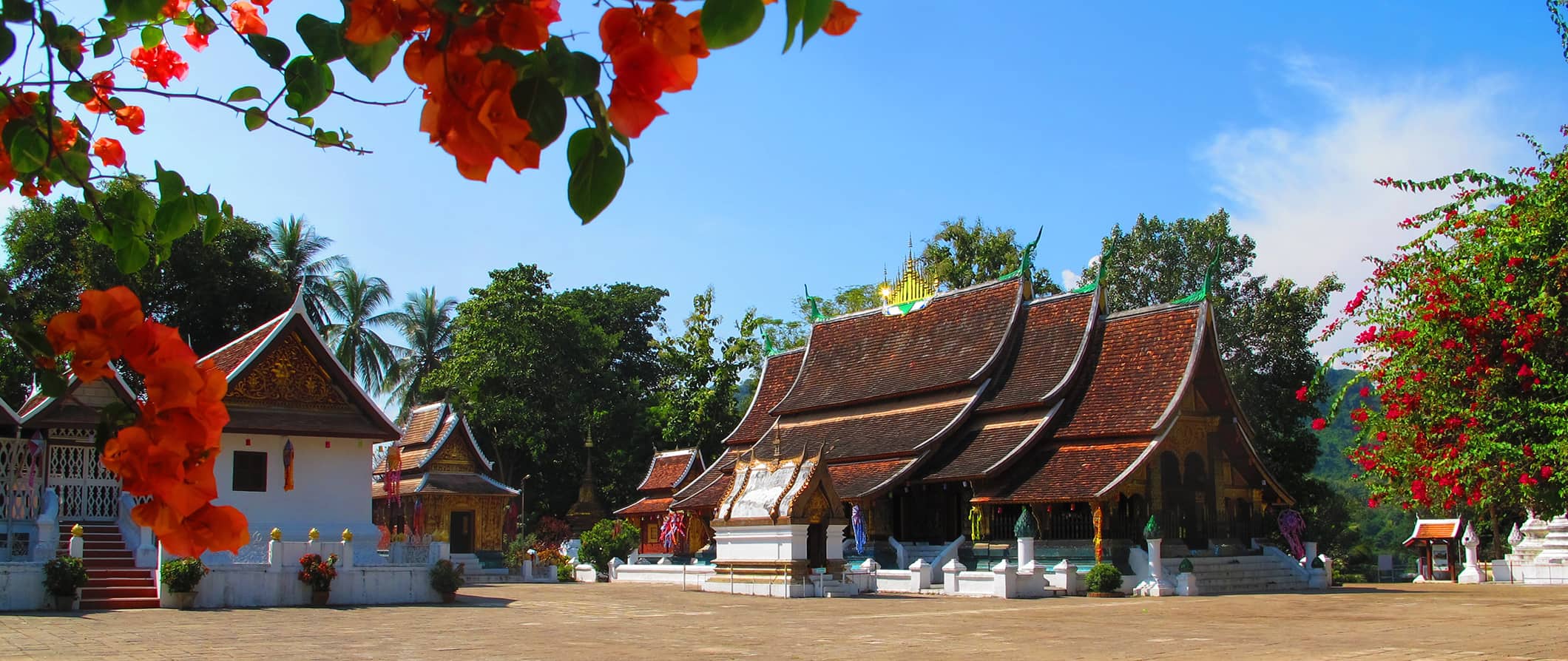
Luang Prabang is a small but vibrant town in the heart of mountainous Northern Laos . Luang Prabang is located at the confluence of the Mekong and Nam Khan rivers and is one of the most popular destinations in Laos as most travelers use it as the first or last stop in the country before traveling to/from Thailand .
It’s one of the main stops on the backpacking trail in Laos so you’ll see a lot of backpackers and budget travelers here.
For a small town (around 56,000 people live here), there’s a lot to see and do. With dozens of temples, streets filled with French colonial architecture, a bustling night market, river tours, and waterfalls, it’s an easy place to get “stuck.” I came here for three days and spent a week here (and probably could have spent another week just hanging out).
You can spend your days relaxing by the river, in cafes, or at the nearby Kuang Si waterfalls (which are worth multiple visits). Or, take a cooking class and perfect the art of laap , meet the monks, and visit the Buddha Caves. The days pass by quickly here and you’ll be hard-pressed to get bored no matter how long you visit for. I meant to come for three days and ended up here for a week!
This travel guide to Luang Prabang will help you plan your trip, save money, and ensure you make the most of your visit.
Table of Contents
- Things to See and Do
- Typical Costs
- Suggested Budget
- Money-Saving Tips
- Where to Stay
- How to Get Around
- How to Stay Safe
- Best Places to Book Your Trip
- Related Blogs on Luang Prabang
Top 5 Things to See and Do in Luang Prabang
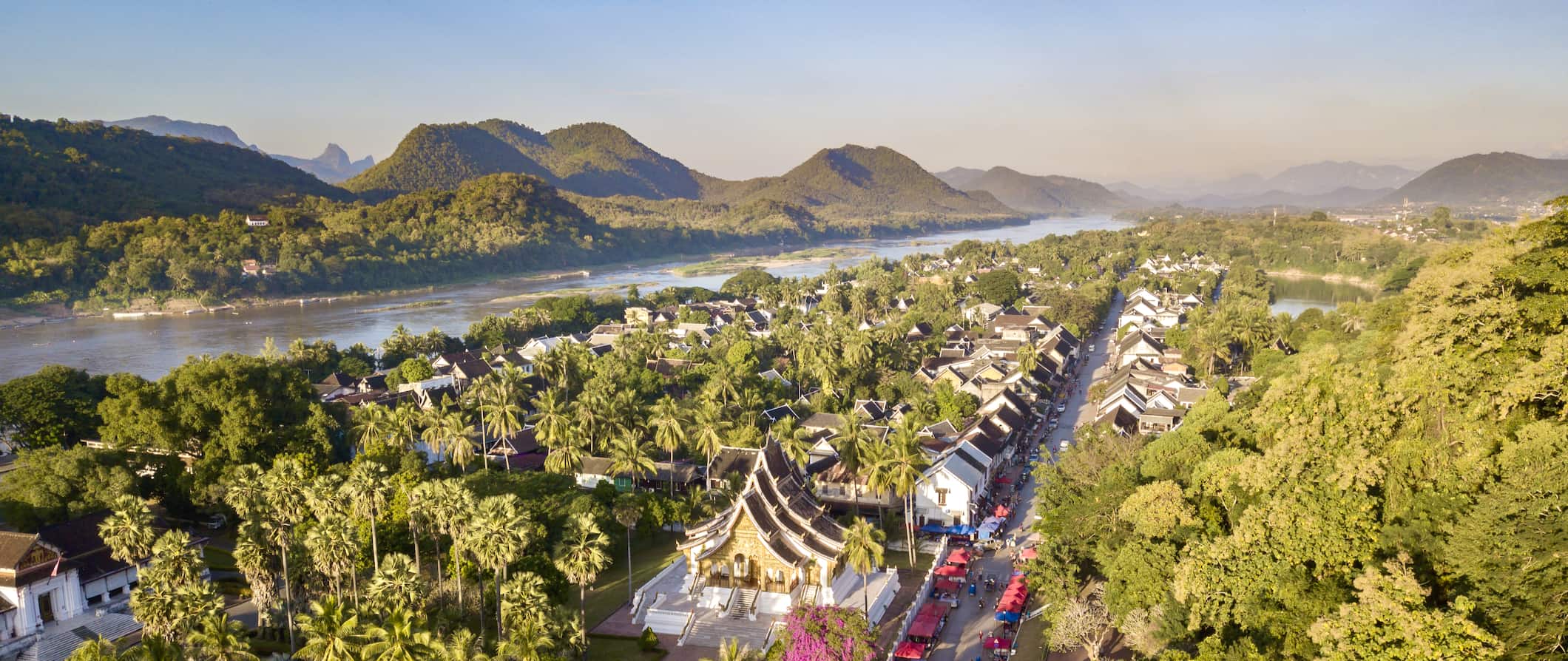
1. Explore the Buddha Caves
The Buddha Caves (Pak Ou Caves) hold over 6,000 Buddha statues that the locals still use for worship. There are standing Buddhas, sitting Buddhas, reclining Buddhas — you name it! To get there you’ll take a scenic 25-kilometer (16-mile) boat trip up the Mekong River or you can take a songthaew (a truck converted into a shared taxi). From there, you’re able to explore the two main caves on foot. It’s about 20,000 LAK to enter the caves, and a shared boat costs 65,000 LAK round-trip (the boat takes two hours there and one hour to get back). If you’d prefer to book a guided tour, Get Your Guide runs tours that include Kuang Si waterfalls, admission to the caves, and lunch for 746,000 LAK.
2. Visit the Royal Palace
While the Royal Palace (Haw Kham) is no longer a royal residence, it’s a wonderful museum that houses many items of historical and cultural importance. The current palace was built for King Sisavang Vong in 1904, in French and Lao architectural styles. When the communists took over the country, the palace became a museum. Entry to the museum is 30,000 LAK. Make sure to dress conservatively and note that no photography is allowed.
3. Climb Mount Phousi
Mount Phousi is Luang Prabang’s highest hill. Climb up its 300 stairs for stunning views over the countryside and the Mekong River. There’s a golden Buddhist shrine named Wat Chomsi at the top that dates back to 1804, and a small concession stand for snacks and drinks. It’s an incredible spot to watch the sunset.
4. See the sunset along the Mekong River
Sitting back and watching the vivid sunsets over the Mekong River is one of the best ways to enjoy your time in Luang Prabang. The many restaurants along the riverfront offer plenty of opportunities to do so (the Riverside Sunset Bar is a particularly laid-back spot). Best of all, you can do this for free!
5. Trek to the Kuang Si Falls
Other things to see and do in luang prabang, 1. visit wat xieng thong monastery.
Wat Xieng Thong Monastery (Temple of the Golden City) is easy to spot in Luang Prabang with its low-swooping roof and richly decorated gold exterior. Dating back to the mid-1500s, it was built by King Setthathilat and is one of the oldest monasteries in the city (it’s one of the few buildings not razed during conflicts over the centuries). There are detailed mosaics, sculptures of rare Buddhist gods, and elaborate wall carvings to admire as you explore. Admission is 20,000 LAK.
2. Witness the alms ceremony
At dawn, the monks come down Sakkaline Road to collect alms of rice from both villagers and tourists. You can easily locate the route for almsgiving by looking for rows of rice baskets and stools waiting for the alms-givers. It’s one of the most popular things to do in the city, and hundreds of people line up for it every morning. Just be mindful of taking photos as this is a religious ceremony and it’s not super respectful to shove cameras in the monks’ faces.
3. Visit Kuang Si Butterfly Park
Located outside of the city, this park contains sprawling landscaped gardens featuring lots of different orchids as well as thousands of butterflies living inside of a netted butterfly garden. Opened in 2014, there is also a natural fish spa and a small European-style bakery here. You can get there by taxi. Entry to the park is 40,000 LAK.
4. Take a Lao cooking class
There are a few different cooking classes available here where you can learn to cook popular dishes like laap (minced meat and salad) or mok pa (steamed fish) with some fun, interactive guidance from your chef. Most start with a visit to the market and include several dishes, ending with everyone feasting on the food they have just cooked. Prices vary but expect to pay between 250,000-400,000 LAK for a class.
5. Check out the night market
Located on Sisavangvong Road, the night market has a seemingly endless line-up of stalls selling souvenirs, food, and handmade goods. It’s one of the biggest night markets in the country and a great place to pick up anything you want. The traders here are generally a bit less pushy than elsewhere, and light haggling is advised (just don’t overdo it; an extra dollar won’t make or break your budget). Note that there are animals and animal products sold here. Avoid buying them (this includes furs, animals in jars/bottles, ivory, talons, etc.).
6. Visit Nong Kiew
The sleepy village of Nong Kiew is located a few hours from the city. The towering limestone cliffs surrounding the village are ideal for experienced climbers, and there are many hiking trails leading to nearby waterfalls and caves. The most popular trek is to the lookout at Phadeng Peak, which takes about two hours as you climb your way up above the clouds for views over the mountains. You can take the bus for 40,000-65,000 LAK. Spend a day or two here to really soak it in.
7. Take a cycling tour
If you want to get active and escape the city, try a cycling day tour. You’ll head to the countryside to learn about rural life as you visit small villages like Ban Nakham and the remote Ban Jannuau. Shop around, but most tours are around 500,000 LAK for a full-day tour.
8. Admire the Tad Sae Waterfalls
While not as big as Kuang Si, these waterfalls are still beautiful and worth seeing up close. Located just 15 kilometers (9 miles) from the city, you can bring a bathing suit and swim here. There are also elephant rides nearby but please don’t take part (it’s a cruel and abusive practice). You can get to the falls via boat for around 10,000 LAK each way. Admission is 15,000 LAK per person.
For more information on other destinations in Laos, check out these guides:
- Vang Vieng Travel Guide
- Vientiane Travel Guide
Luang Prabang Travel Costs
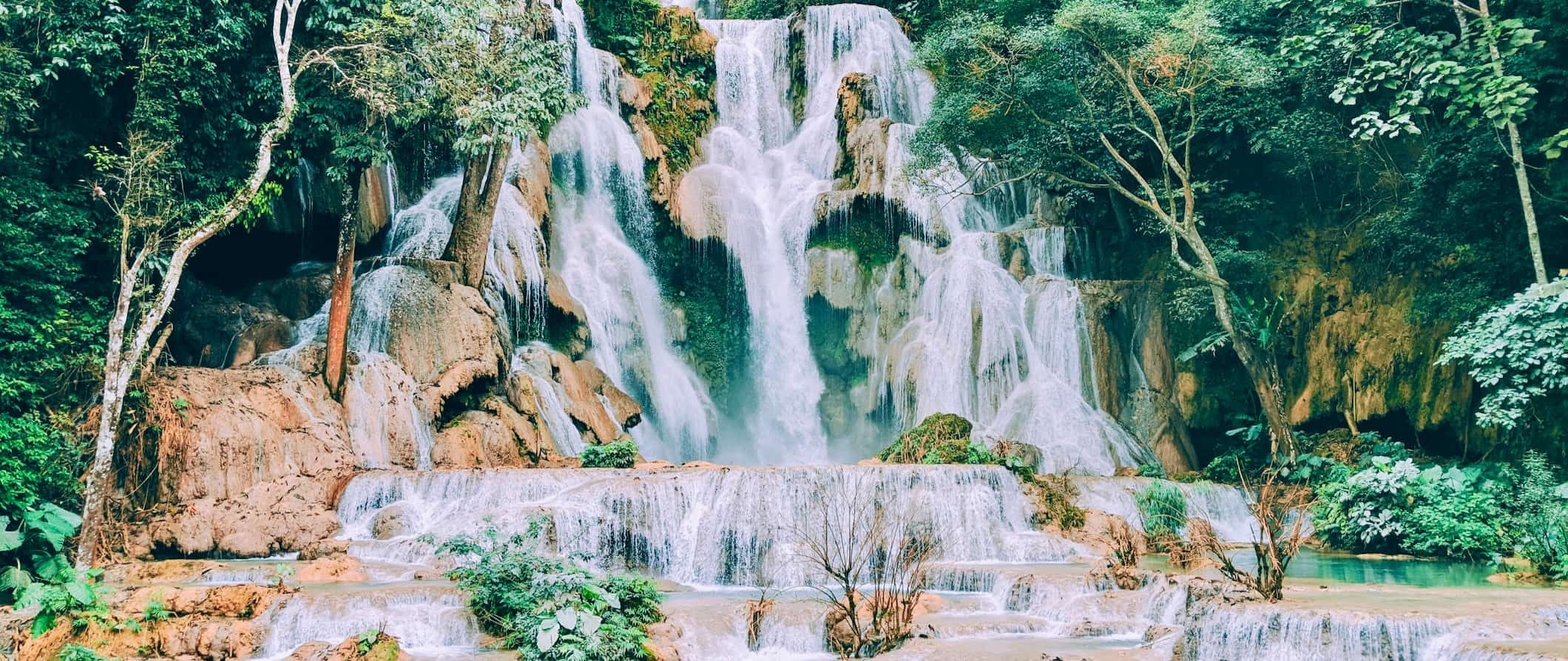
Hostel prices – There are a couple of decent hostels in Luang Prabang (and a lot of not-so-good ones, so be mindful when you book). A bed in a dorm room starts around 75,000 LAK per night. Private rooms start at 115,000 LAK. Free Wi-Fi is standard and many hostels also include free breakfast. Only a few hostels have kitchens.
Budget hotel prices – Hotels here are pricey unless you stay at a small locally-owned place, which generally costs 4000,000-900,000 LAK per night (these aren’t really on any online booking sites, however). For a two-star or three-star property, expect to pay over 1,000,000 LAK per night. For that reason, you’ll want to avoid online booking sites and either stick to hostels, use Airbnb, or book something local on arrival.
There are only a few Airbnb properties here. Private rooms start at 180,000 LAK per night (though they average double that if not booked early). Entire homes/apartments start around 425,000 LAK (but average double that). Since there are not a lot of options, book early to secure your spot (and save money).
Food – Most street food and cheap meals of local cuisine cost less than 22,000 LAK, especially in the night market where you can find things like barbecued meats, spicy papaya salad, and noodle soup.
If you want to splash out on a fancy meal, expect to pay around 150,000 LAK for a three-course meal with a drink.
Beer is very cheap here, costing around 14,000 LAK. If you want a latte or cappuccino, expect to pay around 30,000 LAK. Bottled water is around 5,000 LAK.
If you have access to a kitchen, a week’s worth of groceries costs around 250,000-300,000 LAK for basic staples like rice, pasta, produce, and some meat.
Backpacking Luang Prabang Suggested Budgets
On a backpacker budget of 300,000 LAK per day, you can stay in a hostel dorm, eat street food for your meals, enjoy the occasional drink, rent a bicycle to get around, and do a few cheap activities (such as visiting the Royal Palace). Add another 20,000-30,000 LAK to your daily budget if you plan on drinking more.
With a mid-range budget of 650,000 LAK per day, you can stay in a private Airbnb or private hotel room, eat out at some nicer restaurants, drink more, rent a motorbike to get around, and do more tours and activities, such as a cooking class and seeing the Kuang Si falls.
On a “luxury” budget of 1,800,000 LAK per day or more, you can stay in a nice hotel, eat at fancy restaurants, drink as much as you want, rent a motorbike and take taxis, and do whatever tours and activities you want. The sky is the limit!
You can use the chart below to get some idea of how much you need to budget daily, depending on your travel style. Keep in mind these are daily averages — some days you’ll spend more, some days you’ll spend less (you might spend less every day). We just want to give you a general idea of how to make your budget. Prices are in LAK.
Luang Prabang Travel Guide: Money-Saving Tips
Luang Prabang is very inexpensive for travelers so finding ways to cut down on expenses can be challenging if you’re already eating street food, not drinking a ton, and staying in hostels. That said, here are some ways to save money even more in Luang Prabang:
- Travel during the off-season – Peak season tends to run from October through March. If you can land in Luang Prabang from April through September, you can usually find lower prices, especially when it comes to accommodation. This is the rainy season but the daily rainfall is usually brief.
- Rent a bicycle – While public transportation isn’t too pricey, renting a bike for a couple of days can get you around the city at your own pace. You can find them for 15,000 LAK per day.
- Stick to the local food – Western restaurants tend to be twice as expensive as the ones serving traditional cuisine. If you’re on a budget, eat what the locals eat — it will save you money!
- Enjoy free nature – Hiking and enjoying the sunset over the river is free. Soak up the views and save your budget at the same time.
- Don’t overdo it on drinks – One of the best ways to cut costs is the limit your drinking. A few beers here and there will quickly add up.
- Bring a reusable water bottle – The tap water in Luang Prabang isn’t safe to drink. To save money and reduce your plastic use, bring a reusable water bottle with a filter. LifeStraw make a reusable bottle with a built-in filter so you can be sure your water is always safe and clean.
Where to Stay in Luang Prabang
Luang Prabang has lots of affordable accommodation options so you won’t be hard-pressed to find something within budget. My suggested places to stay in Luang Prabang are:
- Y-Not Laos Hoistel
- Indigo House Hotel
- Friendly Backpackers Hostel
- Downtown Backpackers Hostel 2
How to Get Around Luang Prabang
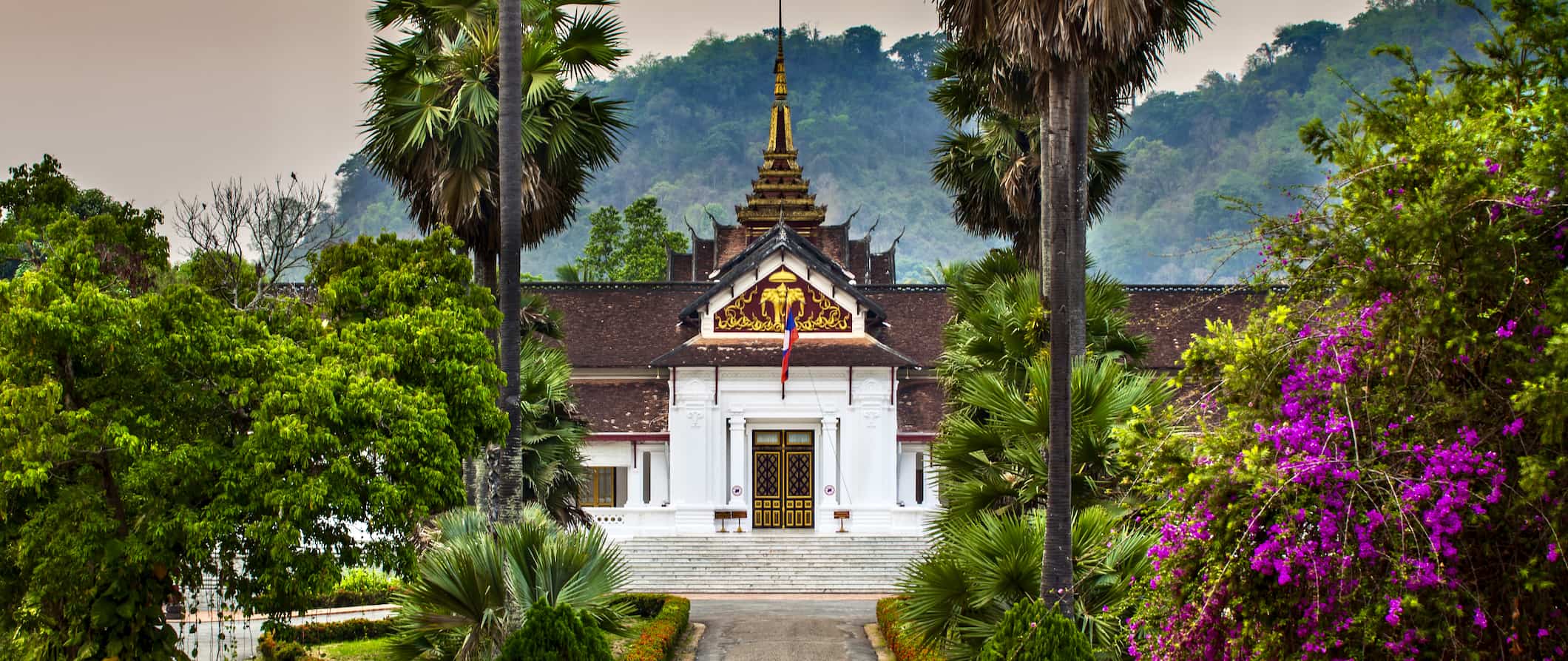
Luang Prabang is a small town and you can get anywhere on foot. Transportation is only necessary when you’re visiting places outside of town.
Bike rentals – A bicycle is one of the most common ways to get around town. There are plenty of rental shops all over Luang Prabang. Your hostel/hotel may even have some available. Rentals are usually between 15,000-30,000 LAK.
For a motorbike rental, expect to pay around 75,000 LAK per day.
Tuk-Tuk – Short tuk-tuk rides around town start at 20,000 LAK. If you’re going a little further afield, like to the slow boat pier, you’ll pay closer to 50,000 LAK.
When to Go to Luang Prabang
Between November to May is the best time to visit Luang Prabang. This is when the weather is consistently warm and dry, but it’s still cooler compared to the rest of the year. The temperature never drops below 15°C (59°F), and the average daily temperature sits around 25°C (77°F) This is also when Luang Prabang receives the greatest number of visitors, although it’s never really too crowded here (except for in the market and at the waterfalls).
March to May tends to be the hottest time of year, with temperatures as high as 40°C (104°F). The humidity is high during this time too, which can make it very intolerable for some people.
The rainy season is from June to September. Heavy rainfall occurs during these months (especially in August), and although it doesn’t last long, the Mekong River is prone to flooding. Some roads may become impassable due to thick mud, which is a pain if you’re trying to get out into the countryside or the mountains. On the other hand, you can take advantage of fewer crowds and better accommodation prices if you don’t mind the weather.
How to Stay Safe in Luang Prabang
Luang Prabang is a safe place to backpack and travel around. Pickpocketing is your biggest concern, especially in the night market. Keep your valuables close and out of reach at all times. You should always keep your passport (or a copy of it) on you as well, otherwise, you could face a fine.
Do not give money to child peddlers. You’re not helping a child in need by doing so. Often these kids are kept out of school so they can earn money in the streets. The minute you give one child money, you’re likely to be surrounded by many more. Politely decline and move on.
When people get into trouble here, it’s mostly because they’re involved with drugs or the sex industry. Laos is strict about punishment for these things so don’t do them. Don’t contribute to the negative side of tourism.
Solo female travelers should generally feel safe here. However, the standard precautions apply (never leave your drink unattended at the bar, never walk home alone intoxicated, etc.). For more tips, check out one of the many solo female travel blogs about the city. They can provide specific tips.
Be wary of people planting drugs on you. The scam involves someone planting drugs on you and then a police officer arresting you unless you can pay a bribe. For more information on scams, read this post about common travel scams to avoid here .
If you experience an emergency, dial 191 to contact the police.
When in doubt, always trust your instincts. Make copies of your personal documents, including your passport and ID, in case of an emergency.
The most important piece of safety advice I can offer is to purchase good travel insurance. Travel insurance will protect you against illness, injury, theft, and cancellations. It’s comprehensive protection in case anything goes wrong. I never go on a trip without it as I’ve had to use it many times in the past. You can use the widget below to find the policy right for you:
Luang Prabang Travel Guide: The Best Booking Resources
These are my favorite companies to use when I travel. They consistently have the best deals, offer world-class customer service and great value, and overall, are better than their competitors. They are the companies I use the most and are always the starting point in my search for travel deals.
- Skyscanner – Skyscanner is my favorite flight search engine. They search small websites and budget airlines that larger search sites tend to miss. They are hands down the number one place to start.
- Hostelworld – This is the best hostel accommodation site out there with the largest inventory, best search interface, and widest availability.
- Agoda – Other than Hostelworld, Agoda is the best hotel accommodation site for Asia.
- Booking.com – The best all around booking site that constantly provides the cheapest and lowest rates. They have the widest selection of budget accommodation. In all my tests, they’ve always had the cheapest rates out of all the booking websites.
- Get Your Guide – Get Your Guide is a huge online marketplace for tours and excursions. They have tons of tour options available in cities all around the world, including everything from cooking classes, walking tours, street art lessons, and more!
- SafetyWing – Safety Wing offers convenient and affordable plans tailored to digital nomads and long-term travelers. They have cheap monthly plans, great customer service, and an easy-to-use claims process that makes it perfect for those on the road.
- LifeStraw – My go-to company for reusable water bottles with built-in filters so you can ensure your drinking water is always clean and safe.
- Unbound Merino – They make lightweight, durable, easy-to-clean travel clothing.
Luang Prabang Travel Guide: Related Articles
Want more info? Check out all the articles I’ve written on Laos travel and continue planning your trip:
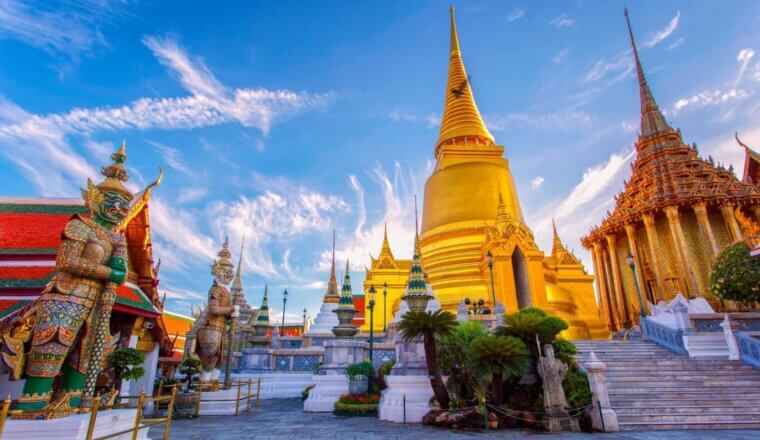
Is Southeast Asia Safe for Travelers?
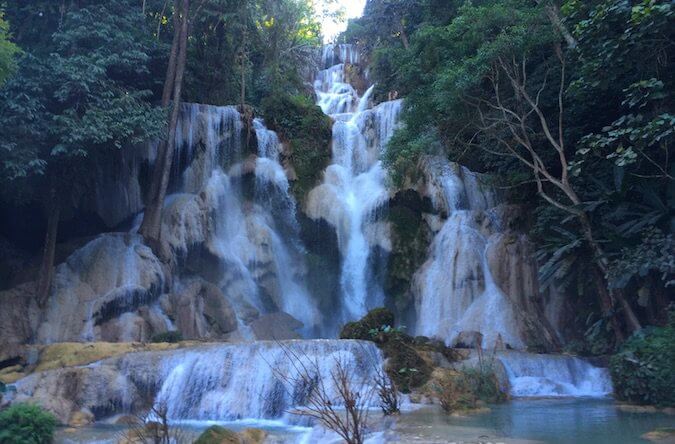
The Secret Pool of Kuang Si Waterfall
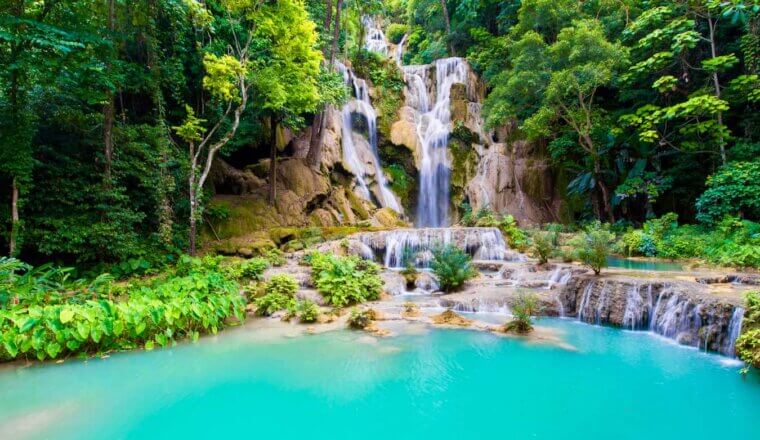
The Cost of Traveling Laos
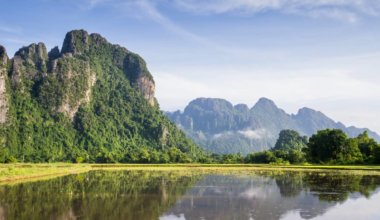
Vang Vieng: A Hedonistic Backpacker Town Reborn
Get your free travel starter kit.
Enter your email and get planning cheatsheets including a step by step checklist, packing list, tips cheat sheet, and more so you can plan like a pro!

- Where To Stay
- Transportation
- Booking Resources
- Related Blogs

- The Perfect 2 Days in Luang Prabang Itinerary for First Timers

Luang Prabang is one of the most cherished cities in Laos that captivates all who visit. Life glides to a gentle halt in this languid riverside town where the pace is slow and the ambiance is warm.
Dotted among the UNESCO World Heritage Site listed Old Town you will find 34 temples to explore where saffron-robed monks are always willing to take some time to practice their English and welcome guests.
To help you make the most of your time in this lovely city, I have curated the perfect Luang Prabang itinerary. This tells you how to get there, when to visit, where to stay, and, naturally, some of the best things to do in Luang Prabang in 2 days. Let’s get into it!
* Disclosure: This post contains a few affiliate links, which means I may receive a small commission, at no cost to you, if you make a purchase through my link. *
Table of Contents
Overview of Your Luang Prabang Itinerary
Breakdown of your 2 days in luang prabang.
- Alms Giving Ceremony
- Luang Prabang Old Town
- Wat Xieng Thong
- Wat Sensoukaram
- Wat Pa Phai
Wat May Souvannapoumaram
Mekong sunset river cruise.
- Kuang Si Waterfall,
- Kuang Si Butterfly Sanctuary
- Lao Cooking Course
- Botanical Gardens
- Royal Palace
Mount Phu Si
Night market , map for your luang prabang itinerary.
Below you can find a customized map that includes all the locations you’re going to visit on this Luang Prabang itinerary.
I marked your 2 days in Luang Prabang with different colors – I used blue for the first day and green for the second day, so you can easily see which places you’re going to visit each day.
How to use this map: This map is fully interactive, so you can move around, zoom in/zoom out, and click on the icons. If you want to see a larger map, click on the bracket in the upper right corner. To see more details and the different layers, click on the tab in the upper left corner. If you want to save it for later, click on the star icon next to the name of the map. Then simply open Google Maps either on your desktop or phone, go to ‘Saved’/’Maps’, and open the map whenever you need it.
Day 1 of Your 2 Day Luang Prabang Itinerary
Alms giving ceremony .
Alms giving is a ritual that takes place every morning at dawn in Luang Prabang. Local monks form a peaceful procession along Sakkaline Road during which they are handed offerings of rice balls by the residents of Luang Prabang.
It is free to watch alms giving and it coincides with sunrise. However, it’s really important that you keep your distance from the monks. In the past, tourists have caused issues by getting in the way when trying to take photos of the monks.
It is best to watch from afar down one of the side streets. You will also need to dress conservatively with your knees and shoulders covered.
Witnessing alms giving is one of the most interesting things to do in Luang Prabang in 2 days and you really will not regret that early morning wake-up call.
Explore the Old Town
The historic heart of Luang Prabang is situated on a peninsula that is surrounded by the Mekong and Nam Khan rivers. As a UNESCO World Heritage Site, the small area is teeming with heritage buildings that fuse traditional Lao with colonial French architecture.
Take the opportunity on the first morning of your Luang Prabang itinerary to weave your way through the streets and watch daily life spring into action. You can choose to explore Old Town on foot or rent a bicycle.
The Luang Prabang Morning Market runs daily from 5 am to 10 am and is a great spot to pick up fresh tropical fruits and the typical Lao breakfast of Khao jee (grilled sticky rice served on banana leaf).
If you would prefer then you can grab some of the best French-style pastries outside of France at one of the authentic bakeries in town. Alternatively, stop by Two Little Birds Cafe for a healthy breakfast and good coffee! Their smoothie bowls and avocado toasts are really delicious.
You can also visit the rickety Bamboo Bridge which connects the tip of the peninsula with a small settlement on the Mekong. It costs 10,000 LAK ($1 US) for the novel experience of crossing the bridge. The bridge is only open during the dry season as during the rainy season the water washes the bridge away.

Temple hop in Luang Prabang
Now is the perfect time to tackle the myriad of temples that dot the streets of Luang Prabang. There are so many to see so you can wander at will or head straight to the following to sample a selection.
Wat Xieng Thong
As the largest and most sacred temple in town you really can’t miss the chance to visit Wat Xieng Thong, or, the ‘monastery of the golden city’.
Erected in the 16th century in a typical Lao architectural style with its wide sweeping roof, the temple is one of the oldest temples in the country. The complex features a funerary hall and an intricate mural of the tree of life.
Wat Xieng Thong is open daily, 8 am – 6 pm, and the admission fee is 20,000 LAK ($1 US).

Wat Sensoukaram
The meaning behind the name of this alluring temple is ambiguous. ‘Sensoukaram’ means ‘10,000 treasures’ and some local fables say that was because it was constructed using 10,000 stones from the Mekong.
However, there are many other explanations so feel free to make some inquiries during your 2 days in Luang Prabang and see how many legends you can collect.
Wat Sensoukaram is open daily, 8 am – 3 pm, and there is no admission fee. It is a 5-minute walk from Wat Xieng Thong.
Wat Pa Phai
This small yet exquisite gilded temple features a remarkable gold leaf facade that depicts seated Buddhas.
Its precise origins are unclear due to renovations but the interiors depict scenes from 19th-century life in Laos. Its lush setting earned Wat Pa Phai the affectionate nickname of ‘monastery of the bamboo forest.’
Wat Pa Phai is open daily, 8 am – 5 pm, and there is no admission charge. It is a 10-minute walk from Wat Xieng Thong.

More commonly referred to as simply Wat May, this temple was built in the early 18th century and is one of the largest complexes in town besides Wat Xieng Thong. Upon construction it was used by the royal family and to this day it houses an extensive collection of Buddha statues.
Wat May is open daily, 8 am – 5 pm, and the admission cost is 20,000 LAK ($1 US). It is a 10-minute walk from Wat Pa Phai.
Unless you started your 2 days in Luang Prabang by riding the slow boat from Thailand, taking a scenic cruise along the Mekong really shouldn’t be missed.
Flowing through six countries, this mighty river is one of the longest in Asia, and hopping aboard a boat gives you the perfect opportunity to lap up the rural scenery and snap some incredible photos.
As many of the river tours take an entire day, I suggest joining this 4.5-hour Mekong Sunset Cruise and Hot Pot Dinner . It’s the perfect way to wind down after a full day spent on your feet exploring the Old Town. This boat cruise departs daily at 4.30 pm (subject to the weather conditions).

Although you can find countless amazing restaurants in the Old Town of Luang Prabang, my personal recommendation is to have dinner at Yuni Yupoun .
Constantly rated as the number one restaurant in all of Luang Prabang, this charming restaurant prides itself on serving delicious bites from all over the world. In fact, the name means ‘here and there’ and each corner inside the restaurant represents a different culture.
We loved this restaurant so much that we decided to eat here on both evenings of our 2 days in Luang Prabang and let me tell you, we didn’t regret it. The hospitality is amazing and the food is just out of this world.

Day 2 of Your 2 Day Luang Prabang Itinerary
Kuang si waterfall .
For the second day of your 2 day Luang Prabang itinerary you will need to set your alarm clock again but this time you will also need to grab your swimmers. Your first stop today is the picturesque Kuang Si Waterfall.
The azure water of the Kuang Si Waterfall cascades through the jungle from a height of 50 meters (164 feet). It’s perfectly safe to swim so do bring your towel and wear sturdy shoes as well so you can scramble up through the jungle to appreciate varying views of the natural attraction.
The waterfall is open to tourists daily, 8 am – 5 pm. Because it gets so busy I recommend that you get here as soon as the falls open for business.
You will need to pay an entrance fee of 25,000 LAK ($1.25 US) to visit and swim in the falls. It takes 45-60 minutes to reach the Kuang Si Waterfall from downtown and it’s best to hire a tuk tuk driver to take you unless you’re a competent motorbike driver.

Kuang Si Butterfly Park
Once you’ve frolicked in the pools you can dry off with a wander around this lovely butterfly sanctuary which is brimming with colorful creatures and flowers. There is also a large fish pond and a fish spa if you’re brave enough to let fish nibble your feet.
It takes around 20 minutes to walk to the sanctuary from the waterfall but you might be best striking a deal with your tuk tuk driver to wait for you and return you to town via the sanctuary. Alternatively, you will find shared tuk tuks milling around the entrance.
The sanctuary is open 11 am – 4 pm (on Thursdays it’s closed). Admission is 100,000 LAK ($5 US) or 204,000 LAK ($10 US) if you want to add lunch.

Lao Cooking Class
Now for your afternoon, you have a decision to make. You can either enroll in a Lao cooking class or visit the beautiful Pha Tad Ke Botanical Gardens (it is closed to the public until October 2024).
There are several places in town where you can take a course and you will see adverts in town. Tamarind provides some of the most immersive and informative Lao cooking classes in town.
Their evening classes run from 4 pm to 8.30 pm and cost 612,000 LAK ($30 US). During the course, you will master how to create four scrumptious Lao dishes.
However, if you want to do this then you’ll need to jiggle this Luang Prabang itinerary and either skip last night’s sunset river cruise or reschedule your sunset hike from this day to a sunrise climb.

Pha Tad Ke Botanical Garden (it is closed to the public until October 2024)
Option B, you can take a stroll through the very first botanical garden that opened in Laos. Pha Tad Ke is an oasis of fragrant orchids and colorful tropical plant life interspersed with bamboo forest.
You can book a skip the line ticket that includes access to the gardens by boat (return boat trip included). This also permits access to a herbal tea tasting and whatever craft activities and other events happen to be scheduled on the day of your visit.
Royal Palace
Situated right by the river at the foot of Mount Phu Si (the next item on your Luang Prabang itinerary), the former royal residence of King Sisavang Vong has since been converted into a museum.
Often referred to as Haw Kham or the Golden Hall, the palace was constructed in 1904. As with much of the architecture in Luang Prabang, it is a mix of Lao and French elements.
Inside the museum, you can explore apartments that are presented as time capsules from the time the palace was a royal residence as well as Buddhist relics and artifacts.
The museum is open daily, from 8 am to 11.30 am and from 1.30 pm until 4 pm. Admission is 30,000 LAK ($1.50 US).

Mount Phu Si (Mount Phousi) is a 100-meter (328 feet) high hill right in the center of town. It’s the tallest point in the city and provides a wonderful panorama across the confluence of the Mekong and Nam Khan rivers and surroundings.
There are two staircases, each featuring just over 300 steps. Climbing the peak is one of the most unforgettable things to do in Luang Prabang in 2 days and is best experienced at sunset.
You can climb up using the Sisavongvang Road entrance (near the Royal Palace) and return via the route that starts on Thanon Phousi. The former has slightly fewer steps.
Once you reach the summit you will spot the golden stupa of Wat Chom Si where locals and monks place daily offerings.
Hiking up Mount Phu Si is permitted between 6 am and sunset each day. There is a small fee of 20,000 LAK ($1 US) to pay soon after you start the hike.
You can also buy some flowers to make an offering if you wish. Because Mount Phu Si is a holy site you will need to cover up modestly once at the top.

There’s nothing like hiking up 300 steps to work up an appetite so for the final stop on your Luang Prabang 2 day itinerary you can feast on Lao delicacies at the Night Market.
This is situated on Phothisalath Road and it runs every night from 5 pm – 11 pm. In addition to numerous food stalls, there are also dozens of stalls where you can purchase authentic Lao handicrafts and souvenirs.
Whatever you do, make sure to try some coconut pancakes – they are super delicious!

Useful Info for Spending 2 Days in Luang Prabang
Where to stay in luang prabang.
The historic heart of Luang Prabang sits right at the meeting point of the Mekong and Nam Khan rivers.
It is best to stay as centrally as possible so that you can make the most of the attractions in town and plan some early starts during your 2 days in Luang Prabang. Besides, this way you can save some cash by exploring on foot.
Here are my top picks for where to stay in Luang Prabang for different budgets.
- Luxury | Pullman Luang Prabang
- Mid-range | The Belle Rive Boutique Hotel
- Budget | Villa Mahasok Hotel
How to get to Luang Prabang
Luang Prabang is one of only two cities in Laos (the other being the capital, Vientiane) to have its own international airport which means that it is one of the easiest cities to travel to from overseas.
Luang Prabang International Airport (LPQ) is located 4 km (2.5 miles) northeast of the city. Direct flights connect Luang Prabang to a limited number of major Southeast Asian airports.
Hanoi and Bangkok are the best places to start your search for connections. If you are traveling from Europe, the US, or elsewhere, then you should expect to transfer at either of these airports.
Alternatively, you can travel to Luang Prabang from Northern Thailand via van or boat. Slow boats depart from Chiang Khong (near Chiang Mai) in Thailand and cruise along the Mekong River. This journey typically takes two days to complete whereas the van journey takes approximately 11 hours.
In case you ’re planning to visit more destinations in the country during your Laos itinerary , you can travel to Luang Prabang from other destinations by train, minivan, or public bus within Laos.

Best time to visit Luang Prabang
Laos is defined by two seasons, wet season and dry. The wet season runs from May to September while the dry season spans from October until April. Temperatures reach their highest between March and July and it can get as hot as 35°C (95°F).
The most rainfall is between July and September and this can cause nearby flooding. Sometimes this makes it trickier to access sites outside of town so do bear that in mind if you are planning to include a waterfall trip in your Luang Prabang itinerary.
On the other hand, it is when you will find the least crowds and cheaper accommodation deals. The busiest period is October to February.
How to get around Luang Prabang
Luang Prabang is very small and the historic center is walkable. Alternatively, you can hire a bicycle which will save some time and make this Luang Prabang 2 day itinerary even more fun!
Hotels often provide bicycles but if not there are rentals all over the town and costs are usually 15,000-30,000 LAK ($0.75-1.50 US) per day.
For seeing the sights further afield you can rent a motorbike if you feel comfortable driving on challenging roads and have an International Driver’s Permit (IDP). Rental fees are higher than in neighboring countries and rates vary from 95,000-145,000 LAK ($4.65-7.20 US) per day.
The other option for traveling to nearby sites during your 2 days in Luang Prabang is to enlist the services of the many tuk tuk drivers. These are available for private hire or on a shared basis if you want to save some money.
Short journeys around town will cost you around 20,000 LAK ($1 US) per trip and further afield you are looking upwards of 50,000 LAK ($2.45 US) based on the distance.

Planning a trip to Laos?
Then you might want to take a look at all our other travel guides about Laos. I promise, they are just as awesome as this article was!
- The Perfect One Week in Laos Itinerary
- Top 10 Best Things to Do in Vang Vieng, Laos
- Hotel Review: Riverside Boutique Resort Vang Vieng
Pin It for Later!

Leave a Comment Cancel reply
: : Official website for Tourism LuangPrabang | Open time: 8:00-16:30
♦ Contact us

LuangPrabang Timeless
If you are looking for a perfect holiday experience with memories to cherish you are at the right place. Let’s plan to visit LuangPrabang.
Things to do
Whether you’re looking for a quiet poolside holiday, an adventure filled trek to a waterfall in the jungle, or the chance to meet locals in a hillside ethnic village, Luang Prabang offers it all.
Culture & History
Other provinces, vr 360 city tour, what makes us special.

Untouched Nature
Where jungle covered mountains meet the mighty water.

Inner Peace
Where the sound of chanting monks drifts through the town at dawn and dusk.

Timeless Culture
Where traditional ways of life are still practiced by local people with pride.

East meets West
Where ancient temples glitter golden between charming old French Colonial buildings.
Hi-light Video
To watch all of Video in YouTube click here
LuangPrabang Center point
Lao new year, luang prabang timeless, kuangsi waterfall, festival of light boat.
Latest Information of official government activities
Visit Lao Year 2024
Free to download.
Free-to-download Maps, Brochures, Audio guides.
Attractions
Luang prabang city, natural attractions, cultural attractions, historical attractions, wat (temples).
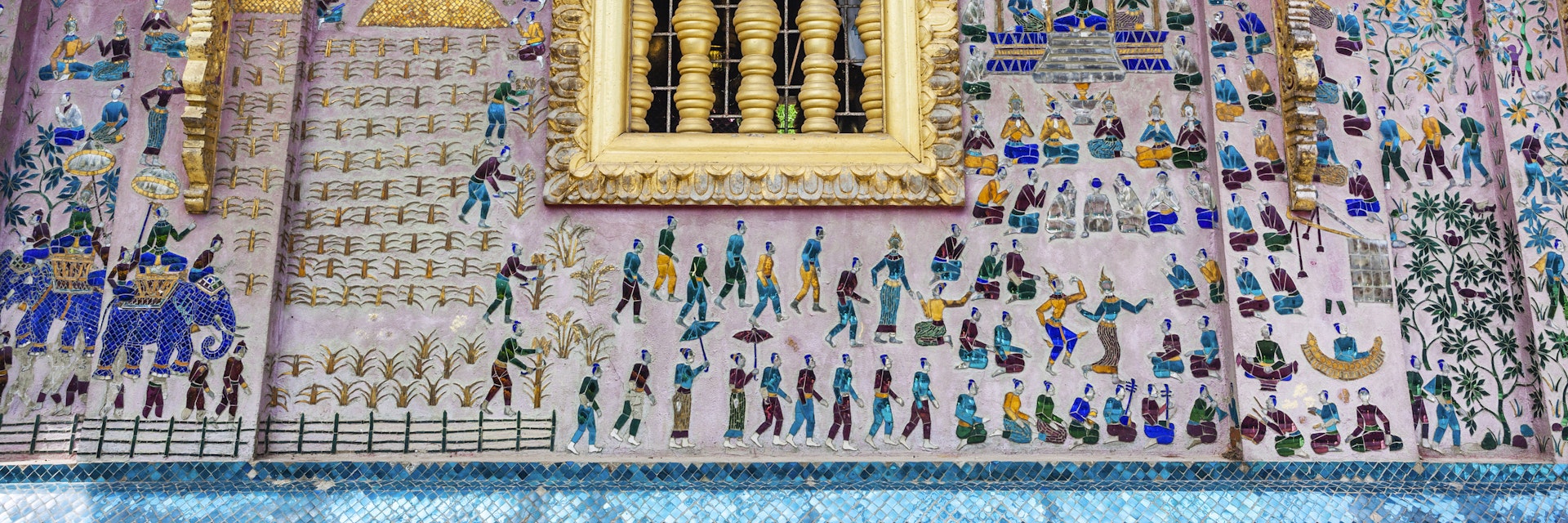
Getty Images/Lonely Planet Images
Luang Prabang
Luang Prabang (ຫລວງພະບາງ) slows your pulse and awakens your imagination with its combination of world-class comfort and spiritual nourishment. Sitting at the sacred confluence of the Mekong River and the Nam Khan (Khan River), nowhere else can lay claim to this Unesco-protected gem's romance of 33 gilded wats, saffron-clad monks, faded Indochinese villas and exquisite fusion cuisine.
Attractions
Must-see attractions.
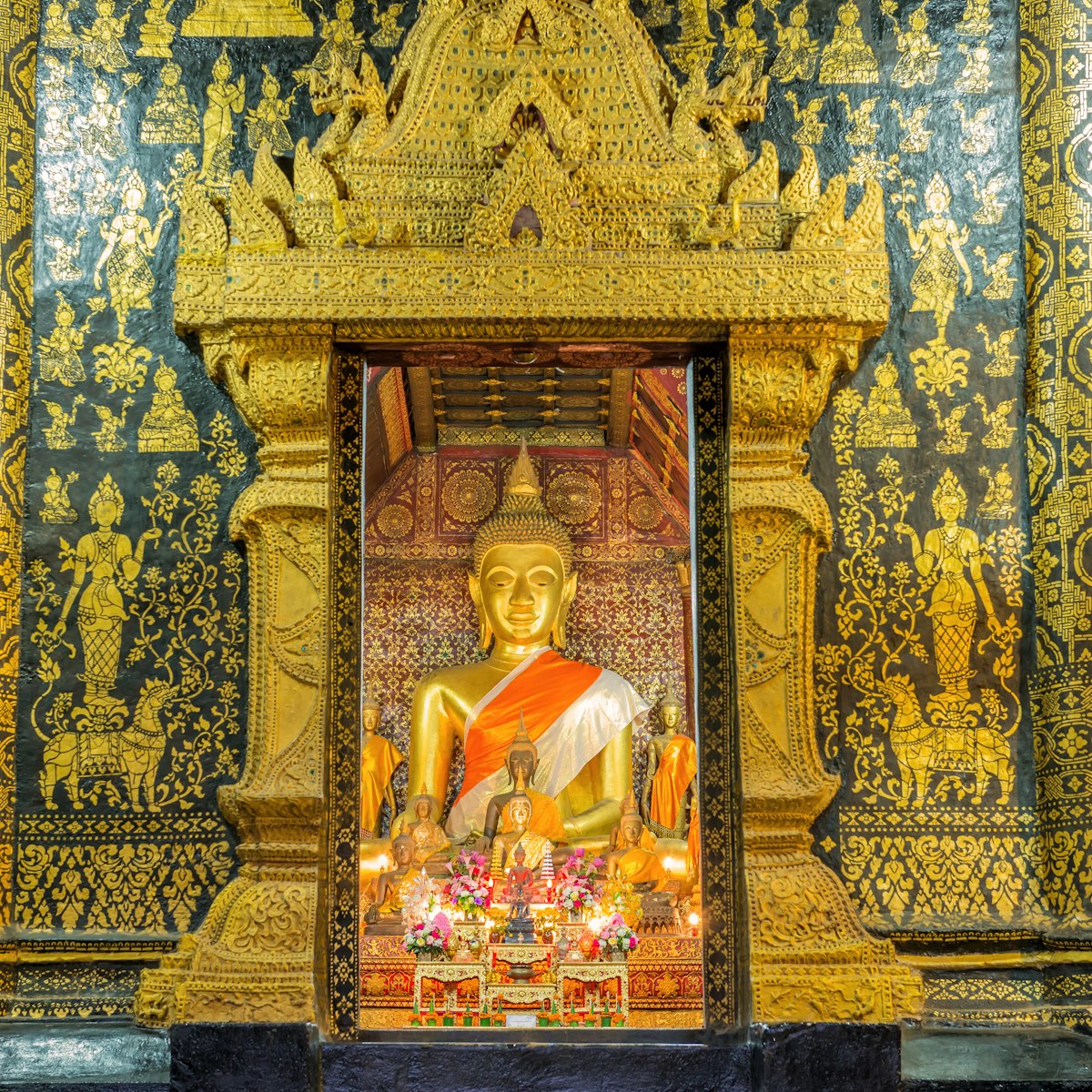
Wat Xieng Thong
Luang Prabang's best-known monastery is centred on a 1560 sǐm (ordination hall). Its roofs sweep low to the ground and there's a stunning 'tree of life'…
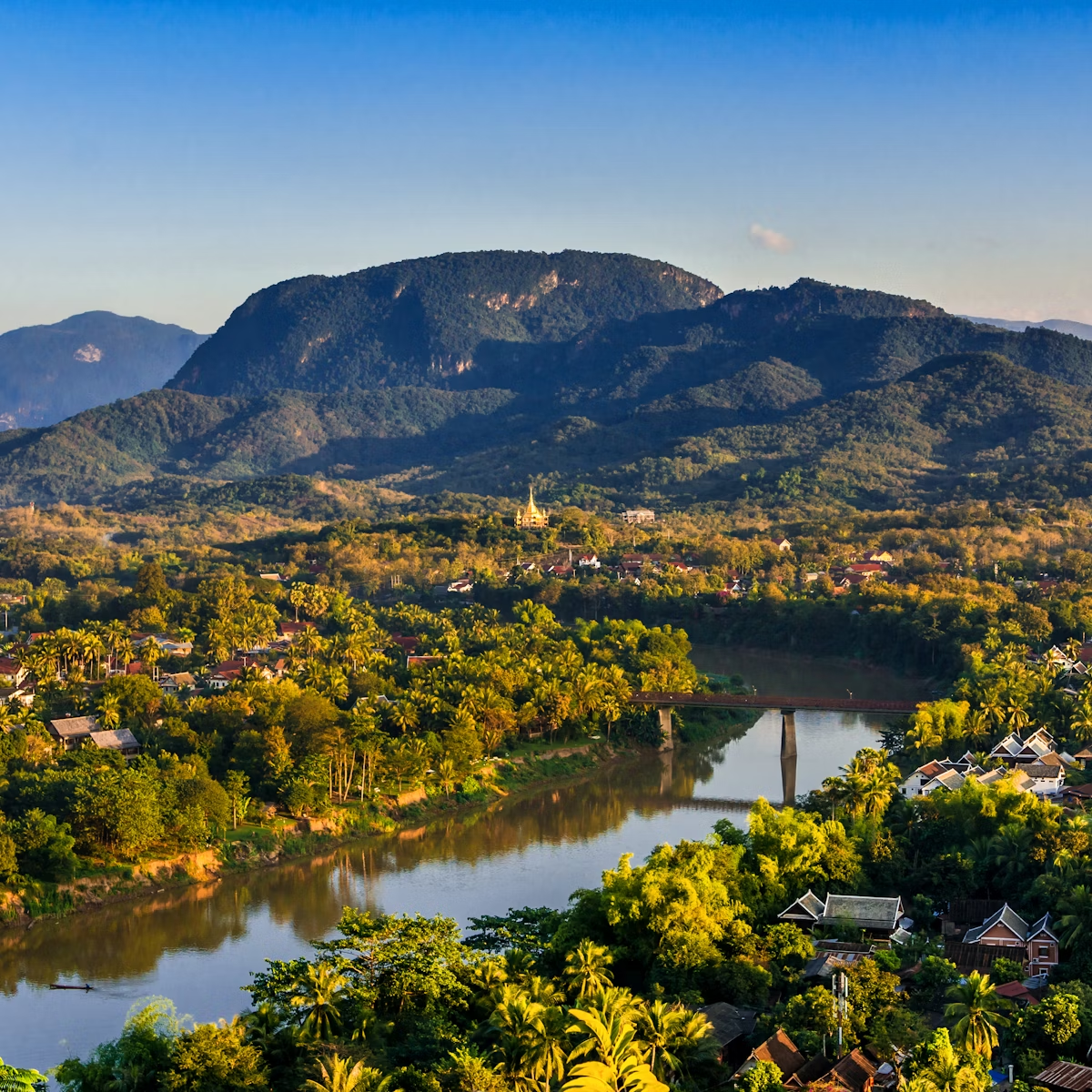
Dominating the old city centre and a favourite with sunset junkies, the 100m-tall Phu Si (prepare your legs for a steep 329-step ascent) is crowned by a…

UXO Laos Information Centre
The sobering UXO Laos Information Centre helps you get a grip on the devastation Laos suffered in the Second Indochina War and how nearly 40 years later…

Wat Mai Suwannaphumaham
Wat Mai is one of the city's most sumptuous monasteries, its wooden sǐm (ordination hall) sporting a five-tiered roof in archetypal Luang Prabang style,…

Green Jungle Park
Thirty-two kilometres west of the city, this slice of natural paradise reclaimed from a rubbish dump uses the forest and a stunning cascade as its…

Heuan Chan Heritage House
Footpaths lead back from the commercial main drag into a little oasis of palm-shaded calm around Heuan Chan, an authentic traditional longhouse on tree…

Royal Palace
Evoking traditional Lao and French beaux-arts styles, the former Royal Palace was built in 1904 and was home to King Sisavang Vong (r 1904–59), whose…

Visiting this professionally presented three-room museum is a must to learn about northern Laos' various hill-tribe cultures, especially if you're…
Latest stories from Luang Prabang

Wildlife & Nature
Jan 29, 2016 • 4 min read
With its dense forests, limestone caves and endless waterways, Laos is a dream destination for intrepid travellers seeking an off-the-beaten-track corner…

Jan 14, 2016 • 5 min read
in partnership with getyourguide
Book popular activities in Luang Prabang
Culturally Immersive & Responsible Travel
Visiting the UNESCO Town of Luang Prabang: Ultimate Travel Guide for Backpacking Laos
Update : Luang Prabang (thus Laos) is fully open for travel for international tourists without a quarantine requirement. Visa on arrival facility has resumed for Laos. Fully vaccinated travelers do not need any test. Unvaccinated travelers need to undergo an ATK test. Rules implemented from May 09, 2022.
About this blog : Luang Prabang, an incredibly pretty ancient town of Laos sits pretty at the peninsula by the confluence of the Mekong river and Nam Khan. There are 33 ancient gilded pagodas with golden roofs rising towards the sun. In this travel blog on Luang Prabang, I try to introduce the timeless experience that Luang Prabang is, Steeped deep in the culture of Buddhist teaching.
The UNESCO heritage town of Luang Prabang does an astounding job of preserving the colonial architecture dating back to the days of Indo-China. Erstwhile French bungalows miraculously fit in the oriental setting of Luang Prabang. People travel to Luang Prabang in the hope of witnessing the glorious Buddhist temples, distinct from those from Bagan in Myanmar .
Compared to the neighboring Thailand , Vietnam or Cambodia, Luang Prabang has successfully steered clear of the madness that sweeps these regions on the peak tourist season. I would hesitate to call Luang Prabang an offbeat destination, but it sure acts as the last bastion of hope and tranquility in Southeast Asia. There are plenty of things to do in Luang Prabang , ranging from temple hopping, visiting the local villages and nearby Kuang Si waterfall.
But above all, you may relax by the river Mekong. The river dearly strips you off the last bit of weariness.
From easy visa on arrival rules to a list of must see attractions of Luang Prabang, this blog post is gonna be a handy guide for every traveler taking the road less taken to Luang Prabang. LPQ is the airport code for Luang Prabang!
It is imperative to be mindful and practice responsible travel while exploring Luang Prabang, Laos. The small landlocked country has often been listed at the wee end of the economic indicators lists and is governed by a communist regime. Mounting amount of waste due to increased tourist footfall is the true menace. With a little effort and an attitude of giving back and goodwill, travelers’ commune can help Luang Prabang attain a sustainable tourism business. Highlighting the sustainable and eco-conscious life choices of locals of Luang Prabang is one of the primary goals of this travel blog.
Click here to read more travel blogs and stories from Laos !
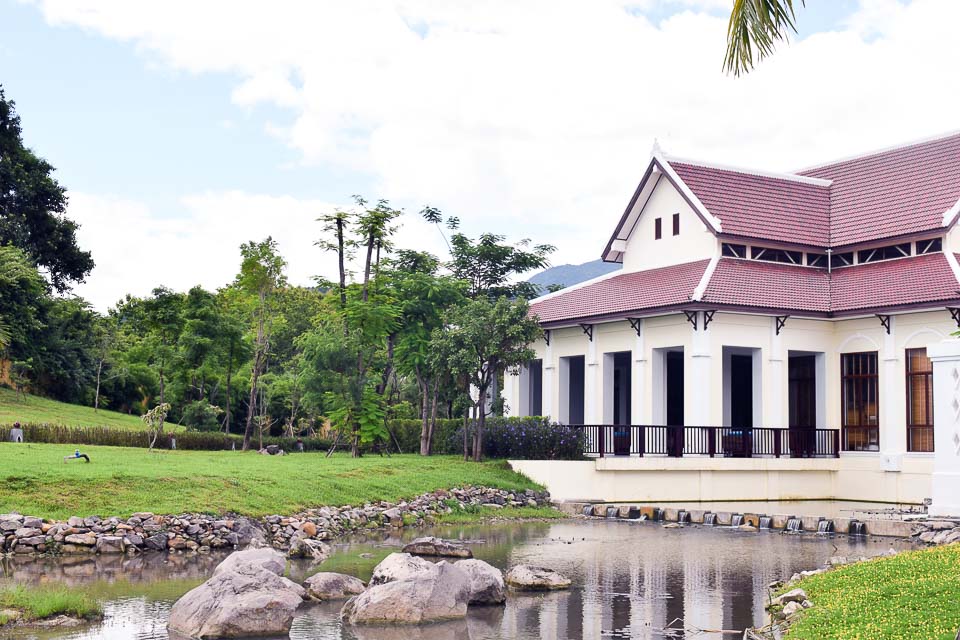
Also read: A list of movies to watch before you visit Luang Prabang, Laos!
My Favourite Things to do in Luang Prabang
- Witness the Morning Alms Giving Ceremony
- Visit some of the most exquisite Buddhist temples of Southeast Asia
- Trying Honeycomb during breakfast at Morning Market
- Shop at the famous Luang Prabang night market which runs till 11 pm
- Sail down the Mekong River
- Taste Laos Coffee
- Day trip to Kuang Si Fall. If you have some more time, visit the hill country of Nong Khiaw further up
This is more like a bucket list things to do in Luang Prabang. I have written in detail more cultural things to do in Luang Prabang in the later part of the blog post!
Why Visit Luang Prabang, the UNESCO Temple Town!
There are numerous reasons to visit Luang Prabang. It is a historic town with crucial strategic importance in modern politics. Located by Stunning Mekong river, Luang Prabang has an abundance of cultural experiences for a first time visitor in Southeast Asia. The town of Luang Prabang is also located close to Kuang Si Falls, making a perfect day out for an adventure amidst pristine nature. You can easily plan a trip to Luang Prabang for 3 days or more depending on your interests and how you want to relax.
Find the Dragons of Luang Prabang!
Mountains covered with dense foliage stand tall, guarding Luang Prabang from the world outside, safekeeping her secrets from olden days. Ancient mythology reveres them as dragons, protecting Luang Prabang from the evil eye that pry on the plain-land! “Fire can not kill a Dragon!” Landlocked from every aspect, Luang Prabang takes her sheen from the rusty orange water of Mekong river. Tourists can go hiking through one of these trails and get a bird’s eye view of Luang Prabang.
Majestic River Mekong!
The town sits pretty at the confluence of Nam Khan and Mekong river. Abundant signage of life prevails everywhere. Flow of Mekong continues from China. Periodic flooding of Mekong causing distress for Luang Prabang and greater regions in Laos is an annual occurrence in this part of the world! New layers of alluvial soil carpets the soil that grows plenty of vegetables. A taste of traditional cuisine of Luang Prabang will hard press you to bow down to the mighty Mekong, Mother Mekong to the residents!
Explore the Land of Buddha dotted with French cultural remnants
I close my eyes and take a deep breath to fill my heart! Air in Luang Prabang fills wholesome, soulful. It reaches my heart and cleanses the path along the way! From the air, the town looked exceptionally pretty! Tiny houses with bright red thatched roofs thrive amidst manicured gardens! Dots the land shining pagodas with gilded heads! There are 33 of these old temples, I learned from the UNESCO portal! Luang Prabang is one of the three UNESCO Heritage sites in Laos.
The Old Town of Luang Prabang has preserved age old architectural wonders of various kingdoms that ruled over the land and brought in something new at every fold of history. As a result, you will find a quaint little French style bungalow with ivory white glass panels right next to a Buddhist pagoda adorning traditional folktales on its golden wall panel. Monks in blood-maroon robe cross wooden bridges from distant rural areas to reach Luang Prabang at the wee hours of the day break to collect alms.
Tourists can break their fast with freshly baked baguettes and steamed Poisson smeared with exquisite dill at the morning market. Luang Prabang is an extraordinary yet tiny hamlet where cultural traits of both the world are hemmed together!
Find your inner peace
At the risk of sounding cliched, I found Luang Prabang as the last bastion of peace and quite in Southeast Asia. Only a handful of offbeat destinations have successfully retained that unscathed charm in the region. This, despite Luang Prabang making frequent appearances on travelers’ list in Banana Pancake trail!
In this travel Guide to Luang Prabang, I tell you about the practical travel tips to explore the region.
*Banana pancake trail refers to the backpacking route western tourists usually follow in Southeast Asia.
Luang Prabang means “Royal Buddha Image” in Lao language!
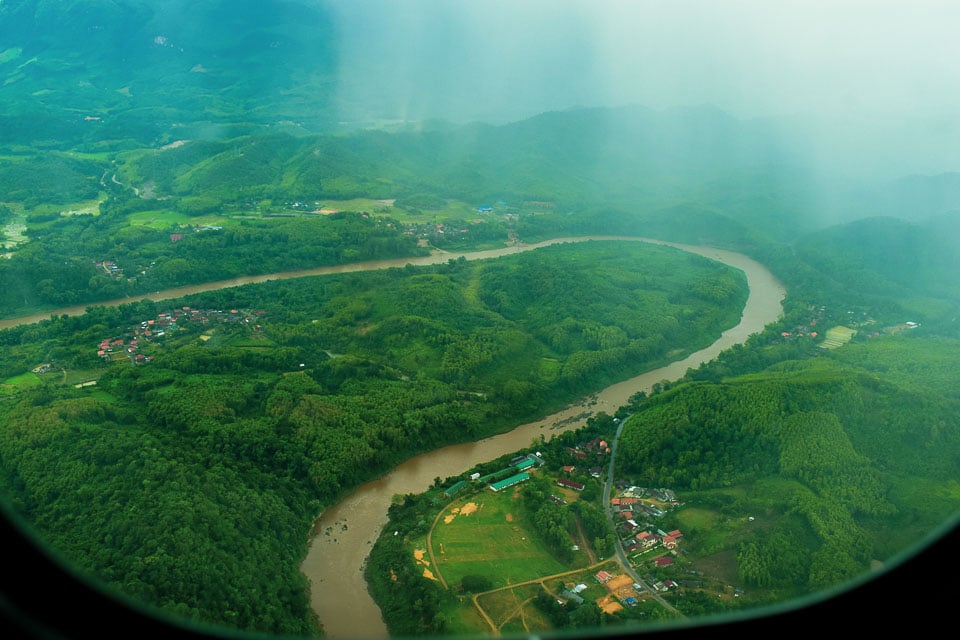
Also read: 20 books to read before you visit Luang Prabang!
History of Luang Prabang for the First Time Visitor
Luang Prabang, the Land of Million Elephants
Strange as it may sound, it was not all siesta and jolly times for this idyllic retreat in Southeast Asia! Luang Prabang has witnessed turbulent times until recent political history. Flames of the Second World War touched her scantily with the Chinese and Japanese troops, then loggerheads with Vichy China. Western Colonists of French sucked out plenty of resources until recent communist upheaval. There have been instances of violent clashes between Pathet Laos and Viet Minh, political streams of the region inspired by communist ideology. Similar exploits I witnessed during backpacking Vietnam for two weeks.
Tracing back the Ho Chi Minh Trail of Southeast Asia!
Not many know that Laos PDR remains the most heavily bombed country in Southeast Asia, thanks to the ensuing Vietnam War and America’s secret air war in close vicinity. I recall climbing an old cave perched atop a steep monolith somewhere at Nong Khiaw , a quick day tour from Laos (even better if you stay there for a few nights).
The trail was marked with plenty of bombshells and bullets, reminding you of a madness that brushed past Luang Prabang in the recent history. Suddenly the air feels heavy and somber, reminding you what a privilege it is to be able to travel and soak in the grandeur of the world!
One of the best mindful things to do in Luang Prabang for a cultural traveler is to visit the one of the many UXO visitors’ centers of the country and learn about the grim history of Laos. The mountains on the north are laden with such UXO till date.
The Curious Story of Laos Coffee
The French brought Coffee in Luang Prabang! A lot like British started the art of drinking tea in Darjeeling , India and Sri Lanka .
Keeping aside the gloom of an unjust war (lest we forget), one cultural attribution that has been ascribed to Laos from the west is the habit of drinking coffee! The French started to experiment with coffee harvesting in Laos and the yield was beyond expectation. Today, Laos exports close to 5000 tonnes of Arabica and Robusta, which is a triumphant result of that experiment! It is intriguing how a buffalo dairy has been established and working full fledged to supply dairy products for quenching the thirst of the hospitality industry.
“ Do you like to drink milk ?” I asked my kind and knowledgeable Laotian guide.
He smiles and shakes his head in negation, almost embarrassed!
Water buffalo , both wild and domesticated, roams freely in the verdant valley adjacent to Luang Prabang. They contribute immensely to the agrarian economy of Laos. Water Buffalo meat is used in Laotian cuisine, both fresh and dried in jerky form! I spotted only one or two cows in Laos. It felt a lot like rural parts of India. However, traditional Laos culinary skill has no use of dairy product.
History traces back life and culture in Luang Prabang circa 8000 BC. Though Laos PDR has succumbed to poorer scale of economic segregation at this moment, it reached the zenith of art and culture during 14th century. Most of the Buddhist temples and monasteries were built at that era! Some of them have crumbled down but ever since UNESCO ascribed Laos with the honor of a World Heritage site, the town has been preserved tastefully by the committee.
Did you know: Mekong river is also known as Nine Dragon river in Vietnam ( Sông Cửu Long) !
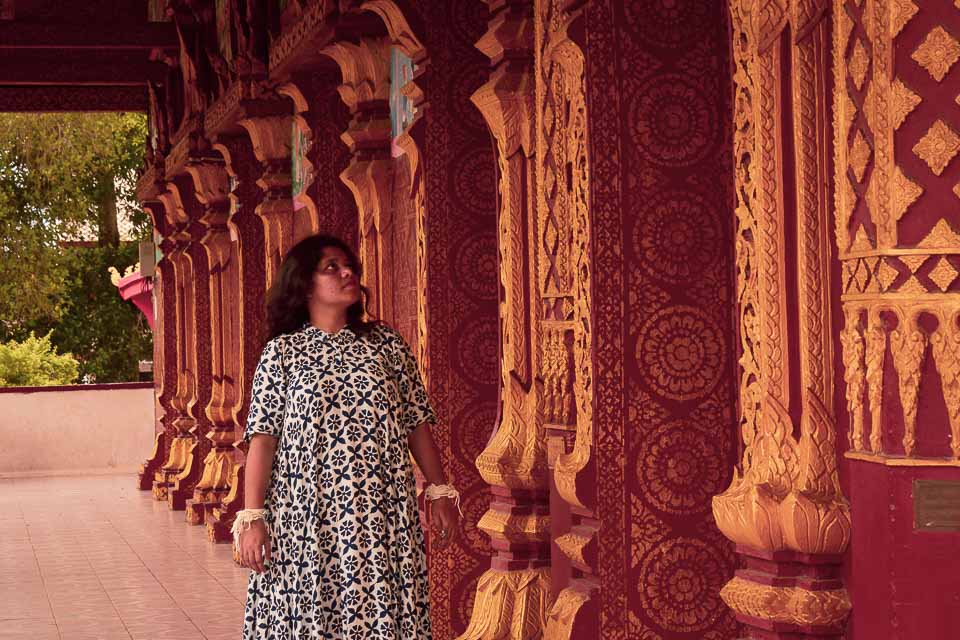
How to reach Luang Prabang
It is easy to reach Luang Prabang from every region of Southeast Asia. Traveling to Luang Prabang is a good idea to start exploring Laos.
To reach Luang Prabang by flight : Laos airlines, Bangkok Airways are some of the most famous airlines connecting Luang Prabang with the rest of the world. You can also take the night train from Bangkok and continue to Luang Prabang from the border crossing point. Airport Code of Luang Prabang: LPQ (Luang Prabang International Airport).
To reach Luang Prabang by slow-boat : You may want to sail down to Luang Prabang from the hills of northern Thailand (Chiang Mai region). It is one the iconic boat-ride route in Southeast Asia, a lot like the boat that sails down from Mandalay to Bagan on the Irrawaddy river. Though time is a luxury that many of us may not be able to afford! Nowadays, luxurious teak wood boat frequent on this old passage to Luang Prabang!
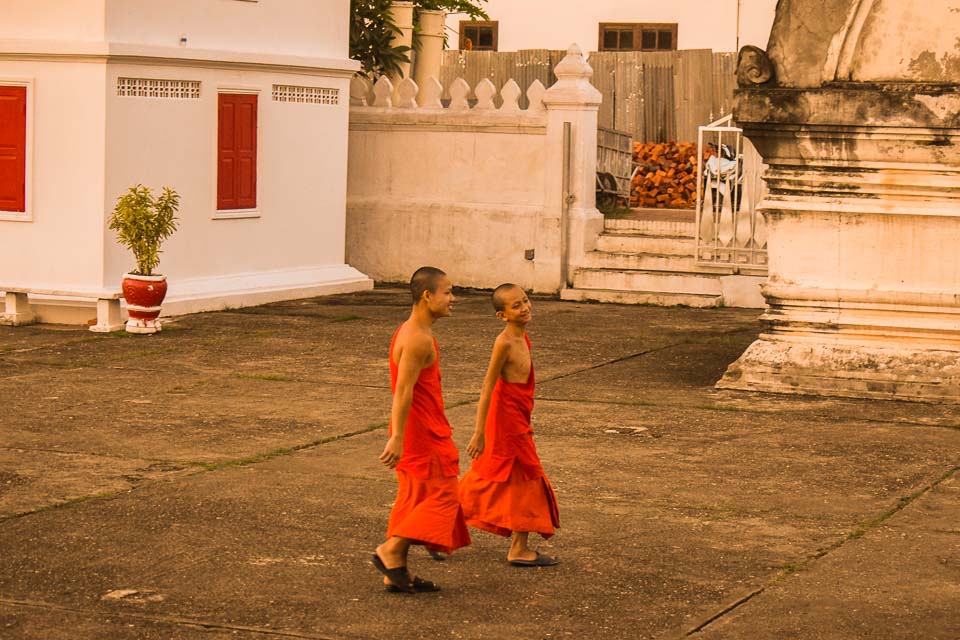
Also read: Spending a night at the Suvarnabhumi Airport, Bangkok!
Scoring a Travel Visa for Laos
Get Visa on Arrival at Luang Prabang International Airport . Indians too get a Visa on Arrival in Laos.
Laos is one of the few countries that allow Visa on Arrival for Indians passport holders . You may fly in to one of the international airports of Laos or cross the border from Thailand and get your visa stamped. For details of obtaining a tourist visa for Laos, check out this website .
It is possible to travel to Luang Prabang and obtain a Laos visa on arrival from the international airport.
Documents to produce for applying a Laos Tourist Visa on Arrival with an Indian passport:
- Confirmed accommodation in Luang Prabang or other destinations in Laos
- 2 passport size photo (4*6 CM. Transparent glass if you wear specs. Also ensure the background is white or at least a light color)
- Return airfare (within a month of date of arrival)
- Visa Fee (30 to 42 USD for various countries). For Indians, you need to pay INR 2180 (USD 30). Currency accepted for obtaining a Laos Visa on Indian passport: USD, Lao Kip, Thai Baht
- Visa on arrival is granted at all international airports of Laos and most of the international border crossings (for example the Chiang Mai to Lao border which many opt to visit on a slow boat if not a bus.)
- You may stay in Laos for 30 days with a Visa on Arrival. For extension, you can opt for another 60 days visa from the embassy.
(Please note, once travel resumes post lockdown world, visa rules may change. Request you to call the Embassy for best practice before you travel to Laos!)
Also read: Exploring the Baba Culture of Old Phuket Town, Thailand
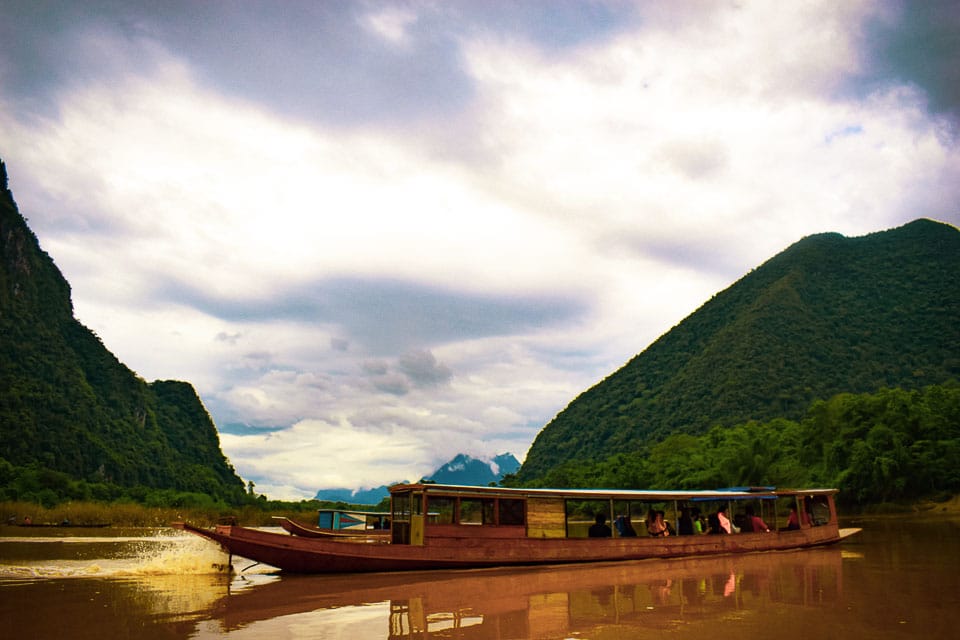
Also read: Complete Guide to Visit Goa for a First Time Visitor
Things to know before traveling to Luang Prabang
In this section, I will furbish a few essential travel tips for the first time visitor to Luang Prabang. If you have visited Southeast Asia frequently, you can be rest assured of many similarities between tourist infrastructures and cultural nuances between Laos and Thailand or Laos or Vietnam !
The only difference I found in Luang Prabang was a gaping absence of a Chinatown and glass noodles that the Chinese traders ferried across the globe through maritime activity. Be rest assured, Chinese were there, building dam, making roads, progressing metro ready to swallow down Luang Prabang melancholy!
Currency for traveling in and around Luang Prabang, Laos
Lao Kip is the currency of Luang Prabang and the whole of the country, Laos PDR.
While Lao Kip is the legal and national currency, many tourist establishments actually accept USD as well. Keep some changes handy. While par-taking one such transaction, keep a track of the ongoing exchange rate.
Usually, 1 USD is exchanged for 9,500 kip! (Update 2022, Laos Currency has increased to 15,000.)
Cards are accepted at big establishments. Small bills will save your soul at rural areas and small food joints.
I did not spot many money exchange kiosks or shops in Luang Prabang. One was at the airport. The other one was near night market area, on Sisavangvong road. A few sparse ATM machines stand here and there. But cash walks the talk in most of the shopping centers in Luang Prabang so get money exchanged when you can.
Count the change given to you at the exchange parlor to avoid confusion. You will be a millionaire in Luang Prabang after exchange is done, all thanks to inflation legacy ensued from the days of Pathet Laos!
Best time for traveling to Luang Prabang!
How is it visiting Luang Prabang during July or rainy season?
Usually, the dry months of October to March are the best time to visit Laos, like the rest of Southeast Asia. I visited Luang Prabang in July though. It was humid, but not as sweaty as Bangkok.
By the end of July, the rainy season starts in Luang Prabang. Just the week after I left, Laos was heavily flooded . I would suggest you avoid the rains at all costs. Flooding is a real a possibility. Roads are often inundated and pose a threat to commute system.
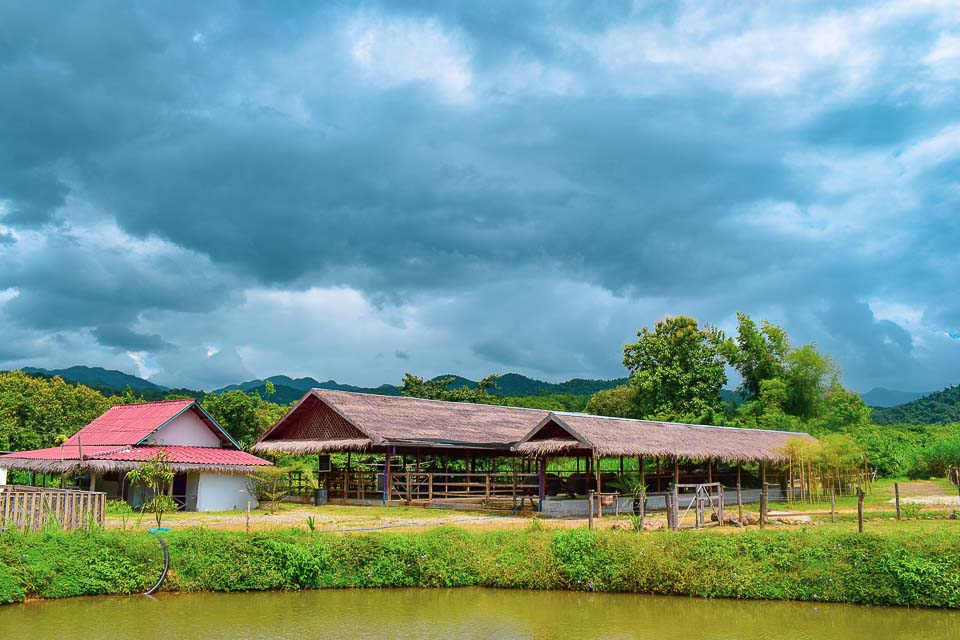
Also read: Alternate Things to do in Luang Prabang: 11 Cultural Laos Experiences !
Dos and Don’ts of Luang Prabang: Cultural Nuances and other things to know before traveling to Luang Prabang!
As a travel blogger forever on a quest to explore a destination through its culture, it was rather easy for me to fall in love with Luang Prabang. Countless temples dating back to olden days, generously genteel and kind commoners, working from the crack of the dawn till the day break, having a square meal of rice and fish with widespread smile, world’s seventh largest river, Mekong flows as a silent witness to these myriad vintages of life. Luang Prabang felt like that promised land, where misery is kept tightly locked inside the Pandora’s box!
While taking part in tourist activities in Luang Prabang, please be sensitive for the local culture. Like many other parts of Asia, Luang Prabang is also a mix of contrasting human emotions. Communist ideology and a deep respect for Buddhist culture share every household.
Laos PDR is a Communist country
And no, they do not sell Che Guevara tees at the night market in Luang Prabang!
Laos is one of the last few remaining communist countries of the world. A visit to rural Laos could be an eye opening experience! It reminded me of the old Soviet propaganda posters and magazines of a shared farm, compassionate (and just) village system and food for everybody, an essential promise fulfilled. But I was there for a couple of hours only.
They say Laos is a poor country. Well, we can not ignore economic indicators. There is no denying to the fact that Laos, though cherished with nature’s abundance blessing, is yet to overcome the lasting impact of the colonial system. And the secret war of 70s. Chinese debt trap looms large at the doorstep.
But the wide smile and warm hearted people of Luang Prabang show a content lifestyle in everyday chores.
At Luang Prabang, with more influx of foreign tourists, the communist face of Laos may have taken a backseat. But the usual hustle of the shopping mall and a handful of human mechanisms rushing towards a tube-rail was not found anywhere. What a relief that is, I wish I could express in words.
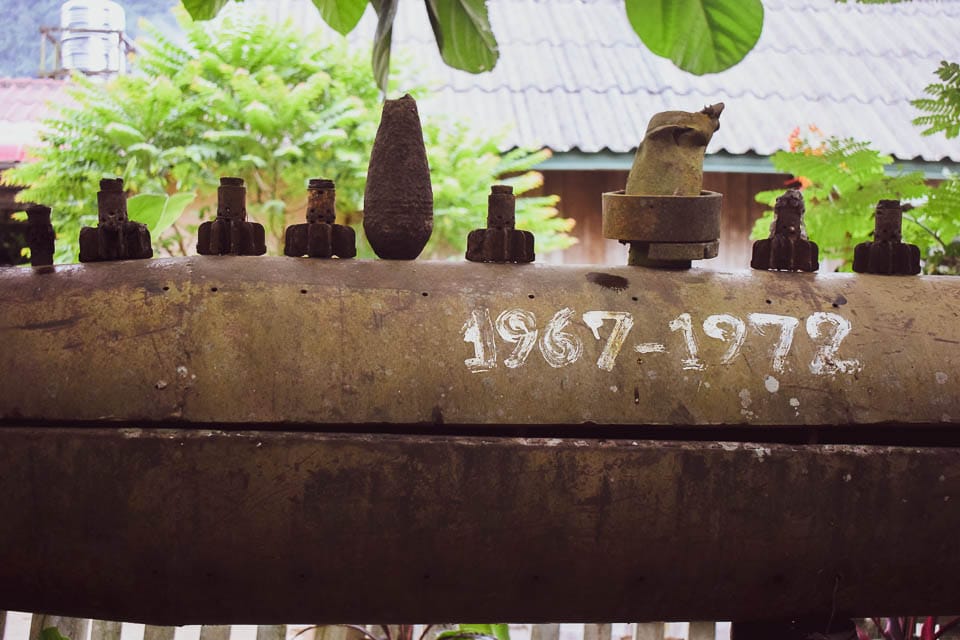
Also read: Complete Guide to explore Nong Khiaw: a remote mountain paradise in the Northern Laos!
Slow is the order of the town in Luang Prabang!
Traveling to Luang Prabang is essentially another name of reconnecting with your inner self!
Time stands still in Luang Prabang. I am not exaggerating a bit! Even when thousands of backpackers or French vacationers flock in to get a taste of their erstwhile “Oriental land”, Luang Prabang operates on a separate time zone. Life is a lot easier and calm in this tiny old town and you better revere it like that! If you fancy slow travel, Luang Prabang will enamor you like no other place in South east Asia! Sip on a chilled glass bottle of BeerLao and watch the Sun go down by Mekong and monks clad in maroon robe cross the river! In many ways, Luang Prabang reminded me of the unequivocal charm of Varanasi .
Don’t touch the monks when in Luang Prabang (or anywhere where Buddhist culture is prevalent)
I stood in the crowd at the night market of Luang Prabang, dodging from one vendor to another, when the locals all of a sudden stood in caution and sobriety. Curious, I looked around while a woman with a baby on her shoulder snatched my absent minded body to one corner of the paved road.
“Monk.. stay away!” she wailed.
It dawned on me that I am a mere mortal, a woman and supposed to keep distance from the Buddhist monks, even if they are just children. Ashamed, I learnt a lesson for life!
NEVER TOUCH THE MONKS.
Not that my intent was to touch them. Not even a stumbling is allowed. This is as important as wearing long skirts and modest dress before visiting the Buddhist temples in Luang Prabang!

Also read: 25 beautiful pictures of Laos that will inspire you to travel!
What to Wear when traveling in Luang Prabang?
Try to stick to comfortable cotton wears while traveling in Luang Prabang. The place does not get very warm, neither winter is tolling here. You shall love the mild evening breeze during golden hour. The sunrays will kiss your skin aplenty while going for the quad biking and other action packed adventures in the mountainous regions adjacent to Luang Prabang, Laos.
Be mindful of what you wear while visiting the old temples of Luang Prabang, Laos! There are plenty of Buddhist temples, one at every bend of the road and they are beautiful! In fact, these temples are the main constituents of Luang Prabang’s ethereal character!
While visiting the temples of Luang Prabang, check for the following:
- Is your dress covering your shoulder?
- Is your skirt or pant going below the knee?
- Would you consider them as modest/appropriate while visiting a place attributed to spirituality?
Modest clothing is advised while visiting the temples of Luang Prabang. I always carry a scarf. That saved me from from quite a few embarrassing moments during travels!
Luang Prabang is relatively a new entrant in Backpacking Route of Southeast Asia
Banana Pancake trail of Southeast Asia and Luang Prabang travel guide!
Luang Prabang only opened door to tourists in the year of 1989. Laos was a closed country before that and traveling to Luang Prabang and other parts of Laos was a rare occasion in the world before!
Speak English/ French/ Body language in Luang Prabang!
English is spoken and understood in Luang Prabang, to some extent. Beyond that, smiles connect! Since Luang Prabang was under the rule of French, French is spoken and understood widely. Chinese and Thai can do the job as well.
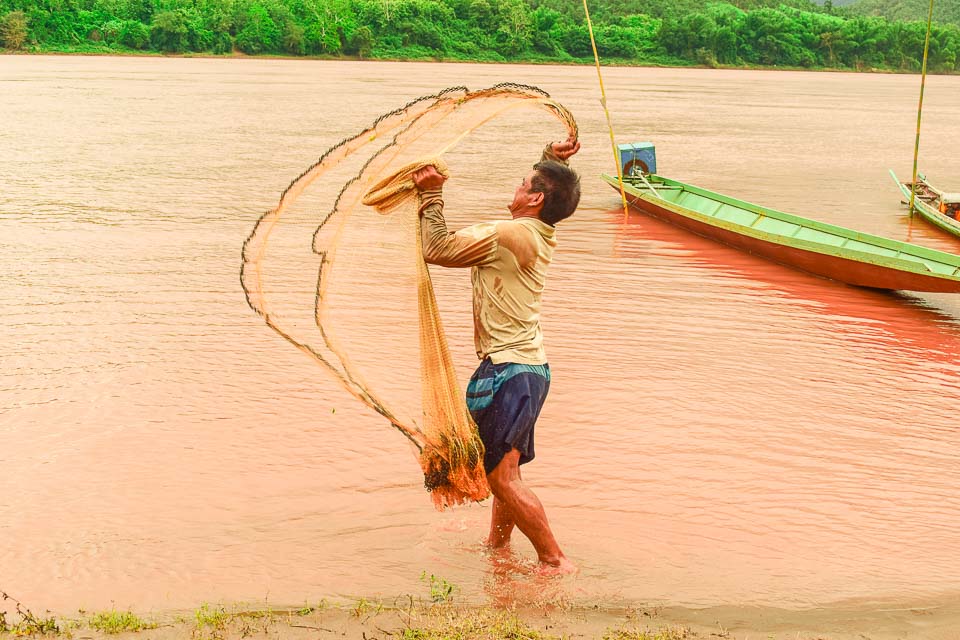
Also read: 15 beautiful destinations in Vietnam!
The Shrimp season in Luang Prabang: travel incentives for the gourmands!
Fancy dining on the “river pearls” or shrimps from the heart of Mekong river? Plan a visit to Luang Prabang during July or August. These sweet river prawns differ greatly in taste from their marine counterpart and have distinct flavor, enhanced with the chilli sauce produced at Laos households. If you visit areas close to Sop Jam or Muang Ngoi, you might find fisherman folks using bamboo sticks and diving to the river bed in search of these prawns.
Frangipani: the Champa flower of Eternity from Luang Prabang!
Frangipani is the national flower of Laos. In Luang Prabang, you will see frangipani in bloom everywhere. The flower is used in abundance to decorate a traditional dinner spread in Laos. It is not edible though. In fact, Frangipani is poisonous. While in Luang Prabang, try the local moonshine that is procured from frangipani. Go slow with the drink. It hits you hard, specially if you are an occasional drinker. In Luang Prabang, I also spotted wine bottles that caged a snake or scorpion, a lot like Hanoi . These bottles of moonshine are to be consumed in Luang Prabang itself, you can not bring them back home.
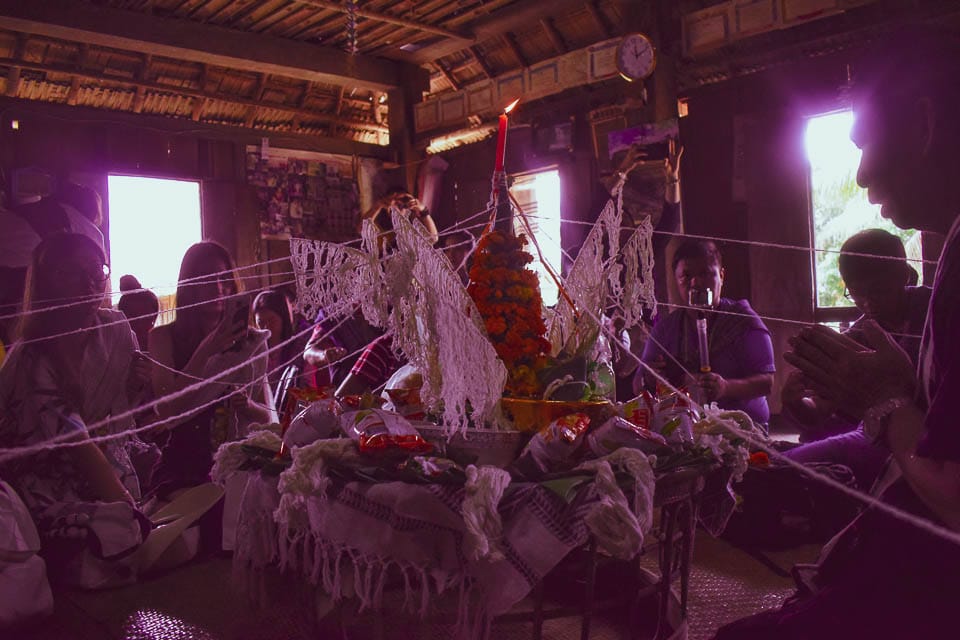
Local commute while traveling in Luang Prabang
Luang Prabang does not have an Uber/Grab system yet. The three wheeled tuk tuks are your best friend in the city. In Vientiane, I heard they started a cab service named Loca.
For a taxi, you need to contact your guest house. Airport at Luang Prabang has a taxi stand too.
The easiest way to commute in Luang Prabang is to rent a bike. You can rent a cycle from the hotel/hostel/guest house you are staying in as well. Hiring a scooty in Luang Prabang should cost you around 100k kip for a day. Like Langkawi or Goa , renting a scooty gives you an edge over other methods of commute and certain degree of independence. People in Luang Prabang and the rest of Laos drives on the right side of the road.
Legacy of Laotian Coffee: Travel to Luang Prabang to drink coffee!
While Vietnamese coffee often steals the limelight for coffee lovers in South east Asia, the coffee connoisseur soul of yours are in for a surprise treat in Luang Prabang! There are plenty of pretty cafes, Saffron cafe being the oldest of the lot, who serve freshly brewed Arabica or Robusta of your choice! Laos coffee is chocolaty and thick with a robust flavor.
Coffee in Laos is prepared with condensed milk with heightened tones of sweet buds. In Laos, Coffee is mainly harvested at the Bolaven Plateau area in south.
Some of the best coffe-shops in Luang Prabang are: Saffron Coffee, Cafe de Laos, Indigo Cafe.
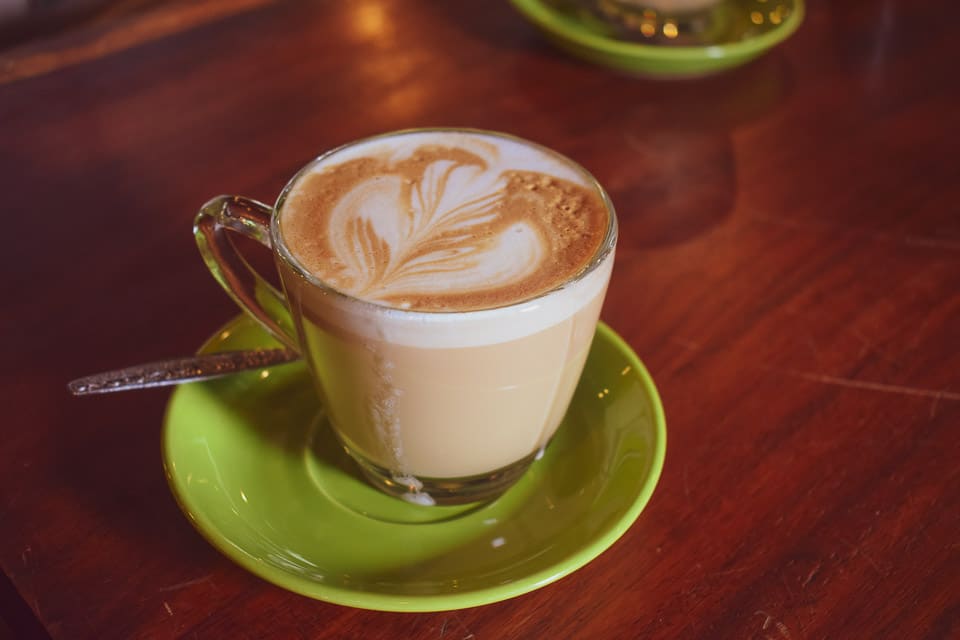
Nightlife in Luang Prabang! (And The Night Curfew)
After nightfall, Luang Prabang is not a Phuket or a Hoi An ! Even when there is an increasing pressure of tourist footfall, Luang Prabang retains its sleepy charm with elan. Nightlife in Luang Prabang is rather mellow with a vibrant night market selling local produce by the distant hill communities, intricate textiles and rustic Laotian food. A handful of bars operate. A few alleys go abuzz with live music. A Khon dance performance with masked dancers take place at the Royal Ballet Theater. Luang Prabang seeps early and I love her like that.
After 11:30 there is a curfew at the Old Town of Luang Prabang that forces all establishments to shut down the doors. The midnight curfew in Luang Prabang is enforced by UNESCO and duly observed. If you want to live up the night, drive for 10 more minutes and reach Bowling Alley (backpacker’s hub) for more fun.
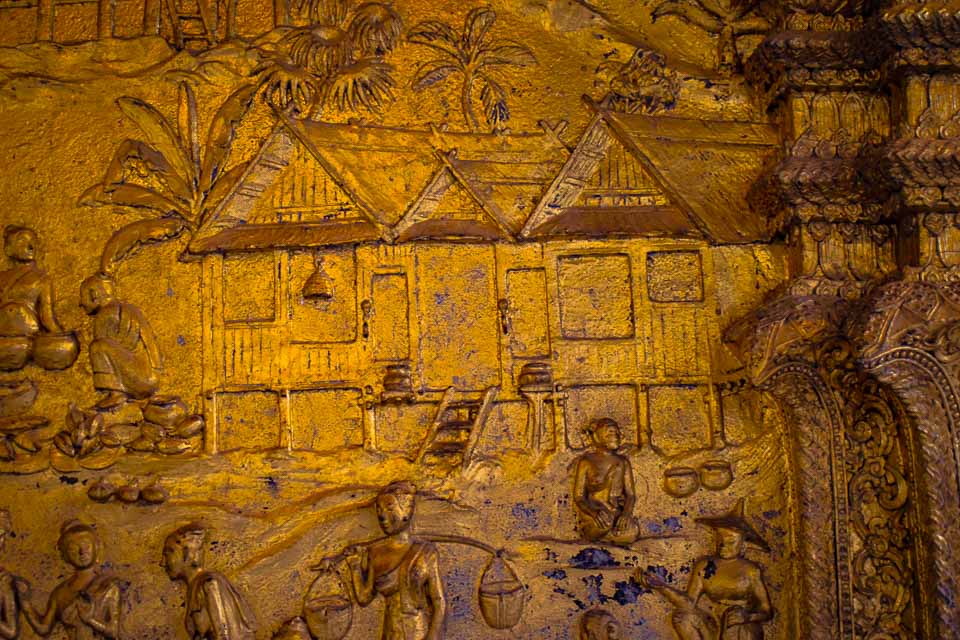
Traveling to Luang Prabang is safe for solo travelers?
Luang Prabang is NOT a dangerous destination!
I was traveling with a group of people in Luang Prabang, Laos. I was a guest of the Luang Prabang tourism board. I am not the one to comment if it is safe to travel solo per say.
But then I traveled solo in Banaras, Uttar Pradesh, in the north of India and remain unscathed. And I think Luang Prabang is a safer place compared to that. So, there you go!
I feel people in Luang Prabang are the kindest lot in the entire region of Southeast Asia! They are ever smiling, the guides are kind and they often go out of their way to show you the best of their country. Think about the fisher man whom I had shown in my Luang Prabang vlog.
He showed us the tricks of fishing, invited us over home, was eager to share the catch of the day and introduced us to his kittens. A fisherman who fishes for his cats. This has a tune of melancholy steeped deep somewhere!
People are very friendly in Luang Prabang. If you have to walk alone at night, be careful of the stray dogs. Some of the lanes did not have night lamps. The night market of Luang Prabang and adjacent area were safe though.
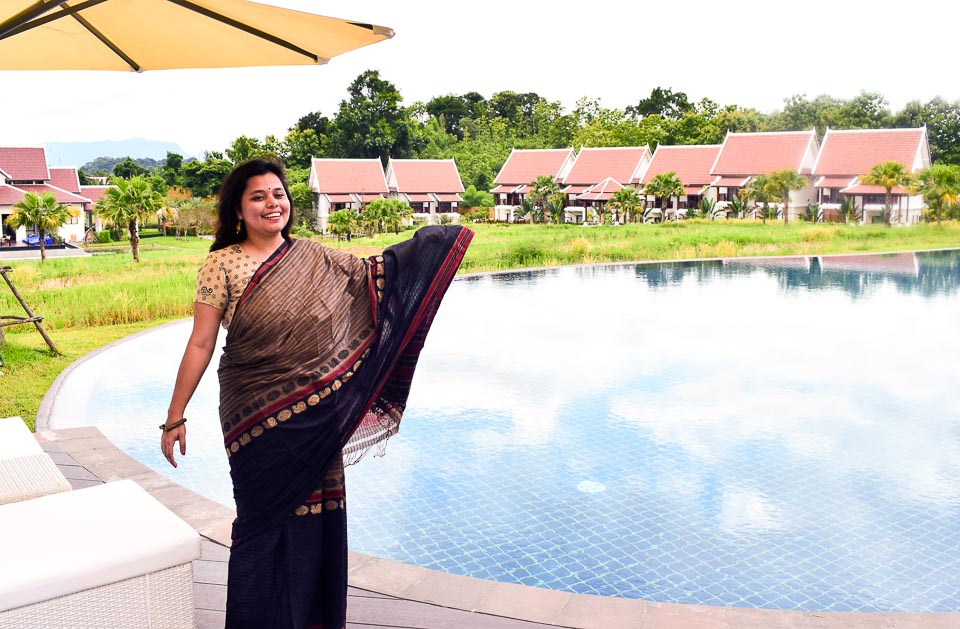
Where to stay in Luang Prabang?
Where to stay while traveling in Luang Prabang? Finding the best neighborhood in Luang Prabang.
It is always wise to stay close to the Old City of Luang Prabang for easy access to all the central attractions. Luang Prabang largely remains devoid of the nuisance called traffic. Walking is a delight here if you are ready to discount the stray dogs. To be fair, there were not many.
You should ideally be looking for a place to stay in Luang Prabang that is by the banks of the river, yet close to the night market and cafe area.
If you fancy staying further and securing a place by the river, ensure your guest house has a free shuttle to the center of Luang Prabang at regular intervals. Otherwise, commuting could be a challenge.
Check out this map for easy understanding. Your hotel/guest house must provide you with a local map as well for sightseeing.
Neighborhoods to stay while traveling in Luang Prabang with practical comparison:
Old town/ The peninsula: Close to every attraction of Luang Prabang, the old city!
Pro: UNESCO heritage zone, Close to all the main attractions & Mount Phousi, great for family
Cons: Night curfew and no pool allowed at the hotels
Mekong Riverfront: A peaceful and scenic neighborhood in Luang Prabang
The area between Phothisalath Rd (the main road) and Khem Khong (the Mekong road). Dotted with budget guest houses. The area has a residential feel about it. Plethora of makeshift restaurant dots the riverbank in the area, perfect place to hang out in my opinion.
Nam Khan side: For backpackers and night owls
Pro: Backpacking vibe. Vibrant nightlife (outside the night curfew zone), cheap hostels
Cons: Further away from the major attractions of Luang Prabang
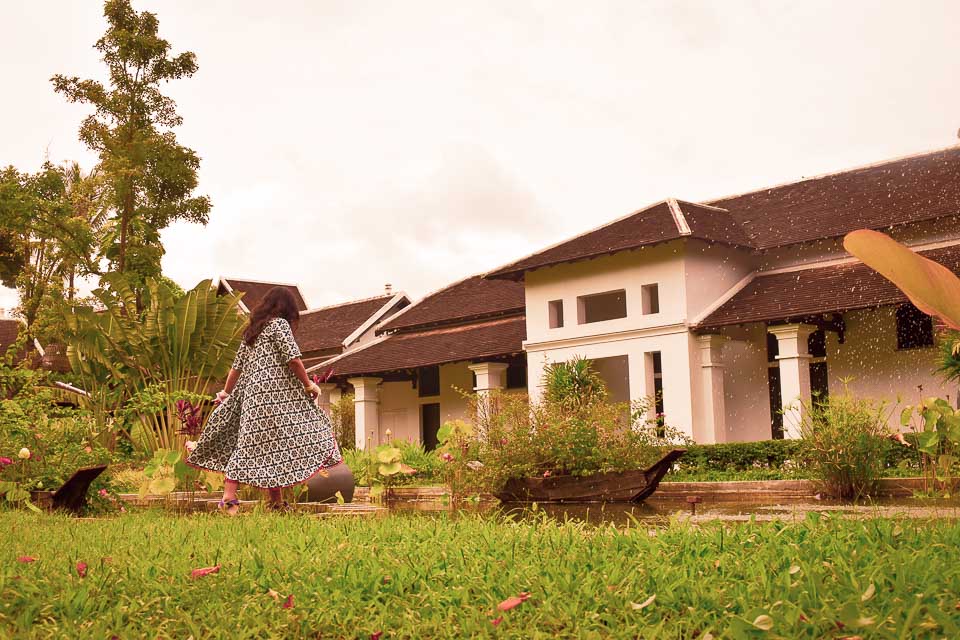
Many of the old French colonial buildings have been refurbished into luxury stylish boutique accommodation. You may book a stay with these bespoke properties as well. It is one of the unique experiences of Luang Prabang travel.
I stayed at Sofitel Luang Prabang , one such property. I had a chance to go to Pullman Luang Prabang and Avani as well, both beautiful luxury properties. These luxury stay options in Luang Prabang often are located far off the city, allowing a shuttle to arrange periodic transport to the city center. Staying close to the old city will make it easy for you tick off from the list of things to do in Luang Prabang!
Also read: Old Phuket Town , a culturally immersive guide to explore Phuket!
Best things to do in Luang Prabang, Laos
3 to 5 days in Luang Prabang are enough to explore the town and surrounding areas. There are plenty of cultural things to do as well as exploring nature. I have listed some of them in the travel guide to Luang Prabang.
While life significantly slows down thanks to tranquil vibes of Luang Prabang, there are still plenty of things to do for tourists in Luang Prabang. You can take your time to explore the old town of Luang Prabang. Reserve some time to conduct a few day trips around Luang Prabang. Indulge in a relaxing spa with aromatherapy oil. Orient Express in one of the premier choice for this service.
Things to do in 3 days in Luang Prabang : Highlight
For a curious observer Luang Prabang unfolds each day with newer quirks. For a typical three days itinerary in Luang Prabang , you can keep the mornings reserved for alms giving ceremony. Follow that up with a visit to the morning market. Look for the grilled honeycomb, a rather bizarre dish from Luang Prabang that I never found anywhere else in Southeast Asia!
The second day can be reserved for a boat ride down Mekong river, visiting the hill tribes or going to the Kuang Si waterfall . Reserve one day to walk around the Old town of Luang Prabang and explore the 33 ancient temples with exquisite art work. In the evening, you may climb mount Phousi for excellent sunset view or experience the thriving night market of Luang Prabang. I visited the night market of Luang Prabang each day in evening and absolutely loved it!
Sign up for a cooking school or try out the local Laotian food with Backstreet Academy for one evening! Do not miss the vintage cars that dot the roads of Luang Prabang. Remnants of French colonial past of Luang Prabang! Options are endless, which is why I wrote a separate blog post on that!
Following are a few things to do in Luang Prabang for the cultural traveler, for the nature lover or for one who wants to relax in Luang Prabang. Note that almost every place of interest in Luang Prabang has an entry fee attached to it. Not a lot. Say a 10,000 to 20,000 kip but that becomes a large sum cumulatively considering you have to pay at the oint of entry for almost every monument. I suggest choose your must visit places in Luang Prabang based on what gives you the best value.
Cultural Things to do in Luang Prabang!
The early morning alms giving ceremony in Luang Prabang
Important: Be respectful while taking part in Alms Giving Ceremony
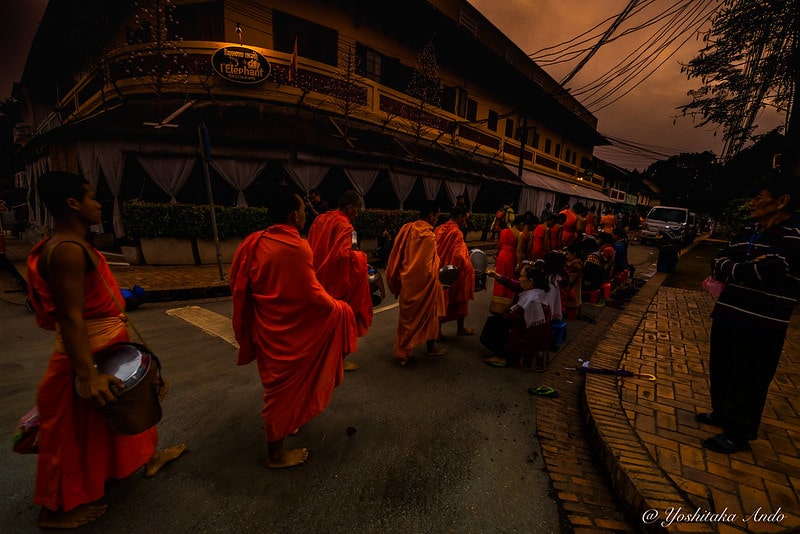
The alms giving ceremony in early morning in Luang Prabang is a deeply cultural event. The practice has been performed since eternity.
Young monks come from distant villages to Luang Prabang and collect sticky rice as alms. We have a beautiful word for this practice in Bengali, “Madhukari”. The alms giving ceremony is an excellent event showcasing the inherent community spirit of the Laotian society.
Off late, the alms giving ceremony has been hijacked with extremely enthusiastic tourists standing on the opposite side of the road with a camera. I stood there in the crowd and felt a lot like Durgapuja days except in this case living human monks are at the center stage of attraction, not the idol.
If you want to experience the alms giving ceremony without the tourist crowd, ask your guest house and opt for a lesser known spot where locals visit.
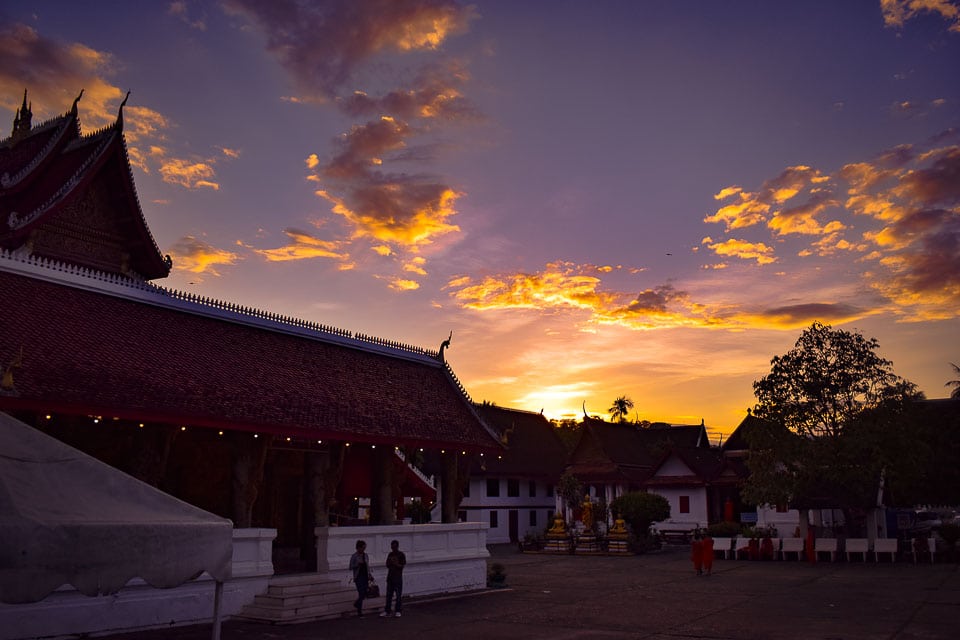
Explore the Old temples of Luang Prabang!
When traveling in Luang Prabang, it is a no-brainer to explore the old temples! They are omnipresent! At the bend of every street, an exquisite temple stands in pride with all her gold and red intricate detailing!
Wat Xieng Thong is one of the oldest temples of the Luang Prabang town and historically the most important one. I loved Wat Manolam which I discovered in serendipity. Look for the detailed panel walks of the temples which tells plenty of stories.
You can also indulge in a cooking class in Luang Prabang to learn the nuances of Laos cuisine! Everything said and done, my favorite activity in Luang Prabang was to sit by the river Mekong and watch life pass by! It sort of reinstated purpose to my life!
In Lao language, you say “Sa Bai Dee” for “Hello”!
The Morning Market of Luang Prabang
Luang Prabang holds one of the most intriguing local market everyday in morning. From frogs to fresh river fish of Mekong, river weed and various leafy vegetables, Luang Prabang night market is the actual one frequented by the locals of Luang Prabang. This is where Mark Weins tried the grilled honeycomb larvae on his Youtube channel. If you love to eat local, and intensely local food, the morning market of Luang Prabang is your place. This felt a lot like fish markets of Kolkata .
Luang Prabang night market runs till 9 am in the morning.
The Famous Night Market of Luang Prabang!
One thing you must not miss when traveling in Luang Prabang is exploring the night market at the old town city center. It is a bustling and vibrant confluence of world travelers and hill tribes who live adjacent to the old town. I can not begin to list out all the products on display and sell at Luang Prabang night market.
On display are beautiful indigenous textiles, handwoven with care and hues with indigo cultivated at the backyard of the communities. The space is also shared between various handicrafts, say a miniature wobbly dragon or an elephant woven in shining threads. Local moonshine and Laotian rice wine are on sale. There are glass bottles filled with snakes and scorpions. Some of the vendors bring in buffalo horns and old figurines, looking like antique pieces. I dare not ask what is the source of these products!
The night market of Luang Prabang takes place everyday from 5 pm to 11 pm. You can try bargaining before making a purchase. However prices are really on the lower side. Transaction takes place in Laotian Kip and cash is the king, like many other places of Laos.
If you are looking for authentic handmade souvenir in Luang Prabang , Laos you may search your quest from the night market!
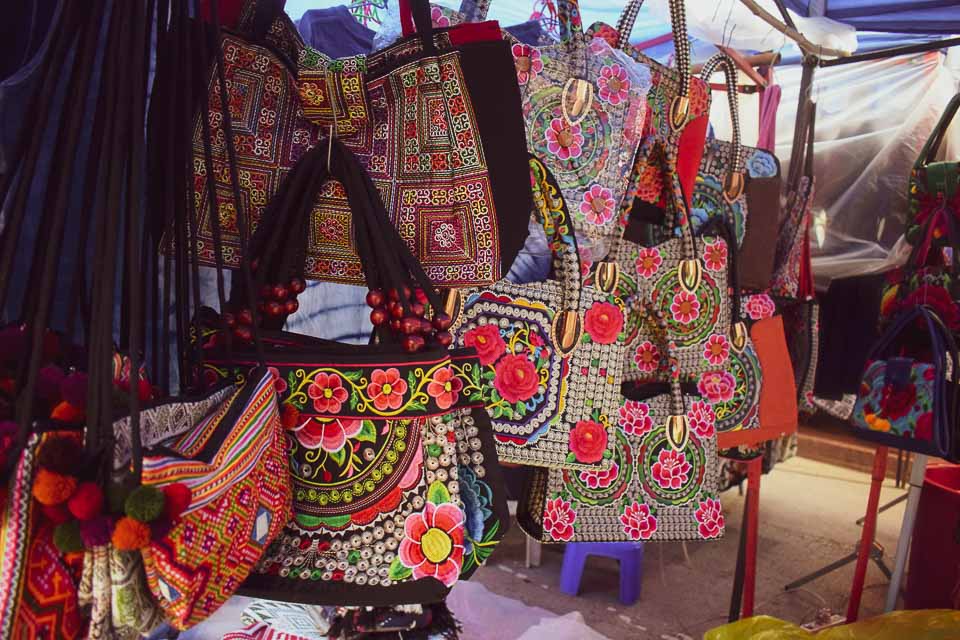
Lounge by River Mekong!
I can not describe in words how beautiful it feels to sit by the Mekong river and watch life pass by. There are plenty of cafes by the river bank. You can set sail on the river as well. One of the best things to do in Luang Prabang is to watch sunset on the Mekong river. The world becomes bright red when that event takes place!
There is a bamboo made makeshift bridge on the river Mekong which has become one of the star attractions of the town. The bamboo bridge gets washed away at the onset of every rainy season but locals rebuild it and how!
There is a provision of taking a luxury sunset cruise in Luang Prabang on the Mekong river as well. Luang Say Riverboat arranges for this service.
Also read: 7 Exciting things to do in Mirissa
Explore the city of Luang Prabang by Foot
Luang Prabang Old City is not very big and is very much explorable by foot.
Start your day slowly, go on to explore many of her 33 gilded Wats (temples of Luang Prabang). Appreciate the traditional style of storytelling through detailed paneling on Luang Prabang.
Take rest in between. Visit a cafe or so. Indulge in a herbal massage. Taste a few grilled chicken in lemon grass straight from the skewer of street side vendors of Luang Prabang. Find the quaint bungalows. Find the vintage old cars that are beautifully showcased at every bend of the road.
Movie Night at a Cafe in Luang Prabang
Luang Prabang (or Laos in general) does not have a lot of movie halls. The locals have found an innovative way to solve the issue. The various cafes of Luang Prabang have started movie nights! From 7 pm or after night fall) many people head to the cafe who run movies on the first floor. You do not have to pay anything extra for being a part of the show. But may be buy a drink out of goodwill. L’etranger is one of the classic cafes in Luang Prabang. It is a good old school experience in Luang Prabang. Coco Home in Nong Khiaw does the same.
Book Exchange Cafe (cafe culture in Luang Prabang)
Luang Prabang is emerging as a destination with a strong innovative cafe culture. Book exchange cafe lets you leave the book you were reading and pick up another one that the previous traveler has left.
Various workshops with local artisans
To live closely with the locals of Luang Prabang and understand how indigenous people has lived here since millenia, consider taking part in one of the workshops. Learn how to make Saa paper, take a class in pottery making workshop. Spend some time with wood carving artisans. Needless to say, a Laos cooking class is beautiful experience. Backstreet Academy conducts a lot these workshops with the help of local guides. Tamarind conducts a famous cooking class, so does Manda de Laos, the restaurant which also flaunts beautiful lily ponds, certified by UNESCO. I specifically loved Fish Mok Pa, Mekong river fish wrapped in banana leaves and steamed. partly because, we have a similar dish in Bengali kitchen named Paturi!
In Luang Prabang, Ock Pop Tok conducts runs a community endeavor to educate tourists about the art of Luang Prabang’s old heritage of fabric weaving. It is said, each villages distinguishes itself from the next one with the help of weaving style. Big Brother mouse is a famous establishment in Luang Prabang that has significantly worked towards developing literacy in the remote corners of Laos. Buy a book (bilingual) for as low as a dollar from this place as a gift back home and in turn help them support teach Laos kids.
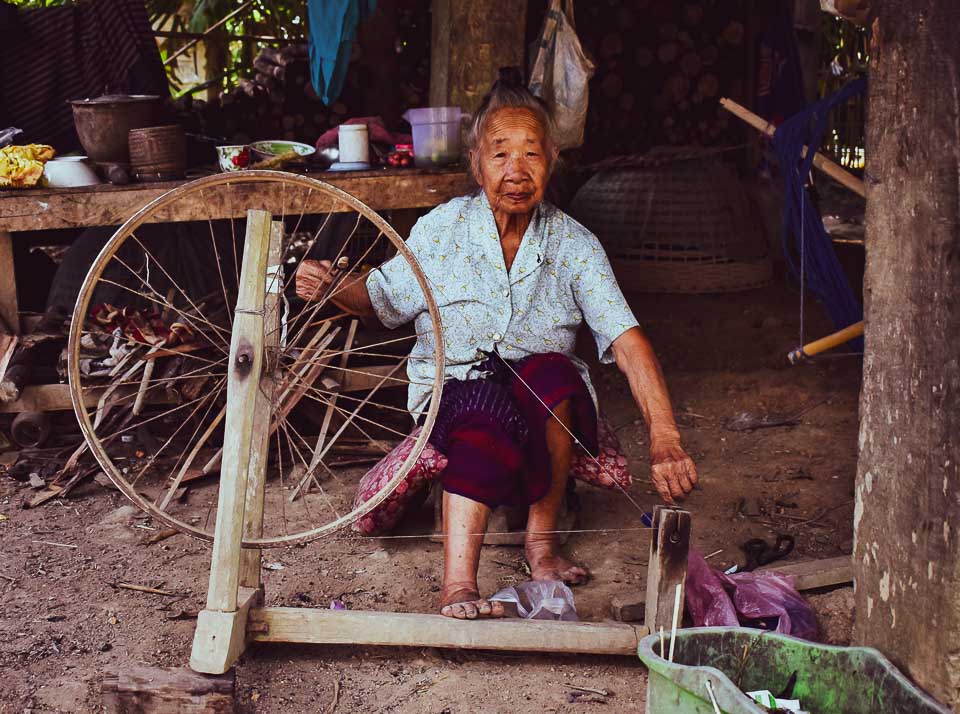
Day Trips from Luang Prabang Town
Luang Prabang has seen tourist footfall and has significantly changed over time. To feel the honest pulse of rural Laos, you need to veer towards the hinterlands!
Kuang Si Waterfall: Traveling in and around Luang Prabang!
Located at a couple of hours distance from the old town of Luang Prabhang, Kuang Si waterfall is the quintessential hidden gem of the entire Southeast Asia. I have seen quite a few massive waterfalls around the globe including Mosi o Tunya, otherwise known as Victoria falls. However very few waterfalls in the world can come close when it comes to the natural beauty of the cascading water flow of Kuang Si.
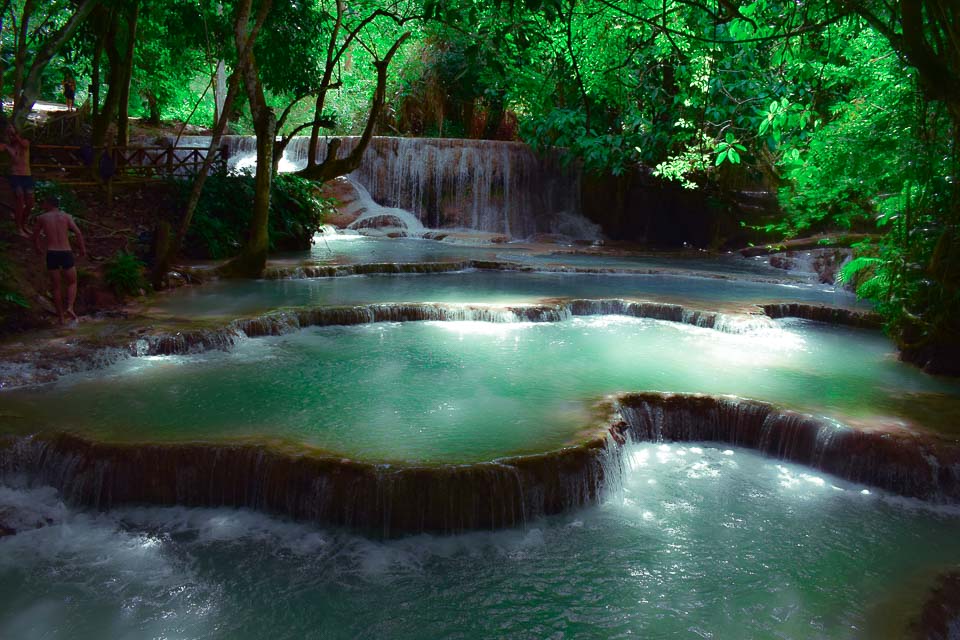
Kuang Si is a multi tier waterfall. You can easily spend three to four hours here as a part of a day trip from Luang Prabang. If you love nature photography and are a water baby, you can easily spend the whole day at Kuang Si. Kuang Si is one of the best places in Southeast Asia for a drone photo enthusiast.
Since Luang Prabang itself stays rather secluded from the crowded backpacking trail of entire Southeast Asia, Kuang Si is not on everyone’s bucket list as a Phi Phi island or a Hoi an is! Nonetheless, Kuang Si deserves to be and will probably scale high up the radar once the Chinese rail line project connecting Luang Prabang to the world outside is completed.
While climbing the waterfall you need to enter the park by paying 20000 kip as an entry fee. For children below 8 years that fee is waived off. You will be greeted with a few playful bears covered with shining black fur. The poor creatures are after hunted for traditional Chinese medicine that needs their bile. The government of Laos has taken a few preventive measures against bear poaching and created a bear sanctuary at the entrance of Kuang Si. Spend some time spotting the bears hanging around the hammocks and bamboo structures. Then proceed towards the fall.
Pro tips for visiting Kuang Si fall as a part of a day tour from Luang Prabang
Visit as early as possible. You shall have the whole Kuang Si fall to yourself. There are multiple layers and beautiful photo opps.
There are multiple spots at Kuang Si waterfalls; each of them will allow you to jump straight into the water. Hold on till you reach the largest section of Kuang si waterfall. That’s a 60 metre high plunge. Swimming is prohibited here.
There is a dirt trail beyond this, marked but not paved, which takes you to the top of the waterfall. I did not venture because the path looked slimy and slippery but some of my friends went on. At the top of the fall, they found a precious still water body of aquamarine hue and a lonely pretty sling indicating human footfall. Infrequent but definite.
Kuang Si is beautiful provided the weather is sunny and bright. If it rains, the waterfall changes its colour from tepid cyann to monstrous flow of muddy untamed water. Forget swimming, half of the trail would be off limits for security during the rainy season in Luang Prabang. Plan your visit accordingly.
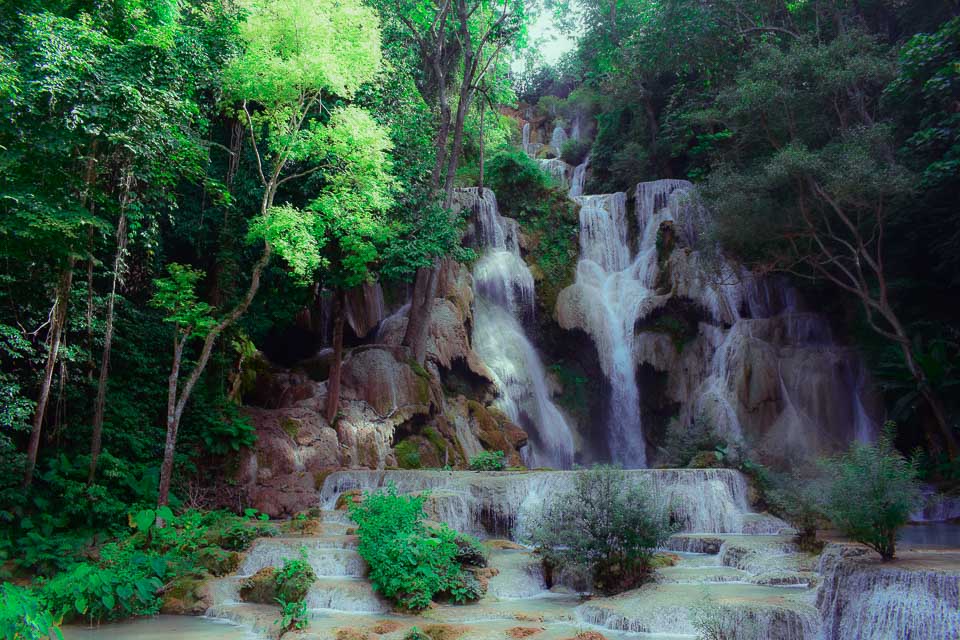
Did you know: Tad Sae Waterfall is an offbeat travel destination near Luang Prabang. This spot is frequented by locals, even the young monks. Best time to visit Tad sea is from August to November, with beautiful blue water making multiple cascades. Tad Sae can be visited by a boat ride on Nam Khan river. Not many travel guide to Luang Prabang has a mention of this place but Tad Sea is definitely a tranquil alternate to Kuang Si falls.
Laos buffalo dairy: traveling with the locals in Luang Prabang
Since the rural part of Laos is largely dependent on agriculture, cattle are a huge part of the local economy. The mountains of Laos had plenty of water buffaloes which later became domesticated and an integral part of the local culture, a lot like what cow means to rural India.
However people in southeast Asia usually do not indulge in dairy products. Milk is not a part of regular consumption here. Laos is no exception.
Luang Prabang receives a number of tourist footfalls each year. Demand for milk or dairy products is constantly on the rise. There is no ready substitute in Laos which can go into the coffee mug or cheese platter. Understanding this gap a group of people from Australia took the initiative of starting Laos’s first dairy farm. Laos buffalo dairy is a part of the day trip that you would be taking to Kuang Si waterfall. I recommend making a stop at the Laos Buffalo dairy and checking out their delectable offerings.
Ban Phanom: weaving village of Luang Prabang!
Famous for the weavers’ village who designed royal clothing in erstwhile kingdom! Ban Phanom appears on the route that you take to explore mountain hill tribes adjacent to Luang Prabang. Also check out the ruined Phon Phao temple and Henri Mouhot’s tomb in close vicinity.
Explore the Rice Fields!
Rice grows in abundance in Laos. STicky rice is the staple diet here. No wonder the outskirts of Luang Prabang will be dotted with sprawling fields of rice fields.
Men donning a canonical hat toils on the land till sundown. When the paddy plants grow and ready to be reaped, they look the most beautiful! You need to scoot around for ten minutes from downtown to come across such paddy fields!
While exploring the paddy fields, look for the water buffaloes, the living tractors of the region. Agriculture is a labor intensive task in most parts of Asia. Laos is no exception.
Nong Khiaw: The remote mountain villages of Laos that you must visit from Luang Prabang!
Located at a distance of hours off Luang Prabang, Nong Khiaw is the most beautiful scenic place I have been so far in my life! This is where the heart of true Laos culture lies, protected by the tall standing monoliths that once provided a cave of respite for the communist revolutionaries. Pha Kuang and Pha Thok caves still have war memories inscribed in the bullets and aircraft destroyers littered around.
Stop by at the village called Ban Nanyang where the Tai Lue community (descendant from Yunnan, China) live in accordance with ancient rules. This is where I took part in a Baci ceremony.
At Nong Khiaw, you may take a hike to the top of Phadeng Peak for a mesmerising view of the Nam Ou river snaking up the mountain hamlets.
Muang Ngoi: If hiking is not your forte, take the long boat and visit the sleepy village of Muang Ngoi, 1 hours upstream ride on river Nam Ou. This place is known for boating, camping and kayaking for adventurous travelers. The town still harbors memories of the secret air war inflicted by CIA in many war artifacts now repurposed for everyday use.
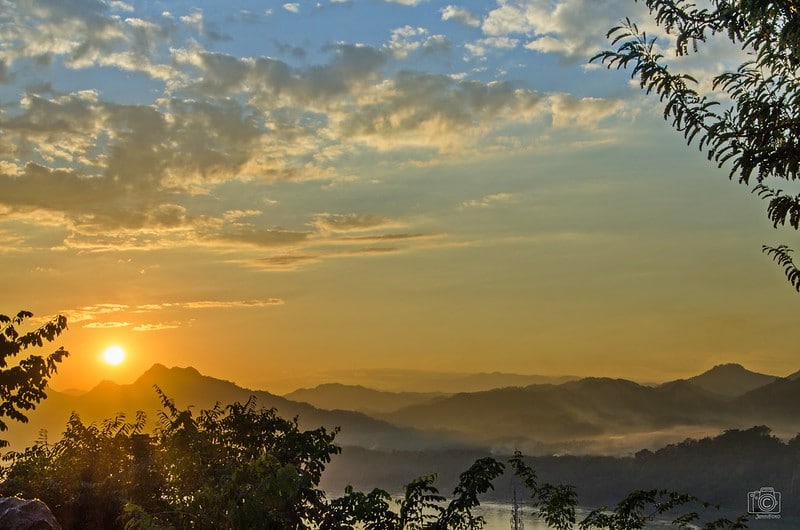
Mount Phousi: Tourist attraction in Luang Prabang for beautiful Sunset spot
For a beautiful Sunset visa, hike up the 100 meter tall Mount Phousi located at the heart of Luang Prabang! The mountain is sacred among the locals. Entry fee to Mount Phousi is 20,000 Kip and there is a marked trail (narrow staircase) up to the top. Dress modestly. Visit at least an hour before to grab your seat! Every traveler in Luang Prabang tries to hike up the mountain.
Pak Ou Caves: Traveling around Luang Prabang
take a river cruise across the Mekong river and visit this ancient cave where 4000 Buddist carvings have been present since centuries. Visiting Pak Ou cave involves a bit of hiking up to reach the upper cave, Tham Theung.
Whiskey Village (Ban Xang Hai)
Remember those snake wine bottles from the night market of Luang Prabang? This is where that local whiskey is distilled and packed. Whiskey village is a part of the Pak Ou Cave outing and rather touristy
Mobile Network in Luang Prabang!
Luang Prabang is well connected with 4G network. Wifi is found aplenty at the cafe and hostels, apart from high end hotels. Digital nomading is not an issue here at all.
You can pick up a network at the airport, however as usual the price for sim cards is a bit steep at the airport. If you manage to reach the city center (where night market also takes place) you will find sim for a better rate, starting from USD 3 and valid for a month. You can recharge if data gets over.
Data is expensive. USD 16 is the price for 15 GB data. Laos Telecom is a reliable brand. Beeline is another one.
Is Luang Prabang more Expensive than Chiang Mai, Thailand?
Luang Prabang often earns a reputation of being overly expensive travel destination compared to her neighbors. While LP does feel a bit more on the steeper side of price-scale, though less when compared with Phuket, I think you can manage fairly well in a backpacker’s budget. Choose staying at the quaint little guest houses over boutique stays. Eat local Laotian food, robust in flavour with dried fish, mushroom, lemongrass and bamboo shoots. Chuck out the typical tourist activities and you are good to go!
I could spend a week by the banks of the Mekong river doing absolutely nothing yet not get bored. At the minimum, you can have a daily budget of USD 60 per day in Luang Prabang. That budget includes stay ($40), food from a local Laos buffet, entry fee and a bike rental.
$60 per day is a decent budget to explore Luang Prabang!
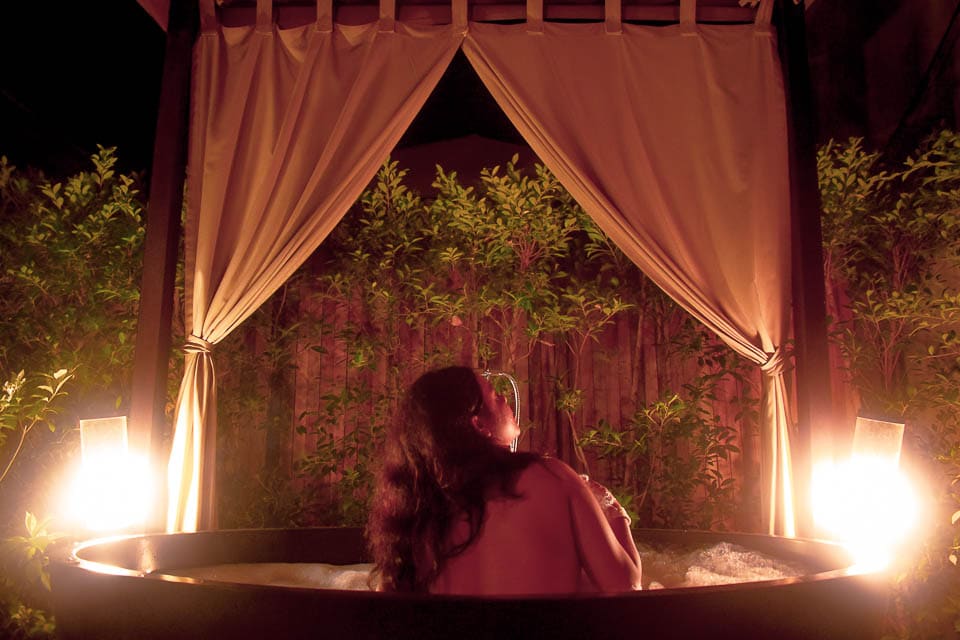
A Cost Breakdown for Traveling in Luang Prabang
Considering you are spending 3 days while traveling in Luang Prabang, here is an account of how much you shall end up spending in your trip to Luang Prabang. After the country reopens, things might have changed a bit.
- Visa fee: USD 40
- Getting around in Luang Prabang by Tuktuk: USD 5
- Renting a scooty: USD 15 to 20 a day
- Entry fee at various monuments: USD 1 for each at an average.
- Accommodation (mid budget guest house): USD 25
- Food (street food): USD 5
- Meals at Cafe: USD 10
- Shopping and miscellaneous: USD 20
- Day trips from Luang Prabang on a Guided tour (with a few more pit stops at caves and villages): USD 100
Please note this is a rough estimate for expenses that you may incur while traveling in Luang Prabang. Of course considering you are on a mid-budget trip and comfortable spending money for a few experiences. If you are on a guided tour, or taking up day trips, cost will increase significantly. Cost is also dependent on international fuel price and inflation, which is very high at the moment.
Money saving tips for the pro-backpacker in Luang Prabang!
If you are planning to travel Luang Prabang on a show string budget, you can rent a bike and stay in a backpacker’s hostel. Instead of visiting every temple (which has an entry fee), choose your places of interest carefully.
- Rent a bike in Luang Prabang to travel at ease. They are cheaper than Tuktuk. Renting a scooty here comes as cheap as USD 15/20 for a day. You have to pay for the petrol for the day. her are a handful of gas stations. Fuel is imported from Thailand. Ongoing rate for petrol in Luang Prabang is close to 1 USD. For electric vehicle or more green using, please use the tuktuks for covering short distances. Your home country licence usually works. They drive on the right side (French influence on Laos) in Luang Prabang.
- Get money exchanged at airport. The Night market had steeper exchange rate when I visited.
- Gorge on great Laos food from the buffet at the night market of Luang Prabang. starting price 15,000 Kip only.
- People watch by the riverbank and ditch other touristy activities. You will be rewarded with incredible vintage shots of a life bygone!
The Exotic Lao Food that I tried at Luang Prabang
Because the French stayed in Luang Prabang for a substantial part of history, much has been said about the French food and its reflected influence on traditional Laos cuisine. The croquette . The baguette. The macaroons. A lot like our Cabin restaurants of Kolkata ! However, truth be told, Laos meals are full of robust flavors earned straight from raw nature, often reminding you of a rustic dining experience.
There has been a sustained endeavour to bring out the best of traditional Laos cuisine, rich with a medley of ginger, garlic, lemon grass (and hence very appetising for my indian taste buds).
We went out with a food walk with the backstreet academy in Luang Prabang and tried and tasted almost all sorts of local food in Laos. The chili wood that doubles as a spice quotient generator in lieu of fiery chilies, grilled carp fish, Laotian Khao Soi with handmade noodles. Delight is when you get to taste local cuisine with a local foodie, which is exactly the case with backstreet Academy!
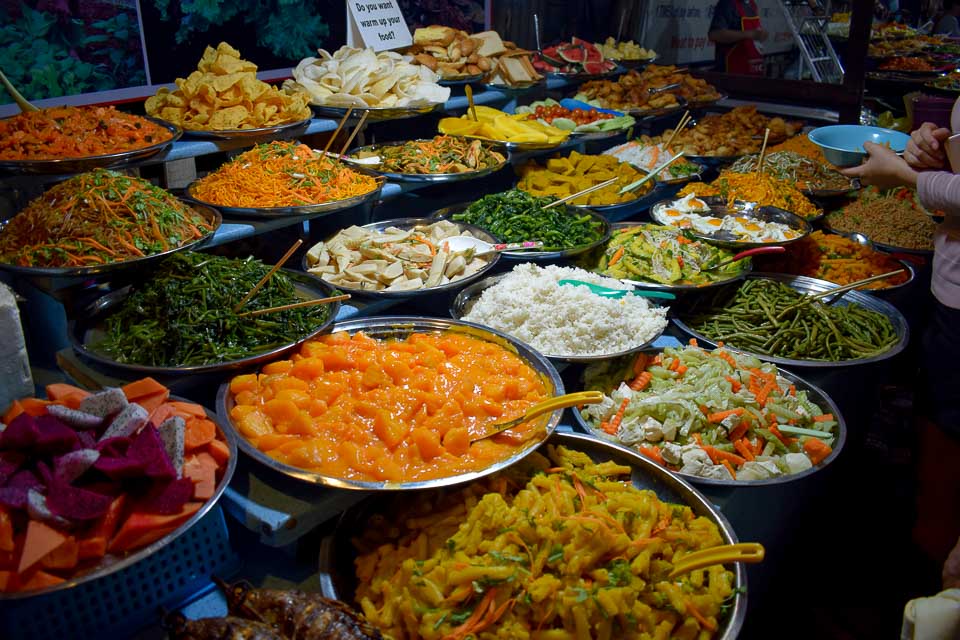
At night, visit the famous night market of Luang Prabang and indulge in a buffet. They are very affordable. From 15 to 20 thousand kip, you are allowed to fill up your bowl with as much food as you can, though only once! The local Laos food buffet is usually huge and consists of a great spread of vegetables, meat, fruit, eggs and noodles.
For a fine experience, save a dinner at the restaurant called Blue Lagoon . I absolutely loved their Laos cuisine which had plenty of fish dishes, cooked with vegetables, steamed or braised.
Following is a list of cute cafe and restaurants in Luang Prabang that serve great local food:
- Manda de Laos Restaurant
- Bamboo Garden (Rated best place to eat in Luang Prabang in most of the portals)
- Two little birds cafe
- L’elephant Restaurant (One of the oldest places to eat in Luang Prabang)
- Popolo Cafe
- Governor’s Grill at Sofitel (Loved the dinner buffet here)
- Dyen Sabai Restauant
These places are all beautifully set up and befitting for a romantic dinner date while traveling in Luang Prabang.
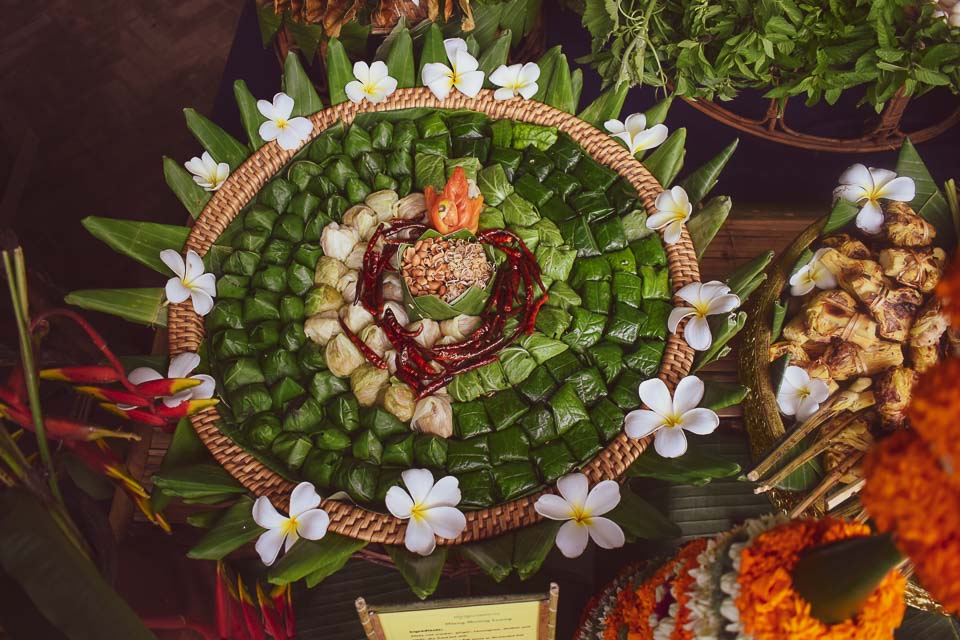
A Responsible Traveler’s Guide to Luang Prabang
No travel guide to Luang Prabang will be complete without stressing on the point of giving back to the kind and generous community of Luang Prabang. Giving back means you be mindful of the way you travel, your footprint and the impact you leave behind.
Besides, Laos being one of the poorest countries in the world, it does a great deal for the locals for each travel dollar this country earns.
- Participate in the massive endeavour for waste management in Luang Prabang
Luang Prabang is a landlocked country. Ever wondered where does the waste go? Certainly not in the river bed.
You will leave Luang Prabang but the plastic waste you have left behind will stay back for the next 450 years. Think about the ecological impact it will leave for a landlocked country like Laos! Clean up and leave no trash (specifically single waste plastic) behind in Luang Prabang.
Traditionally residents in Luang Prabang use banana leaf to pack daily errands. Try them. They are green and effective.
If you do not do this, the trash you generate will add up to the handful of landfills that Laos has in larger cities. That is a nuisance.
It is estimated that 100 million plastic water bottles are consumed in Laos every year. You can reuse one and that will make a huge impact and support the Refill Not Landfill initiative taken up by the local businesses of Luang Prabang.
2. Support local artisans of Luang Prabang
Look around. See a painter? Support by buying a small souvenir, say a bookmark. If you have the space for it, invest in a wall painting. I have seen many small sellers creating ornaments or souvenirs from the scraps of the fighter jets left behind from the war. They are usually sold at the famous night market of Luang Prabang. Buy some of these.
3. Buy beautiful fabric and textile products handwoven by the Traditional Arts and Ethnology Centre ( TAEC ). They have fascinating display of ethnic art and craft of Laos tribes.
4. Learn about the devastating and long standing history of Indochina war at UXO Laos Information Centre .
5. Visit the Luang Prabang public library and support the initiative of a book boat that takes book for children to the remote villages by the banks of Mekong river. You can buy a map or a book or simply donate as you please.
6. Support family run local business, like Bamboo Laos (Connect with them on Facebook here ) and spend a day exploring the local culture of Laos in the bamboo orchard. Eat like an elephant is one such business as well.
7. Take informed decisions: What is an ethical experience in Luang Prabang? Take for example the act of bathing an elephant.
Luang Prabang was known as the land of million elephant.
Today, not only those elephants stand threatened for their existence but also have been mal-handles at the logging business for decades. Many a sanctuary keeps them chained. In the name of compassion, elephant washing is often the front face of a money making deal.
Do your research well before you visit such elephant sanctuaries. Green Jungle Park is one such place where retired logging elephants are housed and rehabilitated. The park is located at an hour’s distance from Luang Prabang, Laos.
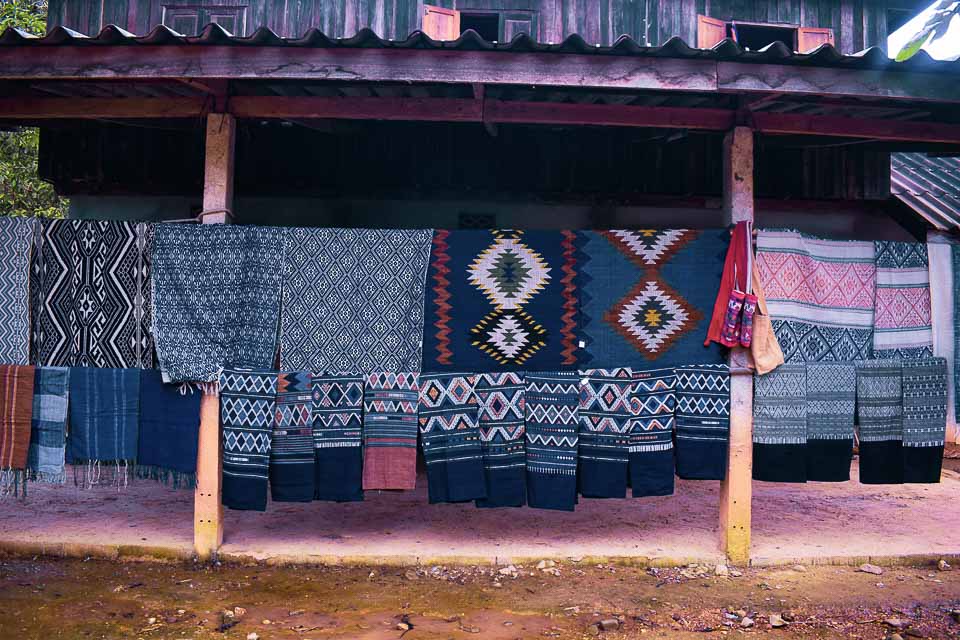
Also read: Flying Premium Economy on Qatar from Kolkata to JFK
What to pack for traveling in Luang Prabang?
Traveling to Luang Prabang is a lot like traveling to any other tropical destination. It is usually warm and humid all day long. During the drier months, humidity goes down. At night, the temperature goes down. When it rains, Luang Prabang is beautiful but traveling beyond Luang Prabang, to other destinations of Laos, especially the remote destinations of northern mountains.
- Carry enough airy cotton fabrics to wear in Luang Prabang. A baggy jeans, a tee and a scarf are all you need to explore Luang Prabang at ease.
- You must be mindful to cover yourself up while visiting the temples of Luang Prabang. Cover your shoulders and wear a skirt that goes beyond your knee. This is applicable for both men and women.
- Do pack a swimwear since you can not keep away from stepping your feet in the Kuang Si waterfall.
- Luang Prabang does not have a convenient stone chain like 7/11 yet but they have plenty of small stores. A shop named M Point was close equivalent in the city. Cash is acceptable. This is where you get to buy your everyday use, like toothpaste, shampoo, razor, deodorants etc.
- Please carry mosquito repellant spray.
A reading list on Luang Prabang, Laos!
There are a handful books written in English that will prepare you to visit Luang Prabang. For the history lover, pick up the following books A Short History of Laos, the Land in between.
If you want to read more on the secret war of America on Laos, read these: Shooting at the Moon, Ravens, A Great Place To Have A War.
For fictions and personal accounts, books written on Luang Prabang are Another Quiet American, One Foot in Laos, Ant Egg Soup, Crescent Moon on Laos.
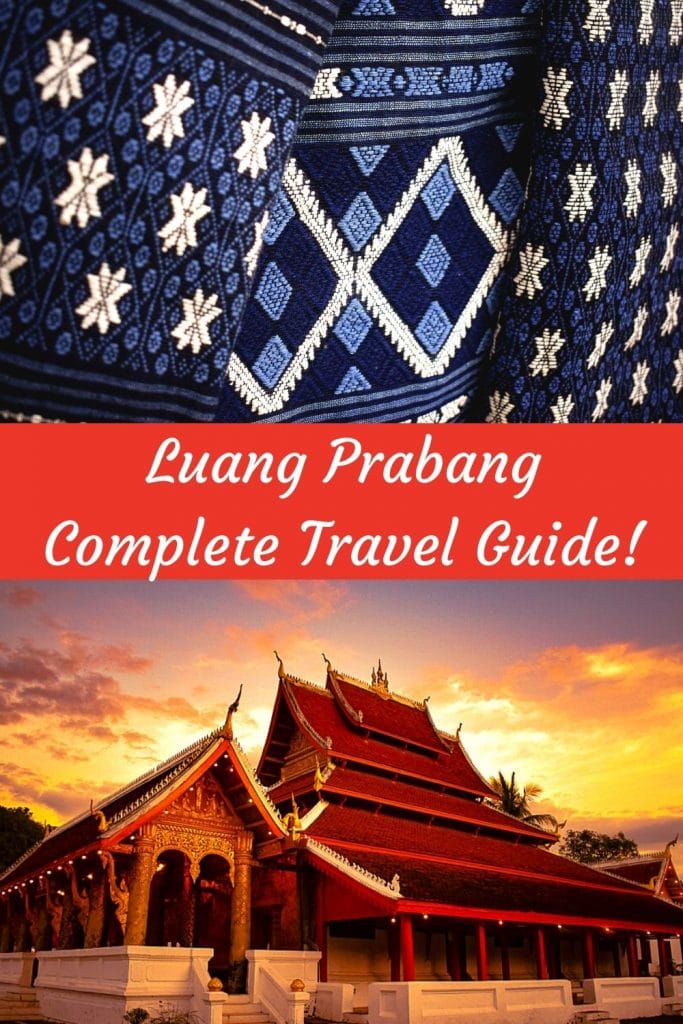
FAQs about Luang Prabang
Traveling to Luang Prabang: is it worth a visit?
Even though Luang Prabang has increasingly been known to greater number of tourists, it has somehow escaped the wrath of tourist buses and know it all loud travelers. Luang Prabang retains its idyllic charm and old town vibes to a great extent, partly because strict UNESCO rules enforced around the town.
Despite traveling extensively across Southeast Asia, I loved my time in Luang Prabang. There were little distinct notions that made Luang Prabang stand out from the neighboring big names in tourist trails. A major reason why I would go back to Kuang Prabang was its people. Despite being cash poor, the people of Luang Prabang were some of the kindest and most hospitable people I have met on the road. It was absolutely safe to explore the town.
Is Luang Prabang a great destination for backpackers and cultural travelers?
Luang Prabang is a paradise for backpacking. You are in for a treat if you are a flash-packer. Since Luang Prabang has a number of handpicked fine luxury establishments, you can also splurge on this holiday. A number of action packed activities will keep you busy in Luang Prabang. Post lockdown, this has become even easier.
How many days are enough to travel in Luang Prabang?
In Luang Prabang, I suggest you spend at least 3 days. If you can, 5 days will be a perfect plan for Luang Prabang with a room for a couple of day tours.
You can of course choose to slow down in Luang Prabang, take the slow boat, sail on the river and explore surrounding areas at peace. That is a different feeling altogether.
How to reach Luang Prabang city from airport: travel essential ?
From airport, rent a taxi and reach Luang Prabang. If you walk out of the front gate, you will be seeing a lot of tuktuks as well. Tuktuks are cheaper than taxi-ride.
The Luang Prabang International airport is located 4 km away from the city center.
Taxis should charge you 6 to 10 USD depending on the time of the day and arrival rush. Prices might change depending of fuel price and political scenario but they wont rip you off ideally.
How to stay safe from usual travel scams of Luang Prabang ?
Luang Prabang is a safe destination for tarvelers to a large extent.
However steep poverty have forced people to pursue a few mal-practices.
Be informed, if a child is pressing you for buying something or money, there is likely to be a racket operating him on the field. Taxi drivers must agree to a price before you get into the car.
You need to be mindful about the changes you receive while exchanging USD or Euro notes in Luang Prabang. A dollar is 9000 KIP (or somewhere close). You need to count before you leave the counter and dispute should a case of discrepancy rises.
Where can you fly from Luang Prabang?
From Luang Prabang, you may travel to Chiang Mai in Thailand, Hanoi in Vietnam, Siem Reap in Cambodia etc. The Airport is very well connected with almost all the prominent airports of the Southeast Asia as a region.
What is the best time of the year to visit Luang Prabang?
The dry months of October to February are the best time to visit Luang Prabang! I visited in July. Tain was about to start. Rainy season in Laos has increased risk of flood.
Is Luang Prabang a good destination for digital nomads?
With kind and warm local people around and a decently well connected airport with the rest of the region, Luang Prabang is a good place to choose to be a digital nomad for a while. Abundant nature and dense forest lies at arm’s reach. You can end every day with a visit to the beautiful river Mekong (no word is enough to describe her profound calming impact). A lot of cafes are coming up in Luang Prabang for co working space. Wi-Fi and telecom network is widespread. While Luang Prabang is not a Phuket or a Hanoi (yet), you do have access to many shop-houses around. For long term slow travel, Luang Prabang is an ideal choice.
How is Luang Prabang after Lockdown: Changes in Tourism Sector
Like the rest of the world, Luang Prabang too had undergone drastic stringent lockdown measures. Government tried to lift the rules. Infections increased. The new set of rules were stricter in nature, segregating zones with color coding, check points, numbers restricted, movements controlled. however from May 2022 rules have been lifted and the city has opened door for international tourists.
The night markets are back. The star hotels are offering amazing deals. Laos China train has started to commute from Vientiane to Luang Prabang, reducing a 10 hour long journey to superfast 2 hours. Tourism has resumed in Laos with great fervor. Slowly the small businesses are tapping back to the tourism market with their massive offering of food and other handmade stuff. Kuang Si fall is open, so is the butterfly park in Luang Prabang! Now is the best time to make that long awaited trip to Luang Prabang.
Also read: Century old Bonedi barir Durgapuja of Kolkata!
Festivals in Luang Prabang
In Luang Prabang, you will find a medley of cultural celebrations that find root steeped deep in Buddhist practices as well as communist ideology. It is intriguing to see how the two of them form an integral part of socio-political culture in Luang Prabang, Laos.
If you are lucky, you shall come across a Baci ceremony. Staying true to the ancient tribal system, Baci ceremony is held to render respect and commitment to new form friendship and born between a guest and the head of a clan. Incense, food and threads are offered at an altar prepared with cane and bamboo. White threads are tied to the wrist of the guest, which is not to be altered with for next one week. I had the pleasure of taking part in one Baci ceremony and will write a separate post on that!
- January/ February: Chinese New Year celebrated in Luang Prabang
- Jan 08: Pathet Lao anniversary, to commemorate the victory of communist movement that emerged out of Laos civil war. History is written by the victors!
- February: Boun Khao Chi (Makhaboussa), Buddhist festival contemporary of Wat Phou Festival in Champasak.
- February: Elephant Festival, 50 elephants walk around the province and rural corners of Luang Prabang
- March 8: International Women’s Day, local women takes a break and indulges in Beerlao
- August/ September: Boat racing in Nam Khan River, during Buddhist Lent. This is also known as Boun Khao Padabdin/Rice and Boat Racing Festival. Wooden boat race takes place on river Mekong as a part of paying homage to water deities and the Nagas. Locals also offer food morsels for the monks and the deceased.
- December 02: Laos National Day
- December: Khmu New Year
- December: Full moon day, a day off for the artisans of Luang Prabang
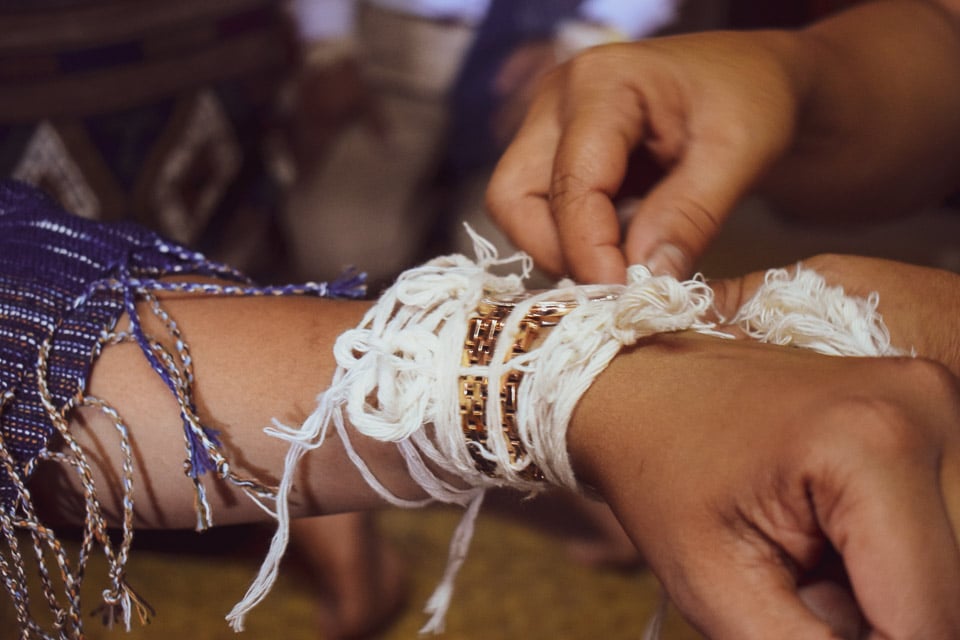
This post may contain affiliate links. Please read the disclosure post. If you have liked the article, you may support it by buying using these links without any extra cost to you.
Let’s stay connected on Facebook , Instagram , Twitter ! You may also consider joining my mailing list. I send travel and photography related emails only once a month!
9 Responses
This is such an incredible guide! I really appreciate the history section, too! Saving this for when we visit!!
I have never been to Laos, maybe little bit just stepped on the land as part of Golden Triangle tour. This site looks so beautiful and I will add this to my list of places to visit in Laos. I wanted to backpack this year which unfortunately is not happening.
Thank you for sharing such a comprehensive guide, so helpful! Would love to visit one day 🙂
I had wanted to get to Laos when i was in Southeast Asia. I got just over the border to a market and want to see more of it! Great information thank you so much for sharing. Beautiful photos too.
This is such a thorough guide of this part of Laos. I loved the story of the fisherman fishing for his cats.
I thoroughly enjoyed this comprehensive guide to Luang Prabang. You provide so much in depth information and interesting facts (I know now to never touch a monk!), beautifully illustrated by photographs that one can’t help but wish to take this trip, too. One day, I hope to see these things in Loas for myself. Until then, I will live vicariously through your posts!
Thanks for such a comprehensive guide. I feel like I could go to Laos now and be prepared!
- Pingback: The Best Street Food in Southeast Asia | Local Dishes Recommended by Bloggers!
Wow that place looks absolutely beautiful! Would love to visit it and see their traditions!
Leave a Reply Cancel reply
Your email address will not be published. Required fields are marked *

15 AWESOME Things to Do in Luang Prabang, Laos (2024)
- Last Updated: December 19, 2023
The ultimate guide on the absolute best things to do in Luang Prabang, Laos for every kind of traveller!
The city of Luang Prabang in Laos is a destination no visitor should ever want to skip.
It’s a mesmerising city filled with over 33 temples, vibrant nightlife, stunning nature, and so much more, which is why it’s the country’s first UNESCO World Heritage Site.
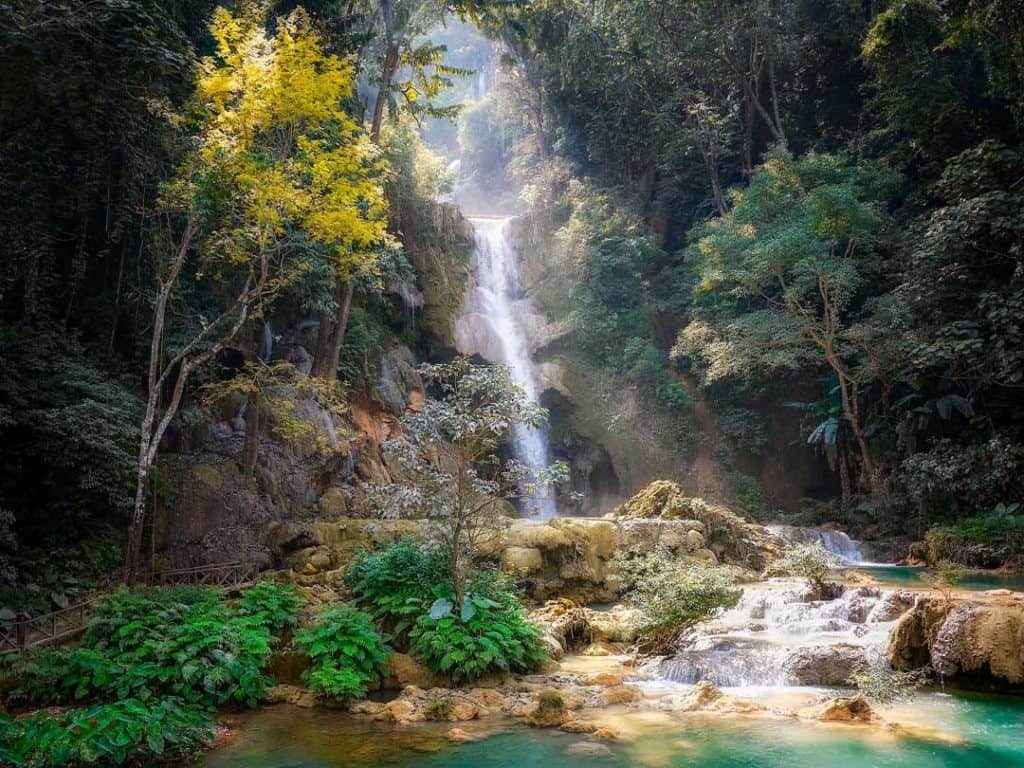
Table of Contents
Relax at Kuang Si Waterfall
Experience the majestic temples, enjoy the famous night markets, watch the alms giving ceremony, hike up to mount phou si, explore the city and its spirituality, learn history at the royal palace museum, learn how to cultivate rice, cruise along the mekong, see the buddha statues over at pak ou caves, sample traditional whiskey at the whiskey village, take cooking classes, opt for an authentic lao massage, learn about laos’ devastating past at uxo luang prabang center, go on an adventure in green jungle park, don’t miss the top things to do in luang prabang.
There are a lot of top things to do in Luang Prabang, and each one is more memorable than the last.
Luang Prabang is also the ancient royal capital of Laos, so there is a lot of history in this region too.
It’s nestled between two of the largest rivers in the region, the Mekong and Nam Khan, and it’s definitely one of the best places to visit in Laos.
Laos may be a landlocked country, but it sure has some of the finest waterfalls in the region.
Although the waterfalls themselves aren’t in the city, they’re definitely worth the trip to get there.
It’s not easy to describe how falls look like, because they’re a gorgeous mix of azure and turquoise, and they cascade in an entirely beautiful way.
At times, they feel as if they’re the sky in liquid form, especially when they’re crashing down on the rocks.
You can also hike to the top of the waterfalls, and even stand inside the waterfall itself.
Proper footwear is absolutely required if you plan on making any excursions to the top, but there is nothing to worry about because there’s a fence about a meter away from the lip of the falls.
- Location: 23 km from Luang Prabang
- Opening hours: every day from 8 AM – 5:30 PM
- Price: 20,000 kip
READ MORE: Check out our full detailed guide on everything you need to know about visiting Kuang Si Falls .
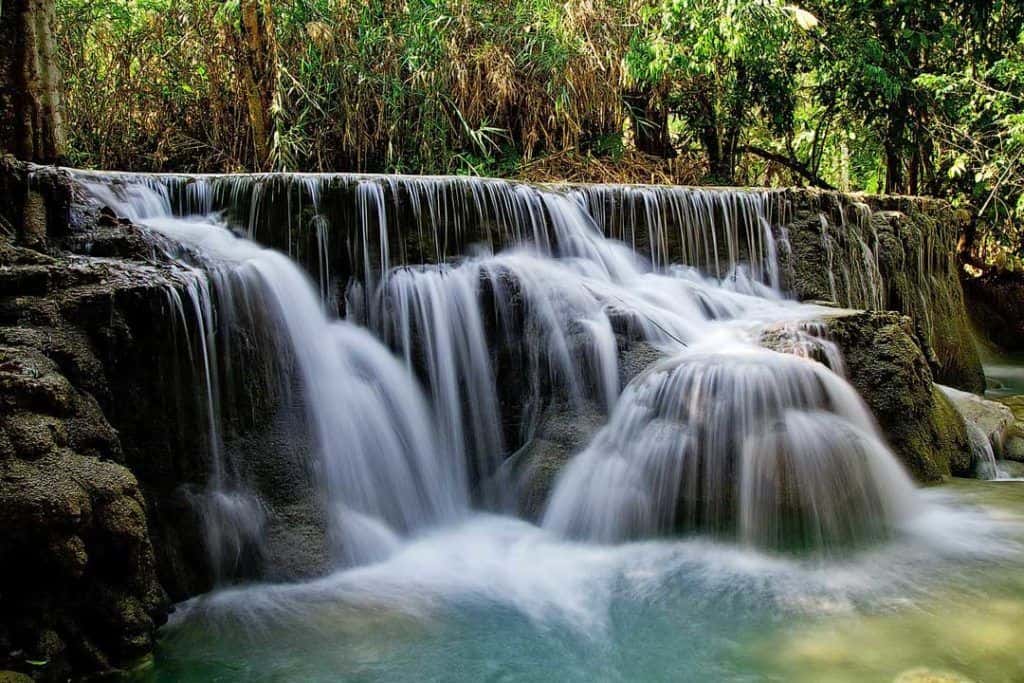
There are plenty of attractions in Luang Prabang but most of them pale in comparison to the stunning golden temples.
There are 34 active temples in the city, and all of them are beautifully gilded which gives Luang Prabang a deep spiritual feel.
They’re known as Wats, and they’re known to have a very relaxing and soothing atmosphere, especially when you’re walking through its gold and burgundy grounds.
The most famous temple is called Wat Xieng Thong , which was built in the 1500s, and it’s one of the finest places to visit in Luang Prabang.
Wat Xieng Thong is a well-known spot where you can rest and meditate, and search for Nirvana, but even if you’re just visiting you won’t regret seeing its beauty in person.
However, if you’re intent on visiting the temples, make sure to know the customs and proper etiquette.
They’re still active institutions, and sometimes it’s possible for locals and monks to be offended if you’re not following some guidelines.
Dressing properly is one of the most important guidelines for the temples, which generally means to have arms and legs covered.
Some temples might have a couple of extra rules, so be sure to ask before visiting.
Book yourself a guided tour to make the most of all the sites.
- Location : Khem Khong
- Opening hours : every day from 8 AM – 5 PM
- Price : 20,000 kip
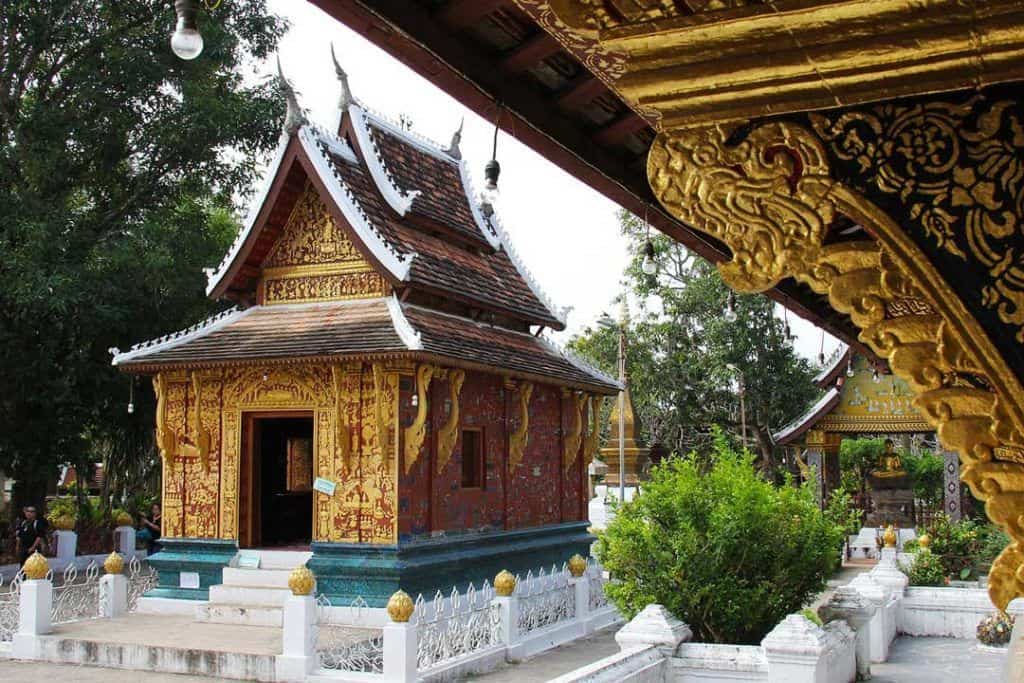
One of the things that South East Asia is most known for is its markets, and Luang Prabang has one of the best in the entire region.
They’re located in the centre of the town, and they’re very vibrant, colourful, and lovely.
Here is where you’ll easily find the spirit of Laos concentrated in one spot because it’s filled with people from several different regions around Luang Prabang.
Many of the goods that are for sale on the stalls are handcrafted.
There are plenty of different items on sale depending on the season, ranging from simple wood carvings to ornate jewellery and trinkets.
This spot tends to be quite crowded, and even though Luang Prabang already feels lively, the crowds give the city an extra sense of life.
Even if you don’t have any intentions of shopping, simply taking photographs of the place can feel amazing.
Another thing that no traveller should skip out on is grabbing a bite to eat.
Just off the main road of the market you can find the buffet street, which is a laneway filled with really good authentic food.
The buffet street even has communal seating, so it’s very easy to meet another like-minded traveller, and to make new friends.
If you love your food, check out this night foodie tour by scooter .
- Location: Sisavangvong Road
- Opening hours : 5 PM – 11 PM every night
- Price : Free
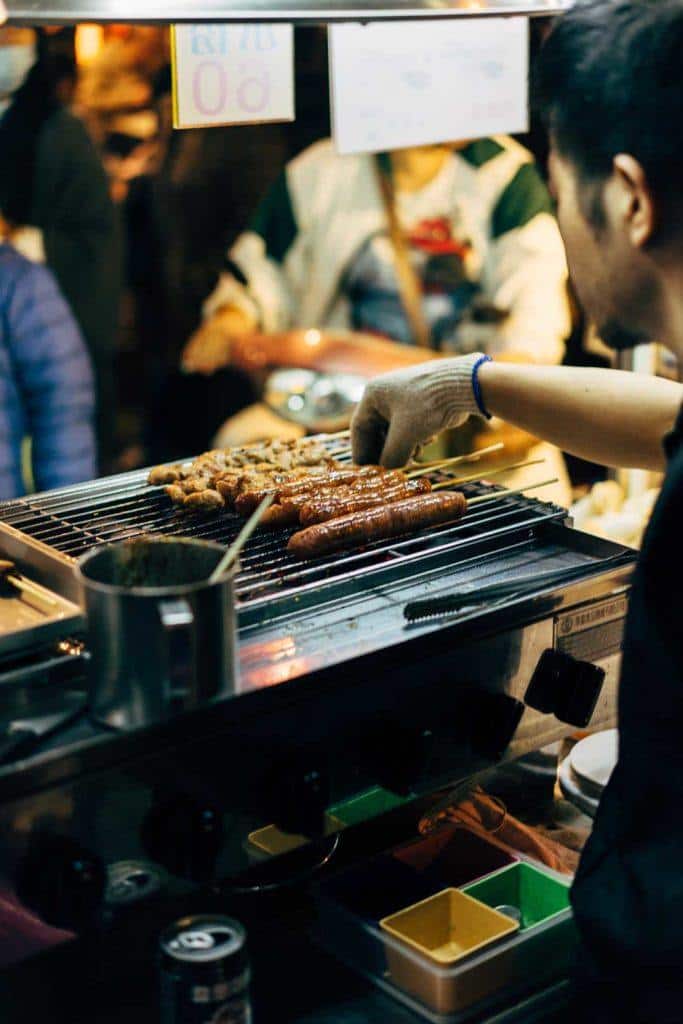
Spirituality and religion play a deep role in the country of Laos, and there are plenty of old traditions that are still being practised to this very day.
Starting from the 14 th century, local monks leave their respective temples at sunrise in order to collect alms for them to be able to help feed the poor.
This is a ceremony that actively encourages visitors to participate, which is why it’s one of the best things to do in Luang Prabang.
The ceremony itself starts from the main street of the city, then it moves on to many of the side streets of Luang Prabang.
Since the ceremony starts at sunrise, it’s best to be there before the monks arrive because it’s considered rude and disrespectful to take part in the tradition after it has begun.
Clothing and general appearance are also important – having your chest, legs, and shoulders covered is a sign of respect.
Offerings generally include food, such as rice, fresh fruit, or traditional sweets, and they are to be presented respectfully with a bow.
It’s a lovely tradition, one that perfectly showcases just what Lao culture is all about, and it has an unforgettable serene atmosphere about it.
- Location: Main Street
- Opening hours: Sunrise until early morning
- Price: Free
There are but a few things that can compare to the beautiful views from the top of Mount Phou Si.
Phou Si itself means sacred hill, as this is not an actual mountain but rather a hill that’s tall – about 100 meters.
Luang Prabang has a gorgeous skyline, and Mount Phou Si is definitely the best place to experience it.
It’s located in the centre of the old town, which makes it very easily accessible, but it does take a bit of a hike to get to the top.
There are over 300 stairs to reach to the top, but once you’re there, you’ll be glad you’ve put in the effort.
While the views are consistently amazing throughout the entire day, sunset is when the hill truly feels a magical spot.
You’ll be surrounded by golden pagodas, and just as the sun starts to set and the lights of the city flicker to life, you’ll get to experience something truly unforgettable.
Make sure to get to the top before the sun is about to set because the spot is very popular and there will definitely be crowds around.
If you want to explore the mountain on a guided tour, this one is the best on the market .
- Location: Center of the old town
- Open hours: 5:30 AM – 6 PM
Wandering through old, historic neighbourhoods in the city is one of the best things to do in Luang Prabang.
When you’re stuck on what to see in Luang Prabang you can always set out to explore the pleasant French-laneways.
France had a significant presence in the past, which is why a lot of the architecture and general aesthetics have such a strong French undertone.
If walking for hours on end isn’t something you prefer, you can always rent a bike and just explore the place with it.
There’s plenty to see in the city, so you might want to spend a lot of time throughout the day doing nothing but sightseeing.
There are a few hills right on the outskirts of the town that are amazing to visit, especially on a bike, and they’re pretty easy to reach.
Although it’s generally considered safe to bike everywhere in Luang Prabang, make sure to wear your helmet and definitely get travel insurance .
If you feel you’re done with wandering and exploring, you can always sit down for a nice and relaxing spot of yoga.
Yoga is one of the best things to do in Luang Prabang as there is a cooperative of many independent yoga teachers with whom you can practice in the city’s most beautiful spots.
- Price: 15,000 – 40,000 kip for bikes, 40,000 kip for yoga
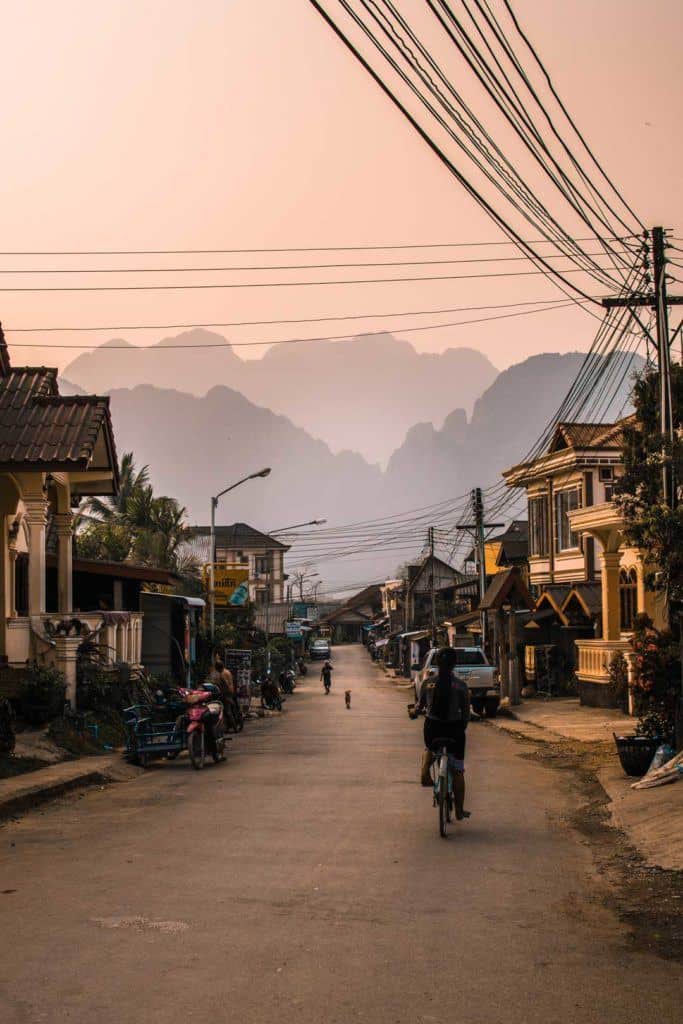
This museum was originally constructed as a residential palace for King Sisavang Vong in 1904.
It’s constructed with a blend of traditional Lao and French architecture, which is why it has such a unique aesthetic.
After the king’s death, the crown prince, Savang Vatthana, and his family occupied the palace.
They were the last to hold residence until the revolution of 1975.
When Laos no longer had a royal dynasty to rule the country, the government occupied the palace complex.
It was then reopened to the public in 1995 as a museum.
Since 1995, the Royal Palace Museum holds a significant number of artefacts and items from the past that each tell their own stories, which are part of the larger story of the country of Laos.
The complex is divided into three parts – the main palace and a few other buildings.
One of the other buildings in the complex is an ornate pavilion, which is known for housing a standing Buddha statue called Prabang, which the city is named after.
There is even a car collection in the compound, though it’s modest in size and it includes American cars from the 1950s to 1970s.
- Location : Across Mount Phou Si
- Opening hours: 8 AM – 11:30 AM, 1:30 PM – 4 PM
- Price: 30,000 kip
One of the things that Laos is known for, in general, is their rice and the sprawling rice fields it comes from.
It’s possible to become a rice farmer for one day over at the Living Land Organic Farm , where you’ll be able to try your hand at every single step of making rice manually.
No modern machinery is used on the farm as everything is done with hard work. You’ll be taught how to cultivate and grow rice the traditional way.
The entire process is far from glamorous, though, as one of the steps requires you to wade through fields of mud.
After you’re done for the day, you’ll come to appreciate just how much effort goes into making rice.
Rice has become a staple of Lao cuisine, and the main type of rice is called sticky rice.
This is just one of several hundred types of rice that grow in the region, and you’ll have an amazing opportunity to learn more about them at the farm.
As it’s such a big part of Laos culture, getting an opportunity to learn more about rice cultivation is perfect to complete your Luang Prabang sightseeing experience.
- Location: 5km outside of the city centre
- Opening hours: No specific hours but starts early in the morning
- Price: 275,000 kip per person
One of the best ways to experience the surroundings of Luang Prabang is to take a river cruise down the stunning Mekong .
It’s one of the best things to do in Luang Prabang, especially considering that you’ll be seeing a lot of the biggest highlights in the region.
What’s great about these tours is that there are plenty of options to choose from – from basic boats all the way to luxury vessels.
Touring the Mekong is best done right before sunset because then you’ll be able to truly enjoy the splendour of the surrounding nature, and you’ll be able to see the locals finishing up their daily routines.
There are three different spots to choose from, and several different companies, each with their own particular flavour.
You can take a short one-hour cruise, or you can even opt for a longer cruise to some of the farther sites like Pak Ou Caves.
- Location: Near the morning market, behind the Royal Palace Museum, near Wat Xieng Thong
- Opening hours: 9 AM – 6 PM
- Price: 100,000 kip and above
If you’re looking for the ultimate travel adventure, check out our guide on taking the slow boat to Laos along the Mekong Delta.
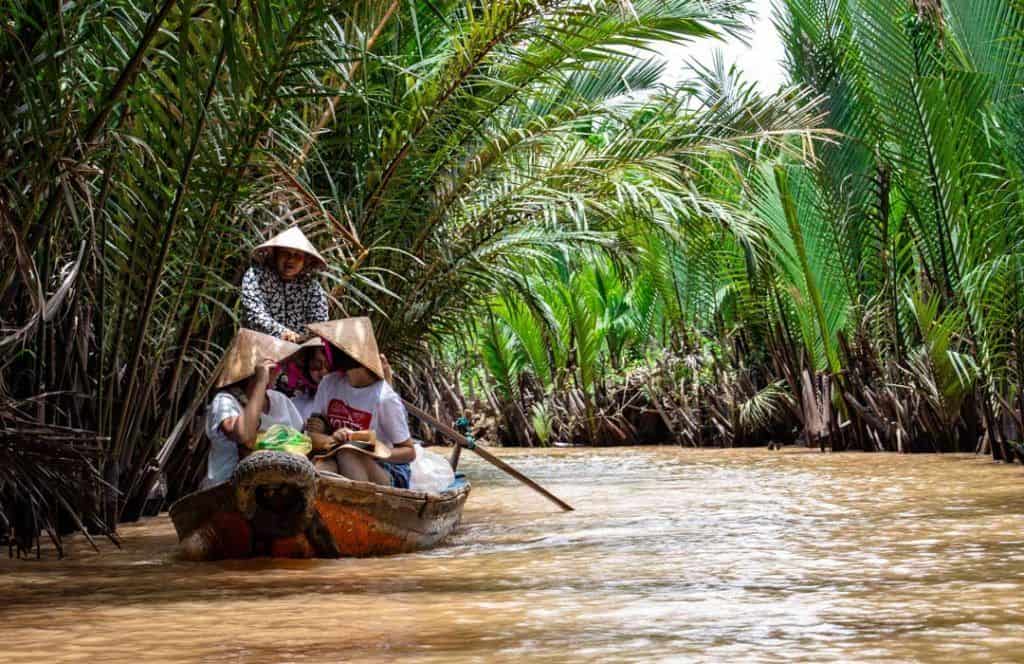
The famous Pak Ou Caves are one of the most important religious spots in the region, and they’re one of the most known prayer sites.
They’re most known for the thousands of different Buddha idols, all in different shapes and sizes, left throughout history by different people.
In the past, when the pilgrims first came and settled in this region, they visited the cave and left a Buddha statue, which prompted other pilgrims to start leaving Buddha idols of their own.
Today, both upper and lower caves are filled with these idols, and even though they appear as souvenirs, they’re actually very important religious idols.
The lower cave is well-lit and everything is clearly marked, so there will be no confusion as to where to go.
The upper cave is the one that’s slightly more difficult to reach, but only because you’ll need a torch to climb the many steep steps.
Once you’re at the top, you’ll get to experience the caves the way they were mean to be experienced, which is without a lot of tourists, and as a place for serenity and relaxation.
They’re quite easy to reach by boat.
- Location: 25 km upriver
- Opening hours: 8 AM – 5 PM
- Price: 20,000 kip per person
The Whiskey Village is one of the most popular Luang Prabang tourist attractions, and it’s often a stop when visiting the Pak Ou Caves by boat.
The whiskey itself is quite different from whiskey in the west, in that it’s made from rice with a very traditional method, but the end result is still a very potent alcoholic beverage.
Whiskey is called Lao-Lao, which is, in fact, two different words – the first means alcohol, and the second is the country.
Lao whiskey is almost entirely incorporated into the culture, as it’s used in a lot of traditions, so expect to be treated with samples generously.
If you do take a liking to the drink, there are bottles of this liquor on sale as well.
You can even observe how to make and prepare the whiskey, although it’s not encouraged to take part of the process and try to make it yourself.
Visiting here will not take a lot of your time, as you’ll most likely be heading to the Pak Ou Caves relatively shortly after arriving.
Sign up for a guided tour here and explore not just the Whiskey Village but also Pak Ou Caves and the Kuang Si Falls.
- Location : 1.5 hours upriver
- Price: There is no entry fee and samples are free
A lot of visitors to this part of Laos are surprised that one of the best things to see in Luang Prabang is actually the inside of a kitchen.
Tamarind’s cooking school is located just outside the city, but you’ll be picked up from the Tamarind restaurant in the city with a tuk-tuk and brought to the school.
Lao cuisine is absolutely exquisite and unique, and one of the first lessons is picking and choosing your ingredients at the market.
The school claims that only by knowing how each ingredient feels like, you’ll know how to properly prepare Lao dishes.
There are only a few other students in any given class, so you’ll receive more than enough attention and guidance on how to cook traditional meals.
It’s a worthwhile experience that will absolutely strengthen your journey in Laos.
- Location: Just outside Luang Prabang
- Opening hours: 9 AM – 3 PM
- Price: 285,000kip
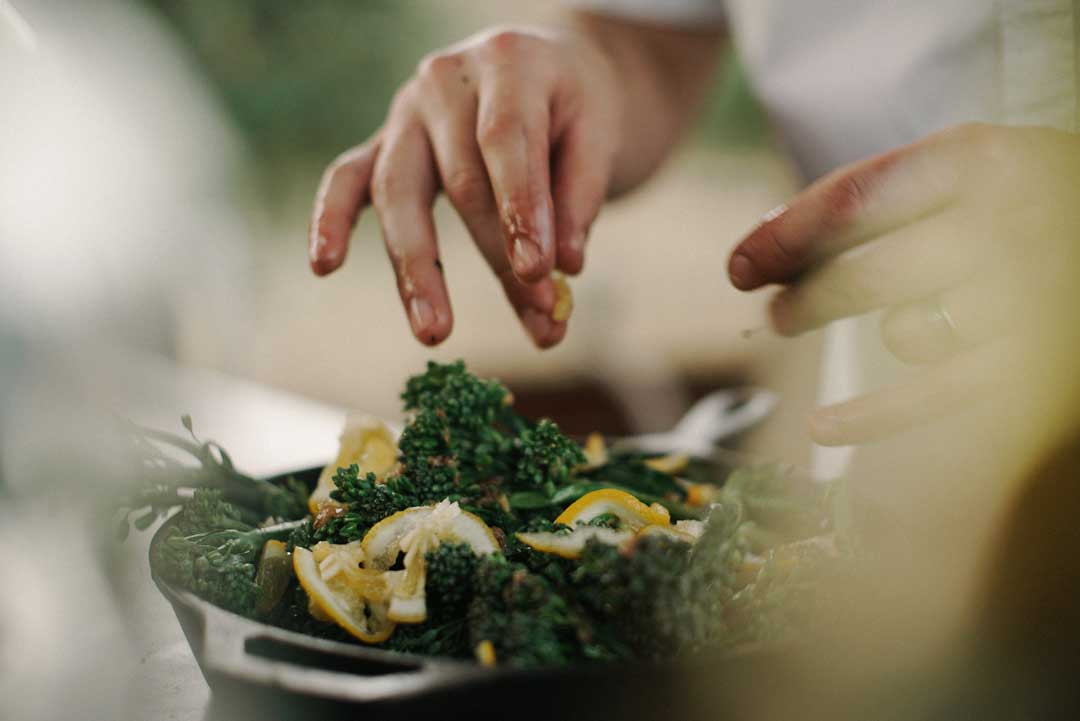
It’s true that Laos’ neighbours are the ones that are much more famous for their massages, but Lao massages are an entirely different experience.
If you’re looking for a typical relaxing massage in Luang Prabang, then don’t look for an authentic Lao massage, but rather ask for an oil massage.
An authentic massage is not as relaxing as other types of massages, but rather it’s meant to be a therapeutic experience that releases tension by focusing on key pressure points.
These massages are done while wearing sarongs or loose clothes.
It is important to note, however, that you might feel pain or discomfort at first.
There are several spas in Luang Prabang, but be wary of some of the cheaper ones, because you usually get what you pay for.
Some locals might not pay as much heed to hygiene as much as they should, so make sure to find a place that appears reputable and clean.
- Location: All around town
- Price: 60,000 kip and above
The history of Laos is not the most peaceful as the country had often been plagued with wars and revolutions.
During the ’60s and ’70s, before the revolution, Laos was continuously bombarded by ordnance and explosives.
Over the course of 9 years, there were more than 270 million bombs dropped on the country’s territory.
Laos is the world’s most bombed country per capita, and unexploded ordnance is still a live threat to this very day in most of the districts in the country.
This museum is dedicated to shedding light and raising awareness of the issue.
Even after extensive relief support, however, the issue still persists.
The museum is a chilling experience and is considered a Luang Prabang must see.
- Location: Behind Chao Anouvong Monument
- Opening Hours: 8 AM – 12 PM, 1 PM – 4 PM
Before Green Jungle Park was formed as a spot for adventures, it used to be a rubbish dump, which has been fully reclaimed today.
The park is surrounded by a forest and a gorgeous cascade, where you’ll find a lot of zip lines, monkey bridges, and even rope courses.
It might not be that near to the city, but you’ll be able to get there by catching a boat from Luang Prabang behind the Royal Palace.
After you disembark from a 30-minute ride, you’ll be taxied for the rest of the way.
This is a great place to go if you’re not sure what to see in Laos as it’s located in one of the region’s lushest areas.
There’s a unique sense of adventure and you’re never that far away from civilisation.
- Location: 32km outside of Luang Prabang
- Opening hours: 7 AM – 6 PM
- Price: 20,000 kip, excluding extra costs for more activities
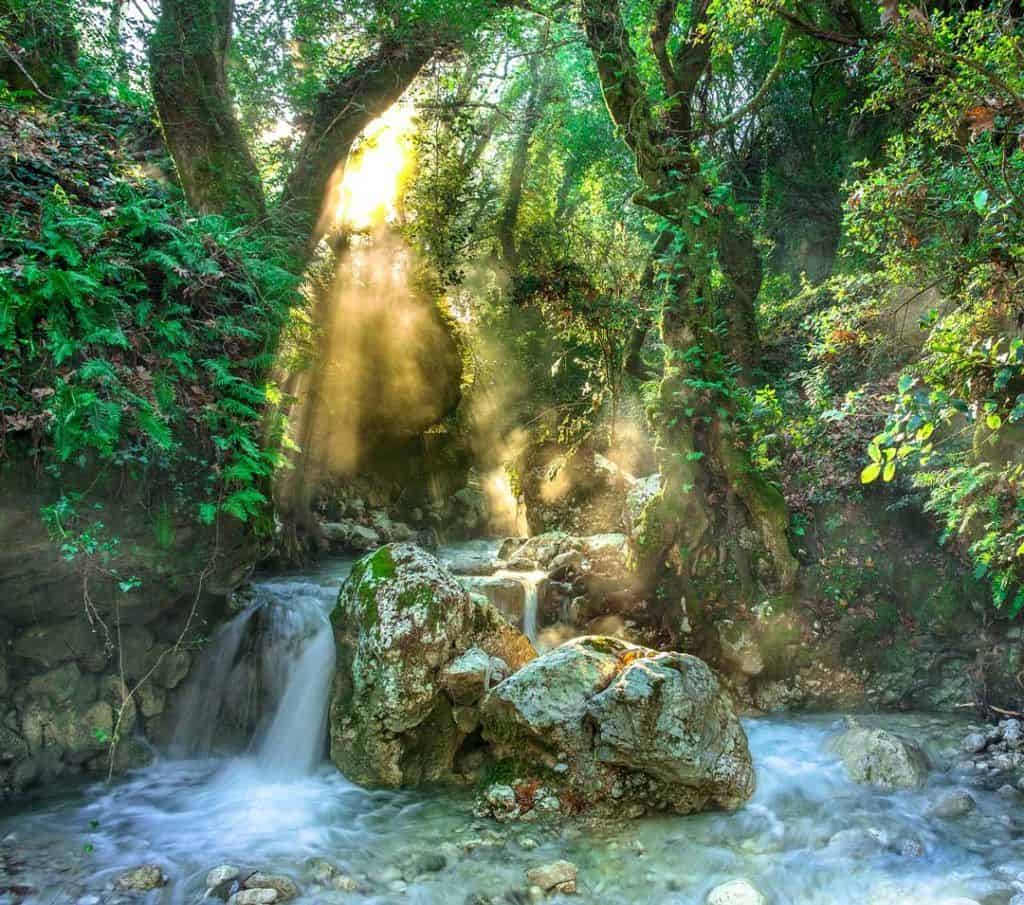
DISCLAIMER: Some of the links in this article are affiliate links, which means if you book accommodation, tours or buy a product, we will receive a small commission at no extra cost to you. These commissions help us keep creating more free travel content to help people plan their holidays and adventures. We only recommend the best accommodations, tours and products that ourselves or our fantastic editorial team have personally experienced, and regularly review these. Thanks for your support, kind friend!
Alesha and Jarryd
Hi, We’re Alesha and Jarryd!
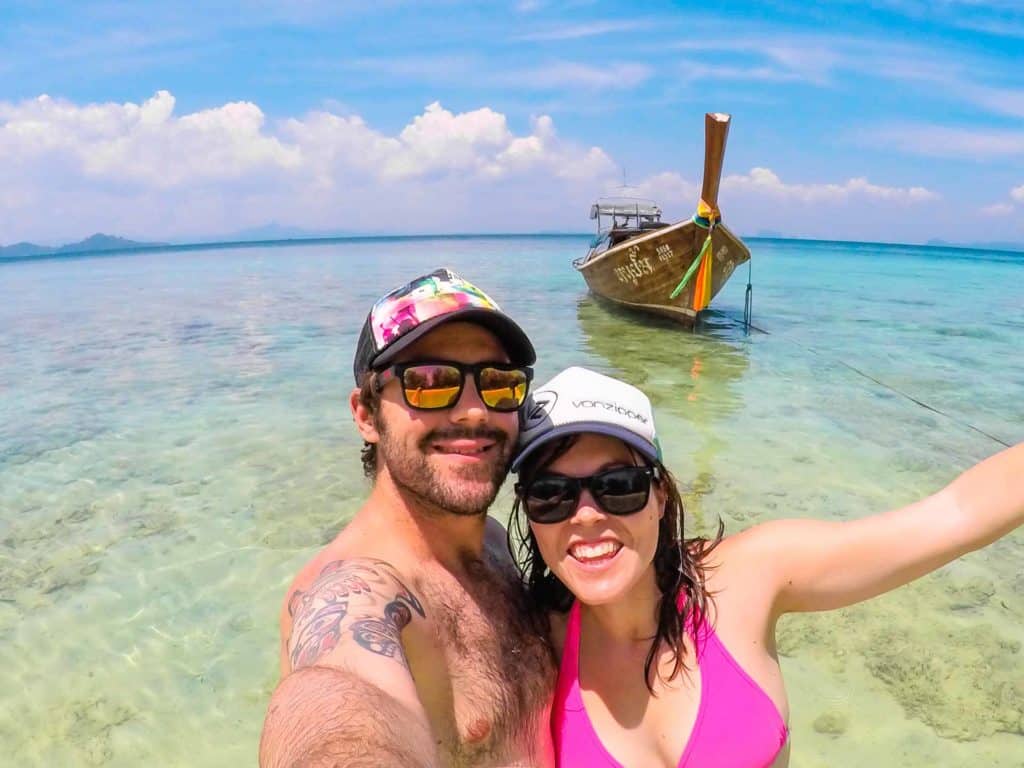
We’ve been traveling the world together since 2008, searching for the planet’s best destinations and adventures.
Love Travel?
Sign up for our free weekly newsletter for the best travel tips, ideas and deals!
We respect your privacy. Unsubscribe at any time.
READ MORE...
How to Visit Kuang Si Falls in Luang Prabang, Laos in 2024
Slow Boat to Laos – The Best Tips and Advice
Thakhek Loop Motorcycle Adventure (A Travel Guide)
Related posts, the slow boat to luang prabang, laos motorcycle adventure – the south, laos motorcycle adventure – the north, 5 thoughts on “15 awesome things to do in luang prabang, laos (2024)”.
thanks for the superb information
Your post is so detailed! I’m going to Luang Prabang soon, so thank you for sharing all this information! 😀
That is amazing. Have a wonderful time. Luang Prabang is a lovely destination. Don’t miss the waterfall and the food street market.:)
I have lived in Luang Prabang for the past 6 years and your advice is spot on. I can add a few more things that will be an adventure as well. Eat at Khaiphan Restaurant and help Friends without borders to teach their staff to be top chefs, waiters and mangers. Most of these kids are street kids who had no future, but now after 4 years of training they are all snapped up by he big hotels in Thailand. Food you will not experience any where in Laos created by a Canadian chef who blends Lao and western food. EXCELENT Big Brother Mouse is a place where tourist can help Lao kids with their English. The kids will love to hear about you and your country. Most schools only have 1 hour of English per week and because this is a tourist town English is a great skill for them to have. Buffalo Dairy on the way to Kuang Si Waterfalls is the only Buffalo dairy in S.E. Asia and you can see many farm animals as well as feed the baby buffalos with their special bottles. The restaurant there serves buffalo products such as cheese cake donuts coffee, all made with buffalo milk. If you plan your trip for the last full moon in October you will see one of the best Lantern parades in the world all hand made by paper and lit with candles and spirit Lamps. I can also recommend Apple Guest House in town to stay very friendly people nothing is too much trouble and they speak good English and it’s a great location.
Thank you so much Robyn for the extra tips. This is so helpful to many. I will put a note in the article. Thanks you again. Take care
Leave a comment Cancel reply
Save my name, email, and website in this browser for the next time I comment.
The Best Luang Prabang Itinerary (1-3 Days)

While strolling through the streets of Luang Prabang, I couldn’t help but break into a smile. This charming city, nestled on a peninsula formed by the merging of the Mekong River and the Nam Khan River, surrounded by the PhouThao and PhouNang mountain ranges, appears to have remained untouched by the hordes of tourists that I’ve seen throughout Southeast Asia. I found myself grinning, sensing that there was something unique about Luang Prabang, setting it apart from any other place I had previously visited. This feeling was so compelling that I ended up extending my stay in this small town to a total of nine days; I just couldn’t bring myself to pack my bags and depart. (This seems to be a recurring theme in Luang Prabang, with backpackers initially planning to stay for a few days but ending up remaining for years). If you’re planning a trip to Laos, you can’t miss the opportunity to explore Luang Prabang for yourself. Here, you’ll find comprehensive information about the city, along with the best Luang Prabang itinerary, whether you have just one day or three.
IF YOU’RE TRAVELING TO LAOS, I HIGHLY RECOMMEND PURCHASING TRAVEL INSURANCE FOR YOUR TRIP!
Are you planning a trip to laos don’t miss…, the best packing list for laos, everything you need to know about traveling to laos.
- The Best 1 Week Laos Itinerary
How to Get to Luang Prabang
Because Laos – and Luang Prabang – is a lesser known destination compared to other countries throughout Southeast Asia, it can be challenging to get to the country especially if you’re traveling to the United States. But don’t let this deter you from visiting! I promise, Luang Prabang is worth the long journey.
Traveling by Airplane/Visa Information
If you’re flying to Luang Prabang, the airport you’ll fly into is the Luang Prabang International Airport. You will need a visa to visit Laos, and you can get an e-visa online or apply for a visa in-person. I got a visa in person and while it wasn’t too bad, I’ve heard many scams happen depending on where you’re getting your visa. The cost for an in-person visa is $40 and you need to have cash with you. You also need to bring your own passport photo and if you don’t, the charge is an extra $5.
To book a flight to Luang Prabang, I suggest using Skyscanner or Expedia to compare flight options and prices.
Once you land in Luang Prabang, the airport is only a 10-minute drive to the town and you can get a taxi at the airport for 100,000 LAK (about $5).
BOOK A FLIGHT TO LUANG PRABANG HERE !
Traveling by bus/visa information.
If you’re coming from somewhere else in Laos or you’re crossing by land border, a bus will be the cheapest option. I prefer to use Bookaway or 12Go to compare options and prices.
If you cross into Laos by land, you will still need to have a visa. Because of the scams that occur at the land-crossing borders, I would recommend getting an e-visa to make life easier. However, depending on where you’re entering from – double check to ensure that the crossing accepts arrival by e-visa. Some land crossings don’t accept e-visa and you might have to bring a visa with you from the embassy.
BOOK A BUS TO LUANG PRABANG HERE !
How to get around luang prabang.
Luang Prabang is a small town and easily walkable. If you aren’t up for walking, consider renting a bike as rentals are available throughout the city and your hotel might offer free bike rentals too. Lastly, if you need a ride somewhere there are a number of taxi’s on the streets you’ll be able to waive down.
If you want to travel around the Luang Prabang province, you can hire a tuk-tuk off the street, or rent a motorbike. Motorbike rentals should be available at any hotel or guesthouse you stay at, or you can book a motorbike from Anousay Motorbike Rental. The good thing about renting from Anousay is that they offer a variety of prices based on how old the motorbike is, plus you’re not required to fill up the motorbike with gas before returning it; but in my experience, the rental was more expensive than just renting from my hotel. No matter where you rent from, ensure that the bike will come with a lock. Motorbike theft in Laos is an issue.
Where to Stay in Luang Prabang
There are tons of places to stay in Luang Prabang from hostels to luxury hotels. Below you’ll find my favorite options across a variety of budgets!
- Avani+ – A luxurious five-star hotel with an incredible pool for those hot Laos days
- Maison Vongprachan Hotel – Perfect option if you’re looking for a quiet stay, more off the beaten path
- The Belle Rive Boutique Hotel – A boutique hotel in the historic downtown area
- 3 Nagas Luang Prabang – A luxury, four-star hotel in the historic downtown area
If none of these hotels suite you, I recommend using Booking.com to search for options. I recommend staying as near to the historic old town as you can!
BOOK YOUR STAY IN LUANG PRABANG HERE !
The best time to visit luang prabang.
The best time to visit Luang Prabang is during dry season from November-April. Monsoon season comes to Laos from May-October so it’s best to avoid traveling the country at this time. January is a busy season, especially for Luang Prabang, because of the many festivals that take place in January.
The coldest months in Laos are December and January with temperatures around 60+ F (depending where you are in the country). The hottest months in Laos are March-June when temperatures hover around 90+ F. Because Laos is a “long” country (from north to south) temperatures can vary between the north and the south. Take this into account when planning your travels.
I visited Luang Prabang in October and while I experienced scattered rain showers, it was nothing that deterred my travel plans.
The Best Bars & Restaurants in Luang Prabang
Yuni Yupoun
When I visited Luang Prabang it was my first time in Laos and not only was I thoroughly impressed with all of the international food options, I was even more impressed with Laotian food! Laotian food is commonly made up of eggplant, meat, seaweed, bamboo, pumpkin, and sticky rice (this is not an exhaustive list); and I was delighted when I visited my first Laotian restaurant and loved the food! Food is such a big part of travel to me that when I don’t like a specific cuisine, it seems to affect the way I view a country or destination.
Below you’ll find my favorite bars and restaurants in Luang Prabang.
BAMBOO GARDEN RESTAURANT
Bamboo Garden Restaurant was one of the best (and cheapest) restaurants that I ate at in Luang Prabang. I loved it so much that I returned three times! The restaurant is family owned and all of the dishes are Laotian or Asian. All seating is on a small patio outside so at times there may be a wait, but I promise, it’s worth it!
COFFEE EXPRESS
I accidentally stumbled upon Coffee Express (when I was lost), and it was such an amazing find! This coffee shop is so quaint and has a beautiful outdoor seating area overlooking a lily pond. Plus, the pastries and desserts were some of the best I had in Luang Prabang!
DYEN SABAI RESTAURANT
Dyen Sabai is such a cozy, Laotian restaurant. With beautiful decor and seating that overlooks the river it’s the perfect spot for a cozy (and romantic) dinner. Because the restaurant is located across the river you’ll need to cross the bamboo bridge (during dry season) or take the free boat (during rainy season when the bamboo bridge is covered) to and from the restaurant.
LA BANNETON CAFE
If you’re craving a French pastry, look no further than La Banneton Cafe. La Banneton is the perfect spot for a morning coffee or afternoon glass of wine. Plus their pastries and viennoiseries are out of this world delicious.
MANDA DE LAOS
If you’re looking for an upscale restaurant to try Laotian food, Manda de Laos is it. Not only is this restaurant incredibly beautiful, overlooking an UNESCO classified lily pond with a tropical ambiance; but it also features typical Laos dishes from all over the country.
When I visited I tried the tasting menu and it was incredible. Plus it was a great way to taste many different types of Laotian food!
If you plan to visit, I highly recommend making a reservation ahead of time.
TANGOR RESTAURANT BAR & LOUNGE
If you’re craving western food, Tangor is where to go. Owned by a French guy who moved to Laos 15 years ago, Tangor blends your typical western food with a French twist. Plus its great location is the perfect spot for a night out or if you want to sit outside and people watch.
TASTE OF CEYLON
Taste of Ceylon is a Sri Lankan restaurant located right off the main street in Luang Prabang. This restaurant is run by a father and son duo who moved to Laos from Sri Lanka years ago. Not only are the portions large and affordable, but the food is absolutely divine. This was my first time ever trying Sri Lankan food and now I’m on a mission to travel to Sri Lanka!
YUNI YUPOUN
The same person – Nathalie – who owns Dyen Sabai also owns Yuni Yupoun. Nathalie was backpacking the world when she arrived to Luang Prabang and decided to stay. Yuni Yupoun is an ode to her favorite foods across the world featuring both international and Laotian cuisine. I loved this restaurant so much that I visited on four separate occasions. The peanut butter sauce that comes with the chicken satay is just on another level.
EAT LIKE A LOCAL! BOOK A COOKING CLASS HERE !
The best things to see & do in luang prabang.

The thing about Luang Prabang is that while it’s small – there are tons of things to see and do. Below you’ll find my favorite things to do when you visit Luang Prabang.
GARAVEK STORYTELLING
If you’re staying in Luang Prabang for a few days, I suggest visit Gravek Storytelling for a unique insight into the folks and tales of Laos. This one hour show consists of one storyteller and one musician who are portraying the most famous folklores of Laos to a captivating audience. The show is in English, runs every night from 6:30-7:30 pm, and costs $5/person.
KUANG SI WATERFALL
Perhaps the most famous waterfall in the Luang Prabang province is Kuang Si Waterfall located about an hour drive southwest of Luang Prabang. This three tiered waterfall is absolutely stunning and has swimming pools for those who want to swim in the waterfall.
To get to Kuang Si Waterfall you can either hire a tuk-tuk driver in town or rent a motorbike for the day. If you’re comfortable on a motorbike, this is what I’d suggest as you can also stop along the way for lunch. The Mekong Cafe is a great place to stop for lunch and incredible views of the Mekong River. The third option would be to join a group to Kuang Si Waterfall. This tour will take you to the waterfall and give you a tour of the city of Luang Prabang.
For a complete guide to visiting Kuang Si Falls, don’t miss:
- From Luang Prabang: What You Need to Know About Visiting Kuang Si Waterfall
Something that really surprised me in Luang Prabang was just how cheap the massages were! I got a 1.5 hour traditional Lao massage for only $8. Because the massages were so cheap, I got more than one – it was a real treat! In my opinion, the best massage in Luang Prabang is at the no frills massage parlor – Silver Naga Spa & Beauty.
NIGHT MARKET
The Luang Prabang night market is open every night from 5 pm-10 pm. Not only is it a great place to grab cheap dinner (there are a variety of restaurants here), but it’s also a fun place to grab a beer, walk around, and people watch! The market is completely outdoors so I’d avoid it if its raining.
PHOUSI HILL
When you visit Luang Prabang, you can’t miss climbing up Phousi Hill to watch the sunset. And while this is an incredibly touristy attraction – I thought it was worth it. Just make show to show up early because it gets pretty packed and there aren’t a lot of great spots to view the sun setting.
This is a “sacred hill” with statues of Buddha and temples along the way up. The cost to climb to the top is 20,000 LAK which you’ll pay just before summiting the top.
TRADITIONAL ARTS & ETHNOLOGY CENTRE
At the Traditional Arts & Ethnology Centre (or TAEC), you can see different displays of clothing, craft tools, and objects related to different ethnic groups throughout Laos. The centre was built in 2006 to honor and appreciate Laos’ ethnic cultural heritage and livelihoods based on traditional skills.
The cost to enter is 25,000 LAK.
UXO LAO VISITOR CENTER
UXO stands for “unexploded ordnance” and the UXO Lao Visitor Center is a free museum bringing awareness to the UXO situation the Laotian people face. Did you know, Lao is the most bombed country in the world per capita? A large number of these bombs were dropped during the Vietnam war and still affect the people of Lao today.
WAT XIENGTHONG
There are 33 temples in Luang Prabang, but Wat Xiengthong has to be one of the best. Wat Xiengthong is a Buddhist temple built on the tip of the peninsula by King Setthathirath from 1559-1560. Wat Xiengthong is special for its glass mosaics throughout the temple; it’s truly a sight to see! The cost to enter is 20,000 LAK.
When you visit a temple in Laos you will be asked to cover your knees and shoulders and you can generally buy or rent clothing at the entrance.
Luang Prabang Itinerary (1-3 Days)
Below you’ll find a few different itinerary options whether you’re spending one day or three days in Laos. While you might be inclined to stay longer than three days (I sure was), you can surely see all that Laos offers in three days. And even if you only have one day to spend, visiting Luang Prabang is still worth it.
1 Day Luang Prabang Itinerary
If you only have one day to spend in Luang Prabang, this one-day itinerary will cover all of the highlights of this UNESCO World Heritage city!
SPENDING THE MORNING IN LUANG PRABANG
Start your morning with coffee and pastries from La Banneton Cafe. From La Banneton, visit Wat Xiengthong, just a five-minute walk from the bakery. (Remember to cover your shoulders and knees to visit!).
After Wat Xiengthong, make the walk through the historic district to the Royal Palace. The Royal Palace was built in 1904 for King Sisavang. The Royal Palace closes at 11:30 am each day but opens back up at 1:30 pm.
SPENDING THE AFTERNOON IN LUANG PRABANG
Once the afternoon hits, have lunch in the historic district of Luang Prabang. My favorite lunch spot in Luang Prabang (seriously, I went four times) is Yuni Yupoun. You can get both traditional Laotian food here or international food.
For the rest of the afternoon, make your way to both the UXO Lao Visitor Center and the Traditional Arts and Ethnology Centre to learn more about the history of Laos.
SPENDING THE EVENING IN LUANG PRABANG
Before sunset, start making your way up Phousi Hill to watch the sunset behind the Mekong. Make sure to give yourself plenty of time as the hill fills up fast and there isn’t a ton of spots to view the sunset from.
After the sunsets, grab the free boat or walk across the bamboo bridge (this depends on whether or not you’re visiting in dry or rainy season) to get dinner at Dyen Sabai. This is an absolutely fabulous restaurant to try Laos cuisine!
2 Day Luang Prabang Itinerary
If you have two days to spend in Luang Prabang, see “1 day itinerary” and we’ll add on from there! On your first day you’ll explore the highlights of Luang Prabang and on your second day you’ll venture outside Luang Prabang to Kuang Si Waterfall.
Get up early to visit the sacred Alms Giving Ceremony. Depending on the time of sunrise, this ceremony runs everyday between 5 am-7 am and locals (and tourists) sit outside to give food to monks. Lay people believe that they will gain merit by giving food to sustain the monks, thereby generating “good” in their future.
Once you’ve experienced this tradition, head to Coffee Express for a coffee and pastry before heading to Kuang Si Falls.
If you feel comfortable, I highly recommend hiring your own motorbike and driving yourself to Kuang Si Falls. If possible, try to leave Luang Prabang by 8:30 am at the latest, as its an hour drive and tour buses begin showing up at 10 am. This will give you a few minutes to enjoy the waterfall with relatively few visitors.
If you’ve driven all the way to Kuang Si Falls, I would recommend staying to swim! The water is cold but once you’re in, it’s not too bad. Also, I would only do this if you’re a strong swimmer. The falls create a strong current that can be difficult to swim against at times.
Before heading back to Luang Prabang, grab lunch at the Mekong Cafe.
Once evening falls, catch a folklore show at Garavek Storytelling before heading to the Luang Prabang night market for dinner. If you’re interested in going out for drinks, Redbul Sport Bar has a great outdoor patio!
3 Day Luang Prabang Itinerary
If you have three days to spend in Luang Prabang, you’ll follow the “2 day itinerary” and add on from there! On your third day you’ll explore more of the hidden gems found in Luang Prabang.
For your morning in Luang Prabang, visit more of the temples found scattered throughout the city. You really can’t go far without spotting one so take your time to pop in and check it out! Remember, you’ll need to have your shoulders and knees covered to visit the temples.
I would also recommend going for a traditional Lao massage. I really enjoyed Silver Naga Spa & Beauty – a no frills massage parlor that was incredibly affordable.
For lunch, head to the family owned restaurant Bamboo Garden Restaurant. This is an incredible restaurant serving traditional Laos dishes plus other Asian cuisine. I ate here three times and loved it each and every time!
For a more off the beaten path activity, visit the Ock Pop Tok Living Craft Centre. “Ock Pop Tok” means “east meets west” which is the perfect name for this craft centre. Since its inception in 2000, the two co-founders have merged traditions from the east with innovation from the west working to elevate the the profile of Lao textiles and contribute to its preservation.
For dinner, treat yourself with an incredible meal at Manda de Laos. You’ll need a reservation if you want a table by the lily pond!

Below are the most frequently asked questions when visiting Luang Prabang, Laos.
Q: “How many days do you need in Luang Prabang?”
- A: I would recommend 2-3 days to see the highlights of Luang Prabang and the surrounding area.
Q: “Are there ATMs in Luang Prabang?”
- A: Yes! There are ATMs everywhere in Luang Prabang. You can expect to pay around a $1 fee to take money out of the ATMs.
Q: “Is Luang Prabang safe?”
- A: I did not feel unsafe one time in Luang Prabang. The locals are so kind, quiet, and not-pushy. Traveling from both Vietnam and Cambodia , this was such a pleasant change!
Q: “What is the language in Luang Prabang?”
- The main language in Luang Prabang is Lao, but English and French are both widely used. Everyone working in the tourism industry will know enough English to get by.
Essential Laos – What You Need & Need to Know About Visiting Laos
Traveling through laos.
- The easiest way to book bus & train tickets in Laos is through Bookaway or 12Go
- To book a flight to Laos, I recommend Expedia or Skyscanner to compare options
- Laos does require a visa, you can purchase one through iVisa
- I highly recommend travel insurance when traveling through Laos – I use and recommend SafetyWing
ACCOMODATION IN LAOS
- To easiest way to book hotels in Laos is through Booking.com
TOURS IN LAOS
- For tours and activities in Laos, I recommend using Viator
- For cooking classes in Laos (only in Luang Prabang), I recommend using Cookly
WHAT TO BRING TO LAOS
- Don’t forget a Laos guide book to help plan your travels
- I recommend bringing a reusable water bottle to keep your water cold on hot days and to cut down on plastic waste
- Don’t forget to travel with bug spray and sunscreen ( face , body )
- If you’re planning to visit the waterfalls in Laos, I recommend bringing water shoes , a quick dry towel , and a waterproof phone case
If you’ve read this post – I sincerely hope that it’s because you’re actively planning (or seriously considering) a trip to Luang Prabang. It’s hands down, one of the most incredible places I’ve been to in Southeast Asia. If you have any other questions about this Luang Prabang itinerary or questions about visiting the city, let me know in a comment below!
IF YOU’RE PLANNING ON TRAVELING THROUGH LAOS, DON’T MISS:
- A Complete Guide to Nong Khiaw, Laos
For more information on things to see and do in Luang Prabang, make sure to check out my Instagram page/highlight reel by searching “#ppinlaos” or under my highlights for “Laos”; alternatively, head to my TikTok and search for the saved “Laos” highlight

Disclosure: This post may contain affiliate links, meaning I get a commission if you decide to purchase through my link, at no cost to you. Passports and Preemies is also a participant in the Amazon Services LLC Associates Program, an affiliate advertising program designed to provide a means for sites to earn advertising fees.
Kylee is a NICU nurse passionate about making travel affordable and accessible to nurses. Inspiring nurses to travel both near and far, Kylee began Passports and Preemies in 2017 while volunteering in Skopje, North Macedonia as a way to reach nurses and advocate for the prevention of nurse burnout by traveling. Kylee has been a NICU nurse for 9 years and a travel nurse for 7 years. Since starting her career in travel nursing, she’s worked in six different states, 10 different hospitals, volunteered as a nurse in North Macedonia, worked as a nurse in Saudi Arabia, and has traveled to 45+ countries. Her favorite travel nurse assignment was in Seattle and her favorite destination is Georgia (the country). Kylee is the original creator of the “8 Day Vacay” – a vacation geared towards nurses who aim to take advantage of the potentially 8 days off between work weeks with no need to use PTO.
Find me on: Web | Twitter | Instagram | Facebook
You may also enjoy:
A complete battambang itinerary – everything you need to know about visiting, everything you need to know about visiting malaysia, 10+ of the best hotels in kuala lumpur (with an infinity pool), leave a reply cancel reply.
Your email address will not be published. Required fields are marked *
Where to next?
Negotiating with a travel nurse recruiter, 12 of the best hotels in bali, how to spend 1 day in arequipa, peru, cebu to malapascua island – the ultimate guide, recruitment agencies that staff nurses in saudi arabia, a local’s guide to visiting omaha, nebraska, 2 day bantayan island itinerary, staying at jaya house river park in siem reap – the best hotel …, health insurance for travel nurses, the best hotels in omaha, nebraska, the ultimate peru packing list, the best 3 day penang itinerary, medical volunteering in the philippines, everything you need to know about visiting blue lagoon 1 & 2 in vang vieng.
- BACKPACKERS WANDERLUST - AN AWARD WINNING TRAVEL BLOG
- Work With Me | Backpackers Wanderlust

- DISCLOSURE & PRIVACY POLICY
- United States
- Cook Islands
- New Caledonia
- New Zealand
- Accommodation Goals
- Budget And Cost Of Travel
- Foodie Goals
- Packing & Planning
- Travel Inspiration
- Volunteering Abroad
- Working & Studying Abroad
- Other Travel Tips
Laos , Asia
3 days in luang prabang itinerary: ultimate guide.
Looking for the perfect three days in Luang Prabang itinerary to ensure you have the ultimate time in this beautiful city? You’ve come to the right place. Let’s get into the best things to do, top places to eat, accommodation options, and more in this gem of Laos!
Are you considering spending a few days exploring Luang Prabang and its incredible sites? The quaint streets, laid-back life, and peaceful atmosphere make this place a favorite for many travelers in Laos, including myself.
However, travelers can often feel overwhelmed trying to figure out exactly what to do and see in a limited timeframe. I mean of course, nobody wants to miss out on experiencing the best of Luang Prabangs cultural and natural beauty.
I have actually spent a good few weeks in Luang Prabang over individual trips to Laos. In my most recent adventure, I spent 6 days in the city alone and was able to do some truly unique activities.
This itinerary is perfect for those travelers who want a blend of adventure, history, and tranquility. Whether you are a solo adventurer, a couple, or a family, this guide ensures you see and experience all the highlights.
So get ready to learn all about the best 3 day Luang Prabang Itinerary so you can have the ultimate time in this gem of a town!
Three Days In Luang Prabang: The Ultimate Luang Prabang Itinerary For First Time Visitors

TAKE YOUR TRIP TO THE NEXT LEVEL …
🚗 How I Book Cheap Transport In Laos: 12Go Asia
How Many Days In Luang Prabang
Luang Prabang is a beautiful city with plenty of things to do there and it’s a highlight of Laos for many visitors. No way do you want to leave this spot with regrets!
Depending on how long you plan to spend backpacking Laos , whether that be 1 week or 1 month, you are best to spend a minimum of 3 days in Luang Prabang.
This will give you enough time to check out the impressive waterfalls, explore the temples, admire the township, and relax in one of the quaintest spots in Southeast Asia.
Personally, I have spent a mixture of time in this city, from 3 nights on my first visit, which honestly left me craving more, to 1 week on my most recent trip. This spot is a great base if you work online or are just looking to slow down your travels a bit.

Day One: Temples & Markets On The Luang Prabang Itinerary
On your first day, you will get a good overview of the city and its surroundings by exploring some of the most popular temples.
In the evening, check out the popular Luang Prabang Night Market for street food and souvenir shopping.
Morning- Temple Hopping
There is no better way to start your 3 day Luang Prabang Itinerary than exploring the many temples around Luang Prabang. Though, before setting off make sure to grab yourself a delicious breakfast.
Personally, I found it rather difficult to find an affordable breakfast spot in Luang Prabang, though a favorite of ours quickly turned out Joma Bakery Cafe . It is also one of the breakfast hotspots for tourists and coffee lovers.
Now you are fueled for the daytime to check out some of the best temples around Luang Prabang:
The impressive Wat Pa Phai is a great picturesque temple to visit during your Luang Prabang itinerary. It has a gold and red wooden fresco depicting life here in the 1800s. This temple is a little bit forgotten by tourists so there will not be many other people there, but it is certainly worth checking out.
Wat Mai Suwannaphumaham is another awesome temple to visit in Luang Prabang. It is the largest temple here you can explore and is extremely grand. The interior and exterior are covered with black and red lacquer with gold leaf.
The Royal Palace is next to see, though it is more of a museum than a temple. Here you can see religious objects, weapons, statues, screens, paintings, and even the crown jewels of Laos.
Situated slightly outside of the main town, though within walking distance, Wat Xieng Thong is one of my personal favorites. This is the most historically significant temple in the city and one of the highest symbols of Buddhism in Laos.

Afternoon- Pak Ou Caves
You can either take a tuk-tuk back to the center of town or walk and grab lunch. If walking good recommendations are The Belle Rive Terrace if you’re craving Asian or Popolo for Italian.
I think the Pak Ou Caves is one of the best trips you can take in Luang Prabang. It allows you to see this important historic and sacred site as well as experience life from the water.
You can either organize your trip to Pak Ou Caves in advance from a tour agency in Luang Prabang or just turn up at the main dock opposite Saffron Coffee.
If you aren’t traveling solo you might prefer to charter your own boat for privacy which will cost you around $25.00 / 500,000 LAK. However, be aware you will need to bargain hard for a decent price.
Joining a shared boat at the dock (though these leave early morning) will cost around $7.50 / 140,000 LAK. The entry to the cave is not included either and will be an extra $3.00 / 60,000 LAK.
Visiting Pok Ou caves in the afternoon will allow you to escape the crowds to truly appreciate the beauty. The lower cave is full of Buddhas with gorgeous views out to the Mekong River, whilst the upper cave is a literal cave (bring your phone light) with Buddhas in it as well.
You will need to climb up a couple of hundred steps to the upper cave so wear comfortable shoes. The journey will also take around 4 hours in total.
Check out my 2 weeks in Laos Itinerary !

Evening – Night Market
Beat you have worked up an appetite after all those stairs at Pak Ou Caves. No worries, after you’ve headed back to your accommodation, got cleaned up, and are no longer sweat-drenched it’s time for dinner with a visit to the Luang Prabang Night Market .
Just head towards the Royal Palace and you will find the roads transformed, now covered in gazebos with goods lined up.
My favorite spot to eat in Luang Prabang is of course the night market so I had to add it to this itinerary! Here is the budget traveler’s dream with meals setting you back just a couple of dollars.
No matter if you are craving a sweet something, delicious noodles, sticky rice, or a simple baguette, you can get it all here. A popular option, and one of my favorites, is the vegetarian buffets you can find down the side alleys, just keep an eye out for the big signs.
After dinner, it’s the perfect time for a bit of souvenir shopping! There are so many different things being sold from toys, jewelry, clothing, and more. Honestly, it can get a little repetitive, but no doubt you will find something to bring home.
Just be aware that you will need to barter for decent prices.
Now, time to get a little bit of rest before an adventurous day tomorrow on the second day of our three days in Luang Prabang.

Day 2: Kuang Si Falls & Mount Phousi On The Luang Prabang Itinerary
Get ready for a day of adventure, and just a few stairs and we venture to some of the most popular things to do in Luang Prabang, Kuang Si Falls, and Mount Phousi.
Morning- Kuang Si Falls
You can either start the morning as early or as late as you would like as today our main activity will be visiting Kuang Si Falls. Just make sure to have a good breakfast before you depart as you will need the energy.
If you want to try somewhere new check out Saffron Coffee for a delicious bite with Mango and coconut French toast.
These days the main way to get to Kuang Si Falls is by going on an organized tour. These can be pre-booked through basically any accommodation or travel agency.
You can also book some full day options available online.
For example, the Cruise to Pak Ou Caves & Kuang Si Waterfalls tour has an average 4.8 star rating and you will get the chance to visit Pak Ou Caves and Kuang Si Falls on a boat. The price is $48.00 per person including lunch, entrance fees, transport, and water. This can be booked on either GetYourGuide or Viator (slightly cheaper).
On arrival at Kuang Si Falls, you will first pass a bear sanctuary. These bears have been saved from people using them for medical reasons and now call this place home. After that, you will reach the lower pools which are perfect for swimming.
There is also a changing room available in case you are not already in your swimmers.
Further up the path, you will find the magnificent main waterfall of Kuang Si Falls which is quite a sight.
There are plenty of viewpoints to appreciate the beauty from and there is even a path from which you can climb to the top. Be aware it is quite steep and in my opinion, there is nothing overly special at the top, so if you’re limited on time just give the climb a miss.

Afternoon- Relax And Shop
You can choose to either have lunch at the food vendors near Kuang Si Falls or back in the city. Though it is likely you will not have enough time at the falls so waiting will be your best bet.
An excellent option to eat in Luang Prabang is called Khaiphaen . This restaurant provides training opportunities for locals wanting to get into the hospitality industry.
Afterward, I highly recommend checking out a little bit of the shopping around Luang Prabang. There are some excellent social enterprises in the town center so your money will be going towards helping the community. An extremely popular option is Ock Pop Tok which specializes in textile goods.
Make sure to have a bit of a relax by popping into one of the many spas that line the streets to splurge for a massage.
Prices for massages in Luang Prabang are among some of the cheapest I have seen in Southeast Asia so there is no excuse!

Late Afternoon- Mount Phousi
Mount Phousi is no doubt one of the best spots to watch the sunset in Luang Prabang, so you will want to head up at least an hour before the sun goes down. As this is one of the best spots, many tourists come here to check it out which is why you should head up a bit earlier for a good spot.
There is an entry fee of $1.50 / 30,000 LAK which you will need to pay at a booth about halfway up. The climb consists of over 300 stairs and there are two access points on each side of the mountain.
Apart from the impressive view at the top, there is also a temple called Wat Chom Si. If you are not a fan of crowds you can always visit Mount Phousi for sunrise while the majority are still sleeping.

Evening- Utopia and Bowling
After your climb down make your way to dinner with a view at Viewpoint Cafe . Located on the banks of the Nam Kham River this is the perfect place to spend an evening.
Grab a Lao beer and a meal while taking in the beautiful sights.
If you want a bit more of a late night you can finish the evening at the party place in Luang Prabang and go bowling.
Well, this is exactly how it sounds, a bowling alley, basically in the middle of nowhere, providing a party sanctuary when the midnight Luang Prabang curfew has begun.

Day 3: Discover Local Culture On The Luang Prabang Itinerary
For the third and final day of our 3 days in Luang Prabang itinerary it’s time to discover the local culture you will find in this gorgeous town.
Start the day early with the giving of alms, in the afternoon participate in activities that will take you out to a local village, and in the evening watch a unique storytelling performance.
Morning- Giving Of Alms And Morning Market
The Giving of Alms is a bit of a controversial subject, due to Luang Prabang being such a popular tourist town.
You will now see signs up along the streets stating and do’s and don’ts during the Giving of Alms. Please be an informed tourist by respecting the monks and this religious practice.
Even though I am saying you should check out the Giving of Alms experience please do not partake in it.
I recently traveled Laos with an ex-monk who now calls Luang Prabang home. He advised me that only people who practice Buddhism should partake in the Giving of Alms ceremony.
What happens is during sunrise each morning the Buddhist monks walk down streets whilst the locals kneel and offer alms, usually in the way of food.
There is no issue with tourists watching this practice, though the problem is they do not respect it. Many people will use flash photography, get right up in the monk’s face, and try to get ‘selfies’. This is obviously completely inappropriate behavior which has resulted in negative connotations with tourists participating in the ceremony.
Instead, stand on the other side of the street, give the locals and monks space, and respect this practice. Turn your camera’s shutter off and be as silent as possible. You can also head off the main street and into a more local area for a more authentic experience.
After the Giving of Alms’ head to the impressive Morning Market held in the town center. This is the perfect place to be to watch the locals begin their day, and if you would like to indulge in a traditional breakfast.
If this does not sound like your thing, then why not try Le Bistro Ban Vat Sene . This is a popular breakfast spot for tourists and ex-pats. They offer a mixture of Lao and Western cuisine to suit any pallet, as well as set menus.

Daytime- Experience Local Life
I recommend on your last day to do an activity that will give you some insight into life here in Laos . Now, depending on your interests I will let you decide what you think best suits you.
Rice Farming Experience : This is what I personally chose on my recent trip to Laos, so I decided to add it to this 3 day Luang Prabang Itinerary. We booked the rice farming experience and it was an interesting half-day trip.
We did all the steps involved in the rice process, from planting, transplanting, drying, cooking, and finally tasting. The tour included many snacks and even some rice wine at the end. Oh, plus we got to plow with a water buffalo!
Cooking Class : I think the perfect way to finish off exploring a destination is through a cooking class. I really wanted to do one for vegetarians in Luang Prabang where it is a real local experience.
Not only are you cooking Laos food, but you are also using traditional cooking and preparing techniques to create the dishes, such as cooking straight over fire.
Chompet : If you are not the type of person who likes a tour or guided experience then definitely make the trip to explore Chompet on your own. This small rustic village is perfect for anyone wanting to get slightly off the beaten track and explore away from the typical tourist hotspots in the city center.
The best option to get to Chompet from Luang Prabang is by taking the ferry from the unofficial pier called the cross-river ferry port on google maps. It costs $0.20 / 5,000 LAK for the ferry boat which is just a simple local fishing boat.
Once in Chompet, it’s best to just walk around and explore at your own pace. The only really must-do thing here is to see Wat Chompet on the hill.

Evening- Garavek Storytelling
Finish off your 3 days in Luang Prabang itinerary by heading to Garavek Storytelling for a unique performance.
It does not officially begin until 6.30 pm. Though it is best to purchase tickets when they first go on sale at 6.00 pm so you can reserve a seat by leaving something on it. Next, simply head across the road to purchase drinks before it starts.
Prepare for an intimate performance of Lao folklore during Garavek. The hour-long show is put on by an older gentleman playing an instrument called a khene, whilst a younger man tells stories. It is a truly unique experience and with only 30 seats, it makes for a special evening.

Luang Prabang Travel Tips
Now you know what exactly to do here let’s get into some helpful hints and travel tips you may want to know during your Luang Prabang itinerary.
Where To Stay In Luang Prabang
You can find plenty of great choices when it comes to choosing where to stay in Luang Prabang , including 5* resorts, awesome hostels , and guesthouses, you will find something to fit.
When I recently visited Luang Prabang we stayed on the cutest sidestreet just minutes from the town center and steps from the Mekong River. It was an excellent spot to be based and you can also find some budget guesthouses and nicer hotels here as well.
One of these is Villa Pumalin with a lovely indoor pool and wooden rooms that start from $30.00 per night.
In terms of hostels, I absolutely love staying at La Casa Hostel here in Luang Prabang . They have massive but comfortable dorm rooms with just a small number of beds and it’s all decked out in traditional Laotian decor. You also get free breakfast and water included in the price!
Traveling To Vang Vieng From Luang Prabang
There is now a train that can easily take you between Luang Prabang and Vang Vieng in an hour, the most difficult part is actually buying tickets. Luckily you can easily pre-book online at 12.Go Asia .
This means you no longer have to travel on a bus or shared shuttle which takes AT LEAST 5 hours (it will be longer on a bus) and includes 1 bathroom stop along the way.

FAQs About The Luang Prabang 3 Day Itinerary
How many days are enough in luang prabang.
If you are planning a trip to Luang Prabang, then you might want to consider spending at least 3 days in the city. This is the minimum time you should spend in Luang Prabang to explore the best of this incredibly beautiful spot.
Is Luang Prabang worth a visit?
Yes, Luang Prabang is definitely worth a visit! It was designated as a UNESCO World Heritage Site in 1995 and is considered the heartbeat of Laos. There are many things to do and see in Luang Prabang, such as visiting Kuang Si Falls, Pak Ou Caves, the night market, and plenty of beautiful temples.

Wrap Up: Your 3 Days In Luang Prabang Laos Itinerary
So now you know exactly how to spend your Luang Prabang itinerary it’s time to book that trip to Laos.
You will no doubt have a truly unforgettable experience. From exploring the ancient temples and bustling night markets to the local culture. Get ready to embrace Luang Prabang and have an incredible time doing so!
Any Questions? Let Me Know In The Comments!
LIKE IT? PIN IT!

Want more Laos Inspiration? Check out….
- 2 WEEKS IN LAOS ITINERARY
- BACKPACKING LAOS ON A BUDGET TRAVEL TIPS
- COST TO TRAVEL LAOS & MY TRAVEL BUDGET
- COMMON SCAMS IN LAOS
- BEST WATERFALLS IN LAOS
- CHIANG KHONG TO HUAY XAI: THAI LAOS BORDER CROSSING
- TAKING THE SLOW BOAT TO LAOS
- CHIANG MAI TO LUANG PRABANG TRANSPORT GUIDE
- 3 DAYS IN LUANG PRABANG ITINERARY
- BACKPACKING LUANG PRABANG TRAVEL TIPS
- VISITING THE LUANG PRABANG NIGHT MARKET
- WHERE TO EAT IN LUANG PRABANG
- BEST HOTELS IN LUANG PRABANG
- KUANG SI FALLS TIPS FOR VISITING
- THE BEST HOSTELS IN LUANG PRABANG FOR BACKPACKERS
- VISITING PAK OU CAVES: IS IT WORTH IT
- TRAVEL LUANG PRABANG TO VANG VIENG
- BEST HOSTELS IN VANG VIENG
- THAM CHANG CAVE & BLUE LAGOON TWO IN VANG VIENG
- BLUE LAGOON THREE IN VANG VIENG
- BEST RESTAURANTS AND WHERE TO EAT IN VANG VIENG
- TUBING IN VANG VIENG LAOS
- VANG VIENG TO VIENTIANE
- ONE DAY IN VIENTIANE ITINERARY
- VISITING KONG LOR CAVE
- TAD YUANG WATERFALL IN PAKSE
Disclaimer: This post contains affiliate links. So, if you click on it and purchase something, I get a small percentage at no extra cost to you. As always all opinions are my own and your support is much appreciated.
Related Posts
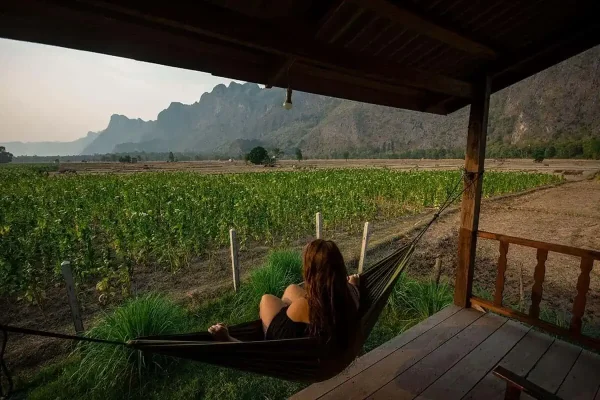
2 Weeks In Laos Itinerary: BEST Route North To South
Find out the perfect 2 weeks in Laos Itinerary to ensure you have the ultimate [...]
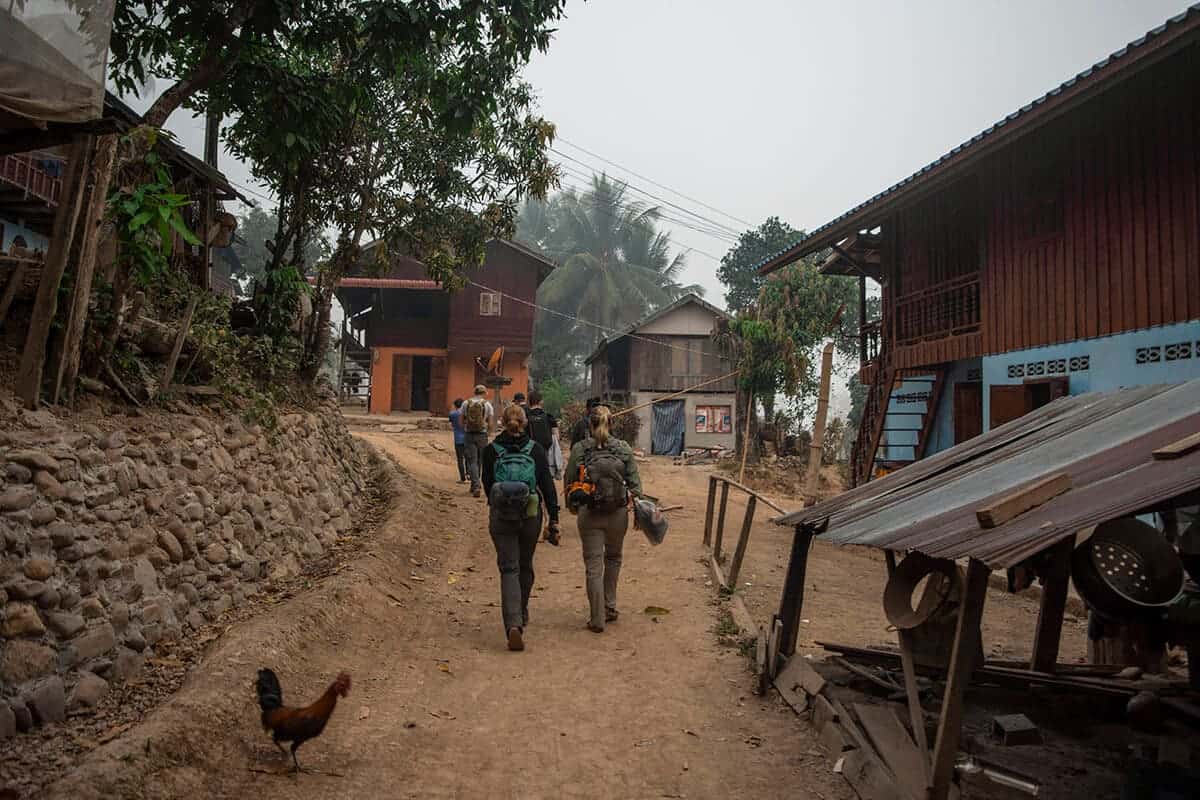
Scams In Laos: 7 Scams Travelers NEED To Know (2024)
Find out absolutely everything you need to know about common scams in Laos to help [...]

Tham Chang Cave & Blue Lagoon 2: What You NEED To Know
Find out all you need to know about visiting Tham Chang Cave in Vang Vieng [...]
Tasha Amy is a true backpacker at heart and has been discovering the world on a budget since 2015. Based in Gisborne, New Zealand she will spend many months each year traveling overseas as a solo female traveler before coming home and sharing her adventures online with you.
9 thoughts on “ 3 Days In Luang Prabang Itinerary: ULTIMATE Guide ”
Those waterfalls are amazing. I can’t believe how clear the water is. It looks like you had such a great trip.
Hi Is it reasonable to do a tour of the waterfalls and the caves in the one day ? Would it be too rushed? cheers Debbie
Currently in Luang Prabang, most reasonable private transfer to the caves we found was 450k KIP (for 2). We were being quoted upwards of 800k KIP
Hey Aislinn, thank you for the recent pricing! I have updated the post to reflect this. Hope you are having an amazing time in Luang Prabang!
Yes the night market is incredible. I love the little bakery stall there
Love the post, will share with our network!
I visited Luang Prabang 7 years ago and would love to go back! Lovee Luang Prabang and your pictures.
Wow. Those waterfalls are the most incredible thing I’ve ever seen. Absolutely beautiful photography!! The night market photo is fascinating as well. I’d love to visit the night market. (I’ve never met a market I didn’t enjoy for local color and flavors!)
I’ve visited loads of SE Asia, but Luang Prabang has escaped me. It looks absolutley stunning and I certainly need to book myslef a flight over there. I’m super keen to do the rice experiene, waterfalls and visit the night markets, can’t beat SE Asia street food. Pinned for future reference.
Leave a Reply Cancel reply
Your email address will not be published. Required fields are marked *

Home » Travel Guides » Laos » 25 Best Things To Do In Luang Prabang (Laos)
25 Best Things To Do In Luang Prabang (Laos)
Luang Prabang is often called the ‘Heart of Laos’ and many visitors choose to come here instead of Vientiane as it is known for its gorgeous countryside and scenic views across the majestic Mekong River.
Luang Prabang also lies on the Nam Khan River, meaning that you can take to the water on a trip here and this is also a UNESCO World Heritage Site, which tells you everything you need to know about the splendor of the city.
Another reason to come to the city is to check out the temples as you will be spoilt for choice on a trip here and can take in the gorgeous religious architecture at almost every turn. If you want to get out of town, then you can find spots that include lush waterfalls and pools.
Here are the 25 best things to do in Luang Prabang …
1. Climb Phousi Mountain

One of the main attractions in Luang Prabang is Phousi Mountain.
To get to the top you will need to walk up some 355 steps to get to the viewing platform but from here you will be able to look out over the city and take in the views.
There is also a small temple at the summit of the mountain which is actually a small hill rather than anything too taxing.
With that in mind, it is well worth the trip to the top for the panoramic vistas of famous spots in Luang Prabang.
2. Tour Wat Manorom

Wat Manorom is said to be one of the oldest temples in Luang Prabang and you and the signature feature is the main ordination hall which is also known as a sim in Lao.
Inside the sim you will find a statue of the Buddha which is made of bronze and said to date back to 1372, although it has been restored several times.
Getting to the wat is an adventure in itself as you have to walking through twisting streets to get to the main courtyard but it is more than worth the effort.
3. Trek to the Kuang Si Waterfalls

For many the highlight of a trip to Luang Prabang is the chance to visit the Kuang Si Waterfalls.
To get to the falls you can cycle through the countryside or sign up for a tour.
Once there you can trek through the jungle to the different falls which reveal themselves to you in stages.
There are also plunge pools at the base of the falls which are perfect for swimming in if you are hot after your hike.
The waters around the pools are known for their emerald green hue and you can watch families and monks taking in the scenery at the weekends.
4. Admire Wat Xieng Thong

Luang Prabang is known for its monasteries but none is more famous than Wat Xieng Thong.
This temple is known for its large ordination hall and the walls are adorned with intricate mosaics which have a tree of life mural in the center.
There are also a number of stupas here and some smaller chapels on the property, which means that you need to leave several hours to explore here to see everything.
There is also an image of the Standing Buddha and a Red Chapel which was built during the French colonial period which has an image of the Reclining Buddha.
5. Explore the rice fields

If you want to do something a little different in Luang Prabang then you need to visit Living Land Rice Farm which is on the outskirts of the city.
Here you can learn how rice is cultivated and harvested in Laos and you can have a go at walking through one of the many rice paddies here.
If you are feeling adventurous then you can even try ploughing a field with a water buffalo.
6. Take a cooking class

If you want to learn how to make delicious Laotian food then you need to take a cooking class while you are in Luang Prabang.
There are a number of different places where you can learn to cook, but one of the most famous is called Tamarind and you get to learn in an open kitchen which looks out over scenic fields.
There are a number of different classes that you can take but if you opt for one in the morning then this is also paired with a market trip so that you can learn all about the delicious local produce for which Laos is famous.
Some of the dishes that you can learn to make include laap or laab which is the national dish of Laos and is made of minced meat in a kind of salad.
You can also try your hand at making mok pa which is a kind of fish cooked in banana leaves.
7. Visit Wat Mai Suwannaphumaham

Wat Mai Suwannaphumaham has a rather long name so it is often just referred to by locals as Wat Mai.
This amazing monastery and temple is known for having a five tiered roof and the front patio has a series of gorgeous murals which show famous scenes from the life of the Buddha as well as the Ramayana.
This is also the home of the head of the Lao Buddhist faith who is known as the Sangharat so this is a very important spot in Laotian Buddhism.
8. Cross the river

Luang Prabang lies on the mighty Mekong but make sure that you take the time to get on a boat and jump across the river to the other side.
On the opposite side of the Mekong from Luang Prabang, you will find Wat Chompet which is a temple that sits on a hill and looks directly across to the city.
There are also a clutch of other temples here and some small caves if you want to spend the day exploring this side of Luang Prabang.
9. Tour Wat Sensoukaram

Wat Sensoukaram is known for its walls which are a deep crimson hue and are covered in gold leaf decorations.
As you would imagine, this makes it one of the prettiest temples in the city and it takes its name from the 100,000 Kip that it is said was used to build it from the ground up.
This may not sound like a lot now but it was a huge sum in the days of old, and this temple dates from 1718.
10. Get outside at Green Jungle Park

Some thirty-two kilometers outside of Luang Prabang you will find Green Jungle Park which is a great slice of greenery in the middle of the countryside.
One of the main activities here is zip lining and there are some 900 meters of zip lines to try out in the park.
As if that wasn’t enough you can also enjoy monkey bridges as well as rope lines which will let you check out the jungle canopy from above.
You will also find a nice cafe here and some gardens that make a good place to go for a stroll in the afternoon.
The park is also studded with limpid pools which make the perfect place to cool off in the afternoon.
The park is also known for its elephants which are all animals that were rescued or retired from the logging trade.
11. Shop at the Handicraft Night Market

The Handicraft Night Market is the Perfect Place to find some souvenirs and is located in Th Sisavangvong.
As you would expect from the name, the market starts up after dark and you will find a number of sellers who have amazing local handcrafts such as silk pieces, textiles, clothes, jewelry, ceramics and bamboo carvings.
The market is mainly meant for tourists in the area, but it still makes a great spot if you are looking for gifts.
12. Tour the Royal Palace Museum

If you want to learn more about the history of the Royal Palace in Luang Prabang then you need to head for the Royal Palace Museum which was built in 1904. Here you can check out galleries which have murals that show you how Laotian life has changes through history and you can also see exhibitions of antiques and other interesting artifacts.
13. Enjoy Bun Awk Phansa Festival

If you are in Luang Prabang in September or October then make sure you come to the Bun Awk Phansa Festival.
This takes place on the Nam Kahn River and you can enjoy vibrant boat races on the water.
It is Buddhist tradition to place boats fashioned from banana leaves on the water with a candle inside and sail them down the river in order to dispel bad luck.
This is also a way of thanking the waterways of Laos and appeasing the naga which are mythical river snakes said to lurk beneath the surface.
14. Eat at the Night Food Stalls

Distinct from the Night Market in Luang Prabang is the Night Food Stalls which set up at sunset and are located directly behind the main Tourist Office in the city.
Here you will find a selection of small tables which sell tasty local fare and this is the best place to come for an authentic taste of Laos.
If you like vegetarian food then you will be spoilt for choice here as there are a huge amount of vegetable based dishes available, or you can try the seafood or fish which is rubbed with fragrant lemongrass.

15. Visit TAEC Museum

If you want to learn more about the ethnic minorities in and around Luang Prabang then make sure you come to the TAEC Museum.
The building itself is a work of art and it actually used to be a mansion during the French colonial period and would have been built in the 1920s.
Now the mansion houses a small and compact museum that still manages to fill you in on the history of these amazing tribes.
Even though the museum only has three main rooms, it has galleries that are dedicated to the farming industry as well as exhibitions related to costumes and jewelry.
There is also an onsite shop where you can buy some local souvenirs and all the profits are funneled back into the local community.
16. Explore Wat That Luang
Wat That Luang is one of the more important temples in Luang Prabang as it would have been the place where the Lao royal family were cremated.
The wat is said to date from the 3rd century BC although many parts of it have been added to over the years or rebuilt meaning that much of the structure was built far more recently.
There are some pretty stupas here which are worth the visit alone, and legend has it that they contain the ashes of famous kings, although there is not historical basis for this to be true.
17. Experience the Pi Mai Festival

If you are in Luang Prabang in April then make sure that you don’t miss the famous water throwing festival which is also known as the Pi Mai Festival.
One thing to bear in mind is that the locals are very serious about their water throwing and they particularly like to drench foreigners, so make sure that you secure all your valuables inside plastic bags or they will get ruined.
18. Visit Wat Xieng Mouane

Wat Xieng Mouane is a temple that is located in the Old Quarter in Luang Prabang and is known primarily for its pretty ceiling which is covered in drawings of golden snakes called naga.
As with many temples in Laos, this is also a working monastery and you will find classrooms here where the monks are trained and where they learn a range of skills such as paintings, sculpting and carving.
19. Visit Pha Tad Ke Botanical Garden

Pha Tad Ke Botanical Garden has the claim to fame of being the first of its kind to open in Laos.
This also means that it’s a great spot for anyone looking for somewhere to relax and unwind in the center of the city.
As well as just getting to stroll around the gardens, you can also learn all about the orchids that grow here as part of a guided tour.
As if that wasn’t enough, then there is also the chance to try some free herbal tea that is brewed in the park as well as attend a bamboo handicraft tutorial.
20. Take a boat trip

As Luang Prabang is located on the river, one of the best things to do here is take a trip on a boat a check out the town from the point of view of the water.
As you speed along this famous waterway you can enjoy local villages and see fisherman as they haul in the day’s catch.
21. Visit Wat Ho Pha Bang

Wat Ho Pha Bang is known for the Pha Bang image which is said to have given the city its name.
This is a located inside a carved pavilion and you will also find a statue of the Buddha here which is said to date from 1512. The Buddha statue is actually a very important symbol in Laos and legend has it that it was made in the 1st century in Sri Lanka before being brought over to Laos.
It was then pilfered several times throughout history and taken to Thailand before being brought back and restored to its rightful place in the temple.
22. Watch a show at Garavek Storytelling

The word ‘garavek’ means ‘mythical bird’ in Lao and you can learn the story of this magical creature by taking in a show at Garavek Storytelling.
Here you will find an old performer who plays the lyre and who tells the story of this legend along with an English narrator.
There are a number of ancient folk stories told throughout the hour long performance and this is a great place to come if you are visiting Luang Prabang with children who will be mesmerized by the tales.
Bear in mind that this is a very popular attraction in the city so you need to book a seat in advance to avoid disappointment.
23. Visit Wat Phanluang
Wat Phanluang is one of the older temples in Luang Prabang but it is also one of the prettiest in a delightfully unshowy way.
The temple has some jade green carvings of water serpents on the roof which are known as naga in Laos and you will also find a pretty interior chamber which is painted in ochre and has some scenic murals depicting scenes of rural life.
24. Go spelunking at Tham Sakkalin

Tham Sakkalin is a large limestone cave which stretches for around 100 meters and is rather damp inside, but still worth a visit if you are visiting Wat Longkhun at the same time.
This temple is also said to have some Buddha statues inside although these have fallen into disrepair and it can be hard to make out the historical significance of the pieces.
25. Try the local cuisine

As Luang Prabang is firmly on the tourist trail in Laos, some visitors complain that it can be a little difficult to find authentic local dishes here.
With that in mind, make sure you make the effort to seek out local favorites such as buffalo noodles as well as the national dish which is called laap or laab.
To learn a little more about the food in Laos, you may want to visit the famous Tamarind Restaurant in Luang Prabang which is known for its large sharing platters.
25 Best Things To Do In Luang Prabang (Laos):
- Climb Phousi Mountain
- Tour Wat Manorom
- Trek to the Kuang Si Waterfalls
- Admire Wat Xieng Thong
- Explore the rice fields
- Take a cooking class
- Visit Wat Mai Suwannaphumaham
- Cross the river
- Tour Wat Sensoukaram
- Get outside at Green Jungle Park
- Shop at the Handicraft Night Market
- Tour the Royal Palace Museum
- Enjoy Bun Awk Phansa Festival
- Eat at the Night Food Stalls
- Visit TAEC Museum
- Explore Wat That Luang
- Experience the Pi Mai Festival
- Visit Wat Xieng Mouane
- Visit Pha Tad Ke Botanical Garden
- Take a boat trip
- Visit Wat Ho Pha Bang
- Watch a show at Garavek Storytelling
- Visit Wat Phanluang
- Go spelunking at Tham Sakkalin
- Try the local cuisine
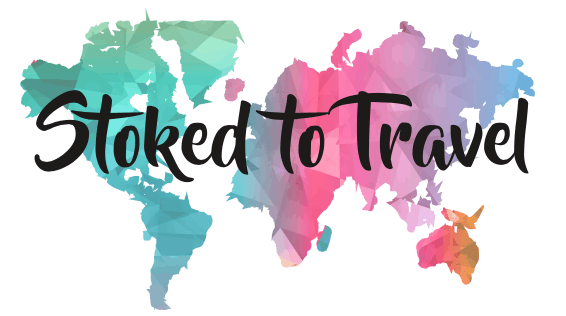
Luang Prabang Travel Guide: Best Things to Do and See in Luang Prabang, Laos
The beautiful old capital city of Luang Prabang in northern Laos is a true gem in Asia. Having first visited in 2010, I was charmed by its peaceful, calm streets lined with cute French colonial buildings. I’ve loved every visit to this enchanting destination, so in this Luang Prabang Travel Guide I cover all of the essential things to know before visiting. I’ll cover how to get to Luang Prabang, where to stay and of course, what to do and see. So read on and get planning your own trip to Luang Prabang, Laos.
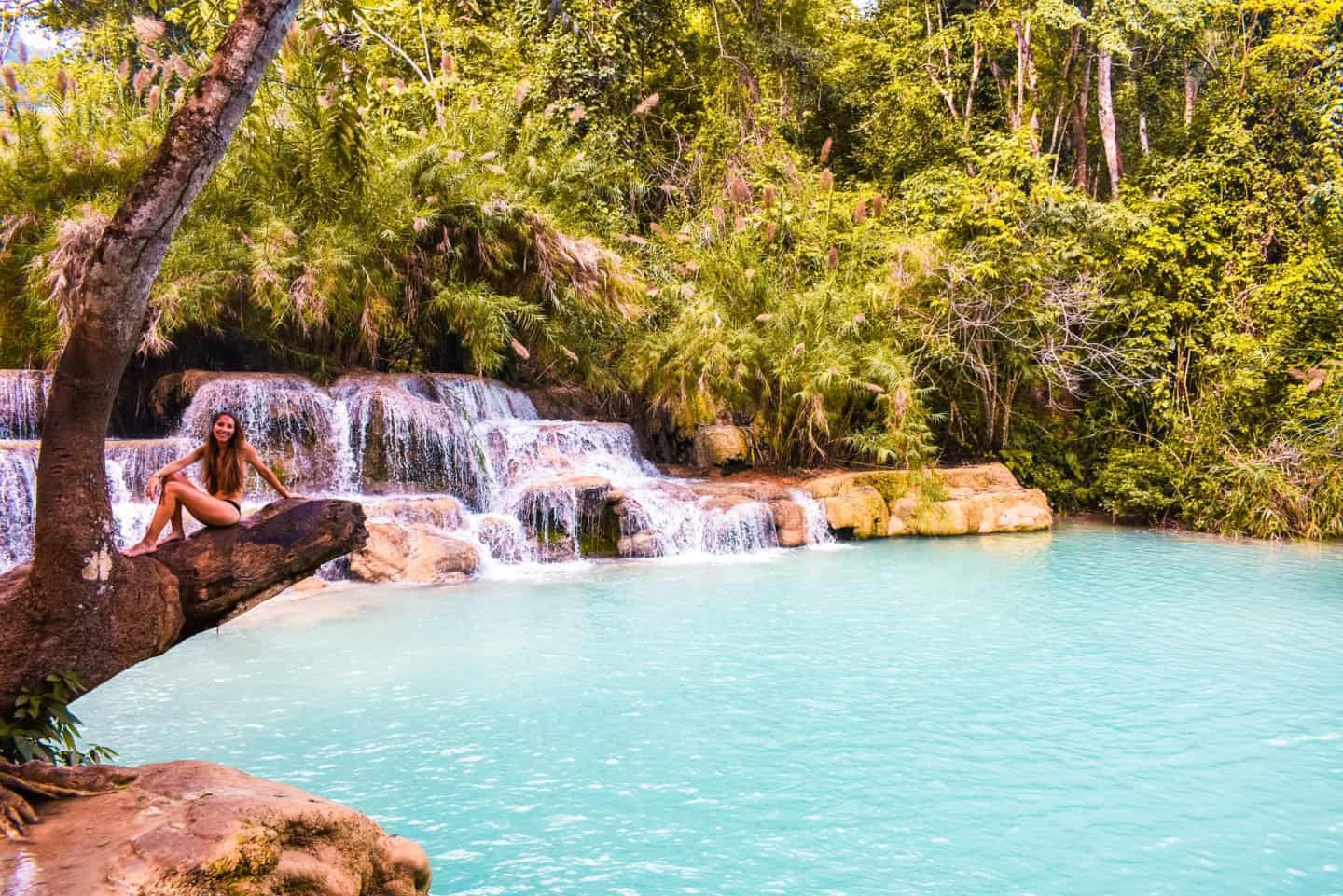
Luang Prabang Travel Guide: Practical Information
Luang Prabang is located in the moutainous north of Laos on a peninsula, where both the Mekong River and Nam Khan River meet.
The city feels like nowhere else I’ve been to in South East Asia. And despite its mesmerising charm, it is still not yet overcrowded by tourists.
In fact, one of my very favourite things about Luang Prabang is the lack of motorised vehicles and noise on the streets. Luang Prabang is such a relaxing place to visit, with both tourists and locals existing in harmony. There’s no hassle, no tacky tourists gifts and no honking of horns. Are you sold yet?
And whether you’re visiting Laos as a backpacker (check this guide to Laos backpacker travel tips here! ), a family holiday, or on a romantic couples trip – you’re guaranteed to have a great time.

For a small town, there’s a surprising number of things to do in Luang Prabang, from waterfalls, to temples to exciting markets. But before I get to the best activities to do, I thought I’d include a practical guide to Luang Prabang:
When to go to Luang Prabang
The city is a great year-round destination. The best months to visit are between November and February when it’s warm and dry. In the summer months (June to September), Laos, like most of South East Asia has its rainy season. The heavy rains don’t tend to last for more than an hour but they can make the rivers dangerous and roads impassable. The temperature can also be sweltering during this time, but you may score better value deals on accommodation in town.
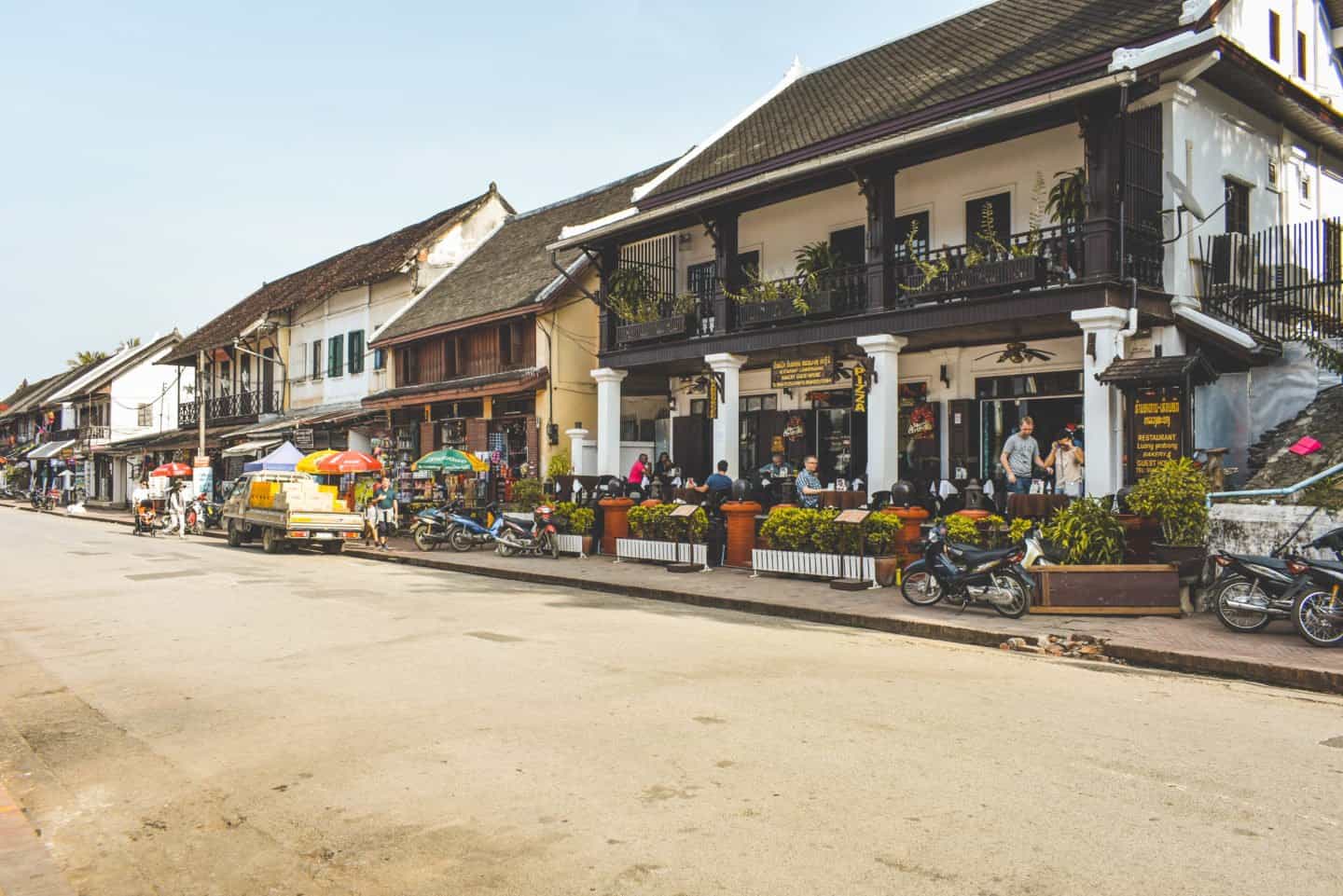
Getting to Luang Prabang
Back in 2010, when I first visited, there was no airport.
You had two options, the epic slow boat journey from Northern Thailand, or a long bus journey from there or from Southern Laos. Most travellers to Luang Prabang used to come from Northern Thailand (Chiang Mai or Pai), with the slow boat being the most popular option.
Today, there’s now a small international airport in Luang Prabang. Airlines such as AirAsia and Thai Airways connect Luang Prabang with other destinations in Asia, including Bangkok and Chiang Mai.
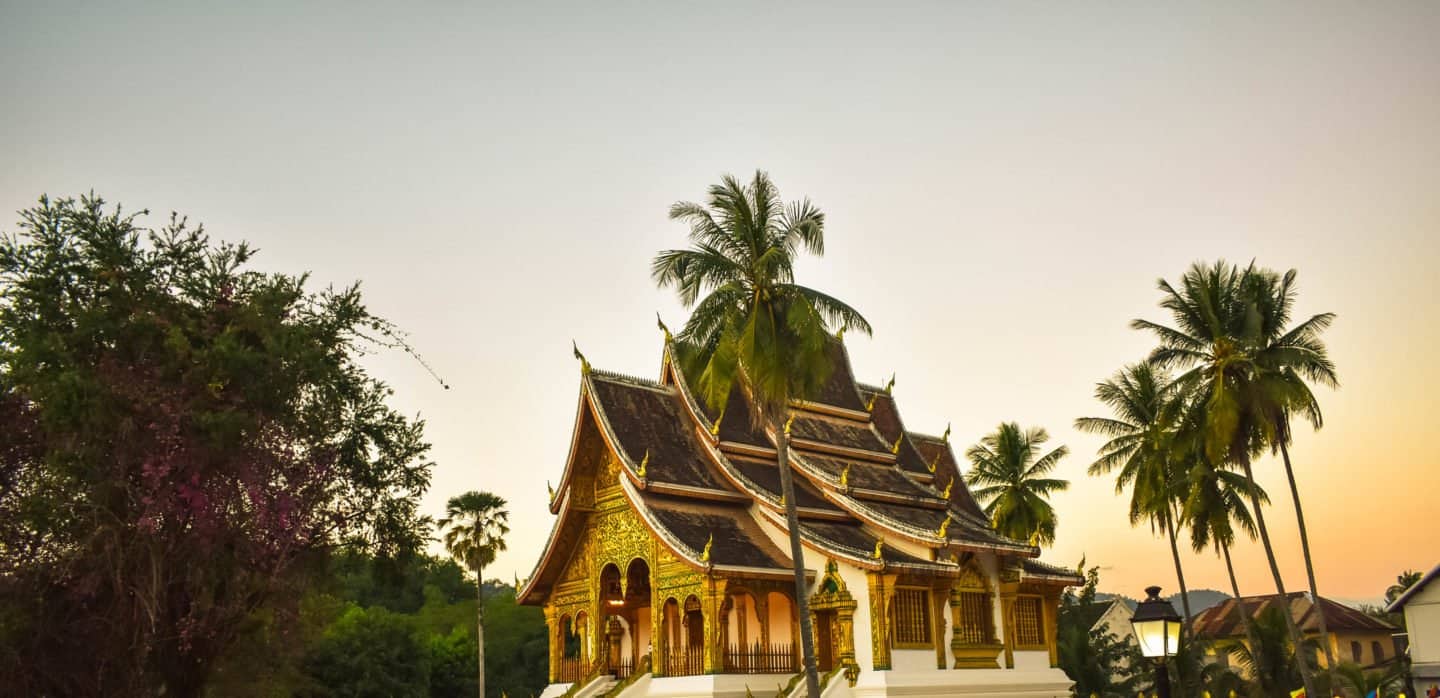
Getting around the town
Luang Prabang’s centre is wonderfully compact and you can walk everywhere. However, you’ll need a tuk tun to go to some of the nearby sites outside of the town centre.
You may want to hire bikes and you can most likely do this at your hotel. Otherwise, there are bike rental shops all over town and one day hire is around 30,000 LAK (£2.50).
To organise a tuk tuk to visit some of the attractions a little further afield, you can either ask a local driver in the street or ask at your hotel.

Where to stay in Luang Prabang
There is no shortage of small, family owned guesthouses in the town. Many of them are nestled behind the main street offering beautiful views of either the Mekong or Nam Khan River.
We stayed in MyLaoHome , a locally owned guesthouse with a strong focus on giving back to the community.
I’ve stayed here twice now. The first time, I stayed in its capsule pod hostel over the lane, and the second time in a private room within the main building. Its location is perfect, down a quiet laneway leading to the Mekong and just a stones’ throw from the main street. It is also really close to two of the best coffee shops in town (Joma and the Chang Kham Bakery).
Check rates for MyLaoHome here

Otherwise, I’ve selected some of the best luxury hotels in Luang Prabang here:
- Belmond La Résidence Phou Vao
- Sofitel Luang Prabang
- Maison Souvannaphoum Hotel
- Avani Luang Prabang
And some of the best value hotels here:
- My Dream Boutique Hotel
- Luang Prabang Residence Hotel
Best things to do in and around Luang Prabang
Go temple hopping.
There are more than 30 active temples in the town. Tourists are welcome to explore many of these, as long as they are respectful and cover up inside.
One of the most opulent and largest temple complexes in the town is Wat Xieng Thong. A temple of great historic importance, the structure has characteristics of 16th-century Lao architecture, together with elaborate mosaic patterns and wall carvings. This is where royal coronations traditionally took place, and his temple offers a fascinating insight into the Buddhist religion.
Admission cost: 20,000 LAK (£1.72)
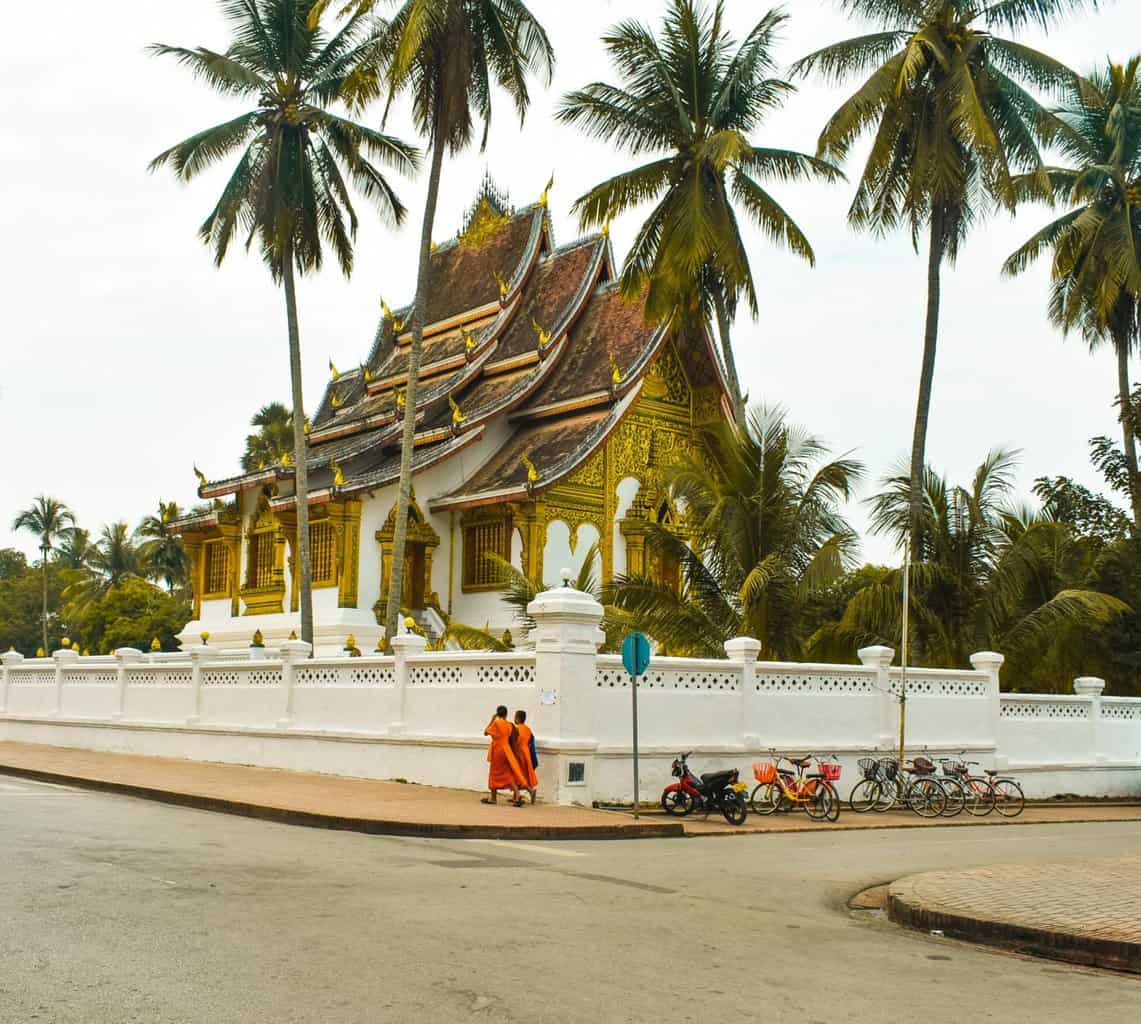
Explore the quaint streets and Mount Phousi
The French colonial architecture in Luang Prabang is colourful and quaint, and walking around the town centre is a joy. Along the main street, make sure to stop at Mount Phousi. This is the highest hill in Luang Prabang. There are 300 stairs to the top, but it is worth it for the views over the surrounding area and the Mekong River.
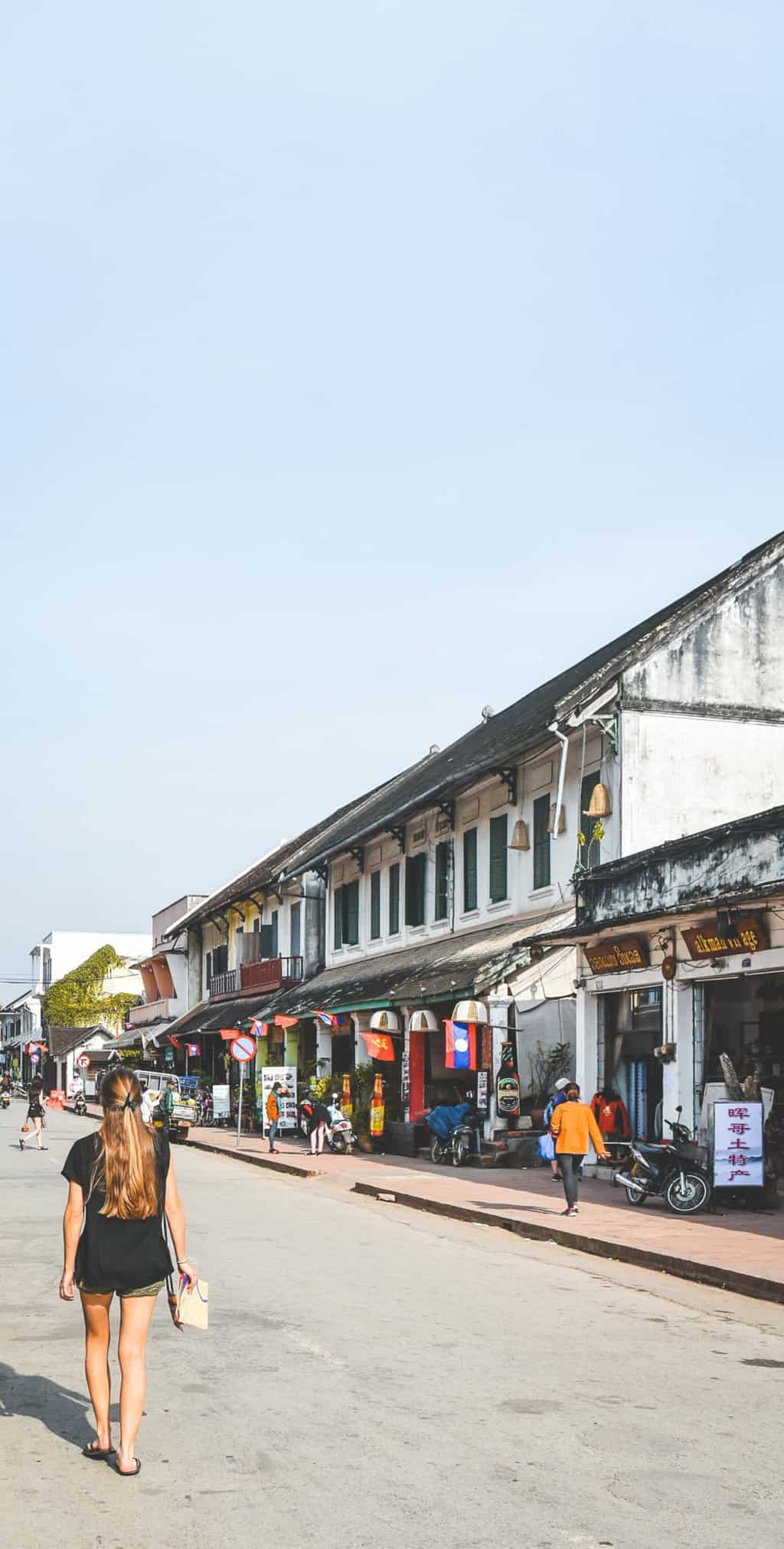
Enjoy the local cafe culture
One of my favourite things about Luang Prabang is the excellent coffee shops and bakeries. Waking up to the aroma of freshly baked bread is wonderful.
My favourite cafes include Joma Bakery, the Chang Kham bakery and the Ock Pop Tok Silk Road Cafe.
A little slice of Europe amid temples, monks and the Mekong river – perhaps I’m charmed by the unusual contrast. Either way I love it.

Enjoy the Kuang Si Waterfalls
The beautiful Kuang Si waterfalls are one of the most popular attractions in Laos.
Located around 30km from the centre of town, they’re one of the top things to see in Luang Prabang.
If you can, go on a weekday when it’ll be less busy, and definitely arrive early for fewer crowds. Make sure to check this guide on visiting the Kuang Si Falls here.

In the winter months, the water temperature may be a little cool. In the summer months, you can easily spend a full day jumping in and out of the water.
The water is more turquoise in winter months when the water levels are lower and the falls are more gentle. In the summer months, the water often towns brown as it churns up the mud from the bottom.
Tuk-tuk from town: 30,000-40,000 LAK (£2.60-£3.45)
Or book your tour to Kuang Si Waterfalls by tuk tuk here in advance.
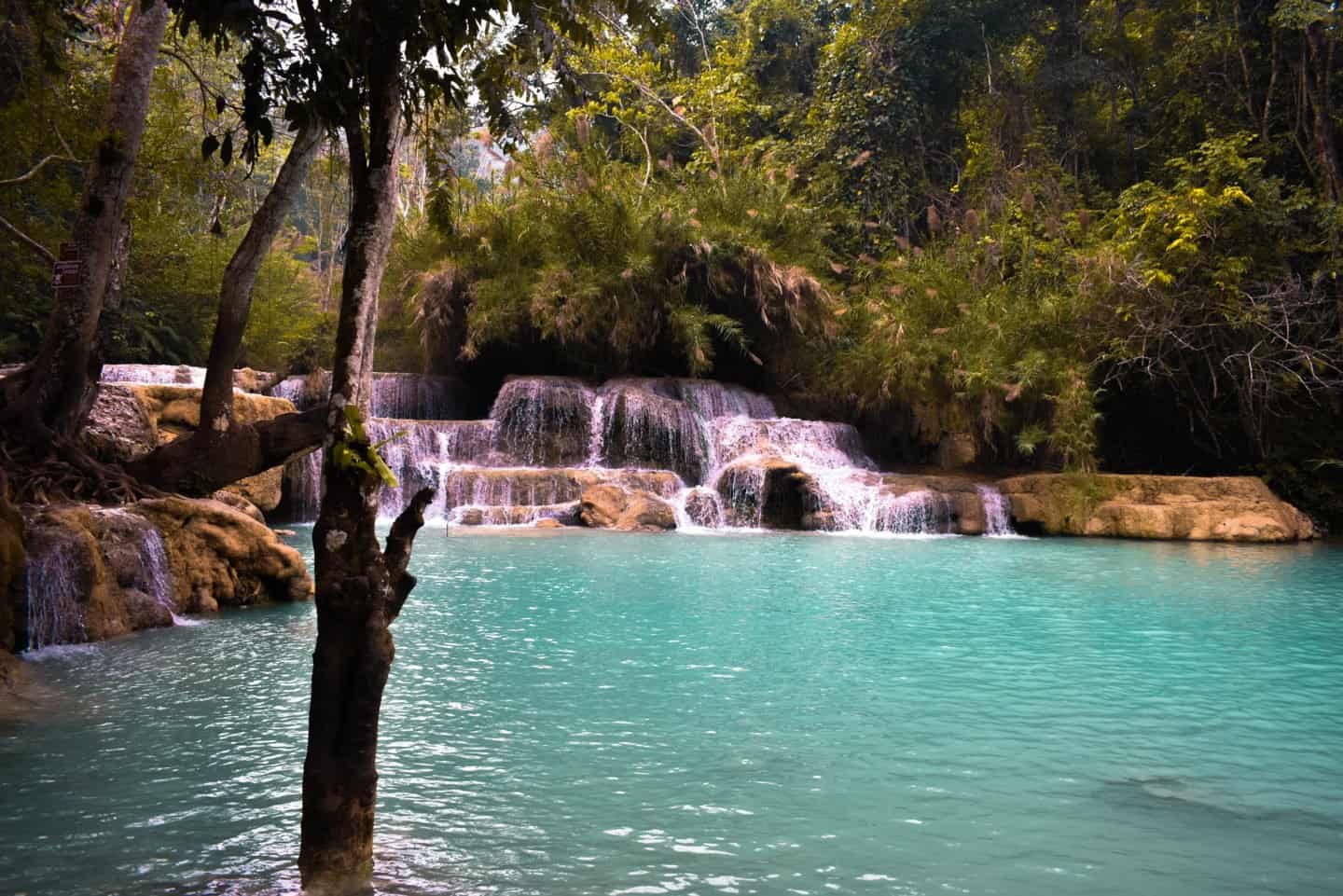
Befriend the Moon Bears
At the entrance to the waterfalls, there is an amazing bear sanctuary, the Tat Kuang Si Bear Rescue Centre . Home to a fascinating group of Moon Bears, it’s definitely worth stopping by. The bears are so playful and amusing to watch.
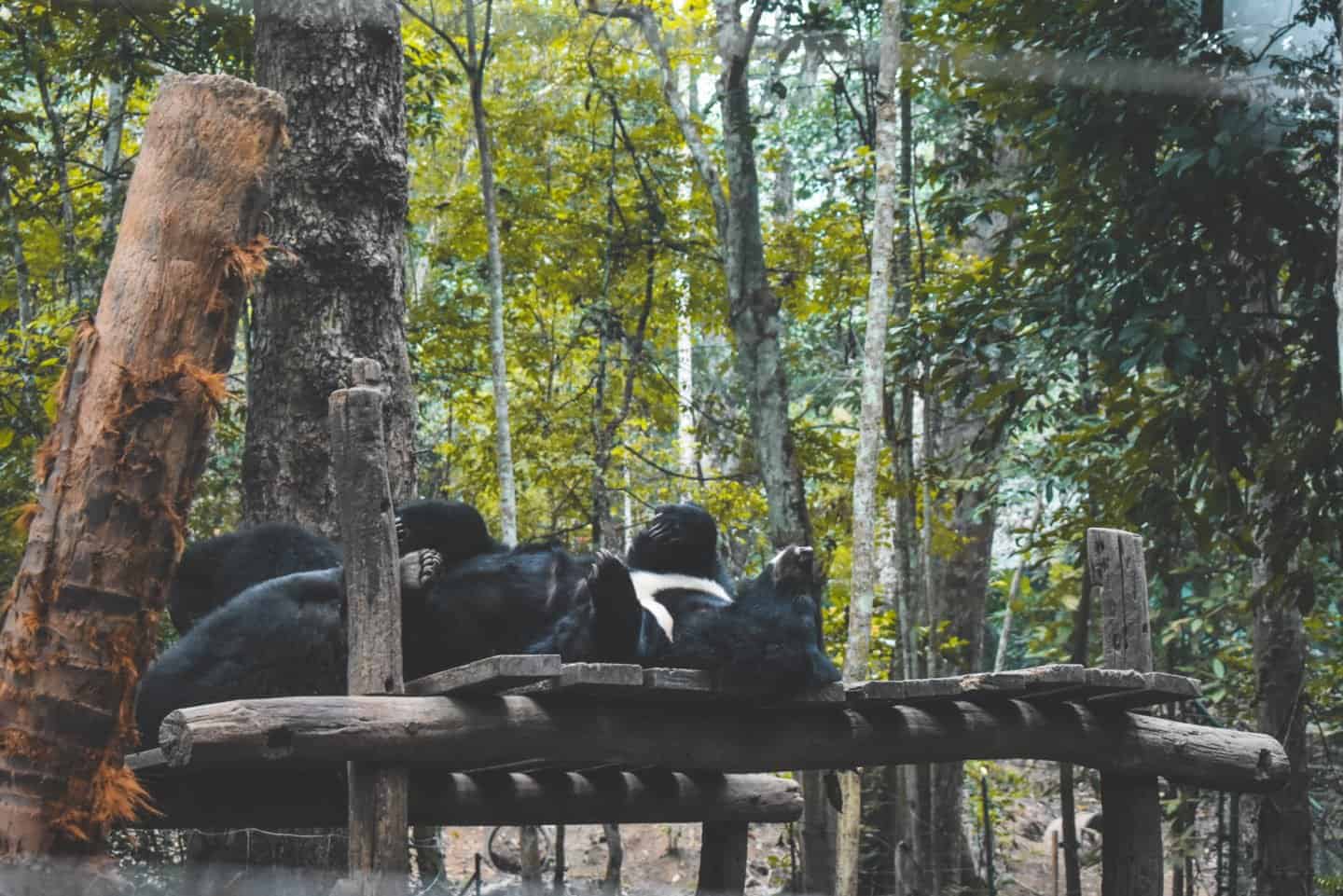
Watch a sunset by the Mekong River
Enjoy a drink at one of the many riverside bars and cafes and catch another beautiful sunset. Alternatively, head out onto the Mekong for a sunset river cruise. Book a sunset boat trip here.

Watch the daily alms giving ceremony (Tak Bat in Laos)
Each and every day before sunrise, the town’s resident monks leave the temples and walk down Sakkaline Road in the heart of town. It’s one of the most iconic images of South East Asia.
Single file, the robed monks walk barefoot along the streets to collect food alms in their basket.
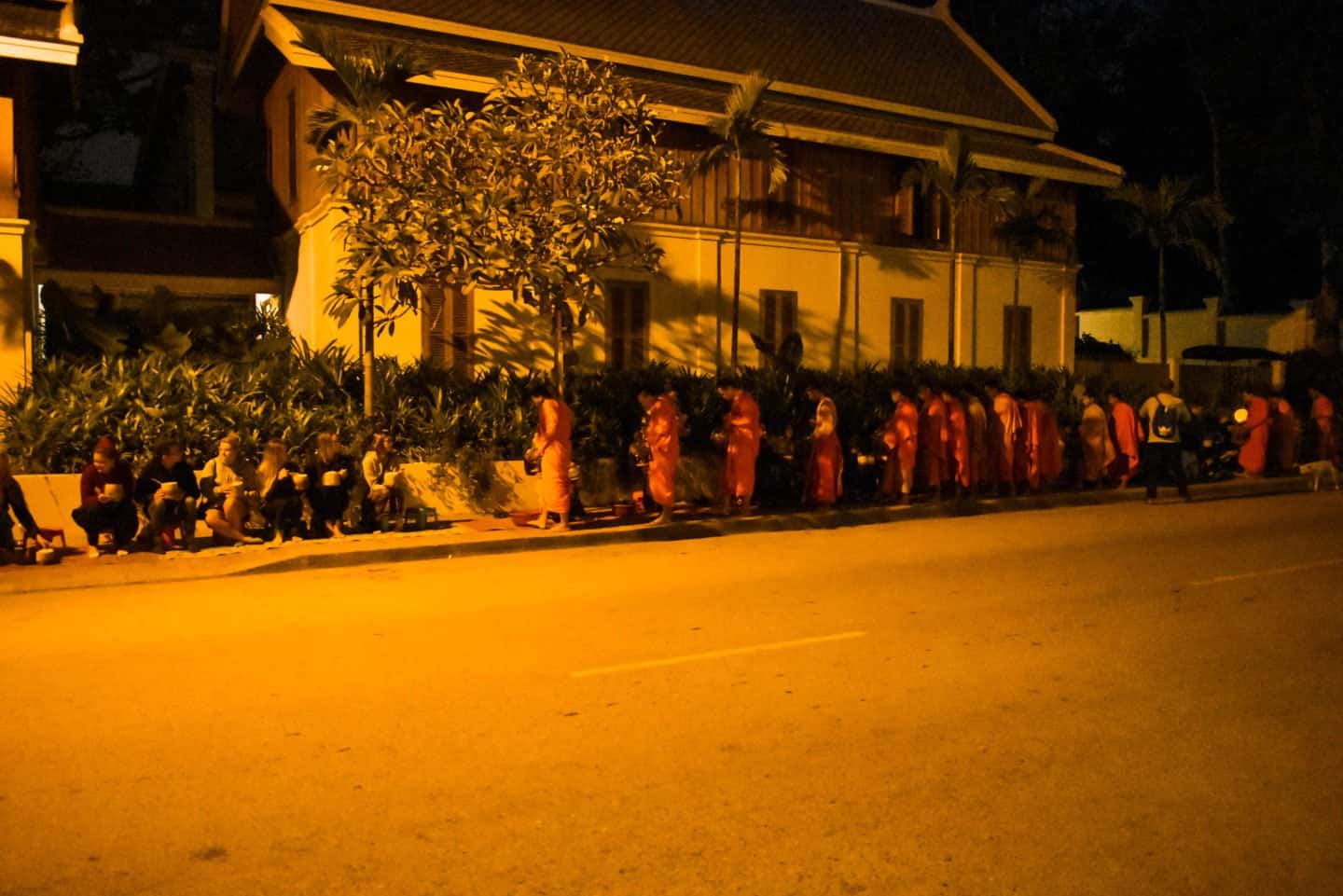
Not only is it a hugely important aspect of Lao culture and daily life in Luang Prabang, but a really interesting and unique way to participate in the town’s activity.
Any tourist is welcome to purchase sticky rice alms donations and join in at the side of the road.
Just remember to be respectful. Turn your camera flash off and don’t try to speak to the monks.
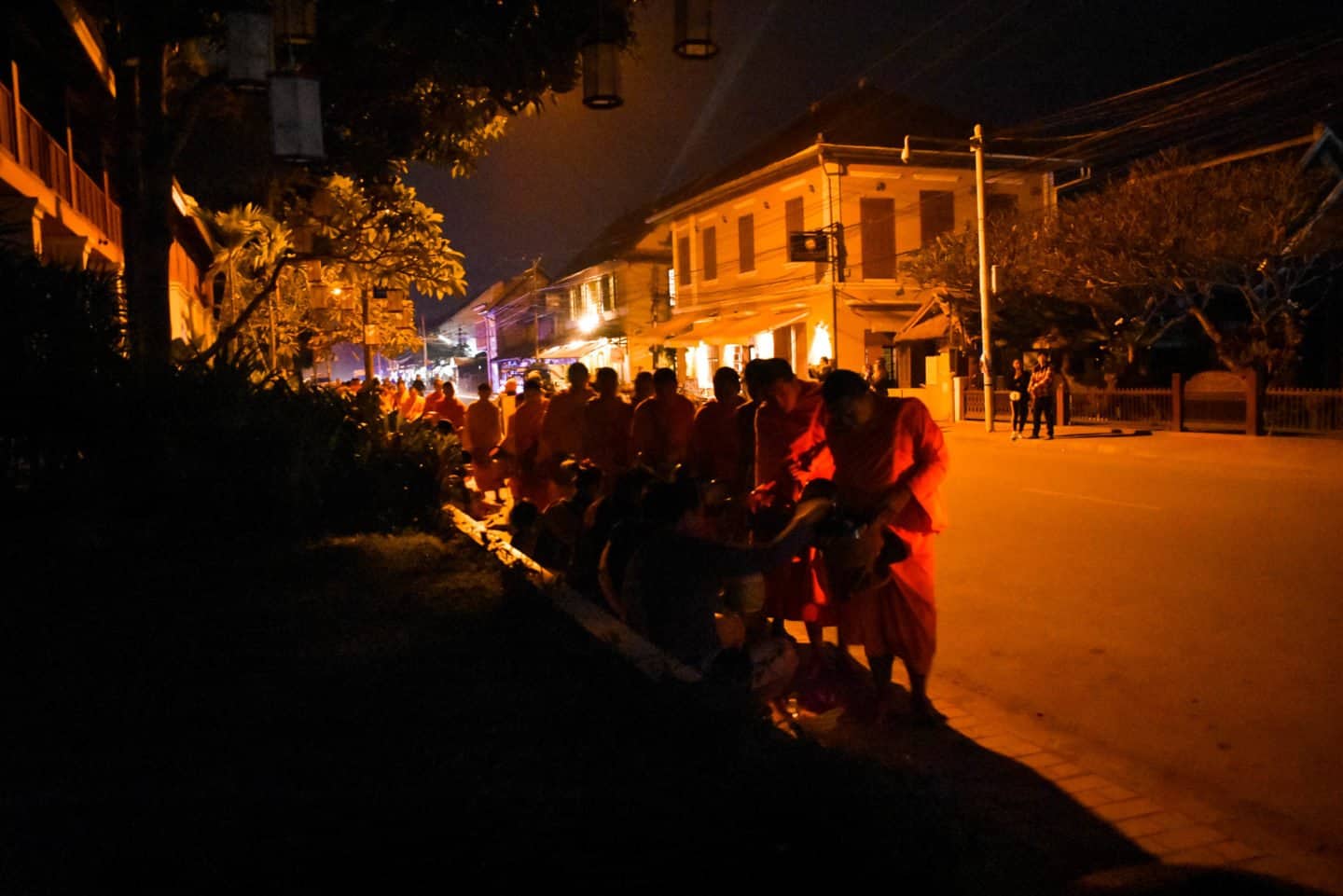
Savour the sights, smells and sounds of the night market
Every evening between 5 to 10pm, hill-tribe traders and local vendors come to the main street (Sisabvangvong Road) in Luang Prabang.
South East Asia has many night markets, but Luang Prabang’s is up there as one of the best, in my opinion.
The displays are beautiful, where you can buy everything from hand-painted art, wood carvings, jewellery, clothing and other local handicrafts.
Everything is great quality, but don’t try and haggle for a hard bargain. The Laos people are highly unconfrontational and will shy away from heavy bartering!
The night markets in Luang Prabang are a great spot to capture photos as the streets are so lively and full of colour.
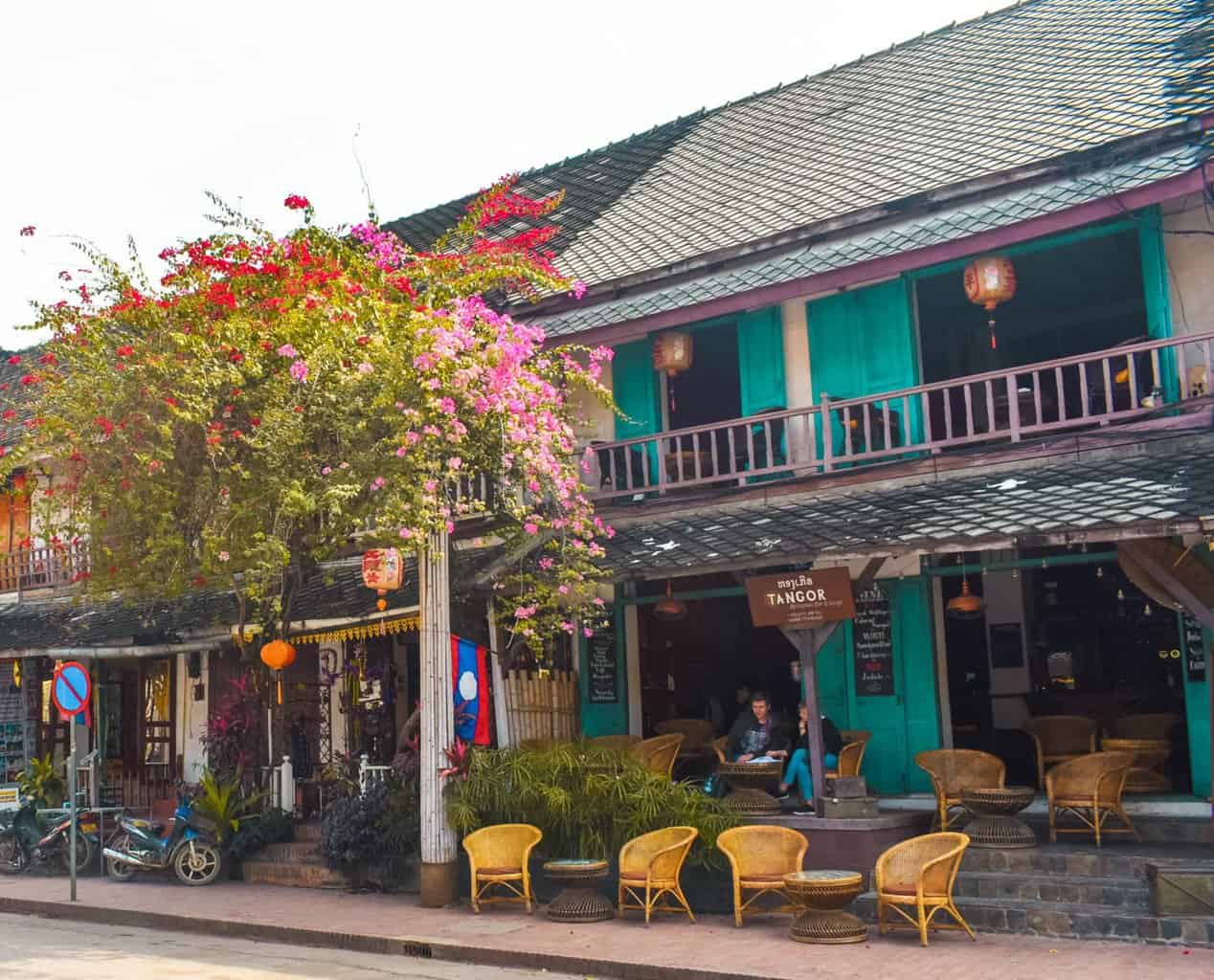
Tuck into the local food
Luang Prabang has some really excellent Laos and French restaurants. You’ll be hard pushed to find many other cuisines in the town.
There’s no shortage of excellent restaurants in the centre of town. My favourite restaurant is Tamarind . This lovely local restaurant aims to educate its guests on Lao cuisine through informative menus and the staff are happy to explain each dish.
They offer a number of set platters offering an array of Laotian dishes. Make sure to try the the herbed steamed fish served in a banana leaf – incredibly delicious!
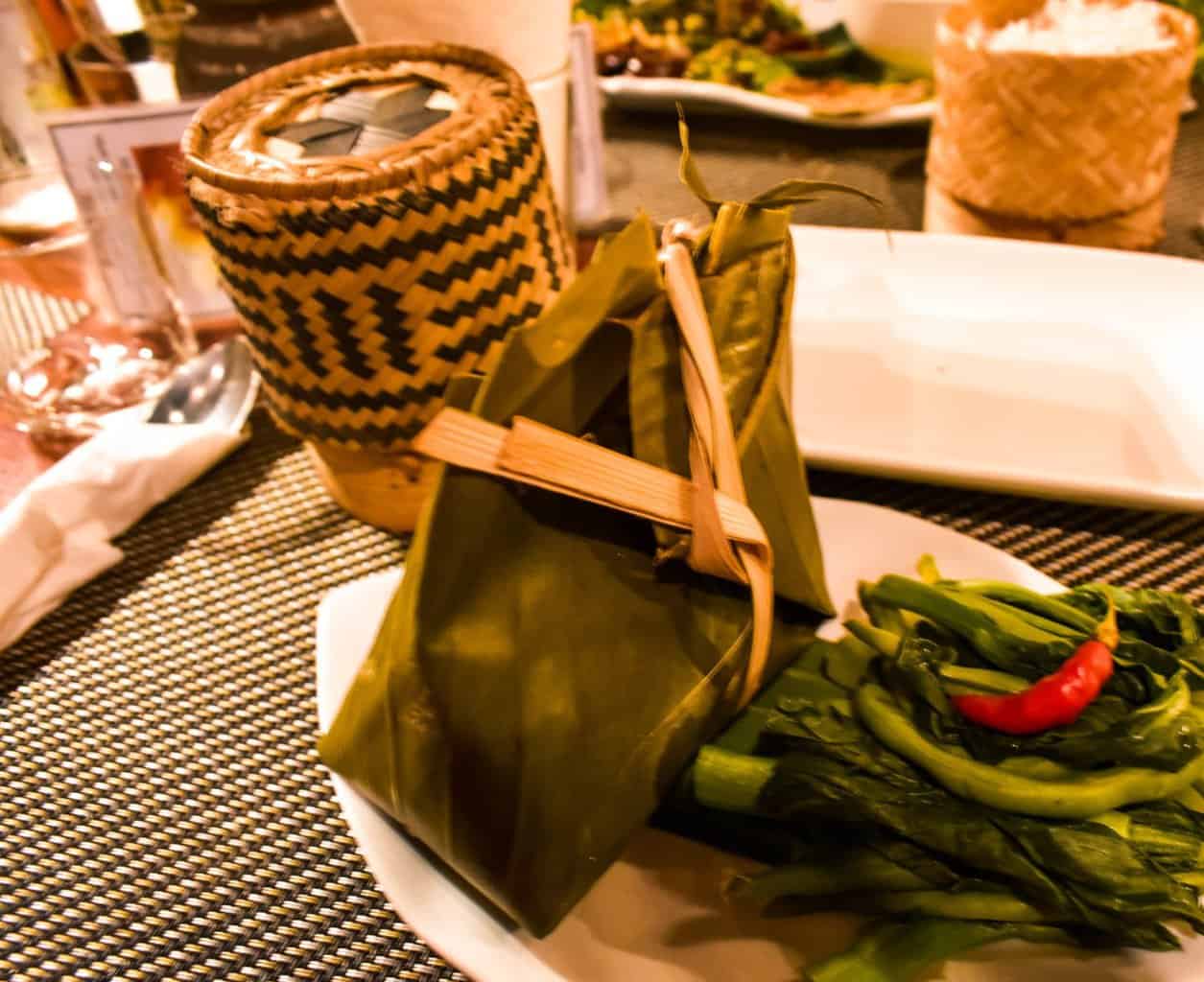
Explore along the Mekong and Nam Khan rivers
As mentioned, Luang Prabang is a small town located on a peninsula, with the tip being located at the confluence of the two rivers.
Not only can you take a dip in the rivers either side, but you can cross them by bamboo bridge and explore the villages opposite.
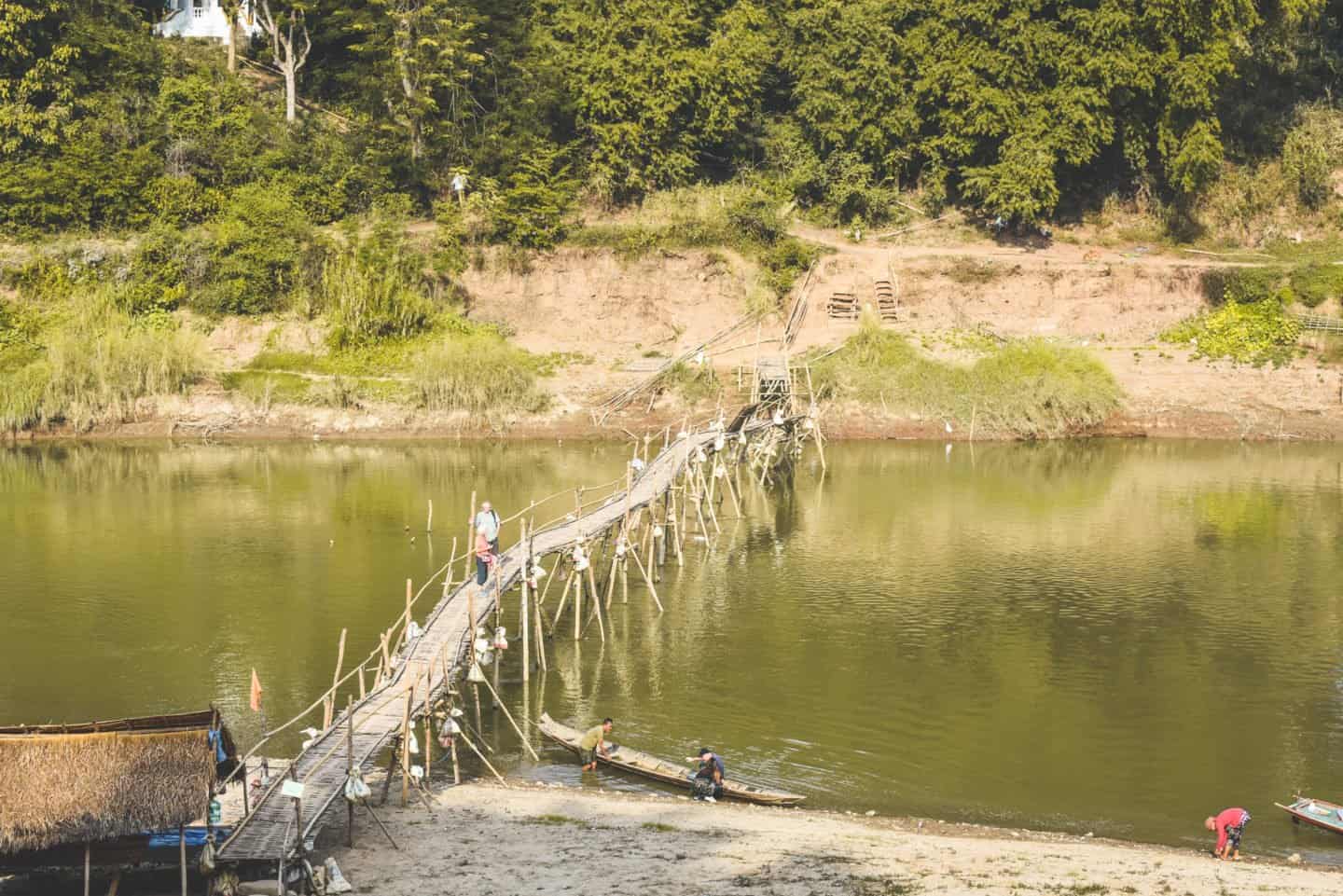
Spend the day with elephants at MandaLao
One of my favourite days ever was spent at Mandalao Elephant Conservation, near to Luang Prabang. A truly ethical experience, Mandalao have rescued animals from logging or the tourism trade and given them peaceful, safe homes at Mandalao.
You can join small groups for various elephant engagement activities, but absolutely no riding takes place at Mandalao. Read more about my wonderful experience at Mandalao here.

Enjoy a Lao cooking class
Why not learn to cook up some delicious Lao dishes? Cooking classes are always a great way to immerse yourself in the location culture, and Laos is no different. Learn to cook local dishes such as mok pa (steamed fish).
Ask your hotel or drop into one of the tourist stalls in town to arrange a class.
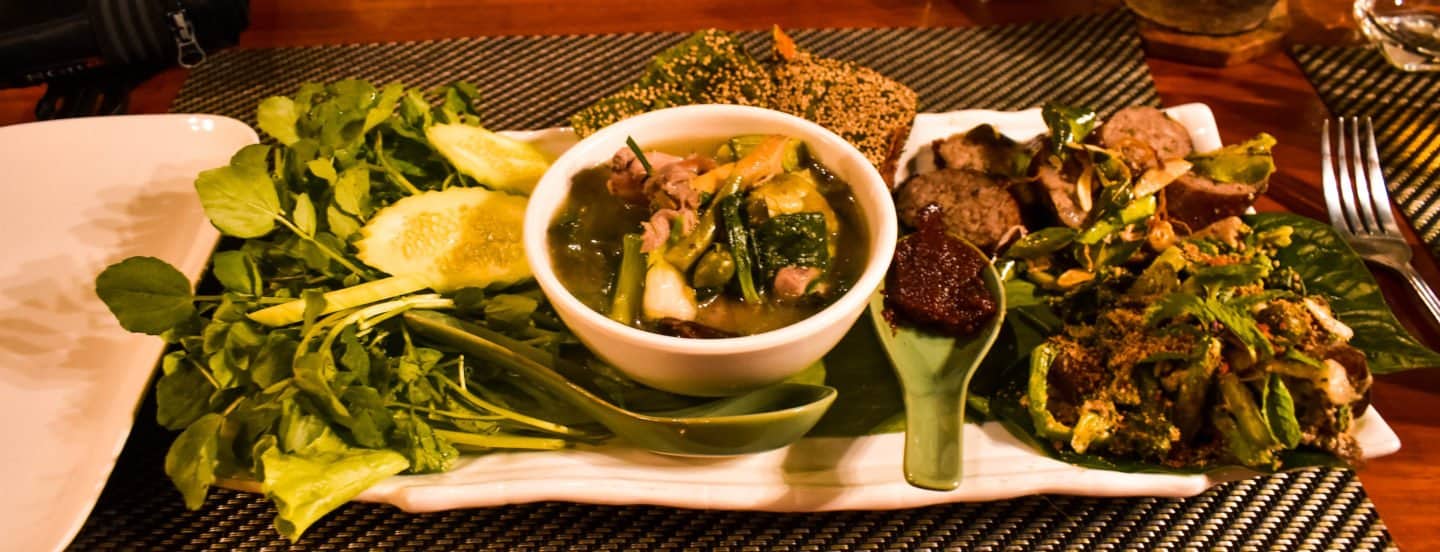
Chill out at Utopia bar
Luang Prabang offers very little in terms of nightlife, but the hip hangout at Utopia is the best the town has. Overlooking the Nam Khan river, this bar is a great spot for a daytime beer and chill. Or later in the evening, its the best drinking spot in town.
Luang Prabang Travel Guide
So there you have my Luang Prabang Travel guide to the top things to do and see in this beautiful area. I hope this guide proves useful and that maybe I’ve inspired you to visit this gorgeous island on your travels! If you’ve already been to Luang Prabang, let me know in the comments! I’d love to hear from you!
If you’re travelling around the country, read this post on backpacking Laos and make sure to check out my guide to my Mandalao Elephant experience . Vientiane is the capital and largest city in Laos, located around a 6 hour drive away. I’d recommend visiting here too – here’s a great guide on the best things to do in Vientiane to help with your planning.
If you’ve enjoyed this Luang Prabang Travel Guide, feel free to share using the below links!
Wanna see more? Check my Instagram here , my Facebook here or my Twitter here !
Disclaimer: This visit to Luang Prabang was entirely paid for by myself. There was no involvement from the tourism board or a hotel. This is an independent guide.
Enjoyed my Luang Prabang Travel Guide? Pin it!
You may also enjoy:
Guide to el nido: the best …, guide to bohol island in the …, cambodia travel guide: the best places …, the best beach clubs in bali – ….
Great post – thanks for info ! Makes me want to go !
Definitely do! Couldn’t recommend the city more!
Thank you for such an interesting post !
You’re welcome! x
Leave a Reply Cancel reply
Your email address will not be published. Required fields are marked *
Let’s connect
Wander-Lush
25 Awesome Things to Do in Luang Prabang, Laos’ Golden City
Ask anyone who’s visited Luang Prabang and they’ll tell you this sweet little city captured their heart.
From the heritage architecture to the Buddhist traditions and vibrant markets that crowd the streets every morning and night, this is the place to get lost in the beauty of Lao culture and soak up the soul of the country.
Luang Prabang’s small streets are lined with funky little restaurants, shops selling gorgeous handmade silk clothes and silver jewellery, and museums dedicated to the area’s ethnic diversity. The food night market is a crush of people, smoky barbecues and tantalising smells, while vendors whip up flavoursome meals for a couple of bucks.
Monks wander the streets in groups of two or three. The Mekong River meanders along one side, with the smaller Khan River the other side, joining the Mekong at the tip of the peninsula. Cute little side alleys cut through and around elegant French colonial buildings – and looking down on all this is Wat Chomsi, a golden stupa sitting atop of Phousi.
A couple of years ago, I was lucky enough to spend three months living in Luang Prabang while I interned at the Ock Pop Tok Living Crafts Center. It was a life-changing experience that instilled a love for Luang Prabang that I’ll carry for the rest of my life.
A lot has changed since I was last in Laos – so for this guide, I thought I would invite a few of my colleagues to share their travel experiences and recommendations for what to do in Luang Prabang as well. Together, we’ve come up with a pretty comprehensive list – and a pretty awesome guide to Luang Prabang if I do say so myself!
This guide includes:
- The top 12 best things to do in Luang Prabang
- The best things to do around Luang Prabang
- The best things to do in Luang Prabang at night
At the end of the list, I’ve included detailed information about where to stay in Luang Prabang (my personal recommendations), how to get to Luang Prabang, plus more tips for planning the perfect trip to Laos’ Golden City.
Please note: This post contains affiliate links, meaning I may earn a commission if you make a purchase by clicking a link (at no extra cost to you). Learn more.
Luang Prabang cheat sheet
Get there: Train or minibus from Vientiane. See your transport options and buy your bus/train tickets here on 12GoAsia .
Airport transfer: If you’re flying in, pre-book a hassle free transfer to your hotel (prices start from $28 per group).
Where to stay in Luang Prabang: Mekong Riverview Hotel (luxury hotel; from $150); Ock Pop Tok Mekong Villa (boutique hotel; from $70); Sabai Sabai Estate No. 1 (villa; from $65) Golden Lotus Place (mid-range hotel; from $35) Vanvisa Guesthouse (budget guesthouse; from $9).
Best city tour: Half-day walking tour of the UNESCO Old Town with a local guide (from $25).
Best Laung Prabang day trip: Pak Ou Caves & Kuang Si Falls by slow boat (from $45).
5 things to pack: Lightweight cotton scarf (for visiting temples); travel pumice stone (for cleaning your feet after temple-hopping!); refillable water bottle ; a few bottles of your favourite sunscreen ; the latest Lonely Planet guidebook for Laos (published July 2020).

Top 12 best things to do in Luang Prabang
Let’s start with the Luang Prabang essentials. Here are 12 things no visitor should miss.
1. Explore the UNESCO Old Town & heritage architecture

One of the best things to do in Luang Prabang is to relax and soak up the scenery of the historic Old Town. More popular with visitors, Luang Prabang has a very different vibe to the capital city of Vientiane . After a long day of travel or sightseeing, we found that the most enjoyable way to relax each evening was to wander the streets and find somewhere to have a drink with a view.
Luang Prabang’s Old Quarter, which is nestled on a small peninsula surrounded by the Nam Khan and Mekong River on three sides, is a lovely area for an evening stroll. The Old Quarter seems to have less traffic and is surprisingly quiet.
Strolling the Old Quarter streets, we loved admiring the mix of Buddhist and French Colonial architecture . Surrounded by lush greenery and tall trees, many of the historic buildings in this area have been converted into luxurious hotels and restaurants.
After an evening of wandering, we found no better way to cap off the night than to visit the Viewpoint Café and Restaurant . Located at the point of the peninsula where the two rivers converge, it offers a wonderful view of the area and surrounding mountains. Sitting here at sunset, looking out over the rivers is simply the best way to spend the evening in this charming, historic town.
Recommended by Liz of Peanuts or Pretzels Travel Blog
Guided option: This half-day walking tour visits all the main landmarks over four hours.
2. Observe the Alms Giving Ceremony

We visited Luang Prabang as part of a three-month sabbatical around Southeast Asia, and it was by far our favourite city of the entire trip.
Our most memorable day started with getting up early to watch the alms giving ceremony that happens at dawn . Alms giving is common in Buddhism and is a way to support the monks by offering them food. There are 34 temples in Luang Prabang from which the orange-robed monks emerge with baskets, ready to receive balls of rice from local people.
Unfortunately, this ceremony has become somewhat controversial over the past few years , with tour guides bringing large groups of people here to view it. There have been many occasions where the ceremony has been interrupted, and a number of signs have now been placed around town encouraging people to show more respect while it’s happening.
We sat quietly out of the way on a back street, and were treated to a magical experience that could easily have been lifted from a movie script. The single-file line of monks wrapped around the corner, each monk quietly making their way from house to house. Some of the monks were very young, and were struggling to hang on to their baskets which were now full of sticky rice balls.
The colour of their saffron robes breaking through the morning mist is as iconic imagine of Asia, and an unforgettable memory from our time in Laos.
Recommended by Ben of The Sabbatical Guide
Guided option: If you want to participate in the Alms Giving Ceremony, I highly recommend going with a local. This early morning tour will pair you with a local guide to ensure you understand the significance of the ritual and maintain etiquette. Also including a wander around the morning market, it’s the perfect way to spend a morning in Luang Prabang.
Luang Prabang is probably the coolest place to visit in Laos. One of the most unique and memorable things to do in Luang Prabang is witness and take part in the early morning monk offerings.
Every morning the monks depart from their temples to walk the crowded streets. During this walk they collect food offerings provided by the locals (and tourists). The locals do this as a sign of respect for the monks and to find peace within themselves in satisfaction of helping out the spiritual Lao monks.
To take part in the ceremony, take some food and wait on the side of the pavement. This is before sunrise, usually around 6am. As the monks walk past in single file, they will collect the food you offer in a basket.
Top tips for the early morning offering:
- You should be aware that this is a Lao tradition . Before you try to get that Insta photo, remember to be respectful of the monks and this local tradition.
- Take a jacket as it’s usually a little cool at that time of the morning.
- The offerings last around 45 minutes to an hour. You can either then go back to bed or begin the day with a good breakfast and a hike up to Mount Phousi.
Recommended by Louis of TheNorthernBoy
3. Wander the morning market

After morning alms, head to one of Luang Prabang’s sprawling morning markets for an insight into local food culture and commerce. It’s also the perfect place to grab a quick breakfast snack of khao jee – grilled sticky rice on a bamboo skewer served up on a banana leaf.
These food markets start early and usually wind by around 10am, so you need to arrive early if you want to see the most plentiful array of tropical fruits, still-flopping fish and piles of curious-looking produce . Unlike the night handicraft market, this is the domain of locals and a place where families come to do their grocery shopping – it has a more authentic vibe and an energy that the night market is missing.
Wander the aisles and photograph the spread of vibrant produce, stopping to say good morning to a few of the vendors. Amongst the fruit and veg you’ll also find jars of homemade rice wine and little packets of rice cakes – the latter makes for the perfect midday snack, so pick up a couple to fuel the rest of your day in Luang Prabang.
You can find the main morning market on the peninsular, just off Luang Prabang’s main street (see the exact location here ). If you’re too late for morning market, Phosy Market is open throughout the day and is a good alternative.
4. Visit the Royal Palace

The Royal Palace in Luang Prabang, also known as the Golden Palace or Haw Kaum, was the royal residence of King Sisavang Vong and his family during the French colonial era. It was built in 1904 to replace the old palace, which had been destroyed by mercenaries from China in 1887.
King Sisavang Vong was a collaborator with the French colonialists and supported their rule over the country in exchange for a life of opulence for himself and his family. This perhaps explains why the palace is built in a mix of traditional Lao and French styles .
After the Lao Revolution in 1975, the palace was converted to a museum and opened to the public. On display are relics from the period of the monarchy , including the throne room and the King and Queen’s sleeping quarters.
More interesting is the 2,000-year-old golden statue of Buddha known as Phra Bang , which is the holiest Buddha image in Laos. The city of Luang Prabang is named after this statue.
You’ll find it inside the Haw Pha Bang temple , which is brightly decorated in gold. The temple is constructed in the traditional style, making it appear old, but in fact it was built in 2006.
The palace complex is in a prime location right by the river. It was built here so that official visitors who arrived by boat could be received by the royal family as soon as they disembarked.
Entry to the complex costs 30,000 kip, and it’s open from 8am to 11.30am and again from 1.30pm until 4pm daily. Cameras, videos recorders, shoes and bags are all prohibited. There are free lockers at the entrance where you can leave these items. Sometimes local drama or dance performances are held in the adjacent theatre.
After your visit, stop in at the nearby Coconut Garden restaurant, which comes highly recommended and is one of the best places for vegan-friendly food in Laos .
Recommended by Wendy of The Nomadic Vegan
5. Go Wat hopping

When visiting Laos you will definitely not run out of amazing things to do and places to explore . Of all of the places in Laos, Luang Prabang was one of my favourite Southeast Asian cities and it is quite a magical place.
The way the city is laid out right next to the Mekong Delta is quite breathtaking. We were lucky enough to in Luang Prabang during the Lai Heua Fai festival, which is the festival of the fireboat. During this week-long festival, all of the wats in Luang Prabang are lit up by little tea lights, giving them a gorgeous luminescent look.
Even if you are not there during this amazing festival, exploring all of the different wats is one of the best things to do in Luang Prabang. They are all decorated so beautifully and inspire such a feeling of zen as soon as you enter.
Luang Prabang was also the place where we had the most interactions with monks , and we really enjoyed it every time. The monks living at the wats are so friendly and happy that you’re there exploring their home. They smile and wave at you and invite you to explore and take photos.
You’ll find many wats sprinkled around the entire city. There is no way you could miss them when walking around. Don’t be afraid to go in and see what they are all about!
Recommended by Jessica of Unearth The Voyage
Wat etiquette: Be sure to behave respectfully (no running or raised voices) and observe the conservative dress code when visiting temples in Luang Prabang. If you really want to look the part, why not rent a traditional Lao outfit from Sao Sinh for the day!
6. Admire the glass mosaics at the splendid Wat Xiengthong

Wat Xiengthong is one of the most famous Buddhist temples in Luang Prabang. Built in 1559-1560 by the Lao King Setthathirath, it was the place where all kings were crowned up until 1975.
The wat has carved gilded wooden doors depicting different scenes from Buddha’s life. Here you can also see a very rare reclining Buddha, dating back to the time of the temple’s construction.
The most impressive feature of this temple are the glass mosaics that decorate the external walls. Miniatures of people, palm trees and animals form elaborate scenes from daily life and sparkle in the sunlight.
What’s so fascinating about this temple is how intact it has remained throughout the years, and many of the Buddha images are original. This means that you can actually see how Buddha’s life story was being told in Laos back in the 1500s .
It’s easy to find your way to Wat Xhiengthong since there are signs in many places in the centre of Luang Prabang. The temple is located next to the Mekong River. You can access the stairs from Khem Khong Road. The entrance fee is 20,000 kip, or around $2.
Recommended by Alexander of Destinavo
7. Climb Mount Phousi for a view

Mount Phousi (Phou Si Hill) is a 100-metre-high hill in the centre of Luang Prabang. From its summit there’s an incredible view over the city, the Mekong River, and the Nam Khan. The views are simply breathtaking , especially at sunrise and sunset, and it’s the ideal spot to take photos of the city and its surroundings. It was one of our favourite things to do in Laos .
To get to the top of Mount Phousi you will need to climb about 300 stairs , but it is well worth the strain. Along the way, there are small Buddhist temples and statues; the name of the mountain means ‘sacred hill’ in Lao language and it’s a pilgrimage site for Buddhists.
On top of the hill there is a Buddhist temple, Wat Chom Si , and a small cave with a Buddha statue. Traditionally people leaves flowers and incense here as a sign of respect.
There are two entrances to Mount Phousi, one opposite the Royal Palace Museum and the other next to the Nam Khan River. We opted to climb through one way and descend through the other. But we advise you to start by the Royal Palace Museum as it has fewer stairs. There is an entrance fee of 20,000 kip.
Recommended by Jorge of Travel Drafts
8. Eat Lao cuisine

When it comes to food, Laos might not have the same reputation as neighbouring Thailand or Vietnam – but Lao cuisine is full of surprises. Regional dishes in the north are particularly delicious, and there’s certainly no shortage of restaurants to sample local cooking in Luang Prabang.
Sticky rice is the building block of any meal in Laos and holds every meal together (literally!). Known locally as Khao Niao , it’s typically presented in delightful little single-serve woven baskets. Fresh and fragrant Larb is another staple of Lao cooking and a must-try. It consists of marinated meat (usually chicken or pork) mixed with chopped herbs, greens, spices, and usually a healthy dose of chilli.
Other dishes to look out for include Orlam , a local beef stew, Khao Soi , a mind-blowingly good noodle dish made with pork and a fragrant broth (it’s also popular in Chiang Mai ), and Mok Pa , fish steamed in banana leaf.
Tamarind is my favourite restaurant in Luang Prabang and a great place to try all of the above plus many more local specialties.
9. Join a Lao cooking class

Once you’ve eaten your way through Luang Prabang, learn how to recreate your favourite dishes at home. I’ve done cooking classes all over the world but the only meals I continue to recreate at home were from the workshop I did in Luang Prabang.
There are half a dozen cooking schools in Luang Prabang – some better than others. A good itinerary usually starts with a visit to either the morning market or Phosy Market to pick up the ingredients before a hands-on demonstration and finally a sit-down meal to enjoy the spoils. I recommend the classes offered by Tamarind – they’re family friendly and great value for money.
For something truly memorable, this four-course cooking class at Kuang Si Waterfall also includes a short hiking adventure.
10. Learn about hill tribe culture at the TAEC

Laos is the most ethnically diverse country in mainland Southeast Asia, with at least 49 ethnic groups and 240 subgroups . The cultural diversity of Laos is simple stunning, and there’s no better place to get an insight into these different traditions than at the Traditional Arts and Ethnology Center (TAEC).
Located in the centre of town behind Dara Market, the TAEC is by far the most engaging and interesting museum in Luang Prabang . If you only visit one museum, make it this one.
A permanent display of clothing, costume, tools and textiles from Laos’ different ethnic groups is brilliantly documented and presented, with detailed signage in English and information booklets in half a dozen other languages. There are plenty of interactive elements as well, including videos. Special exhibitions explore themes such as Hmong New Year and traditional woven baskets.
Behind the scenes, the TAEC does amazing work to research, document and preserve the country’s fading traditions , as well as advocate for the rights of minority communities. It’s an organisation worth putting your money behind.
The Center is open Tuesday to Sunday from 9am-1pm and entrance costs 25,000 kip. While you’re there, don’t miss the TAEC Gift Boutique .
11. Shop for silk scarves and Lao handicrafts

Vibrant woven textiles, delicate silks, painted paper umbrellas and extravagant silver jewellery are just a few of the traditional Lao handicrafts you can find in Luang Prabang. Save your souvenir spending money (and some space in your luggage) because there’s no way you’ll come away from Luang Prabang’s boutiques empty handed.
Many of these arts and crafts are traditionally practiced by Laos’ ethnic minority communities – for example the Hmong, who are known for their gorgeous appliqué and batik textiles. Unfortunately, as Luang Prabang has become a more popular tourist destination, the city’s shops and especially the night market have become overrun with an influx of cheap, mass-produced goods .
For authentic and meaningful souvenirs that are handmade locally and created under fair partnerships, it’s better to stick to reputable boutiques . My personal favourites are Ock Pop Tok, Ma Te Sai, Passa Paa, the TAEC Boutique, Village Crafts and the Weaving Sisters.
12. Learn a new (unexpected) skill

Ever thought of learning how to weave on a traditional loom? Or make a traditional knife? What about weaving with rattan, or even whittling your own crossbow?
There are so many beautiful skills you can learn in Luang Prabang through the many workshops and hands-on experiences on offer. Try a bamboo weaving masterclass or learn how to throw traditional clay pots with these great immersive tours organised by The Bamboo Experience.
Recommended by Rebecca of Rebecca and the World
Best things to do around Luang Prabang
Here are the best things to do around Luang Prabang, including day trips and short excursions.
13. Cool off in the magnificent Kuang Si Falls

A great way to spend half a day in Luang Prabang is to take a trip to Kuang Si Falls.
Located in the jungle about 29km from Luang Prabang, these impressive falls cascade 50 metres down into three limestone sculptured rock pools . The striking turquoise waters of the pools are mesmerising and a beautiful creation of nature, reminiscent of our time in Halong Bay, Vietnam .
Swimming is allowed in the pools and changing sheds are provided. We recommend swimmers wear a t-shirt and shorts over their swimwear to comply with the local dress code.
To see the pools at their best, avoid the wet season when the waterfall and pools can become murky with increased sediment. The rest of the time, Kuang Si Falls is popular with locals who spend the day swimming and picnicking . Also nearby is the Moon Bear Sanctuary . Here you can observe endangered bears being cared for in a safe environment.
To get to Kuang Si Falls, check with your guest accommodation to see if they can organise a driver, or join a tour. Otherwise, you can find take a shared tuk-tuk or hire a private tuk-tuk from in front of the Luang Prabang post office. Shared tuk-tuks accommodate eight people who share the roughly 200,000 kip (about $25) cost. The journey takes approximately 45-60 minutes depending on your transport option.
You can purchase tickets for Kuang Si Falls Park at the entrance for 20,000 kip per person (about $2.50). The park area is open daily from 8am until 5.30pm.
Recommended by Maura of TravelKiwis
Guided options: Find a seat in a shared minivan to the falls; or make a day of it with this longer guided tour to Kuang Si that also includes a cooking class. You can also get to the falls by slow boat – this itinerary combines a visit to the nearby Pak Ou caves. Stay longer: Vanvisa at the Falls is a lovely family-run guesthouse close to Kuang Si. They also host cooking classes.
14. Tour the Ock Pop Tok Living Crafts Center

The Ock Pop Tok Living Crafts Center is my favourite place to spend a few hours in Luang Prabang. The complex consists of a workshop where the handicraft social enterprise produces many of its textiles and silk scarves, a restaurant overlooking the Mekong River and a textile gallery , all enveloped in gorgeous leafy gardens.
A team of women weavers work in a gorgeous open-air workshop on upright looms, while other artisans colour cotton and silk with flower and plant dyes, hanging the strands out in the garden to dry. Others still paint wax batik onto rolls of hemp cloth, and another team sews the results into beautiful garments and accessories.
You can observe and learn about the entire process on a free guided tour . Hands-on workshops in weaving and plant dyeing with the Ock Pop Tok masters are offered daily. (If you were wondering how I first fell in love with Luang Prabang and why I decided to come back to volunteer at Ock Pop Tok, it was during one of these weaving workshops on my first visit to Laos as a backpacker!)
The Silk Road Cafe is a wonderful place to stop for lunch overlooking the river. You can even stay the night at the Ock Pop Tok Mekong Villa , a handful of boutique rooms decked out in textiles.
The Center is located on the river 2.5km south-west from the Royal Palace. Free tuk-tuk shuttles run to and from the Center throughout the day, departing from the Ock Pop Tok boutique in the middle of town.
15. Get knee-deep at the Living Rice Farm

One of the best things we did in Luang Prabang was learning to harvest rice at the excellent Living Rice Farm .
The tour at Living Farm involves a detailed look at the different stages of harvesting rice, including the famous glutinous ‘sticky rice’, a Luang Prabang favourite. There are 13 stages of harvesting rice , all of which you get taken through on the tour.
First, we started by selecting and sorting through the best grains to use. The bad ones are fed to the chickens. Then the seeds are planted into a field of marshy water and germinate after three days. Step three is ploughing and harrowing the field with water buffaloes. The buffalo at Living Rice Farm is called Suzuki! Step four is planting the seedlings that grow from the grains into the paddy fields. Then, workers build a grid-like water irrigation system around seedlings to ensure they are carefully watered.
After three months, stage six is when the seedlings have hardened and turned yellow, so at this stage they are ready to be cut and placed into bunches and left to dry for three to four days. Then the dried bunches are thrashed against a piece of wood to remove the rice grains.
Step eight is ‘winnowing’ – fanning the rice grains to separate them out from the other plant matter. After this, the rice grains are collected. Stage 10 is ‘husking’ – beating them for around 30 minutes with a machine to prepare them for cooking. The grains are then separated out by placing the white grains into a tray and carefully shaking it to. This stage is like an art, a rite of passage for Lao women. The remaining powdery material is fed to the animals.
The white grains are soaked overnight to make them more digestible and finally, at stage 13, the rice is steamed in a bamboo basket over an open fire for around 20-25 minutes.
Not only do you learn about making rice on this tour, but you also get an insight to local countryside life in Laos . Fascinating and highly recommended!
Recommended by Stefan and Sebastien of Nomadic Boys. Check out their gay guide to Luang Prabang .
16. Cross the Bamboo Bridge (dry season only!)

A long bamboo bridge runs across the turbid waters of the Nam Khan River, near its point of convergence with the Mekong. You can access the bridge via a flight of stairs at the intersection of Khem Khong and Sakkaline Roads.
There’s a fee of 7,000 kip to cross the 100-metre-long bridge . The fee goes to a certain Mr. Bounmee and his family who rebuild the bridge every dry season when the water level of the Nam Khan River recedes and becomes too shallow for a boat to navigate.
During rainy season, the current becomes too strong for the bridge to survive. Without the bridge, people cross to the other side by boat.
So, what’s special about this bamboo bridge and what’s on the other side? A walk over the seemingly rickety but human-enduring footbridge is a unique experience. Like the bamboo bridge in Kampong Cham, Cambodia , it’s a bridge that’s been crafted by a local using locally available materials .
Crossing the bridge will take you to a less touristy side of Luang Prabang. Walk a little further on from the end of the bridge and you’ll find Wat Xiengleck . Follow the road along the Mekong River and you will find local workshops where you can watch villagers weaving, wood carving and making handmade paper .
Recommended by Jing of Finding Jing
17. Hire a bicycle and explore the countryside

Laos is not really known for cycling compared to its neighbours Thailand and Vietnam. But that is about to change. The real draw for starting a cycling journey in Luang Prabang are the scenic landscapes, laid-back lifestyle, interesting hill tribes and minimal traffic .
Start off by renting bikes from Tiger Trails in Luang Prabang, which costs $10 per day. Then head off to explore the surrounding villages and towns. These towns wake up slowly to the noise of chickens pecking at corn husks and corn boiling over an open fire. Vegetables are often seen being laid out in the open to dry on woven baskets.
Simple wooden houses can be seen along the way, with scores of children usually playing in a nearby field. Passing by on two wheels, you will be thrilled to hear the constant greeting of sabaidee (hello), coupled with waves, claps and cheers from the kids.
Throughout our cycling in Laos journey, it was a treat to see jagged karst peaks and rice fields, similar to the famous towering limestones of Halong Bay in Vietnam . One of the highlights at the start of our journey was the Kuang Si Falls and Phou Khoun, a tiny town that has a beautiful strawberry farm and good camping grounds.
Recommended by Pashmina of The Gone Goat
18. Take a slow boat up the Mekong River

The best way to either arrive or depart from Luang Prabang is on the mighty Mekong River. Taking the Mekong slow boat up river from Luang Prabang to the Laos border town of Huay Xai to cross in to Chiang Rai or Chiang Mai in Thailand is a traveller’s rite of passage.
The slow boat takes two full days to traverse the Mekong, with an overnight stop at Pakbeng mid-way. It’s a lazy way to see the country and explore the river, with varying degrees of comfort available. Locals use the boat too, hopping off at what seem like just rocks by the side of the river and disappearing into the undergrowth with weeks’ worth of shopping.
Shorter day trips on the river from Luang Prabang can be organised through your accommodation or at the docks.
On the budget boats you’ll sit on old car seats, and drift off to sleep with the drone of the engine and the heat of the midday sun. There’s a scramble for accommodation at Pakbeng, although the savvy book ahead.
Booking seats is easy: find an agency in Luang Prabang (there’s no online booking for the Mekong slow boat); be sure to have a transfer to the slow boat pier included in your ticket. Take food also, as there are no good food options at the pier and the boat doesn’t include any lunch stops. And then sit back, relax and enjoy the ride.
Recommended by Sarah of A Social Nomad
Book your boat ride: This full-day slow boat trip visits Kuang Si Falls and Pak Ou caves, plus it includes lunch.
19. Pop into the Pak Ou Caves

A scenic boat cruise down the Mekong River from Luang Prabang, you’ll find the Pak Ou Caves . These famous caves are a historic religious site for locals and are filled with beautiful Buddha statues.
The caves have become quite touristy, and if you visit during high season, especially in the mornings when a lot of tour groups visit, it can be crowded with travellers taking selfies. But despite their popularity, visiting the Pak Ou caves is still a fascinating experience.
The bigger cave has incredible river views and Buddha statues in every corner . There’s also a second, smaller cave a brisk 5-10 minute walk up stone steps. It’s pitch dark, so you need to wear comfortable shoes and bring a torch to explore it.
To visit the Pak Ou Caves, you can book an organised half-day boat trip from one of the tour companies along Luang Prabang’s main street, or charter your own boat, or even bike there! The river cruise along the Mekong to get there is an experience in itself, and takes an hour or two depending on the river currents.
Recommended by Maire of Temples and Treehouses
Best things to do in Luang Prabang at night
Here’s what to do in Luang Prabang when evening falls.
20. Watch the sunset on the Mekong

Sunsets over the Mekong River are truly breath-taking, and the best place to see it in Luang Prabang doesn’t have an entrance fee. If you wander down to the riverside, you can enjoy this spectacular sight without the crowds or the cost .
While backpacking Laos, we were always seeking lesser-known local spots as well as ways to keep our expenses low. So we skipped the usual attraction, and took a few bottles of beer down to the Mekong to enjoy the sunset.
Khem Khong Road runs parallel to the Mekong River, dotted with small piers and restaurants . We found a secluded spot near the Nam Pho Street which is only 5 streets south from the bottom of Sisavangvong Road where the night market is held.
There are picnic tables where you can rest your beers and get your camera ready for the sunset. Just make sure you wear plenty of mosquito spray!
Recommended by Chantell of Budget Travel Babes
21. Wander the Luang Prabang Night Market

After visiting Vang Vieng , we decided to head up to the charming riverside city of Luang Prabang. If you find yourself here and looking for things to do in Luang Prabang in the evening, then the night market is a great place to start.
The market takes place on the main street adjacent to the Royal Palace. Every afternoon at around 4.30pm, vendors start rolling out their mats and tents like clockwork. By 5pm they’re ready to start selling and continue until late, around 11pm.
As well as the normal small souvenirs and trinkets such as fridge magnets, shot glasses and bracelets, you’ll also find plenty of clothing, textiles and paintings. While this isn’t necessarily the best place to shop, it’s wonderful to just wander the market and soak up the atmosphere .
For an easy dinner, street food is also available in abundance.
Recommended by Bradley of Dream Big, Travel Far
22. Eat dinner on ‘Buffet Street’

For a smorgasbord of Lao food at bargain prices, head to the Night Food Market, AKA ‘Buffet Street’ or Veggie Buffet . Separate from the main handicraft night market, you can find it down a narrow alleyway off Sisavangvong Road .
As the name suggests, this is a huge fresh food market where vendors serve up plates of noodles, rice and traditional dishes . There is a wide array of vegetarian and vegan-friendly meals available, making this a great choice for travellers.
Everything is presented buffet-style. For 20,000 kip , you fill up a plate or bowl with whatever takes your fancy then staff will then heat it up for you. There are picnic tables where you can then sit down to eat.
23. Catch a performance at the Garavek Theatre

If you’re interested in history and tradition, then head to the Garavek Traditional Lao Storytelling and Music theatre at 6.30pm for a captivating performance.
Over 90 minutes, an elderly gentleman plays traditional tunes on a pipe while the storyteller shares Lao folk tales and riddles in fluent English. The tales explain the mythical origins of some of the natural landmarks around Luang Prabang , such as the Nam Khan river, Kuang Si Falls and Mount Phousi. It’s wonderful to see this art form surviving in the 21st century despite the plethora of entertainment options we have now.
The theatre is in the same block as Wat Sene, near the Scandinavian Bakery and Big Brother Mouse. Tickets are 50,000 kip and sales start an hour before the show.
The theatre is small (just a room with a stage and 30 chairs) but the environment is comfortable, thanks to the powerful air-conditioning. When it’s sold out for the evening during the peak tourist season, you can get tickets for the next day. During low season, you can turn up just before showtime, but it will be cancelled if there are fewer than five people in the audience.
Recommended by Nicholas of Rambling Feet
24. Go tenpin bowling with the locals
There’s no doubt that there are so many great things to do in Luang Prabang, but above all, what stands out for me is bowling. Yep… tenpin bowling. That may strike you as a bit strange, but stick with me here.
One of the wonderful things about Luang Prabang is its small-town atmosphere. I believe this is in part due to the number of people who arrive after some kind of arduous journey. Whether spending two days on a boat from Thailand or 18 hours on a bus from Vietnam, Luang Prabang isn’t the most convenient place to get to. What this means is as you walk around you recognise so many people and you all have something in common.
One evening a few of us went to a locally famous bar called Utopia. I had first heard of this place while in Phnom Penh , the guy couldn’t remember its name, but he just said, ‘Find the bar with the volleyball court’.
As I entered I had to remove my shoes and was instantly taken in by the calm relaxed feeling. There’s a chill out area with loads of scatter cushions, the famous volleyball court (as mad as it sounds) and a wonderful riverside terrace. However, due to the local curfew, all the local bars must be empty by midnight. Well, all of them except for the bowling alley, apparently.
As closing time arrived at Utopia, so did many tuk-tuks with driver offering rides to the bowling alley. We were unsure what to expect, but felt we had to investigate. I think we were all expecting it to be a club or late-night bar in the middle of nowhere, but no, it was a well-lit, fully functional bowling alley .
We bowled a couple of frames (with no shoes on which was strange), lots of people making friends and having a good time. While it may not be your traditional Lao experience, it’s a great chance to unwind, meet great people and enjoy the wonderful atmosphere of Luang Prabang.
Recommended by Matt of The Travel Blogs
25. Volunteer your time at Big Brother Mouse
If you have some time to spare in Luang Prabang, consider spending an hour volunteering at Big Brother Mouse. This is a wonderful NGO that promotes literacy in Laos by creating children’s books in local languages (including ethnic minority dialects) and offering free language immersion sessions .
English-speaking tourists and visitors are welcome to drop in for a one-off language exchange at their office behind the 3 Nagas Hotel. The sessions are open to adults only , are are mostly attended by university students and professionals from around Luang Prabang.
This is an easy way to give something back during your stay in Luang Prabang – and a unique chance to meet and interact with a local.
Where to stay in Luang Prabang
There is no shortage of hotels and guesthouses in Luang Prabang, ranging from luxury hotels in the city centre through to boutique guesthouses and riverside eco lodges. Here are my personal recommendations for where to stay in Luang Prabang based on price, location and atmosphere.
Luxury hotel in Luang Prabang

The superior suites at Mekong Riverview Hotel are some of the finest rooms in Luang Prabang. The riverside location is walking distance from everything, and the all-included breakfast is also one of the best in the city.
Burasari Heritage , also in the heart of the UNESCO Old Town, is another solid choice.
Boutique hotel in Luang Prabang

Ock Pop Tok Mekong Villa is located inside the Ock Pop Tok Living Crafts Center right on the Mekong. It’s one of the most peaceful spots in the entire city, and as you can imagine, every room is decked out from head to toe in the most beautiful textiles and decor you could imagine!
It’s a bit of a distance from the main part of the city, but guests can take advantage of the free tuk-tuk transfers that run throughout the day (or you can hire a bicycle). Being able to eat at the onsite restaurant is another bonus.
Museum Inn is another great choice of boutique hotel – every room has a beautiful private balcony.
Mid-range hotel

There are dozens of accommodations in this category – Golden Lotus Place stands out for its friendly service and unbeatable location. Rooms are simple, but the excellent reviews from previous guests are a testament to the owners’ hospitality.
Ecolodge in Luang Prabang

For somewhere tranquil to escape to each evening, the NamKhan Ecolodge – Luang Prabang’s finest ecolodge – is nestled in a bend in the river 6km from the Royal Palace.
Rooms are beautifully decorated and the property has everything you need, including a wooden deck overlooking the water where morning yoga classes are held, and a generous outdoor pool. This is a great choice for families in particular.

Best Airbnb in Luang Prabang
How about your own private Lao villa to come home to each evening? Sabai Sabai Estate No. 1 is a traditional wooden house located at the top of the peninsula.
It features a beautiful open-plan floorspace with room for three guests, a modern bathroom (with bathtub) and kitchen, and a hardwood balcony that’s made for watching the sunset over the Nam Khan.
Budget-friendly guesthouse in Luang Prabang
If you’re on a tight budget, a guesthouse can be just as affordable (and much more atmospheric) than a hostel. Vanvisa Guesthouse is set in a multi-generational wooden home down a quiet alleyway in the heart of the city. Rooms are small but comfortably furnished (with en suites), and there are plenty of common spaces, including decks.
I ‘lived’ here for 2 months and got to know the family very well – they are wonderful hosts. They also have a guesthouse at Kuang Si Falls .
Hostel in Luang Prabang
If you prefer a hostel vibe, Sunrise Riverside Pool Hostel is consistently rated the best budget dorm accommodation in Luang Prabang. As the name suggests, the property features an outdoor swimming pool plus a garden bar.
If you’re a solo traveller out to meet other people, this is a great place to mix and mingle.
How to get to Luang Prabang
From vientiane.
Luang Prabang is 300km (roughly 7-8 hours by road) from the capital, Vientiane. The only way to travel between the two cities is by minivan or coach. Minivans are generally more comfortable and slightly faster. It’s a very long and tiring trip, but the route is very scenic.
Pre-book a transfer from Vientiane to Luang Prabang using the Get Your Guide website or check times and transfer options on 12GoAsia .
Flying from Vientiane to Luang Prabang takes just 50 minutes. Daily direct flights are offered by local carrier Lao Airlines. Check prices here .
From Vang Vieng
Vang Vieng is roughly halfway between Vientiane and Luang Prabang. Travelling by road takes around 3-4 hours and again, minivan or coach are the best options. Pre-book a transfer from Vang Vieng to Luang Prabang on Get Your Guide, or use 12GoAsia to check bus times and other options .
What to pack for Luang Prabang
- An anti-theft backpack. Luang Prabang is pretty safe, but petty crime is unfortunately something you still have to wary of in Laos. Invest in an anti-theft day pack and remember to be careful with your belongings whenever you’re in a tuk-tuk or walking.
- A reusable water bottle. Don’t contribute to Laos’ plastic waste problem! A reusable water bottle is absolutely essential – I love my S’Well water bottle for warm climates because it doesn’t sweat.
- Sunscreen. Most face creams sold locally in Laos contain skin whiteners, while international suncare brands such as Banana Boat can be very expensive. I highly recommend bringing a tube (or two) of your favourite sunscreen from home. I recently started using this brand and I absolutely love it. I use this one on my face.
- Entertainment for long minivan journeys. If you don’t suffer motion sickness, an e-reader is great for passing the time. If you have a travel buddy , pick up a headphone splitter – probably my favourite travel gadget of all time – so you can share a screen or a podcast.
- A lightweight cotton scarf. This is my number one travel item for Southeast Asia. A light cotton scarf has a thousand uses: Use it to cover your shoulders when you go inside a pagoda, or cover your mouth when you’re tuk-tuking down a dusty road. I recommend this travel scarf .
- A pumice stone. After a few hours taking your shoes on and off continuously to go in and out of temples, your tootsies are going to get filthy (trust me!). A pumice stone comes in handy for cleansing your feet at the end of the day.
- A copy of the latest Lonely Planet . Published in July 2020, this guidebook for Laos is full of helpful tips.
More Southeast Asia travel inspiration
- Cambodia Travel Guide
- Vietnam Travel Guide
- Malaysia Travel Guide
Best things to do in Luang Prabang: Share it on Pinterest
Update: : Vang Vieng and Luang Prabang can now be reached by the China Train ex Vientiane… It cruises along at 157km per hour and is a very comfortable ride… Not so the disorganisation around accessing the waiting room, which is padlocked! We waited outside in 40 degree heat, no shade, queued for entry, to be told our pre -booked online ticket needed a paper ticket, which was not explained on purchase. Back to join the end of the queue to finally be allowed entry. Luggage scanned( Xray) no aerosols, which need to go by bus(!!) passport shown, body frisked to finally queue to enter through the narrow doorway to the platform. Said precious piece of paper contains a QR code, which is scanned again on exit.. The designers of this wonderful train need to apply their experise to ease the travelling masses’ discomfort while queuing to access it.. Ps Loved your guide to places to visit here- on my 3rd visit!
Thanks Linn! Hoping to return later this year to use the new trains! Safe travels.
Thanks for sharing, I was lucky to visit Luang Prabang in 2019, there is always a lot of do there, I went to most of these places which have great memories 🙂
Great article, Luang Prabang is definitely a must-see while in Laos. Hopefully the borders open soon and visitors can return to experience it!
Thank you Lee! I hope so too!
Leave a Reply Cancel reply
Your email address will not be published. Required fields are marked *
- Subscribe to future posts

How to Plan a Luang Prabang Trip
Reasons to visit, best time to go, currency and budget, consider a private driver for regional travel, getting around luang prabang, accommodation, how long to stay and where to visit, know before you go.
Luang Prabang now reopens to travelers. From January 1st, 2022, travelers from US, UK, Germany, France, Canada, Australia, etc. can enter Laos without quarantine .
If you choose Luang Prabang (Laos) as the destination for your next holiday, you'll need to make some special travel plans before you go. The following guide may give you some inspiration and help you develop your plans.
With 33 villages and designated as a UNESCO World Heritage Site , Luang Prabang is an undiscovered gem, perceived as the soul of Laotian culture. Although it costs more compared to trips in Thailand and Vietnam, the unique scenery and experience is worth the price.
The ideal season to visit is from November to February . Located in north central Laos, Luang Prabang is subject to a tropical monsoon climate with three distinct seasons, dry, hot, and wet. This may have a significant impact on your travel experience.
Dry Season (November-February)
This is the best all-round time to visit, with moderate temperatures and almost no rain. It's a great time for town tours, and also suitable for exploring the waterways of the Mekong and Nam Ou rivers, with ideal river-cruising conditions. Book accommodation in advance, for this is the peak tourist season.
We promise you enjoy 100% refund of any payments made to China Highlights prior to 3 weeks before departure ( detail⇒ ).
Hot Season (March-April)
Temperatures rise to the highest of the year and river levels drop to their annual lows. Travel during this season can be rather uncomfortable in the high temperatures. If you visit around mid-April, however, you're likely to experience the celebrations of Lao New Year, which include the traditional water-pouring.
Wet Season (May-October)
This is also known as the rainy season, with precipitation reaching its peak in August. Don't worry about the rain, as it mostly means afternoon downpours, with showers and blue skies the rest of time. Temperatures vary between 20℃and 30℉.
As it gets wetter, landscapes become emerald green and river levels gradually rise. This is a good time to see the dramatically cascading waterfalls of Kuang Si Falls and Tad Sae Falls; or to take a trip along the Mekong River to explore the Pak Ou Caves.
Stunning natural scenery, plenty of outdoor activities, fewer tourists and cheaper accommodation, actually make it a surprisingly good time to visit.
Continue to read Best Time to Visit Laos and Laos Monthly Weather .
Discover real reviews of Highlights Travel Family 's best-rated service across trusted platforms.
Most transactions are conducted in cash: Kip, US dollars or Thai baht. Although kip is the official currency of Laos, most of the population prefers foreigners to use US dollars or Thai baht. One should keep a supply of kip for making small purchases, as prices for small items are usually quoted in kip. Also reserve some US dollars for larger deals, such as accommodation and transportation.
Major credit cards are accepted: mostly in high-end hotels and restaurants with a service charge.
Most ATMs are reliable, with a limit on withdrawal and accessible in the town.
Money-changing is possible at most foreign exchange banks and offices in town. One US dollar is roughly equivalent to eight thousand kip . Use up your supply of kip or change it into US dollars at the Luang Prabang airport before departure, as it's not convertible outside.
Banking hours: 08:30-16:00 from Monday to Friday
Laos is way different from its neighbors, as its tourist facilities are still under development. A fixed travel budget consists of flight, hotel and day-trip costs. Mid-range costs are around US$200-C250 per day.
There are direct flights from Siem Reap, Hanoi, Bangkok and Chiang Mai into Luang Prabang at around $150-C200 per person. A 3-/4-star boutique hotel costs over $100 per room per night. A day trip with a private guide and driver costs about $100 per person. A basic Lao set menu costs about $10 per person.
The easiest way to reach Luang Prabang is by air . Overland travel is less comfortable and takes a lot of time. Travel by boat is also possible, for river-trip enthusiasts.
Luang Prabang International Airport (LPQ) is 4 kilometers north of the town, and you could take flights to/from Bangkok, Chiang Mai, Pakse, Hanoi, Siem Reap, Vientiane, Singapore, and several Chinese cities. Scoot offers flights from Singapore since 2019.
Most visitors reach Luang Prabang by direct flight from Bangkok, Chiang Mai, Siem Reap or Hanoi, as there are no long-distance international flights . It's recommended to confirm your flight departure time before going to the airport, in case the flight is cancelled or delayed.
Laos Airlines is the national carrier and provides direct flights from the cities above.
Bangkok Airways provides direct flights from Bangkok.
Thai AirAsia provides seasonal cheap direct flights from Bangkok.
Vietnam Airlines provides direct flights from Hanoi.
The Luang Prabang International Airport has scheduled flights and offers a visa-on-arrival service . The journey from the airport into town is a painless drive by taxi or tuk-tuk, taking less than twenty minutes.
There are several international border checkpoints into Laos from neighboring countries and you can obtain your visa upon arrival at most border crossings.
It takes a long time, however, usually more than a day to drive into Laos and then head into Luang Prabang. Also, the road conditions are not so good and it can be quite bumpy.
The most popular river trip is at the border-crossing area between Laos and northeast Thailand. If you travel by cruise or slow boat, it takes two days starting from Huay Xai and stopping at Pakbeng for the night. Travel by speed boat is much faster; the whole trip takes about six hours.
Most tourists want to travel to Luang Prabang from regional destinations such as Vang Vieng that are reachable by road travel, and most ride a bus. We'd like to suggest that you try Asia Highlights for a private driver to travel regionally since it is safer, more comfortable, faster, and more convenient. You could visit places you want to go to that you can't go to on these regional buses.
The roads in the region tend to be bumpy and wind a lot, so a lot of people in cramped buses get hot and feel sick. Also, the buses make only infrequent rest stops. So going in a private car is much more comfortable and healthier too. It is also faster.
From Vang Vieng, Laos: The popular northern Laos destination is far from the nearest airport. In the best case scenario, a trip to/from Luang Prabang using a public bus takes 6 to 7 hours. The cost for an air-con bus ticket starts around 150,000 kip (18.00 USD). It is best to not make the trip on a full stomach because of the winding road. The bus station in Luang Prabang is about 4 kilometers away from the center, and a tuk tuk ride would cost more than 20,000 kip (2.40 USD). However, a private driver such as ours can take you there directly in less than 3 hours unless you want to make stops along the way.
From Vientiane: This is a winding uncomfortable ride that takes about 13 hours (200,000 kip, 24.00 USD) including an hour meal break. There is only one additional rest stop along the way, and there are no toilets on the seats-only buses. Once you get to your destination, you'll have to take local transport to where you want to go. Unless you are an experienced traveler in the area, that might be a trying experience, and there is a potential for scamming or crime issues. Going with us, we can get you there directly in about 5 hours. Or you can go wherever you'd like along the way, and we could take you to excellent, authentic local restaurants you'll enjoy. You'll avoid the food at the low-quality eating places at the stops.
From Hanoi, Vietnam: There is a tiring, uncomfortable 24-hour trip by direct bus for about 450,000 kip or 54.00 USD. A flight would take about 2 hours, not including waiting and boarding etc. There are extra visa requirements we can arrange for you. If you go by road with us, we'll take you on a two-day road tour to beautiful places you'll like along the way on a delightful trip going to places few tourists go to. A direct drive takes about 13 hours.
From Don Det, Laos (the Khong Phapheng Waterfall area): If you are taking a bus between Don Det and Luang Prabang, it takes 48 hours! Don Det is not close to the huge waterfall. We can turn this otherwise tiring and long trip into a safe two or three-day scenic road tour with stops at highlights along the way, delightful local cuisine experiences, and restful accommodations. Having a personal driver and expert tour guide is a great benefit.
The town and nearby villages are easy to get around, by road or by boat. Other destinations within Laos can be reached by domestic flights.
It's easy to get around simply by foot, bicycle, tuk-tuk or car. Walking around is a good way to experience the old-town charm. Bicycles are available for rent at many shops around the town.
Tuk-tuks are suitable for short-distance sightseeing and are widely used in daily transportation. Visiting by car is much more convenient when exploring the villages around and transferring from one hotel to another. Although, however, the road system has improved a lot in recent years, some roads are still in poor condition.
Luang Prabang has navigable waterways on the Mekong River and its tributaries. We organize a boat ride to Tad Sae Waterfall for a swim, after finishing with the Elephant Village experience. Alternatively, a two-hour journey drifting along the scenic Mekong and Nam Ou rivers, to see Pak Ou Caves and Whisky Village, makes a good day out. The above constitute two different day-tours.
Meanwhile, there are cruise companies which offer long-distance river trips between the Golden Triangle area, Luang Prabang and Vientiane. The common route is: Golden Triangle-Huay Xay-Pakbeng-Pak Ou-Luang Prabang-Kuang Si-Vientiane.
Lao Airlines offers flights between domestic destinations. If you want to extend your trip to other Lao cities such as Vientiane, it's a good idea to book in advance and check your reservation around the time of departure.
Luang Prabang has the best selection of hotels in Laos, with distinctive residences, boutiques and villas. The price of tourism during the high season from November to February is much higher than during the low season, with more hotels booked-out. A standard room in a 3-/4-star boutique hotel costs about $100-$150 per room per night, while a 5-star hotel costs more than $200 per room per night. These are high-season prices.
Our handpicked hotels are in great locations with a nice view, and only a 5-minute walk from nearby attractions. The hotels are exquisitely decorated, with basic facilities and good service. The hotel we recommend most is the Belle Rive Boutique Hotel, the Travelers' Choice 2016 on TripAdvisor.
For a first-time visit to Luang Prabang, a 3-day tour will suffice to see the main attractions downtown and in nearby villages . A day tour with a private guide and a driver normally costs $100 per person per day. The guides are well-trained and provide professional service.
The first day begins with a relaxing walk in the downtown area to see the morning almsgiving ceremony and the markets, before exploring three well-known local sites. The second day will include an excursion to the villages, to discover their natural beauty. We organize a close encounter with elephants, before a boat trip to the waterfall. The third day is free time for you to stroll around before departure.
Comprehensive travel insurance is highly recommended. Asia Highlights does everything possible to provide a delightful and safe trip. However, travel inevitably involves some risks. Please ensure your insurance covers all activities planned on your trip, as some policies specifically exclude activities such as motorcycling and trekking.
Knowing that Laos has relatively poor sanitation with limited medical facilities and services will help you weigh up any possible impact on your own health. Take a full supply of prescribed medicine if you have any medical condition or allergy. Consult your doctor for suggestions on vaccinations and medical care before travel.
Etiquette should be observed : dress properly and keep your shoulders and knees covered when visiting temples; never point your finger at anyone or touch anyone's head, as doing so is perceived as offensive; remove your shoes and hat before entering a temple or house. There are some other local courtesies which your guide will explain to you when necessary.
Entry requirement: People of most nationalities require a visa to enter Laos .
Visit Laos with Asia Highlights
Asia Highlights is committed to responsible travel. We cooperate with local guides to let our clients have a genuine and unique experience in the location of their choice. We know how precious your time is, so we are here to answer all your questions and to help your travel dreams become a reality.
Take a look at our tours below, during which we show you as many hidden-gems as we can, while giving you a personalized travel experience.
Get Inspired with Some Popular Itineraries
At Asia Highlights, we create your kind of journey — your dates, your destinations, at your pace. You can have any trip tailor made for your travel.
More Travel Ideas and Inspiration
Sign up to our newsletter.
Be the first to receive exciting updates, exclusive promotions, and valuable travel tips from our team of experts.
Why Asia Highlights
Where can we take you today.
- Middle East
- African Safari
- Travel Agents
- Loyalty Program
- Privacy Policy
Address: Building 6, Chuangyi Business Park, 70 Qilidian Road, Guilin, Guangxi, 541004, China
Luang Prabang Travel Guide
Book your individual trip , stress-free with local travel experts
Select Month
- roughguides.com
- luang-prabang
- Travel guide
- Itineraries
- Local Experts
- Travel Advice
- Accommodation
Plan your tailor-made trip with a local expert
Book securely with money-back guarantee
Travel stress-free with local assistance and 24/7 support
Nestling in a slim valley shaped by lofty, green mountains and cut by the swift Mekong and Khan rivers, LUANG PRABANG exudes tranquillity and casual grandeur. A tiny mountain kingdom for more than a thousand years and designated a UNESCO World Heritage Site in 1995, Luang Prabang is endowed with a legacy of ancient red-roofed temples and French-Indochinese architecture, not to mention some of the country’s most refined cuisine, its richest culture and its most sacred Buddha image, the Pha Bang. For those familiar with Southeast Asia, the very name Luang Prabang conjures up the classic image of Laos – streets of ochre colonial houses and swaying palms, lines of saffron-robed monks gliding through the morning mist, the sonorous thump of the temple drums before dawn, and, of course, longtail boats racing down the Mekong before the river slips out of view through a seam in the mountains.
Some history
- Luang Prabang's Old City
- Outside Luang Prabang's Old City
Smoke gets in your eyes
Accommodation in luang prabang, eating in luang prabang, luang prabang film festival, shopping in luang prabang.
It is this heritage of Theravada Buddhist temples, French–Indochinese shophouses and royal mystique that lends Luang Prabang a pull unmatched by any other city in Laos. This is not only where the first proto-Lao nation took root, it’s also the birthplace of countless Lao rituals and the origin of a line of rulers, including the rulers of Vientiane, Champasak and Lane Xang. Luang Prabang people are tremendously proud of their pivotal role in Lao history. Indeed, they’re somewhat known for their cultured ways in the rest of the country; in Lao soap operas, the doctor or the intellectual invariably speaks with a Luang Prabang accent.
Luang Prabang’s strict building code, drawn up by UNESCO, keeps it from becoming another modern architectural nightmare without turning it into a museum. Inevitably, the city has lost some of its sleepy charm and dreamy serenity as a result of the growing influx of tourists, but exploring the side streets and dusty lanes, its not hard to feel as though you’ve stepped into the city of yesteryear. Parts of the city do already feel over touristy – indeed, on stretches of Sisavangvong Road, were it not for the unmistakable architecture, you could be anywhere else on the well-trodden Southeast Asian tourist trail – especially when you’ve come from other parts of the country where tourism is still a novelty. Though the city remains surprisingly laidback, with none of the hassle associated with other parts of Asia, an airport expansion is due in 2013, which will allow larger planes to fly in and out of Luang Prabang, meaning the small-town charms of this beautiful city could be encroached on further.
Most travellers spend only a few days here on a whistle-stop tour of Laos, part of a wider Mekong trip, though the city really demands longer – this is a destination best savoured at a leisurely pace. If time is limited, top priority should go to the old city, dubbed by the UNESCO World Heritage team as a “historic preservation zone”. In a day, you can easily tour the sights, beginning with the sunrise view from Mount Phousi and a wander around the lively morning market, before heading to the elegant Royal Palace Museum in the former Royal Palace, en route to Luang Prabang’s most impressive temple, Wat Xieng Thong . If you’re here for a second day, enjoy some of the sights around Luang Prabang by taking a boat up the Mekong River and contemplating the hundreds of Buddhas within the holy Pak Ou Caves, or travelling south through the surrounding hills to one of the area’s two major waterfalls, Kouang Si and Tad Se. But whatever you do, be sure to soak up Luang Prabang’s languid atmosphere by wandering the streets at dawn, when the town’s legion of monks receives alms and life and the city seems to have little changed from a century ago, or at dusk, when the air fills with otherworldly chants wafting from the temples.
Luang Prabang’s air of serenity is disturbed only at festival time. The most famous festivals last for days and inspire a carnival atmosphere that makes it easy to forget that these complex rituals held the very structure of the kingdom in place for centuries. Lao New Year in April is perhaps the town’s biggest festival, but near the end of the monsoon, two holidays – the boat races and the Festival of Lights – also bring Luang Prabang to a festive standstill. A visit coinciding with one of these festivals would certainly enhance your stay, though the most popular time to visit remains the cooler months of December and January, when the weather is clear and dry.
Travel ideas for Laos, created by local experts

The Ultimate Southeast Asia Grand Tour
Explore the highlights of four countries in a bit over 3 weeks: Halong Bay & the Mekong Delta in Vietnam combined with the cities Hanoi and Ho Chi Minh City. Proceed to Cambodia with Angkor Wat before watching the monks in Luang Prabang/Laos. Your trip ends in Thailand with elephants and Bangkok.

Historical Laos
One of Southeast Asia’s lesser-known countries, Laos is definitely off the beaten track, but it has retained its culture, charm and traditional village life, wild jungle and stunning countryside. Come here for tradition and mystery and a unique adventure.

Impressions of Vietnam, Cambodia and Laos
Start and end your trip in Ho Chi Minh City and visit highlights such as the Mekong Delta, Phnom Penh with the Killing Fields, Angkor Wat, the historic city of Luang Prabang in Laos before heading back to Vietnam - Hanoi, Halong Bay and Hoi An await.
_listing_1467371405929.jpeg)
Laos Elephants & Jungle
Fascinating and rewarding, Laos is a charming and traditional destination that is very much off the beaten track. With plenty of activities to appeal to everyone, from elephants and temples to jungle and waterfalls, it’s just the place for a great family adventure.

A Vietnam, Cambodia and Laos Adventure
Make the most of your time in South East Asia and discover not 1 but 3 exciting countries. From Vietnam to Cambodia and Laos you will get the know the locals, visit ancient temples, relax on a cruise, get a taste of Buddhism and so much more. This itinerary will show you the wonders of Asia.

Indochina's Unique UNESCO Treasures
Experience Indochina's finest UNESCO World Heritage Sites. Marvel at magnificent limestone karsts at Vietnam's Halong Bay, wander the winding colonial streets of Luang Prabang, a bastion of Laotian culture, and of course, be inspired by Cambodia's stunning Angkor temple complex!
Knowledge of Luang Prabang’s early history is sketchy, at best. The earliest Lao settlers made their way down the Nam Ou Valley sometime after the tenth century, absorbing the territory on which the city lies. At the time, the area was known as Muang Sawa, a settlement thought to have been peopled by the Austroasiatic ancestors of the Lao Theung. According to folklore, this migration of the Lao to Luang Prabang was led by Khoun Lo, who claimed the area for his people and called the settlement Xieng Dong Xieng Thong. By the end of the thirteenth century, Xieng Dong Xieng Thong had emerged as one of the chief centres of Lao life in the Upper Mekong region, a principality significant enough to be a vassal state of the great Siamese kingdom of Sukhothai.
However, it wasn’t until the legendary Lao warrior Fa Ngum swept down the Nam Ou with a Khmer army in 1353 and captured Xieng Dong Xieng Thong that the town emerged as the heart of a thriving, independent kingdom in its own right. Claiming the throne of his grandfather, Fa Ngum founded the kingdom of Lane Xang Hom Khao – the Land of a Million Elephants and the White Parasol – and established the line of kings that was to rule Laos for six centuries.
With Fa Ngum came monks, artisans and learned men from the Khmer court and, according to histories written a century and a half later, a legal code and Theravada Buddhism. Yet Fa Ngum was still very much the fourteenth-century warrior. After his ministers grew weary of his military campaigns and his rather uncivilized habit of taking his subject’s wives and daughters as concubines, he was exiled and replaced on the throne by his son, Oun Heuan, during whose peaceful reign the city flourished.
The sacking of the city in 1478 by the Vietnamese proved a catalyst for the ushering in of the city’s golden age: striking temples, including the sim of Wat Xieng Thong, were built, epic poems composed and sacred texts were copied. In 1512, King Visoun brought the Pha Bang, a sacred Buddha image, to Xieng Dong Xieng Thong, a distinguishing event for the identity of the Lao people and the city itself, and a sign that Theravada Buddhism was flourishing.
Wary of encroaching Burmese, King Setthathilat, Visoun’s grandson, moved the capital to Vientiane in 1563, leaving the Pha Bang behind and renaming the city after the revered image. The Pha Bang may have been known for its protective properties, but they were no match for the might of the Burmese, and Luang Prabang was engulfed by the chaos of successive Burmese invasions.
From then on, the city had a roller-coaster ride. With the disintegration of Lane Xang at the turn of the eighteenth century, Kingkitsalat became the first king of an independent Luang Prabang. When French explorers Doudart de Lagrée and Francis Garnier arrived in 1867, they found a busy market and port town of wooden homes, a town that Garnier called “the most eminent Laotian centre in Indochina”. With Luang Prabang firmly in Siam’s orbit, the explorers’ suggestion that the kingdom would be better off French was scoffed at by King Oun Kham, but the explorers were proved right two decades later when the Siamese left the town virtually undefended and the city was set ablaze by a group of marauding Haw. During the siege, French vice-consul Auguste Pavie plucked the ageing Lao king from his burning palace and brought him downriver to safety. From that moment, the king offered tribute to France.
Almost everything was lost during the sacking of the city, but the event provided Pavie with the ammunition he needed to “conquer the hearts” of the Lao and usher in Luang Prabang’s French period. The town was quickly rebuilt, with the French counting ten thousand people and more than a thousand homes a year after the town’s destruction. Within time, the French hired Vietnamese workers to build the homes that lend the city its classic French–Indochinese character, a trend quickly followed by Lao nobility. The city remained remote however: even in 1930 it took longer to travel by river from Saigon to Luang Prabang than it did to travel from Saigon to France.
During the two Indochina wars, Luang Prabang fared better than most towns in Laos, though while the city itself remained intact during the fighting that consumed the country over the next two decades, the Second Indochina War ultimately took its toll on Luang Prabang’s ceremonial life, which lost its regal heart when the Pathet Lao ended the royal line by forcing King Sisavang Vatthana to abdicate in 1975. Two years later, Luang Prabang and Laos lost the king himself, as the new communist government, fearful that he might become a rallying point for a rebellion, allegedly exiled him to a Hoa Phan cave, a journey from which he and his family never returned.
In 1995, the city was designated an UNESCO World Heritage Site, in recognition of it’s unique mix of traditional Lao architecture and old colonial buildings.
Luang Prabang's Old City
The old city is concentrated on a long finger of land, approximately 1km long by 300m wide. The thicker southern end of the peninsula is dominated by a steep, forested hill, Phousi, crowned by a Buddhist stupa that can be seen for miles around. As the city grew it expanded outwards from the peninsula to the south and east, and continues to do so to this day.
Just four parallel streets run the length of the peninsula, but there are enough cross streets, lanes and dead ends to keep things interesting. Amazingly, each area seems to exude its own distinct personality. Although it is possible to knock off all the attractions in the old city in a couple of days, it’s far more enjoyable to explore it a little at a time, and really soak up the atmosphere; the many temples and monasteries are certainly too charming be rushed through.
Alms-giving
The daily dawn procession of monks through the streets of the old city has become one of the quintessential images of Luang Prabang and is one of its biggest tourist “attractions”. As a result, however, it can feel a little zoo-like, as tourists line up to watch the monks pass, cameras madly clicking to get the best shot.
There’s no denying the serene beauty of the alms-giving ceremony (Tak Bat) as kneeled locals place sticky rice into the baskets of the passing saffron-robed monks. However, if you do wish to see it, it’s important to behave properly – in particular, dress appropriately and modestly, don’t make physical contact with the monks, and keep a respectful distance from them. It is possible to join the alms-giving, but locals request that you only do so if it would be meaningful to you. If you do so, buy sticky rice from the morning market beforehand rather than the street vendors that congregate along Sisavangvong Road as the rice can be of dubious quality.
Big Brother Mouse
Set up to promote literacy in Laos, Big Brother Mouse (Phayaluangmeungchan Rd; t071/254937, wwww.bigbrothermouse.com) is an excellent scheme that publishes books in Lao and enables young people to gain new skills in reading, writing and computing. Books are still a rare commodity in Laos, so the work that Big Brother Mouse does is vital in helping young Lao people develop new skills and enhance their prospects.
The organization, which is non-profit and Lao-owned, encourages visitors to buy books to take on treks, rather than giving sweets or pens to village children. In addition, tourists can sponsor a book party ($300–400), help young adults practise their English (Mon–Sat 9am; 2hr) or volunteer in the office and shop (vacancies are regularly posted outside the shop). You are welcome to visit the shop and speak to the staff in more detail about their work and what you can do – look for the big cut-out of a mouse outside.
Phousi (Sacred Hill) is the geographical as well as spiritual centre of the city. Believed to have once harboured a powerful naga who dwelt in its bowels, the hill is also seen as a miniature Mount Meru, the Mount Olympus of Hindu-Buddhist cosmology. Though there is nothing to see on the hill itself, save for an ancient-looking sim at its foot, Phousi is striking from a distance. Indeed, the golden spires of That Chomsi at its summit are the first glimpse of the city that visitors get if they are arriving by boat or plane. Likewise, the peak affords a stunning panorama of the city it crowns, and the shimmering rivers and jungle-clad mountains beyond are mesmerizing. Viewing the setting sun from the summit of Phousi has become a kind of tourist ritual, so don’t expect to enjoy the moment alone – indeed, early morning is a better time to come, when the city and the hill are more peaceful. A quieter spot from which to watch the sunset is Santi Chedi on a hill due east of Phousi, which affords a marvellous view back towards Phousi, without the crowds.
There are three approaches to the summit. The first and most straightforward is via the stairway directly opposite the main gate of the Royal Palace Museum. The second approach, on the other side of the hill, is up a zigzag stairway flanked by whitewashed naga, and can be used for descending to Phousi Road. The third and most rambling approach is via Wat Pha Phoutthabat near Phousi’s northern foot (across from the Saynamkhan Riverview Hotel).
Most people choose the first ascent, which allows you to first stop at the adjacent Wat Pa Houak. This fine little temple, overlooking Sisavangvong Road and the Royal Palace Museum, has a charmingly weathered facade, but is mainly of interest of its interior murals. Though the French art historian Henri Parmentier once describing them as “ridiculous”, they are in fact fascinating, and appear to depict Luang Prabang as a celestial city. Besides Lao characters in classical costumes, there are Chinese, Persians and Europeans in the city, but it is not clear whether they have come as visitors or invaders. After soaking up the murals it’s a steep climb through a tunnel of shady plumeria trees to the peak.
The Royal Palace (Royal Palace Museum)
Occupying a fittingly central location in the old city, between Phousi Hill and the Mekong River, the former Royal Palace is now home to the Royal Palace Museum, preserving the trappings and paraphernalia of Laos’s recently extinguished monarchy. The palace, at the end of a long drive lined with stately palms, was constructed in 1904 by the French and replaced an older, smaller palace of teak and rosewood. The new palace was supposed to be crowned by a European-style steeple, but King Sisavang Vong insisted on modifications, and the graceful stupa-like spire that you see today was substituted, resulting in a tasteful fusion of European and Lao design. Another striking feature is the pediment over the main entrance adorned with a gilt rendition of the symbol of the Lao monarchy: Airavata, the three-headed elephant, being sheltered by the sacred white parasol. This is surrounded by the intertwining bodies of the fifteen guardian naga of Luang Prabang.
The king’s reception room, to the right of the entrance hall, is full of huge Gauguinesque canvases portraying what appears to be “a day in the life of old Luang Prabang”, with scenes of the city as it appeared in the early twentieth century. The paintings, executed by Alex de Fautereau in 1930, are meant to be viewed at different hours of the day when the light from outside is supposed to illuminate the panels depicting the corresponding time of day.
More impressive is the Throne Hall, just beyond the entry hall. Its high walls spangled with mosaics of multicoloured mirrors set in a crimson background, the throne hall dazzles even in the dim light. These mosaics, along with others at Wat Xieng Thong, were created in the mid-Fifties to commemorate the 2500th anniversary of the historic Buddha’s passing into Nirvana. On display in this room are rare articles of royal regalia: swords with hilts and scabbards of hammered silver and gold, an elaborately decorated fly-whisk and even the king’s own howdah (elephant saddle). Also on show is a cache of small crystal, silver and bronze Buddha images taken from the inner chamber of the “Watermelon Stupa” at Wat Visoun. Somehow these treasures escaped the plundering gangs of “Black Flag” Chinese who, led by a White Tai warlord, sacked Luang Prabang in 1887. The stupa was destroyed, rebuilt in 1898, but collapsed in 1914. It was then that the Buddhas were discovered inside.
Leaving the Throne Hall via the door on the right, you come to the royal library, which is almost exclusively made up of official archives of the Ming and Ching dynasties, a gift from China during the Cultural Revolution. The corridors that surround the rooms at the rear are decorated with sixteen pictures that illustrate the legend of Prince Wetsantara, considered an important epic by Lao Buddhists.
King Sisavang Vong’s bedchamber, located at the very back of the palace, is surprisingly modest. The only thing that looks especially regal is the massive hardwood bed, the headboard of which sports the king’s initials and a carved Buddha sheltered by a seven-headed naga. The footboard bears a rendition of the royal emblem of Laos, this time with a two-tiered parasol.
Of the two final rooms, the near room houses diplomatic gifts presented to the people of Laos by a handful of nations, as well as the rather tatty-looking flag of the Kingdom of Laos that was given a symbolic ride up into space and back on one of the Apollo missions. Not long afterwards, the Kingdom of Laos ceased to exist. In the far room hang larger-than-life portraits of King Sisavang Vattana, his wife Queen Kham Phoui and their son Prince Vong Savang. These are the only officially displayed portraits of the last members of the 600-year-old dynasty anywhere in Laos. Had they not been painted by a Soviet artist they almost certainly would not have survived the years following the revolution. The same goes for the bronze sculpture of King Sisavang Vong in the museum grounds near the front gate. This statue may look familiar if you have already passed through Vientiane, where a larger version stands in the park adjacent to Wat Simuang.
Turn left immediately upon exiting the museum to reach the small room that currently houses the Pha Bang, the most sacred Buddha image in Laos. Flanking the Pha Bang are numerous other Buddha images, including ancient Khmer stone images and several pairs of mounted elephant tusks. One pair, deeply incised with rows of Buddhas, was noted by Francis Garnier on the altar of Wat Visoun in the 1860s. Displayed nearby in richly carved wooden frames are silk panels embroidered with gold and silver thread that depict yet more images of the Buddha.
The Pha Bang
Much more than an ancient image of the Buddha, the Pha Bang is the palladium of Laos. The pursuit and enshrining of palladial images has a long history in Southeast Asia, full of intrigue and Byzantine plotting. Like Thailand’s “Phra Kaew” and Burma’s “Mahamuni” Buddha images, the Pha Bang is believed to possess miraculous powers that safeguard the country in which it is enshrined. Formerly, palladial images were thought to legitimize the sovereignty of a king who had one in his possession. Only a pious king with sufficient religious merit could hope to hold onto such an image, and losing it was thought to be proof that a kingdom and its ruler did not deserve to possess it. Thus the histories of certain palladia read like the itinerary of some much coveted sacred sword or holy grail.
According to Lao legend, the Pha Bang image was cast of gold, silver, copper, iron and precious stones. Overseen by the god Indra, who donated gold for its creation, the image was crafted in the heavens above the Himalayas and then delivered to the capital of Sri Lanka. From there the image made its way to Cambodia and then to the city of Xieng Dong Xieng Thong, later renamed Luang Prabang (the Great Pha Bang) in honour of the image. In the early eighteenth century, the Pha Bang was moved to Vientiane, now the capital. Twice the Siamese invaded Vientiane, capturing the image, and twice they returned it to the Lao, believing that the Pha Bang was bad luck for Siam.
Since 1867, the Pha Bang has been kept in Luang Prabang, where to this day it is considered the most sacred Buddha image in Laos and centrepiece of the Lao New Year festival. At least, that’s the official story. Persistent rumours have circulated since the revolution that the authentic Pha Bang was removed from its ornate pedestal and given to the Soviets in return for assistance to the Pathet Lao during the war. The image on display is said to be a copy, while the real Pha Bang is locked away in some vault in Moscow, its powers no longer serving as a talisman for Laos.
Outside Luang Prabang's Old City
The old city may have the highest concentration of monasteries and old buildings, but there is plenty of interest on and beyond Setthathilat Road including an excellent museum, over twenty temples, several markets, and a choice of scenic walks. The most historically important of the temples are Wat Hosian Voravihane, Wat Visoun and Wat Aham, although a trip to the opposite banks of the Mekong and Nam Khan rivers will reward you with many other venerable riverside temples, as well as a relaxed rural ambience and good views back over the old city.
Traditional Arts and Ethonology Centre (TAEC)
Tucked up a steep unpaved road off Setthathilat Road, the Traditional Arts and Ethnology Centre provides an excellent introduction to Laos’s ethnic groups. The small exhibition displays beautiful clothing, household objects and religious artefacts to illustrate the history and way of life for the Akha, Hmong and Khmu people, among others. All of the items are attributed to their makers, and the information that runs alongside the displays is insightful and interesting. Particularly fascinating is the short documentary on Taoist ordination ceremonies, complemented by some beautiful ceremonial masks made from tissue-thin mulberry paper, which are worn on the top of the head in order that they can be seen by the gods. A small shop attached to the museum sells reasonably priced handicrafts, and the charming café is a good place to stop for a cup of Lao coffee.
Surrounded by rivers on three sides, Luang Prabang not surprisingly feels almost waterborne, and the ship-like contour of the peninsula enhances this impression. Numerous stairways, flanked with whimsical guardian images, link palaces, monasteries and homes with nearby rivers, and are a statement of the importance of the Mekong and the Nam Khan in the lives of Luang Prabang’s population. The banks along the Mekong side are the more lively, but the Nam Khan side is more evocative of old Luang Prabang, and on either side the show is a never-ending affair.
When the French arrived in Luang Prabang they noted a “floating suburb” anchored in the shallows on the Mekong’s banks. Francis Garnier described how arriving boats and rafts would slowly poke among the houseboats looking for a place to land and discharge their passengers and cargo. With paved roads conveying much of the traffic into Luang Prabang, life along the river is less of a circus now, but sights and sounds of riparian commerce linger, and ferries between both sides of the Mekong usually groan under the weight of produce (and villagers) being taken to and from the city. On the Nam Khan side, groups of residents tend tidy riverside gardens and make their way down to the river to bathe during dusk’s waning light. It is scenes like these, all but vanished and forgotten in more developed countries, that make Luang Prabang such a fascinating place.
From March until the monsoon season, the city becomes markedly smoky – on some days it’s impossible to tell that the sun has risen until a good few hours later. Combined with the intensifying heat, this can be quite an uncomfortable time to visit, so be prepared for stinging eyes and a dry throat during this period. However, it’s impossible to deny the city’s charms, even when seen through a smoke haze.
Luang Prabang has a wide range of accommodation, from simple rooms in inexpensive guesthouses to five-star luxury resorts. Prices here are a lot higher than the rest of the country, so expect to pay out if you want to stay in an atmospheric old building with Mekong views. The high season is December and January (festivals, such as Lao New Year, are also very busy times), but regardless of the season, it’s a good idea to book in advance if you have a particular establishment in mind or if you’ll be arriving in the evening.
For most people, a location within the old city, occupying a finger of land created by the confluence of the Mekong and the Nam Khan, is the first choice. Here you’ll find not only most of the city’s best attractions but also many shops and restaurants; unsurprisingly, there’s not a great deal of cheap accommodation. The streets between the post office and the river are a good place to head to if you’re in search of budget accommodation, as are the little lanes that lead off Phomathat Road, south of Mount Phousi.
Building controls mean that if you want a hotel with a swimming pool, you’ll have to stay outside of the old city – and be prepared to shell out a fair amount. If you’re looking for upmarket accommodation, Luang Prabang has an almost overwhelming choice – but it’s worth noting that a lot of the cheaper, mid-range places can be just as atmospheric (if not more so) than the fancy hotels.
Luang Prabang is a city that prides itself on its food. Some dishes are unique to the royal city, and others are simply done better here than elsewhere – all of which conspires to make this the town in which to dig into Lao food with a sense of mission, despite the wide availability of international cuisine. At the top of your list should be or lam, a bittersweet meat soup made with chilli wood, lemongrass, aubergine and dill. Another local speciality, jaew bong, a condiment of red chillies, shallots, garlic and dried buffalo skin, is an excellent accompaniment for khai paen, a highly nutritious river moss that’s first sundried with sesame seeds, garlic and chilli, then fried in oil.
Phak nam, a type of watercress particular to the area, is a common sight in Luang Prabang’s markets, and is widely used in salads. The most common style appears on menus either as “watercress salad” or “Luang Prabang salad” and is in fact quite similar to a Western salad – a light alternative to the meat salads more commonly served in Lao restaurants. Locals even add a twist to the Lao staple, tam màk hung (papaya salad): the distinctive Luang Prabang flavour of this dish comes from the addition of crab juice.
This exciting new festival, which started in 2010, was set up to celebrate film-making in Southeast Asia, with the hope of encouraging a film industry in Laos. Running over eight days in December, the festival showcases films from all ten ASEAN countries, in outdoor locations such as the handicraft market, and is aimed at both locals and tourists. Following the festival, a smaller programme of films is toured around other major provinces in the country. Both events are supplemented by educational projects throughout the year in order to support film-making (still very much in its infancy) in Laos. For more information and future dates, see wwww.lpfilmfest.org.
As the royal capital of Laos, Luang Prabang was traditionally a centre for skilled artisans from around the former kingdom. Weavers, gold- and silversmiths, painters, sculptors of bronze, wood and ivory all held a place of importance in old Luang Prabang, and the most gifted artisans were awarded royal patronage. After the revolution these arts were seen as decadent and officially suppressed, while the artisans associated with the former royalty were shunned. Unable to practise their trade, many drifted to more acceptable occupations or fled the country. These days, with the boom in tourism, the traditional arts have been experiencing a revival, and there is a wide array of different crafts on sale – as well as the usual selection of tourist junk. Silver and textiles, in particular, can be good buys in Luang Prabang, but only if you buy from the right people and haggle.
The biggest tourist draw remains the handicraft nightmarket, which sets up nightly on Sisavangvong Road between the post office and the Royal Palace Museum. From embroidered bedspreads and brightly coloured shoulder bags to lào-láo, lanterns and the obligatory Beer Lao t-shirts, you’re bound to find something that appeals. A lot of what is sold is much of a muchness, and a high proportion is actually from Thailand and China, but nonetheless it’s fun to browse and it’s possible to get some good bargains. Be prepared to haggle. During the day, a smaller number of stalls set up on the corner of Sisavangvong and Sethathilat road at the Hmong Market – much of the produce is the same as at the nightmarket, though there’s a little less pressure from sellers.
For a real taste of daily life in Luang Prabang, head to Phosy Market, 2km out of town. This huge, largely covered market, sells almost everything you can think of, including dried buffalo skin, congealed blood (for soups) and highly pungent pa dek, as well as an endless variety of dry goods.
To better prepare for your upcoming trip to Laos read the Laos travel tips we've collected.
Discover more places in Laos
- Across the Mekong: Xieng Men and around
- Around Luang Prabang
- Wat Xieng Thong
The Rough Guides to Laos and related travel guides
In-depth, easy-to-use travel guides filled with expert advice.

Find even more inspiration here

Planning your own trip? Prepare for your trip
Use Rough Guides' trusted partners for great rates
written by Rough Guides Editors
updated 13.05.2024
Ready to travel and discover Laos?
Get support from our local experts for stress-free planning & worry-free travels.
- Where to stay
- Travel advice

A Singaporean's Adventures at Home and Abroad

The Luang Prabang Activities Travel Guide
Luang Prabang, the small and vibrant ancient capital of Laos, is a delight to travel to. Home to golden temples, enchanting waterfalls and an overall tranquil and welcoming atmosphere, you could easily spend more than 3 days in this beautiful city.
Situated in the northern part of Laos, Luang Prabang is inscribed under UNESCO for its harmonious fusion of traditional Lao architecture and that of the Europeans.
I could attest to that!
The houses weave naturally around Phousi Hill along the conjunction of the Mekong and Nam Kham Rivers. It was pleasant strolling down and between the roads and streets of Luang Prabang. Sometimes, a random turn blossoms into a delightful gilded temple or a chic cafe selling artisanal croissants and aromatic coffee.
Planning to head over to Luang Prabang, or Laos in general, soon? Well, here is my guide to all you have to know for your planning!

I visited Luang Prabang, Laos in Nov 2023 and spent a delightful 3 days there. This post contains affiliate links that cost nothing to you but support my blog! It may also be updated periodically. Cheers!
Best time to visit Luang Prabang
The dry and cool months of November to January are generally the best period to travel in Laos. Daytime temperatures are agreeable, though early mornings and late nights can be a little chilly. For my week-long trip in Laos, I encountered only one freak downpour in Luang Prabang during lunchtime.
Expect heavy rainfall from June to October . Travelling during the peak rainy season can be dangerous or even impossible with road closures and floods. Even if you were to get to your destination, certain attractions may be closed. But with heavy rains come massive waterfalls.
The period between March and May coincided with the country’s slash-and-burn season . You’d have acrid smog everywhere that paints the sky a dusty orange, and fill your clothes and hair with particles and a lingering burnt smell. A friend of mine visited in April 2023 and had to wear a mask throughout her trip. Not fun.
Travelling into Luang Prabang
Laos is a landlocked country surrounded by Kunming, China , and Myanmar at the north, Vietnam at the east, Thailand at the west, and Cambodia at the south. The Mekong River, the longest river in Southeast Asia, weaves through all six countries, resulting in a variety of transport options.
Like Vientiane, the capital city of Laos, Luang Prabang has an international airport with direct flights from the neighbouring countries – Vietnam, Thailand, and Cambodia.
While we did not take our international flight into or out of Luang Prabang, we took a domestic one on Laos Skyway back to Vientiane for a grand total of 450k kip – a steal, really.
Find your best flight here ! ✨

The new Laos China Railway shortens the journey from Kunming, China, to Vientiane via rails from days to 8 hours. Getting a ticket, however, can be rather taxing if you’re doing it yourself. Most travellers buy from 12Go . I’ve met tourists from China who flew into Vientiane and then took the trains back to Kunming, with stops at Vang Vieng and Luang Prabang.
Sleeper trains from Bangkok connect to Vientiane via the Friendship Bridge over the Mekong River. Then take the LCR from Vientiane to Luang Prabang. I’ve never taken a sleeper train in Thailand, but it may be similar to the sleeper I took in Vietnam on the Reunification Express Line .

There are three bus stations in Luang Prabang.
The Southern Bus Station is actually made up of two stations. One covers international routes, and the other to the South of Laos, such as Vang Vieng, Vientiane and the Plain of Jars.
The Northern Bus Station covers Northern Laos, such as Huay Xai, Phongsali, and Udomxai, and journeys into China. It is close to the airport, north of Luang Prabang.
Most accommodations, at least in my hostel, can arrange bus tickets. You could also purchase them online from 12Go .
Another popular mode of transport is the 2D1N slow boat from Thailand to Laos. There are tour operators who could arrange for a hassle-free way of travelling via the slow boat from Chiang Mai, Chiang Rai, or Pai to stops between Huay Xai and Luang Prabang in Laos.
Make sure the motorbike is truly yours if you’re riding it across the immigration. Do not ride a rented bike, unless you’re travelling with a travel agency that offers tours of such nature.
The police will definitely ask for evidence.
Travelling around Luang Prabang
You can get to places within Luang Prabang centre with ease by walking. Luang Prabang has such a welcoming vibe . The ancient capital is also surrounded by the Mekong and Nam Khan Rivers, which makes for a nice stroll in the late afternoons.

Most attractions are beyond a reasonable walking distance. But when you’re thinking of heading to the outskirts for attractions such as Kuang Si Waterfall or Pak Ou Caves , a motorbike, tuk tuk or organised tours are your go-tos.
While I did not cycle there, I saw shops renting bicycles and electric bikes. You may rent them from your accommodations as well. Make sure you get mountain bikes for the rough roads. Be warned though, it can be very tiring with the bends, curves and portholes.
Ride Hailing/ Taxi
Loca , a Thai-owned company, is like the Grab of Laos. You could use the app for payments, order takeaways, and call for a ride. However, this service is still predominantly used only in Vientiane and Luang Prabang . I accumulated enough points from two Loca rides to exchange for a free iced Americano in a partnering cafe.
Loca only operates within the Luang Prabang centre.
Same with cycling but less strenuous. Rent your motorbike from the many shops around Luang Prabang or with your accommodation, but make sure you are licensed! Shops would keep your passport in exchange for the motorbike. Motorbike rental starts from 100k kip to 150k kip per day, depending on the make and model.
Word of caution: there are cases of stolen motorbikes after dark . It would be wise to rent by day or arrange with your accommodation to have them locked within the compound.

Attractions and activities around Luang Prabang
One thing I like about Luang Prabang is the density of the attractions – most of them are within walking distance of each other! For those in the outskirts, a tour, or a motorbike if you do know how to ride one, can easily solve that.
Within the city centre
Phousi hill.
Phousi Hill has to be on your agenda for the gorgeous Luang Prabang sunrise or sunset!
The 100 m small hill at the city centre features many Buddhas, temples and superb views of the city as you meander up. At the end of the 300+ steps climb is the Wat That Chomsi stupa , and the panoramic visage of Luang Prabang city and the faraway misty mountains.

Three stairways lead up to Phousi Hill: (1) opposite the Royal Palace Museum on Sisavangvong Road; (2) opposite Nam Khan River along the quiet Kingkitsarath Road; and (3) in-between both major roads mentioned, on a small street.
I climbed Phousi twice – once from the small street for sunset and another from Kingkitsarath Road for sunrise . The descent was via the first entrance mentioned.

Somewhere along the way, you’d encounter a ticket booth for all three routes. It costs 20k kip for entrance, but the counter was closed when we went up for sunrise right after the early morning Alms Giving.
Make sure you start the climb early for sunset , which naturally attracts a bigger crowd.
Royal Palace
Next on your list ought to be the Royal Palace.
Built in 1904 during the French colonial era, The Royal Palace was home to King Sisavang Vong. After the King’s demise, the palace continued to be occupied by his son – and successor – until the capture by Pathet Lao in 1975. Thereafter, it became a museum for artefacts left by the monarchy.
Hop over to Wat Ho Pha Bang , the greenish gold grand temple on the right as you enter the compound, for the national treasure – an 83 cm golden Buddha known as Pha Bang . Pha Bang represents the sovereignty of Laos and where Luang Prabang derived its name.

A ticket to the Royal Palace costs 30 k kip . Photography and bags are not allowed within the Royal Palace. You may leave the bags for free in a locker room at a corner of the compound. The Royal Palace is open from 8 AM to 4 PM with a 2-hour lunch break.
Wat Xieng Thong
Also known as the ‘Golden Tree Monastery’ , Wat Xieng Thong is one of the largest temples in Luang Prabang with great historical importance. Situated at the joint between the Mekong and Nam Khan Rivers, the temple has seen the coronation of several Lao kings and was the gathering place for annual festivities.
Originally built in the 16th century by King Setthathirat, Wat Xieng Thong has narrowly missed destruction from the Siam invasion and several other minor skirmishes. Restoration started in the 1960s on the roof and entrances to maintain the integrity of the compound.

Check out the Tree of Life while you’re there! You could pay a small fee outside one of the buildings to have chants and a lucky bracelet tied around your wrist.
Ticket cost 30k kip . The temple is open everyday from 8 AM to 5 PM. Entrance is via Kounxoau Road, and you’d exit to Khem Khong which faces the Mekong River.
UXO Lao Visitor Centre
Did you know that Laos is the most heavily bombed country in the world? This landlocked country, neighbour to Vietnam, was a casualty of a secret war between the US troops and the communists from 1964 to 1973 .

While most of us would have an inkling of the Vietnam War , little is known about this Secret War fought in Laos. And makes a trip to the UXO Lao Visitor Centre that much worthwhile .
As with the COPE Visitor Centre in Vientiane , the small museum left me much more informed about the horrors of this lesser-known war. Within the museum are displays of real-life deactivated bombies and guns, recounts of survivors, and a documentary about the ongoing work of bombies removal.
There’s no entrance fee for this one, but donations are highly appreciated. The visitor centre is open from 8 AM to 5 PM with a lunch break in between.
Alms Giving Ceremony
While I did not participate in the Alms Giving Ceremony, it was still worthwhile to witness the ritual, which begins between 5.30 and 6.30 AM every day.

Alms Giving, or Sai Bat , is a religious ceremony the Lao holds with the highest regard. The ceremony is meant to be reciprocal between the giver and the monk. In exchange for the food that feeds the monk, the layperson gathers good merit/ karma for their next lives.
But the ceremony seemed to lack originality or essence when I was there, as most of the food given out was either sticky rice or packaged processed confectionery that I doubt the monks live on. There were also vendors going around selling the same food.
Also, givers are supposed to kneel and assume a respectful pose. But what I saw were plastic stools and tourists taking photos and selfies, which made the whole experience rather strange and commercialised.
Anyhow, if you’d like to participate in this procession, note that Sai Bat takes place all over Luang Prabang, but is especially popular along Sisavangvong Road from Wat Mai. The Sai Bat I saw was along Sakkaline Road between Wat Sensoukharam and Wat Sop Sickharam. Be respectful and observe its religious importance if you are assuming the role of a giver. And please prepare your food in advance and not from those street vendors!
Garavek Storytelling
I thoroughly enjoyed myself in this hour-long storytelling! Garavek features a duo where one tells the folklores of Luang Prabang, and the other plays the khene – a handmade bamboo mouth organ.
Through this hour-long performance, I learnt about the myths behind Phousi Hill – related to Hanuman – the meaning of Garavek, Xieng Ming the trickster, and Putthasen.
They have shows every day from 7.30 to 8.30 PM. Tickets cost USD 5 or 100k kip.

Traditional Arts and Ethnology Centre
Calling all artists and fabric hobbyists, the Traditional Arts and Ethnology Centre is the museum to head over and learn the crafts of Laos’ diverse ethnic cultures!
Apart from the fascinating and informative exhibitions, you could also purchase a piece home as a souvenir or gift for your loved ones from their shop.
The entrance fee costs 30k kip , and the museum is open everyday from 9 AM to 9 PM except on Mondays. They have a free guided tour (you need a ticket first!) every Tue and Thu at 3 PM.
Enjoy a cuppa in the cafe
There are plenty of delicious and delightful cafes in Luang Prabang for the digital nomads and those looking for a break from the afternoon heat. If you like croissants and other French pastries, head over to Le Banneton Cafe near Wat Xieng Thong .

I stopped at DaDa Cafe for an iced black coffee after spending hours exploring the city. DaDa makes for a nice stop as its seats overlook the Mekong River. They have single-origin coffee beans and freshly brewed coffee from the Lao countryside.
There’s also the Saffron Cafe and the Big Tree Cafe . Both have excellent Google reviews and are down the same street as DaDa.
Go for a relaxing massage
Several massage parlours in Luang Prabang have relatively good reviews and massages at affordable prices to squeeze the knots away. We visited Nalin twice as the masseurs had firm hands, and the prices were very reasonable.
We later learned from friends that the most popular massage parlour is M.K Wellness Centre . Don’t judge the book by its cover! While this centre may look shady and dingy from the outside, they have very high reviews and reservations are strongly recommended!
Apart from the grand Wat Xieng Thong, there are several more temples to check into, that is if you haven’t caught the temple fatigue!
Temples I’ve visited include Wat Mai Monastery beside the Royal Palace, Wat Sensoukharam , Wat Sop Sickharam (both are along the Sai Bat area), and Wat Wisunarat (for its proximity to my hostel).
Wat Mai used to be the palladium holding Pha Bang, the Buddhist emblem – the main reason I visited right after the Royal Palace after reading about it. Given its location to the palace, it was naturally one of the most splendid-looking temples in Luang Prabang with walls of intricate designs in gold! The temple was deemed so beautiful by the intruders that it was spared from destruction in the 1880s. Tickets cost 20k kip .

Wat Wisunarat , or Visounarath, is Luang Prabang’s oldest temple. Built in 1512 during the reign of King Visounarath, the temple once housed Pha Bang twice from 1513 to 1715 and later from 1839 to 1894. Within the same compound is That Pathum, or the Stupa of the Great Lotus, built 2 years later, commissioned by Queen Phan Tee Xiang. It is free to visit this temple.

Wat Sensoukharam , built in 1718 during the reign of King Kitsarath, is believed to have been constructed using 100,000 stones from the Mekong River – hence its name, ‘ The Temple of 100,000 Treasures’ . It is free to visit this temple. Check out the Standing Golden Buddha on top of the shrines and other smaller buildings within the temple ground.

Sunset cruise by the Mekong River
If you’d like to relax under the bewitching golden hues and alluring Mekong breeze, head over to one of the handful of sunset cruises along the banks. Sa Sa Sunset Cruise is the first company I’ve heard of and thought of going if I’ve run out of activities in Luang Prabang. Sadly, what ran out for me was time . It costs around US$11 for a drink on the two-hour scenic ride .
Alternatively, hop over to River Sun Laos next to Wat Xieng Thong. I’m not commissioned, but this happened to be the family business of one of the hospitable Lao dudes I met while having a roadside dinner in Vientiane. They’re more luxurious.
Take a yoga class
And if you have plenty more time and energy in Luang Prabang, why not stretch and relax over a yoga class? It costs less than US$10 for an hour of Vinyasa at Luang Prabang Yoga , and they have two sessions daily – afternoons and in the evenings. Would have been splendid if there was an early morning session – sun salutations over sunrise!
Outskirts of Luang Prabang
Pak ou caves.
Situated around 25 km north of Luang Prabang, Pak Ou Caves featured over 4000 Buddhist statues , unlike the temples we’ve seen in Laos. History has it that ancient tribes once inhabited the caves for religious purposes.
According to Lao history, the royalties and folks worship the river spirit in Pak Ou Caves. They left behind Buddhist statues every year after the pilgrimage. With each passing year, the number of statues left behind grew, eventually settling in the thousands!
There are two levels to this cave temple-of-sorts – the lower cave features thousands of statues and that of a hermit; the upper cave has an altar and more (and bigger) Buddhist statues.

Entry into Pak Ou Caves costs 20k kip , but getting there from Luang Prabang can be tricky. More about this in a separate post.
Elephant Camp
Laos is known as the Land of a Million Elephants , so it won’t be a surprise if you’d like to interact with one. But choosing which camp to go with that aligns with your values takes a bit of investigation as you wouldn’t want one that does not benefit, or even ill-treat, these magnificent mammals.
Manifa happened to be on the way between the road of Pak Ou and Luang Prabang for us, and we stayed long enough only to take a glimpse of the elephants. They have full-day tours that let you experience the life of a mahout, where you get to wash, feed and ride the elephants.

If riding an elephant is against your values, look through Responsible Travel for operators who do not promote elephant riding. There’s only one in Luang Prabang – MandaLao Sanctuary .
Kuang Si Waterfall
You haven’t really been to Luang Prabang if you haven’t been to Kuang Si – was what someone (I’m sorry for not remembering who!) said. Located 45 minutes south of Luang Prabang city, Tad Kuang Si is a sight to behold!

The three-tier cascade has beautiful dusty blue water reminiscent of the waters I’ve seen in New Zealand. We spent the better half of the day early, hiking and checking out all the possible swimming holes, before choosing one to dip and savour the cool and refreshing water.
Tickets into Kuang Si Falls cost 25k kip , which includes the free shuttle and the Black Bear Sanctuary.
Book your round trip tickets to Kuangsi with me for a cost-effective and hassle-free way of travelling!
Laos Buffalo Dairy
Post Tad Kuang Si, while on our way back to Luang Prabang, we stopped over at Laos Buffalo Dairy for some ice cream .
The Laos Buffalo Dairy Farm is a social enterprise aimed at improving the overall welfare of the rural population, with a focus on buffalo farming and childhood nutrition. The site also does farm tours and sells buffalo dairy products to fund their goals.
We had some delicious buffalo ice cream ( 50k kip ) while another group of friends we recently met enjoyed their cheese platter. Overall, it was a wonderful experience. If you’d like to contribute more, you could join their farm tours and lend a hand at milking their buffaloes!

The Living Land Farm
The Living Land Farm is an organic farm that not only supports the local Lao community through jobs, education and land for farming their own food but also provides guests with the experience of living on a rice farm, farming the rice, and enjoying the fruits of their labour.
The farm is between Kuang Si Falls and Luang Prabang, about 6 km from the city. The Living Land Farm makes for a good half-day trip from Luang Prabang to learn more about rice farming before ending the day well spent with a delicious lunch.
Tad Sae Waterfall
Another one of those picturesque spots that ought not to be dwarfed by Kuang Si Falls, visiting Tad Sae is an adventure by itself.
It took us about half an hour to cover the 15 km of pothole-ridden roads to Tad Sae. From there, it was another boat ride and some hiking before we were satisfied with one of the water holes for a short soak/ swim.
Tickets into Tad Sae cost 15k kip , while the boat costs 15k kip . Parking by the ferry was 5k kip . Our motorbike rental was 150k kip/ day. You may get a tuk-tuk for around 200k – 300k kip from Luang Prabang (best to call in more people to share the cost!).

Places to eat in Luang Prabang
Head over to the morning market for some delicious noodle soup for breakfast or the night market for an assortment of delicacies and juices for dinner. Both are within the block between Sisavangvong, Kitsalat, and Khem Khong Road.

Noodle Soup
There are plenty of noodle soup eateries in Luang Prabang that I’m so grateful for! As a fan of soupy food, I’ve tried many variations and combinations of noodles for my Laos trip – tomato minced meat-based Khao Soi, the ubiquitous pho, and all sorts of meaty yellow noodles. You can find the places I’ve tried on the map above. Prices range from 25k to 50k kip .

Family Restaurant
There are a few family restaurants, and we’ve frequented Ban Jek twice for their delicious rice and noodles dishes. I especially love their juicy pork-topped rice! You could solve a meal for under 50k kip .

Rice Farm Cafe
We were famished by the time we finished our ice cream at the Laos Buffalo Dairy. Since the Rice Farm Cafe was on our way back to Luang Prabang, we stopped over and pampered ourselves with an assortment of delectable dishes under a hut overlooking the rice fields. Their Or Lam , or spicy Lao stew, is so hearty and delicious. We had crispy Mekong fish and crunchy river weed too. Our meal for two cost 254k kip .

Accommodations in Luang Prabang
Budget backpacker. I stayed at the Funny Riverside Backpacker and found the hospitality, the room, their breakfast and Thursday free dinner recommendable. What truly astounded me was their lounge, which overlooks the beautiful Nam Khan River. You could spend hours reading or working there. But this hostel may be a distance away from the main attractions of Luang Prabang. The hostel my travel buddy stayed at – Barn Laos – was perfect in this case because of its proximity to Sai Bat . La Casa Hostel and Sabai Sabai are two other excellent hostels with over 9 stars in reviews.

Mid-tier. If you’re looking for more privacy away from hostels, check out Rosie Place , 3-star Dear Villa House , and 3-star Merry Riverside Hotel for their good locations, low prices, and excellent reviews!

Luxury stay. Pamper yourself in the executive suite of 4-star Le Sen Boutique Hotel , or the deluxe room of 5-star Satri House Hotel . There’s also an international hotel chain Sofitel .

Travel beyond Luang Prabang
Luang Prabang is a great base to hop over for forest or village hikes north of Laos, such as at Luang Namtha and Nong Khiaw . It’s also a good place to visit Phonsavan for a 2D1N trip to the mysterious Plain of Jars.
Head south of Luang Prabang for more action-packed activities in Vang Vieng , and then to the capital Vientiane , for more temples, delicious food, and the COPE museum .

Conclusion/ Rambles
I thoroughly enjoyed my three-day adventure in Luang Prabang. There’s a reason why so many other bloggers and vloggers mentioned Luang Prabang as one of their favourite places in Laos . Some even chose to live in this city for years! It’s just so pleasant – the streets, the food, the people, the countryside, and the breeze from the gorgeous Mekong River.
Travelling in Luang Prabang felt safe – could it have been the presence of the monks? The air was so much more breathable than congested Vientiane, and less sparse yet more lively than action-packed Vang Vieng .
Sure you have the tourist crowds, but I don’t feel that threatening the comfortable vibes this ancient capital is giving. Those on big tour buses were touch-and-go and resided mainly in the big gilded temples and royal palace. Or it might have been how we travelled – dining in small family-owned local eateries, and travelling by walking or taking the motorbike. We also visited attractions like Pak Ou and the waterfalls at earlier hours. Then again, Laos is that Southeast Asian country on the lesser priority list compared to Cambodia , Thailand and Vietnam , so crowds were visibly less than that of Siem Reap, Bangkok or Hanoi .
All in all, Luang Prabang is definitely one of the most comfortable and beautiful places to travel or even live and retire in. I’m sure you’d enjoy and appreciate Luang Prabang as much as I did!

You May Also Like

Visiting the COPE Visitor Centre, Vientiane

Kuang Si Falls: A Perfect Day Trip from Luang Prabang

A Trip to Pak Ou Caves
Thank you for your very thorough, recent, and helpful article. Would you have any advice for travelers with limited mobility and diet restrictions (can’t take meat, not spicy, low sugar) like the elderly?
Planning a Luang Prabang trip in July with my 70+ year old mother. Is that advisable?
Looking forward to your thoughts. Thank you.
Hey RRG, thanks for your kind words. Luang Prabang is a nice laid back town with not much traffic and pollution. Food-wise, there are vegetarian options since Laos is a Buddhist country. The food I’ve enjoyed are not overtly spicy or sweet, unlike Thai food. I enjoyed (and looked forward to) all my meals in Laos. I’d think it shouldn’t be an issue bringing your mom along. Arrange for private transport to bring your mom to the outskirts. July is the wet season, so be prepared for rainy days.
Fantastic content. I am so grateful for travellers like you, who share their experiences and helpful tips and advice to others. Keep doing what you’re doing and happy travels.
Thanks Malcolm 🥹 You too!
Hello! I’m thinking of visiting Laos, so I was browsing around for info when I stumbled upon your blog. I’m so glad to find you’ve written several posts about the country! I’m going through them now. Thank you for writing them! Hope you don’t mind if, maybe, I have something to ask later in case your blog posts don’t cover it?
Hey Tyas, thanks for reading! Glad you’ve found them useful! You could reach out to me via IG. 🙂
Leave a Reply Cancel reply
Your email address will not be published. Required fields are marked *
Save my name, email, and website in this browser for the next time I comment.
This site uses Akismet to reduce spam. Learn how your comment data is processed .

3 Days in Luang Prabang, a Great Luang Prabang Itinerary
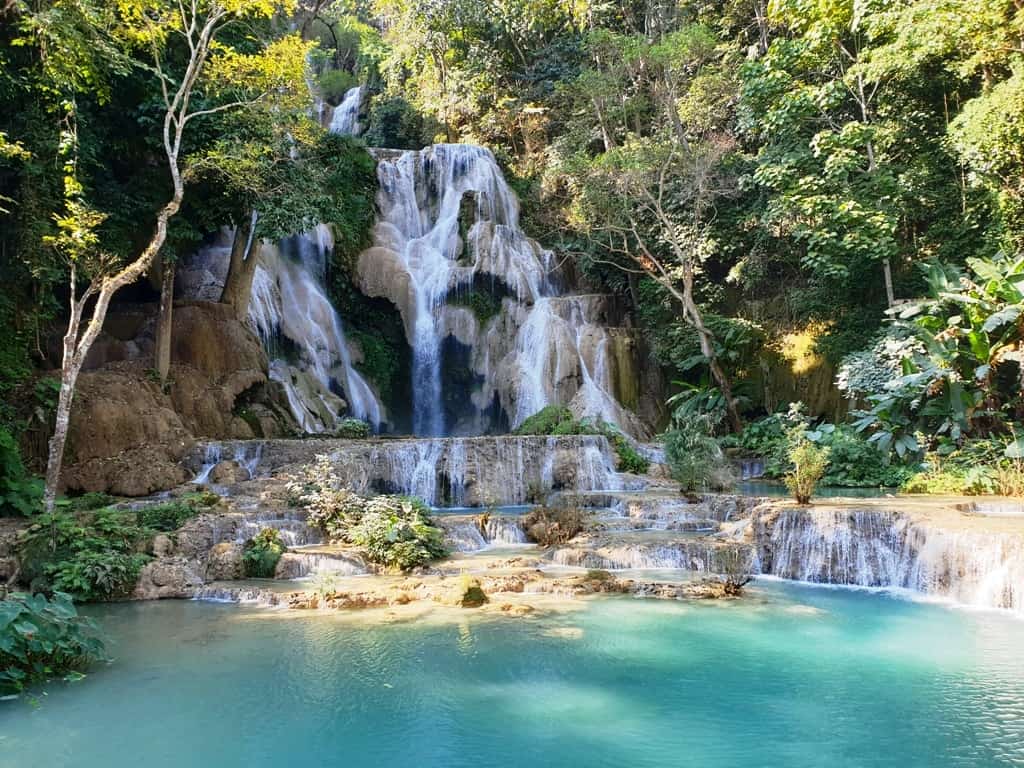
Spending time in Luang Prabang, Laos, and would love to make the most out of every moment? There are so many great things to see and do in Luang Prabang, yet this royal capital is small and compact and you can pack plenty into a three-day itinerary. Read on to discover what to do with 3 days in Luang Prabang and get a feel for this lush, golden town.
Luang Prabang, the former royal capital of Laos and the country’s capital until 1975, has long attracted Buddhists, backpackers, and those seeking off the beaten path travels. Lacking the flashiness of Bangkok, the Eat Pray Love vibe of Ubud, or the quaint small-town charm of Hoi An , Luang Prabang rarely makes the list of must-sees in Southeast Asia.
With its French colonial architecture, vibrant markets, and exquisite temples, however, Luang Prabang definitely deserves your attention. Its unique monastic life, the shimmering golden temples, and the attractive nearby countryside all vie for your attention in this 3-day itinerary.
My 3 days in Luang Prabang guide is meant for culture lovers, active travelers, and adventure seekers. At the end of this guide, I also recommend a few centrally-located hotels at the end of this post.
You might also like: Things to do in Luang Prabang.
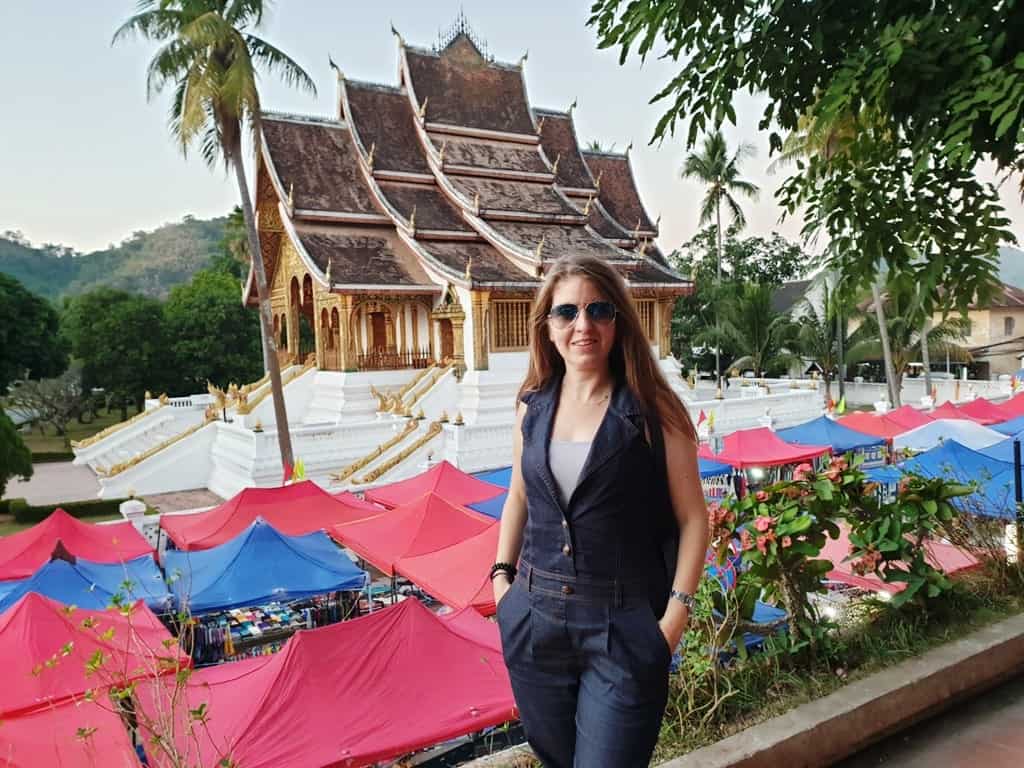
Table of Contents
The Best Time to Travel to Luang Prabang
Luckily for those of us from the land of winter versus summer, Luang Prabang is a beautiful temperature all year long. However, Laos has two seasons – wet and dry. The dry season runs from October to April, and the rainy season is from May to September.
It’s not an exact science, and Luang Prabang tends to get most of its rain overnight or in the early morning, so as long as you don’t mind the occasional downpour, you can travel to Luang Prabang at any time of year! April, May, and June offer the hottest temperatures in Luang Prabang, with daily highs usually in the 30s. For warm, sunny days, visit Luang Prabang between November and March.
Disclaimer: This post contains affiliate links. This means that should you click on certain links, and then subsequently purchase a product, I will receive a small commission.
A Comprehensive 3 Day Luang Prabang Itinerary
3 days in luang prabang: day one, kuang si waterfalls.
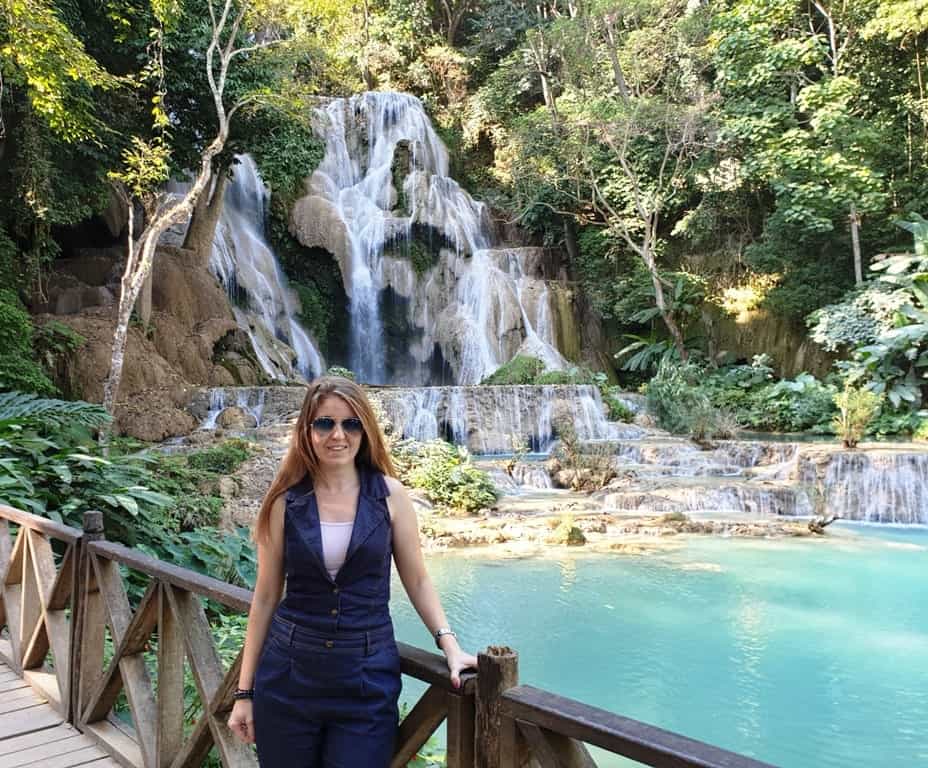
Begin your day at one of the region’s most popular attractions. The Kuang Si, or Kuang Xi, the waterfall is located about 29 kilometers south of Luang Prabang. The tiered waterfalls are a favorite with travelers and tend to be crowded on hot sunny days.

Locals charge admission to the falls, which are well-maintained with a walking bridge and a trail to the top of the waterfall where the falls begin, which begins to the left of the falls. The water tumbles into a series of turquoise pools, almost all of which are open for swimming. It’s the perfect place to relax. Because the falls tend to be crowded, they’re a great place to either start or end your day.
Royal Palace Museum
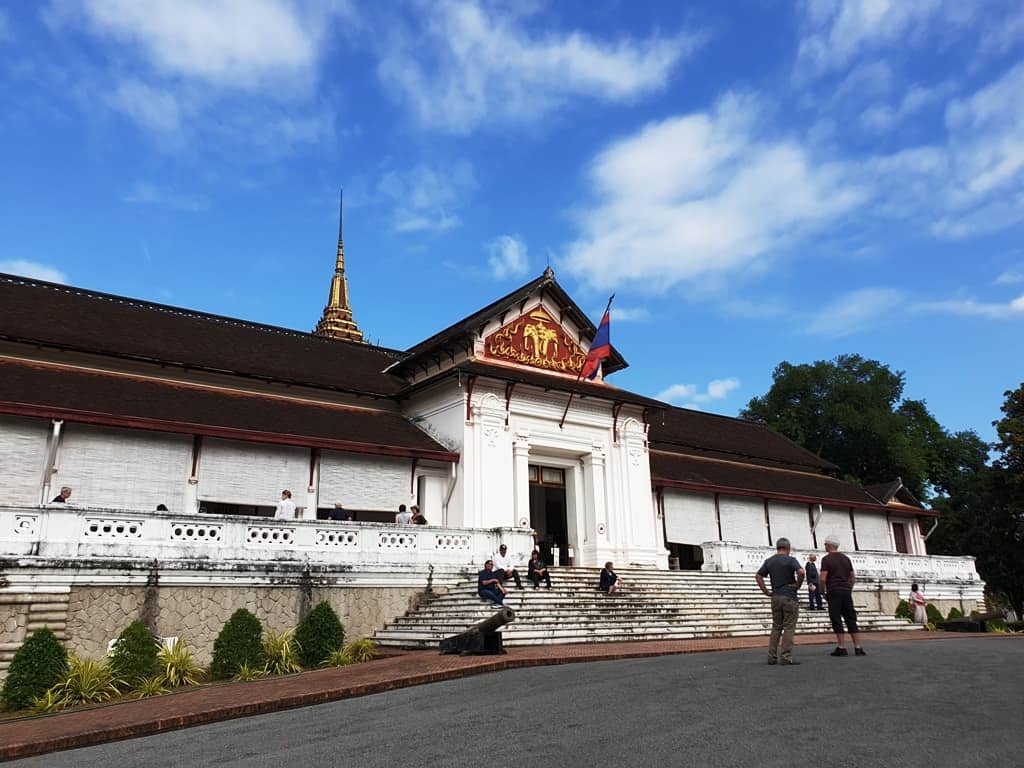
The famed Royal Palace Museum in Luang Prabang is home to the Prabang Buddha, for which the city is named. This tiny golden statue was gifted to the warrior Fa Ngum on the occasion of his marriage to a Khmer princess in the 14th century and has gone back and forth between Laos and Thailand in a series of disputes. Since 2013, it has lived at the French-colonial Royal Palace in Luang Prabang. The living quarters interior of the 20th-century palace (it was built in 1904-1909!) is quite spartan, though the throne room is elaborately decorated with jewels.
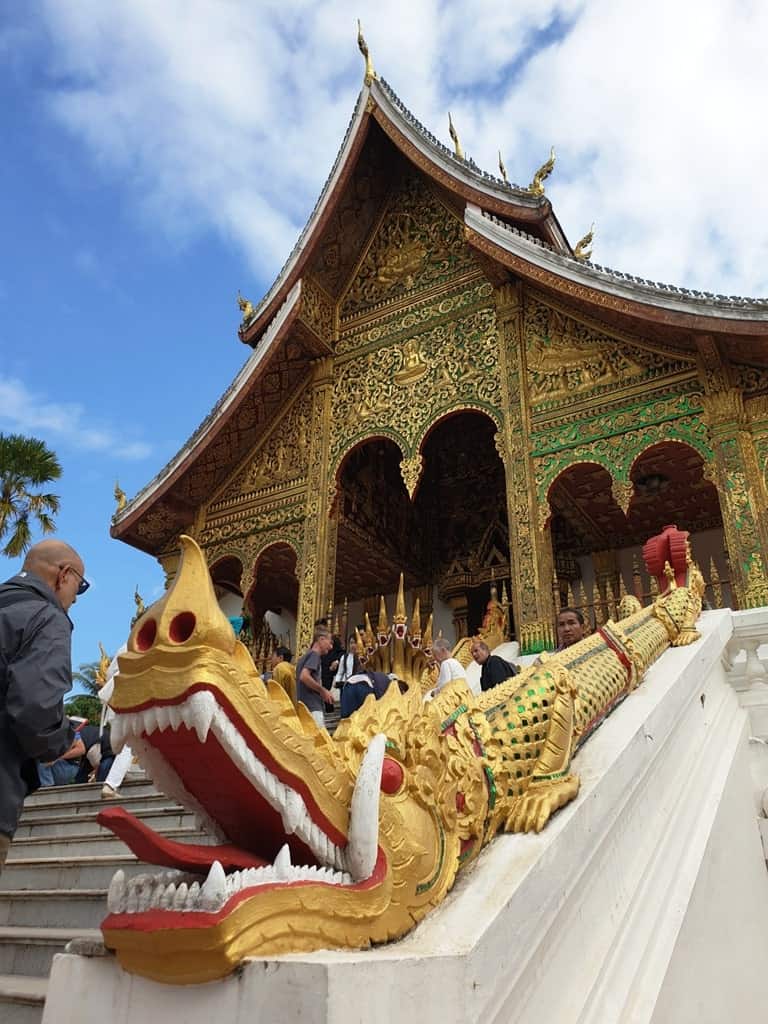
Photos are not allowed inside the museum.
Wat Mai Suwannaphumaham
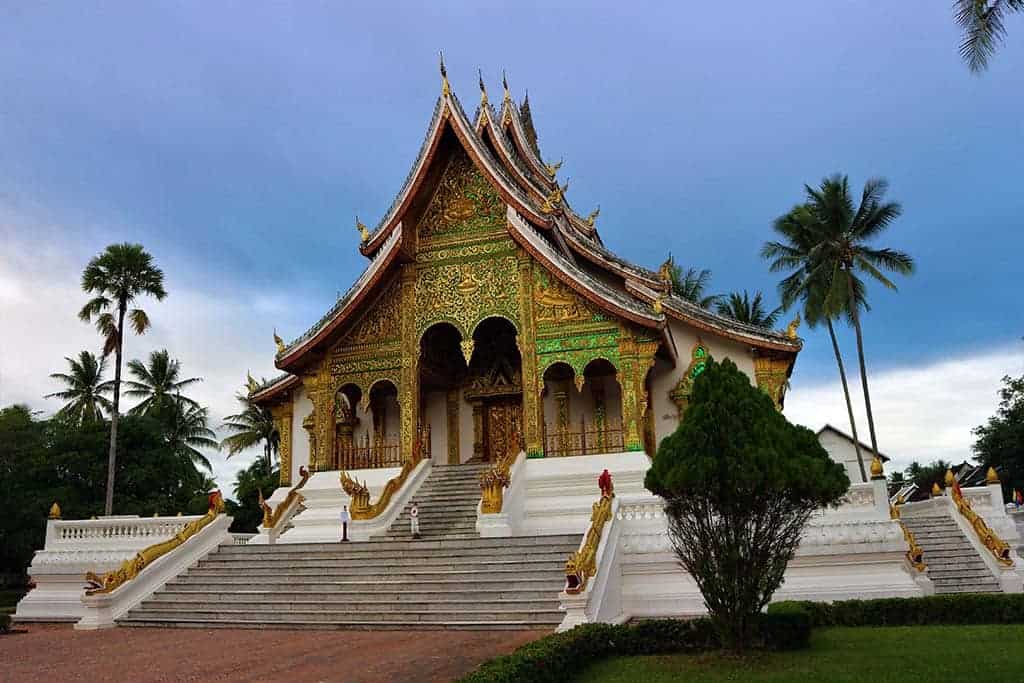
Nearby 18th century Wat Mai Suwannaphumaham (often just called Wat Mai) is the largest and most richly decorated of the Luang Prabang Buddhist temples. It’s well known for the emerald Buddha that sits inside. The complex five-tiered roof adds to its beauty. This exquisite temple is a must-see.
Wat Xieng Thong Temple
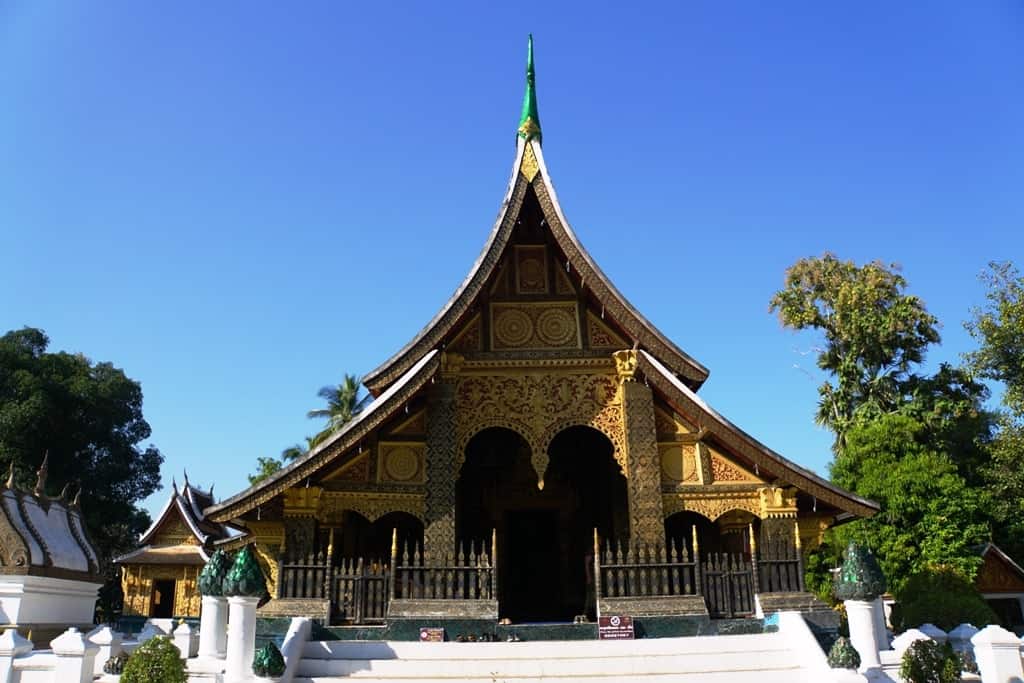
Further along the road, you’ll come to Wat Xieng Thong Temple, a 16th-century temple that is beautifully maintained and restored to protect its history and heritage. Its name roughly translates to Temple of The Golden City, and its gilded interior certainly lives up to that name. Its sloping roof, made from three levels, is impressive, as is the Tree of Life mosaic and the funeral chariot of King Sisavang Vong.
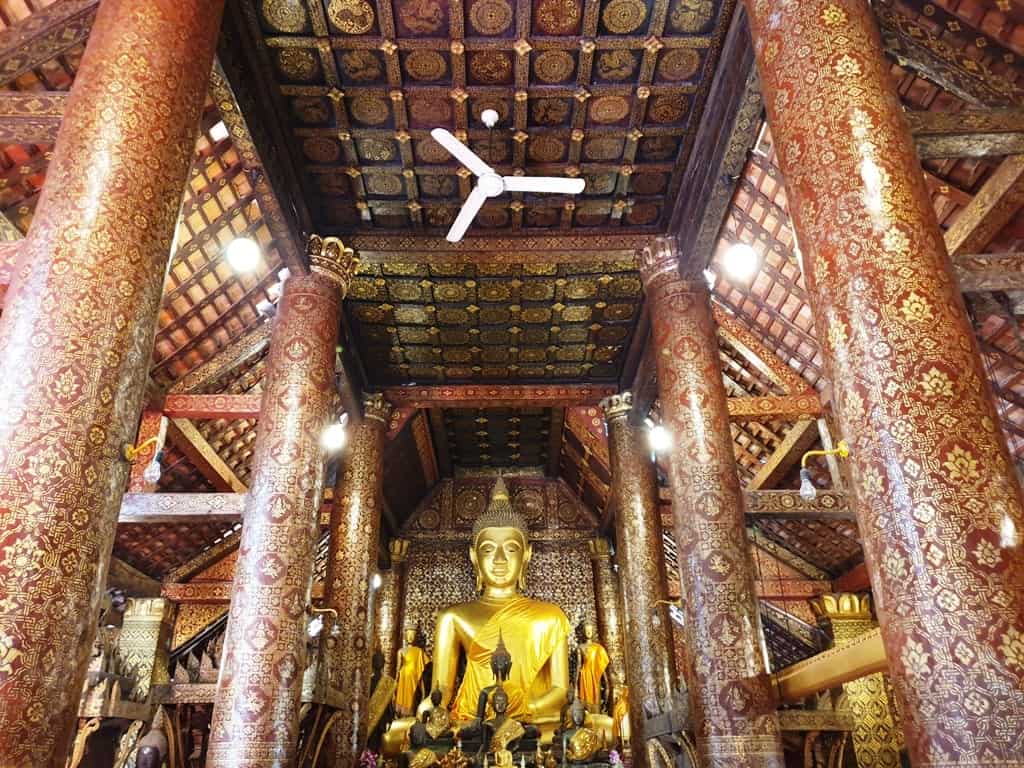
Wat Sen Souk Haram
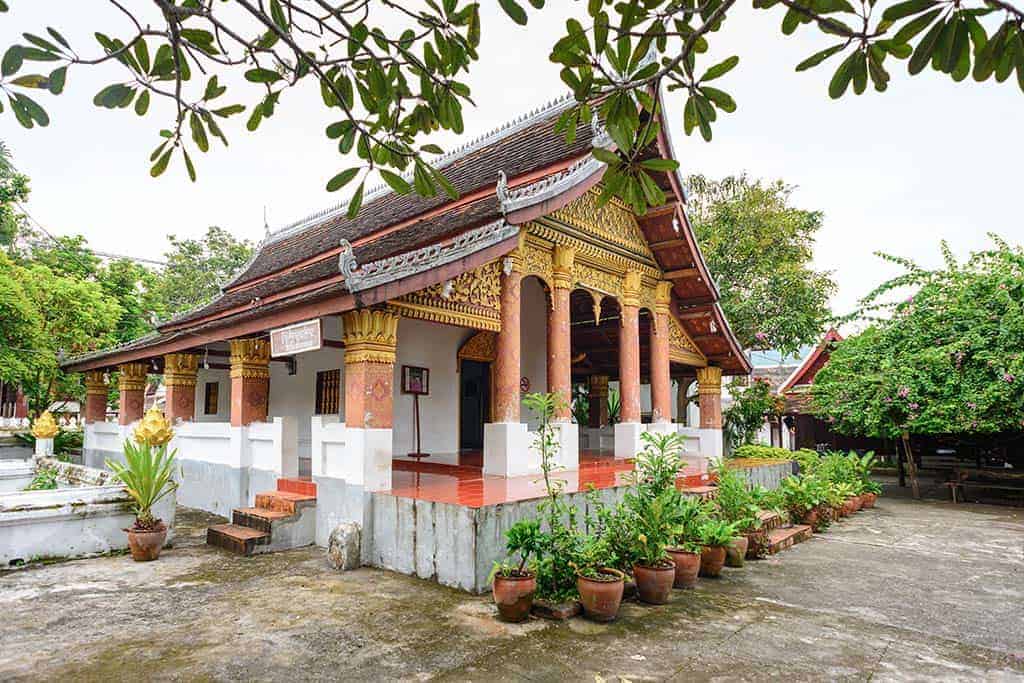
Wat Sen Souk Haram, which literally means Temple of One Hundred Thousand Treasures, is yet another must-see temple in Luang Prabang. Its intricate facades and red roofs are among its well-known features, while legend says it was built from 100,000 stones from the Mekong River.
3 Days in Luang Prabang: Day Two
Alms-giving ceremony.
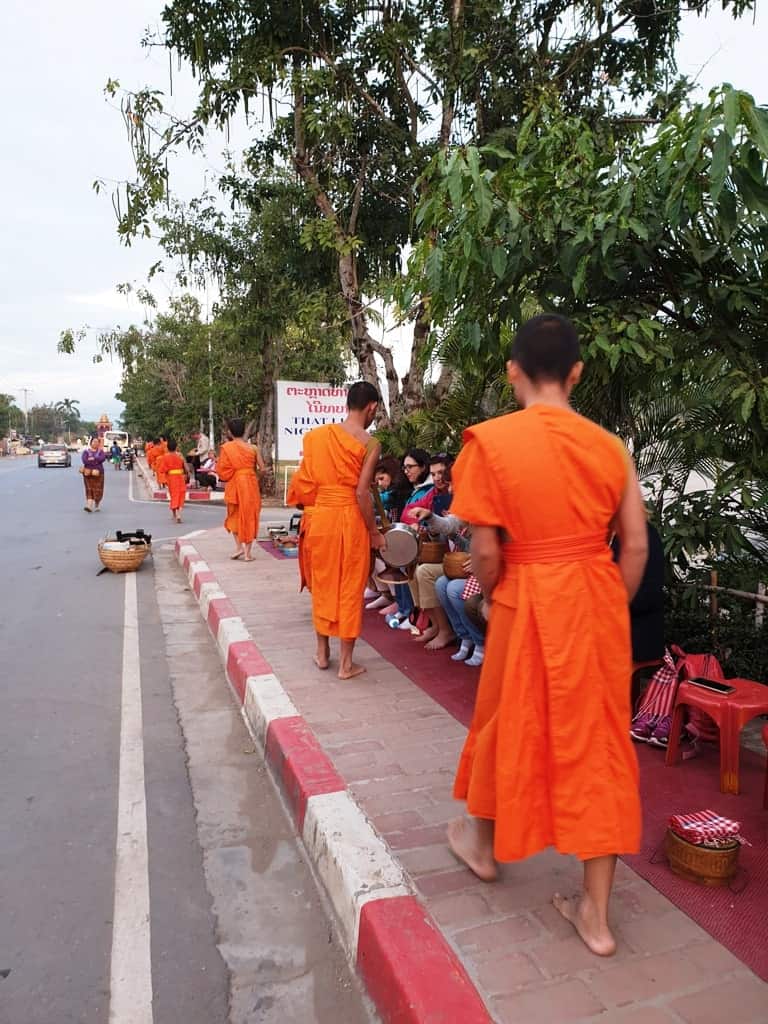
Wake up early to participate or watch one of Luang Prabang’s most unique experiences, the alms-giving ceremony. Each morning, the young monks take to the streets of the old city to receive their alms, often in the form of rice which makes up their daily meal. There’s no reason why you can’t participate in this tradition, though there are strict rules regarding participation and photography so best to ask your host or hotel for instructions.
Visit the Morning Markets
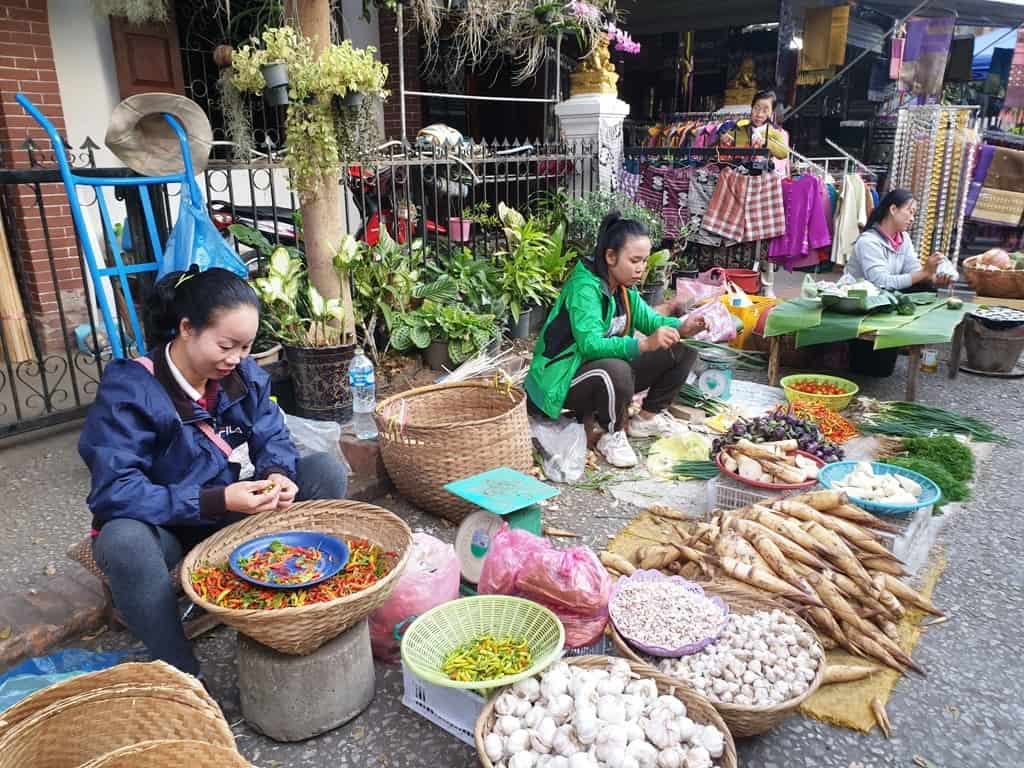
Luang Prabang’s morning markets are a fascinating glimpse into an Asian morning market, which offers more than your usual fruit and veg on display. You can find everything from fish to grilled insects alongside the typical market fare. The market takes place along the streets near the Royal Palace, and usually concludes by mid-morning so be sure to go early for the best experience.
Pak Ou Caves
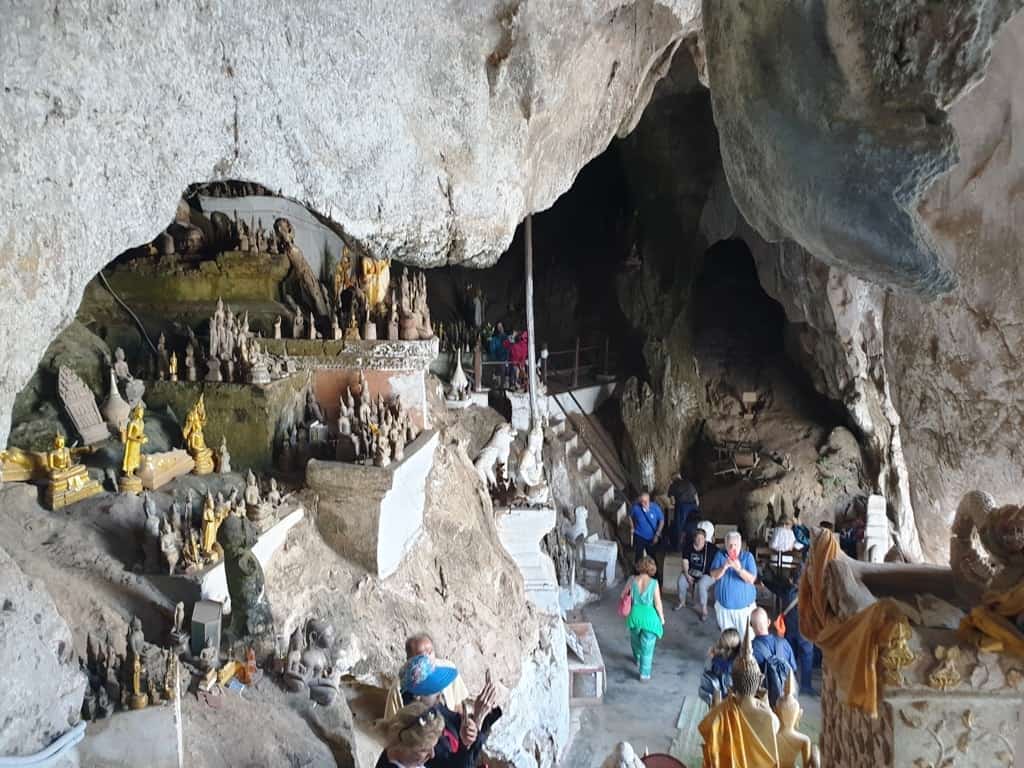
Jump on board a ferry boat for the short ride to one of Luang Prabang’s most unique experiences, the Pak Ou Caves. Located 25km north of the city, in cliff-caves overlooking the Mekong River, are two caves that are home to a multitude of Buddha statues.
Thousands of imperfect Buddhas line the caves’ interiors, all imperfect in their own ways – chipped, aged, missing hands or noses, tilted to one side – but all keeping watch over the Mekong and those who come to pray at their feet.
Each Buddha represents something different: meditation, education, or nirvana. Most boats go home via the Lao Lao rice whiskey distillery in Ban Xang Hai, where you can partake in a tasting of this potent homebrew.
Book a day trip to Pak Ou Caves, Whisky Village & Kuang Si Falls
3 Days in Luang Prabang: Day Three
Mekong cruise.
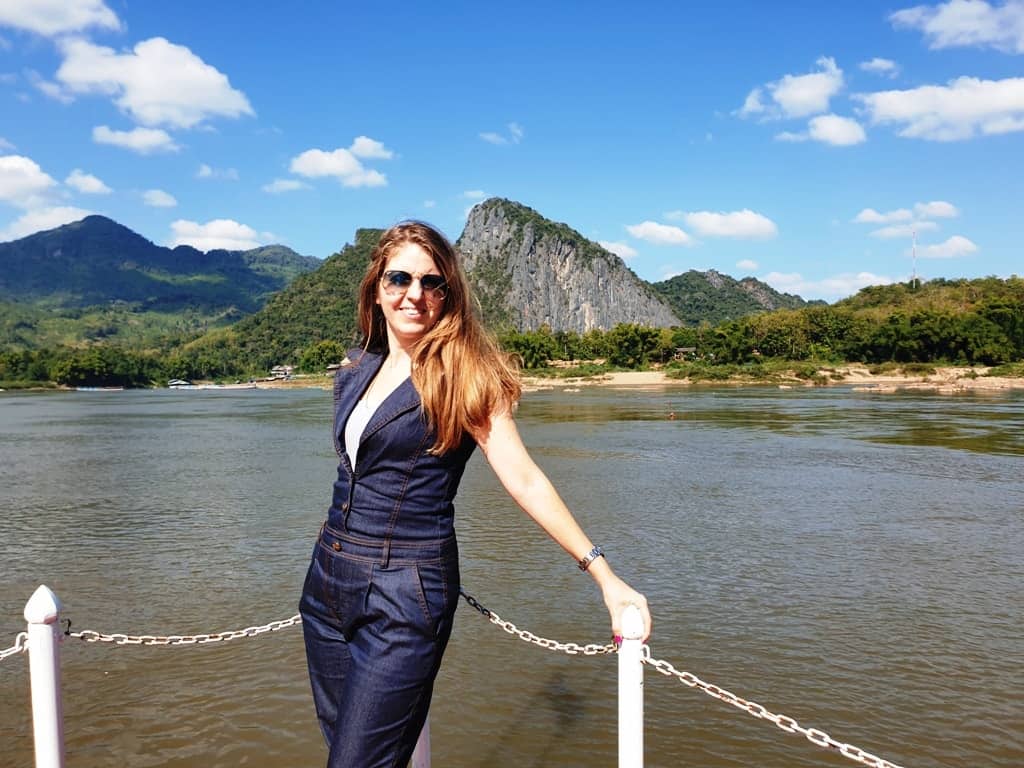
One of the highlights of any Southeast Asian trip is a cruise along the Mekong River. Luang Prabang is located at the confluence of the Mekong and Kahn rivers, making it an important trade and strategic military location as well as the royal capital.
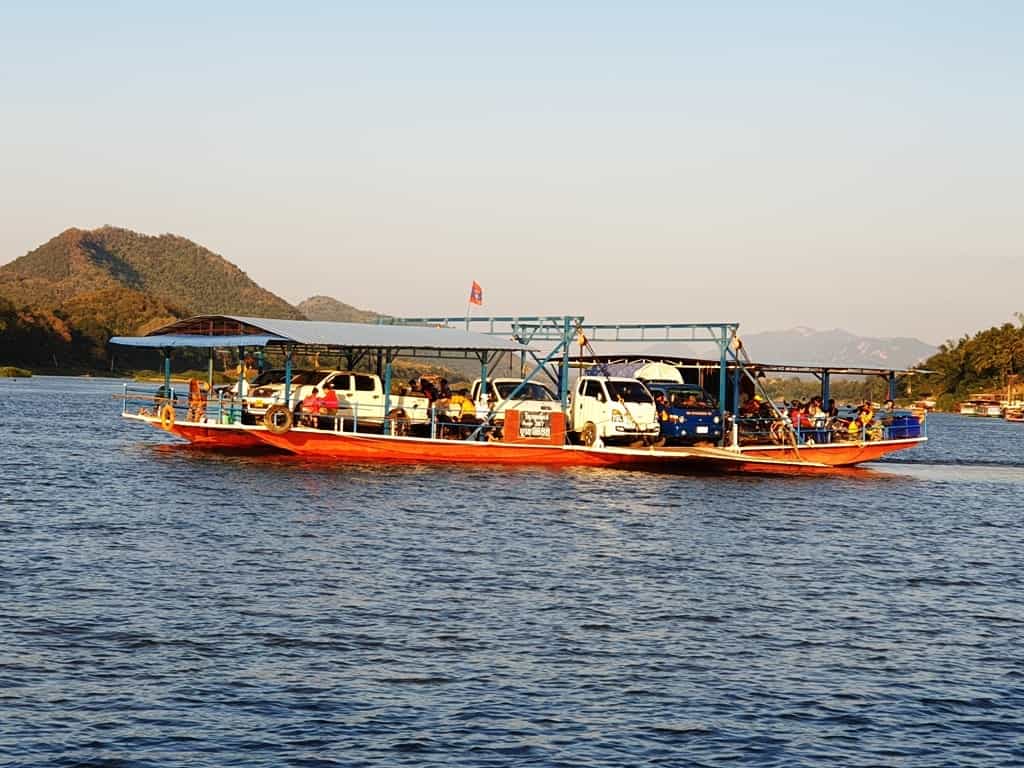
A cruise along the Mekong River will introduce you to some of the rural communities of Laos and give you a chance to see some of the countryside. It can be a multi-day excursion through Thailand, Cambodia, Vietnam, and Laos, or it can be a day trip during your stay in Luang Prabang.
Sunset from Mount Phousi
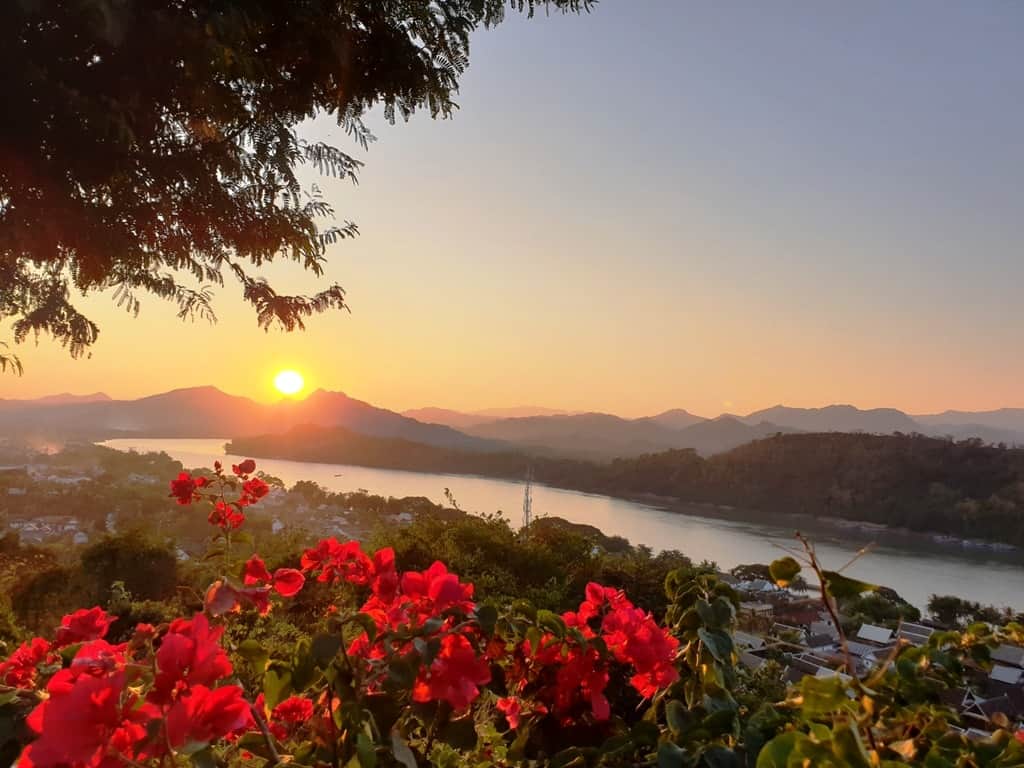
Located in the heart of the old city, Mount Phousi is more a hill than a mountain. Each evening, hundreds of people head up the hill across from the Royal Palace in order to watch the sky turn from day to dusk. This is a great place to get an idea of the size and scenery of Luang Prabang so I highly recommend doing this on your first evening. Give yourself enough time to make the climb at a leisurely pace, perhaps stopping off at Wat Tham Phou Si, a Buddist temple on the way up.
Night Market
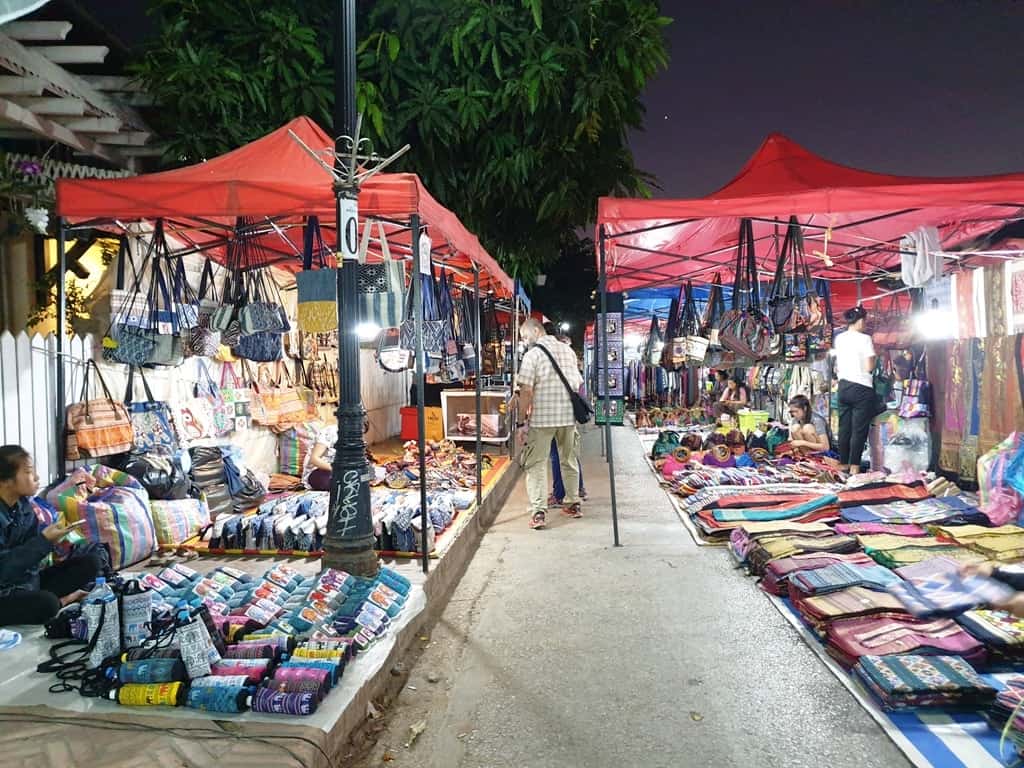
What started as a Christmas market in 2002 hasn’t stopped, and is now the famous Luang Prabang Night Market. It opens at 5 pm and is a great place to purchase local handmade crafts like artwork, scarves, and more. It’s expanded quite a bit since its inception, so you’ll also find wood carvings, prayer mats, and souvenirs. And if you’re hungry, have no worries. Stop by one of the many food vendors for a cheap, delicious meal. Known as the Caterer’s Evening Market, it features favorites like noodle souple, spring rolls, barbecued meats, and more. It is the perfect stop during your market explorations.
Where to Stay In Luang Prabang, Laos
There are plenty of accommodation choices in Luang Prabang, from budget backpackers and guesthouses to stunning five-star retreats and luxury hotels and spas. I was lucky enough to stay at the secluded Villa Santi Hotel and Resort, a five-star boutique resort with hotel rooms and suites alongside bungalows in a verdant tropical landscape.
Villa Santi Resort
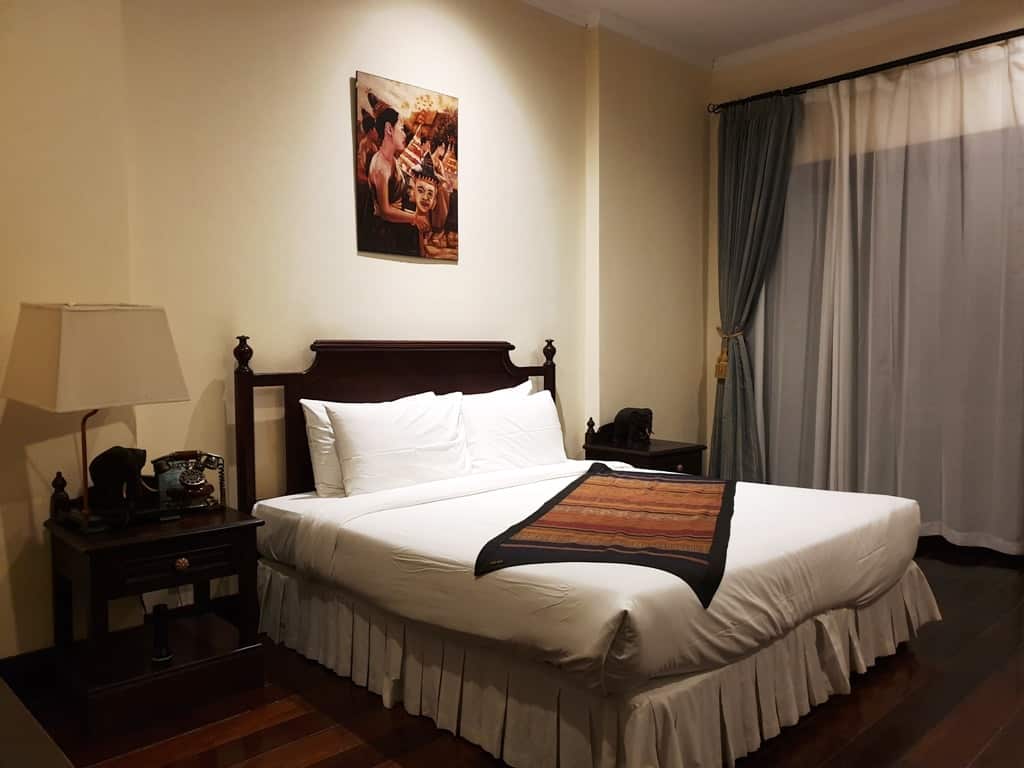
The Villa Santi resort is the more luxurious of the two properties. Rooms are spacious and comfortables, with large, sumptuous beds, deep soaking tubs, and expansive views. The suites and villas offer private balconies, separate lounge areas, and more.
Guests can unwind in the wellness area, which offers a variety of treatments designed to rejuvenate and relax your mind and spirit. The swimming pool has a swim-up bar, perfect for those lazy afternoons after a day of exploring. Villa Santi also offers an on-site restaurant and bar.
Click here for more information and to book your stay.
Villa Santi Hotel
The Villa Santi Hotel is located in a 20th-century royal mansion in the center of the city. All rooms and suites offer comfortable beds and spacious surroundings. Suits also offer separate living space and a dining area for more privacy and comfort.
Guests can dine in the on-site Princess restaurant or enjoy drinks in the lobby bar. The hotel features a plunge pool in the garden as well.
Luang Prabang is a fascinating city. Its rich history and heritage that span the Khmer Empire to the French colonial era and into modern-day have made it a unique and interesting city to explore. My 3 day Luang Prabang itinerary has given you plenty of places to spend your time in this north Laotian city, and I hope you’ll take the time to explore it.
You might also like: A 10 day Vietnam itinerary. 2 days in Ho Chi Minh City 4 days in Hanoi 2 days in Siem Reap 2 days in Phnom Penh 5 days in Cambodia
Sharing is caring!
2 thoughts on “3 Days in Luang Prabang, a Great Luang Prabang Itinerary”
Thanks for posting about Luang Prabang, I also planning to visit the same and just googling about it for some tips and information. Thanks for sharing!! Kudos!!
- Pingback: The Best Budget Destinations for a Cheap Vacation - Tales of a Backpacker
Leave a Comment Cancel reply
Save my name, email, and website in this browser for the next time I comment.
- Customized Tour
Things to do in Luang Prabang
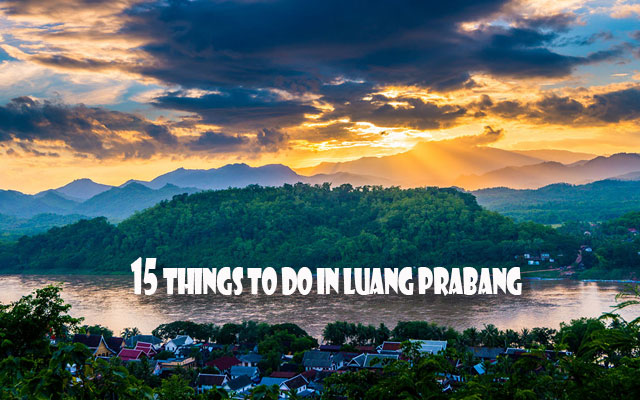
Luang Prabang is the most well – known destination in Laos . It is an ancient town filled with Buddhist temples, vibrant nightlife and stunning nature. As the country’s first UNESCO World Heritage Site, the town itself offers more than what you can imagine. Please find out the awesome things to do in Luang Prabang in this article.
Explore ancient town
Witness alms giving ceremony in early morning, climb phousi mountain for sunset, join cooking class, interact with elephant, take a boat trip to pak ou cave, swimming at khuang si waterfall, visit night markets, kayaking on rivers, learn how to cultivate rice, cycling around luang prabang, walk across the bamboo bridge, learn how to weave at ock pop tok, take part in an orange rope tour..
Luang Prabang town is a mix of distinctly Laos, French and Chinese architecture. Just simply take a stroll around town to enjoy its charm and discover Laos culture. The first thing you should do is hitting a temple . There are over 30 temples of note within walking distance around the city centre, plus many smaller shrines. Two of the most significant temples to visit are: Wat Xieng Thong & Wat Winsunala.
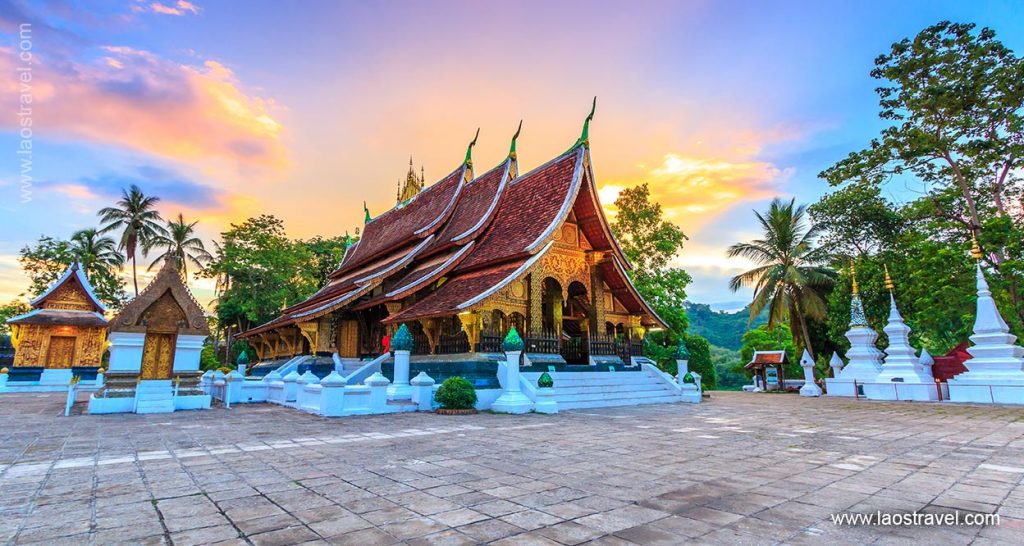
The town also offers multiple attractions: Royal Palace where learn about the country’s rich history, the Traditional Arts and Ethnology Centre Learn which presents the country’s complex ethnic groups and their enduring traditions, or Garavek Theatre where you can listen to traditional music and folk tales. Finally, the walking trip could end by a cup of coffee in one of lovely cafes in town.
Entrance fees: you’ll be required to pay an entrance fee at some key sites Wat Xiengthong: 20,000kip (2,5 USD) Wat Winsunala: 20,000 Kip (2,5 USD) Royal Palace: 30,000 Kip (3.8 USD) Traditional Arts and Ethnology Centre: 20,000 Kip (2,5 USD)
The Alms Giving is one of the most significant activities in Laos’ culture. Each day, the monks in bright orange robes walk barefoot to collect daily offerings from the locals. They start their walk before dawn and walk in single file throughout the city.
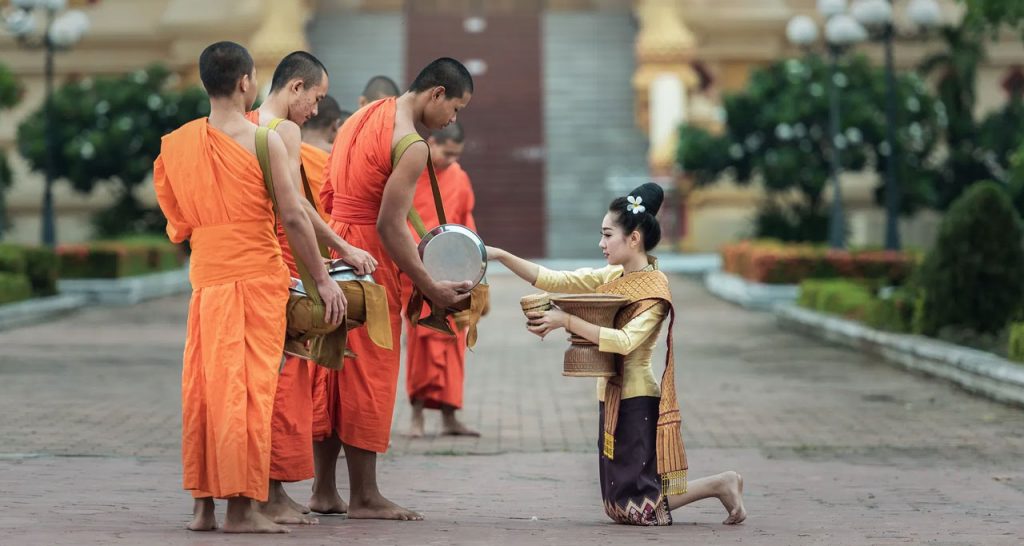
However, this traditional Buddhist ritual has in recent years succumbed to crowds of tourists hungry for a photo opportunity. So, if you do choose to attend, please follow the government’s guideline
- – Don’t use flash lights and don’t get in the way of monks’ procession
- – Keep distance at least 3 meters away from monks when taking a photo
- – Dress appropriately: shoulders, chests and legs should be covered.
Located at 100 meters above the old town, right on the confluence of the Mekong and Nam Khan rivers, the hill offers up 360-degree views of the town. This explains a reason why it becomes very popular spot to watch sunset. Due to this, it will be very crowded before the sun goes down, so be sure to come early to get nice position. Besides, to reach the top, you need to climb over 300 stairs that requires quite lots of effort. You should consider your health condition.
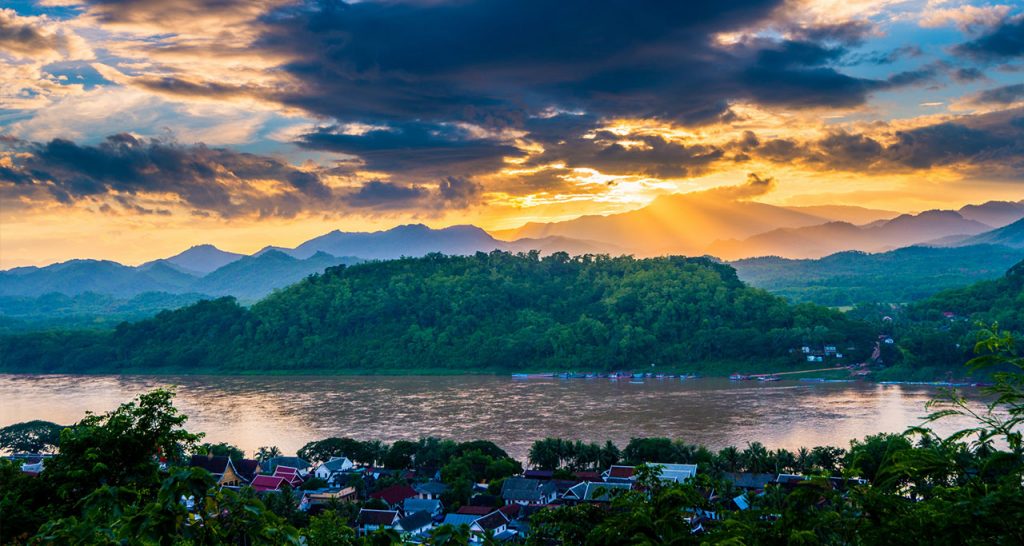
Opening hours: 5.30AM – 6.00PM Entrance fees: 20,000 kip (2.5 USD)
Although Laos cuisine is overshadowed by its neighbor countries such as Thailand, it is still packed full of flavor and ideal for sharing. A cooking class is the best way to understand which ingredients Laos people use and how they take simple ingredients to create multiple dishes filled with flavor.
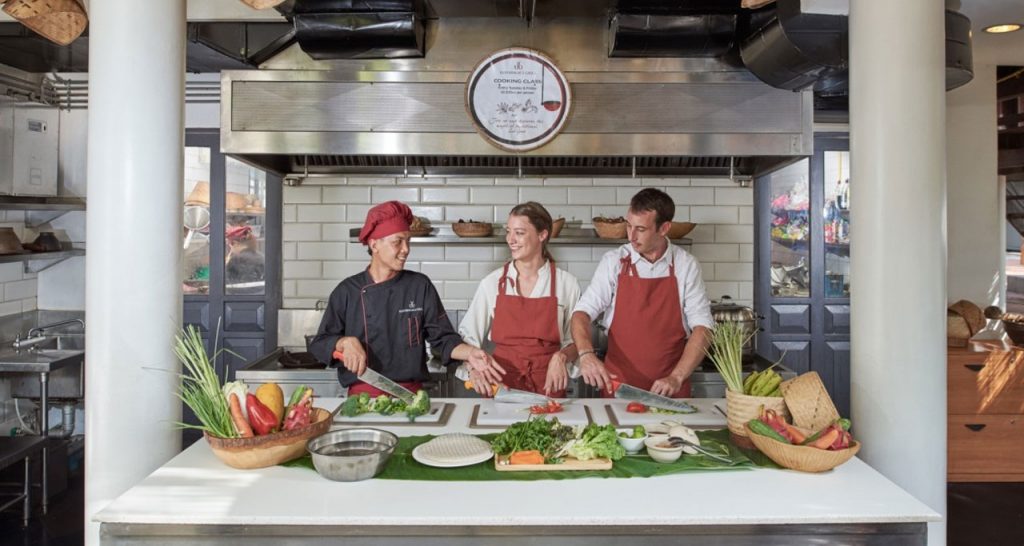
There are many courses to choose from, but the best cooking class in the area is at Tamarind restaurant. Here visitors can sample and recreate various traditional dishes with sticky rice which are made with ingredients sourced at local markets and grown in the surrounding hillsides.
Opening hours: 11:00AM – 10.00PM Monday to Saturday Cost Day time class (8.30AM – 2.00PM): 290,000 kip (33 USD) including market tour. Evening class (4.00PM – 8.30PM): 220,000 kip (25 USD) without a market tour
Interacting with elephants in an ethical manner is one of the top things to do in Luang Prabang. Mandalao Elephant Conservation offers the different experience to visiting a typical elephant camp in Laos or Thailand. Opened its doors in 2016, it is a sanctuary for elephants rescued from the logging industry and riding camps. There are no elephant rides , circus tricks or elephant dances. Visitors will trek through the jungle together with elephants naturally.
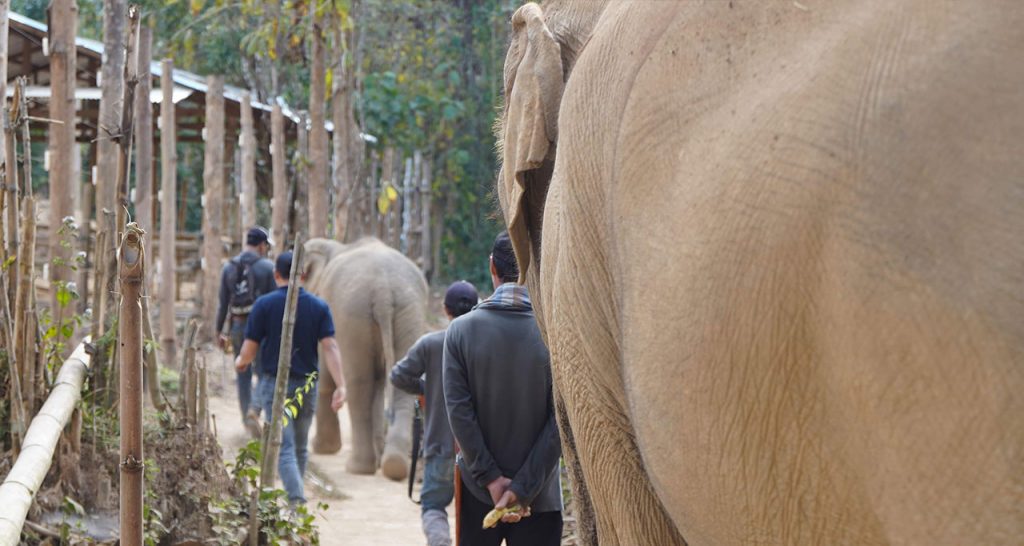
The 500-acre property is located about 30 minutes away from the town. Mandalao operates half-day and full-day tours for tourists to interact responsibly with the resident elephants. Return transfer and lunch are provided in the tours. If you love elephants, I highly recommend adding a visit to Mandalao to your list of things to do in Luang Prabang.
Opening hours: 9.00AM – 5.00PM Cost: Half day tour: from 90 USD per person Full day tour: from 130 USD per person
Pak Ou Cave is one of highlights in any trip to Luang Prabang. Lying 25 kilometers upriver from Luang Prabang in a cliff 15 meters above water, Pak Ou Cave complex is filled with thousands of Buddha images in different styles and sizes left by pilgrims.
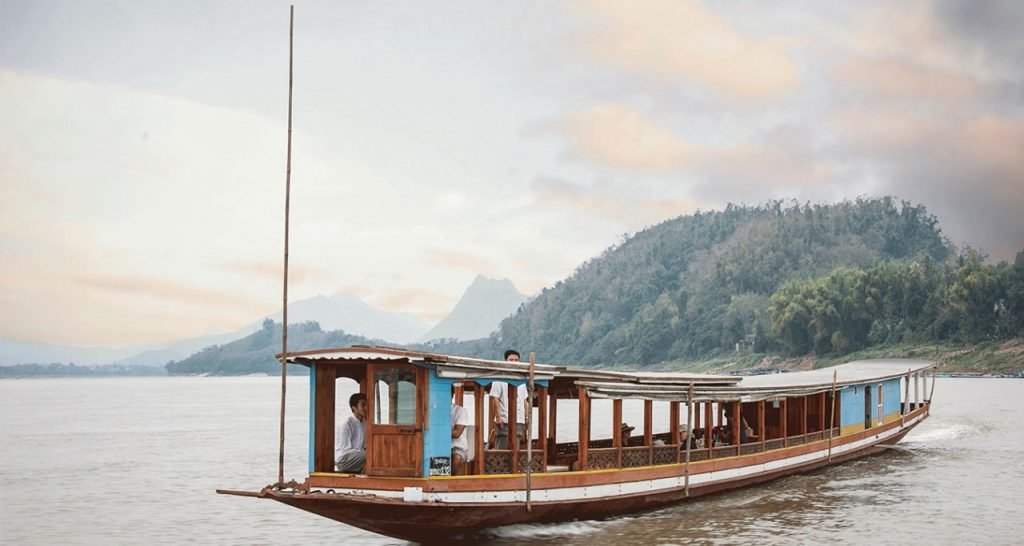
By river, the trip to Pak Ou Caves take about two hours from Luang Prabang. A cruise upstream on the Mekong River will gives you a breathtaking view of the tranquil countryside. On the way, you have a chance to visit village of Ban Xanghai, where the local make the rice wine or Khop Noi art gallery
Entrance Fee: 20,000 kip (2,5 USD) Boat trip: 50 USD (up to 25 passengers)
Khuang Si Waterfall is also one of most popular tourist attractions but it will not make you disappointed. With just one hour drive out of town, you can see the waterfall which boasts a 50-metre cascading drop into three-tiered azure swimming holes.
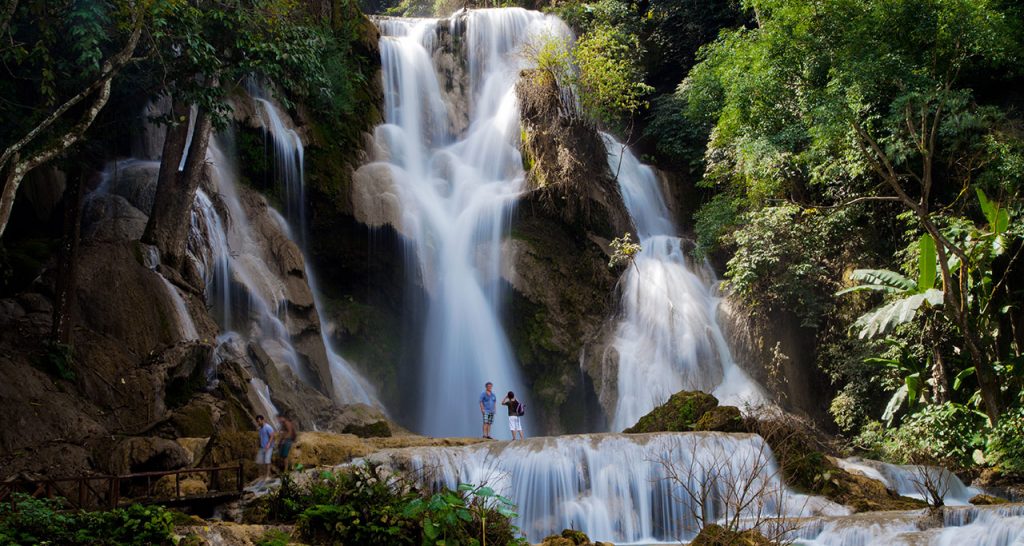
Hike to the top of the cascades for the best views, bring your swimsuit and jump into serene tiered pools of turquoise. You can bring a picnic and enjoy it with backdrop of trickling streams and vibrant jungle.
Entrance fees:20,000 kip (2,5 USD)
Night market is lively spot to discover the town after dark. The market is hectic and crowded but that makes it interesting. Located at the centre of the town, it’s filled with people from several different regions around Luang Prabang.
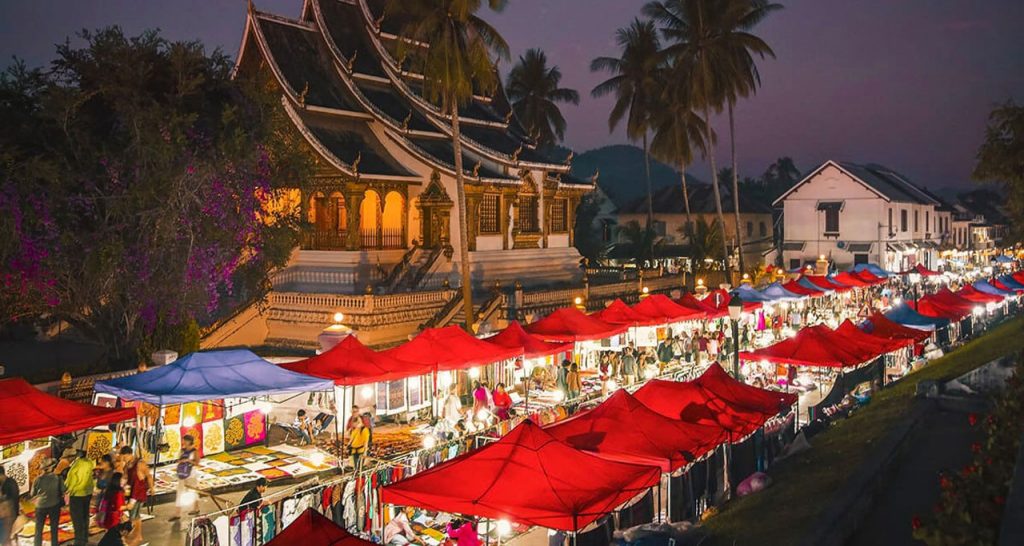
There are plenty of different items on sale depending on the season, ranging from simple wood carvings to ornate jewellery and trinkets. It is easy for you to pick up some souvenirs and practice your bargain skill. In case you don’t have any intentions of shopping, simply take photo of this amazing place.
Another thing that travelers should not is to enjoy street buffet which provides full of good authentic food.
Location: Sisavangvong Road Opening hours: 5 PM – 11 PM every night
Price: Free
Luang Prabang is one of the best towns in Laos for kayaking. You can find different travel companies who offer energetic kayaking trips from half day to two days. Some tours include trekking in their itinerary as well.
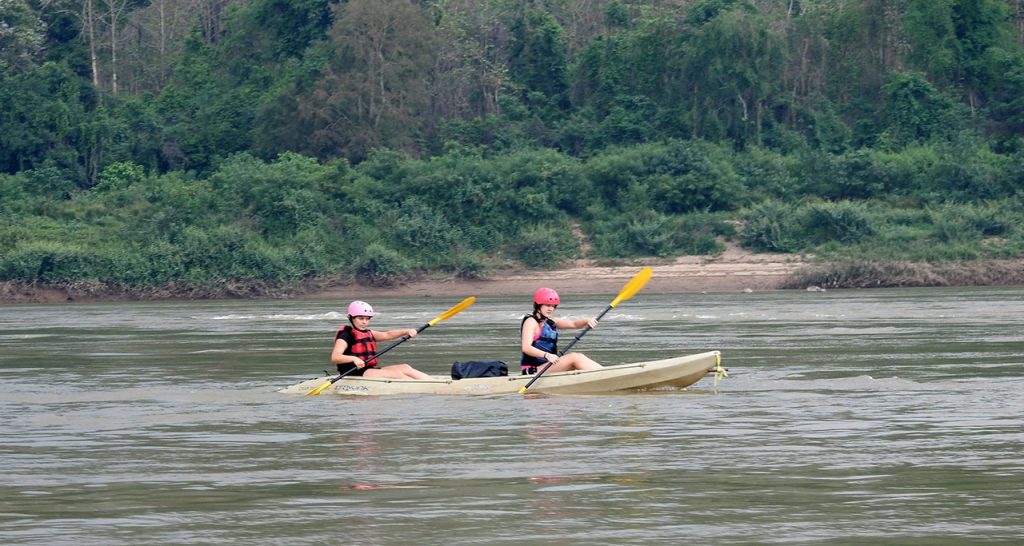
In typical tours, you will paddle on Nam Ou River in the North or Nam Khan River on the South of Luang Prabang. Tour operators will provide roundtrip transfer between Luang Prabang town and bank of rivers where you start kayaking. You will paddle through spectacular mountains covered with jungle and traditional riverside villages which are inhabited by different ethnic groups as Hmong, Khmu… Picnic lunch will be eaten at river banks.
Water conditions vary widely with the season and water levels. Generally, you can expect approximately 2-3 hours kayaking with numerous sections of rapids.
Cost: from 63 USD per person for one day trip
Trekking is also popular thing to do in Luang Prabang . Luang Prabang town is located at the heart of a mountainous region in Northern Laos, so it is good base for trekking lovers. There are variety of hiking trails to suit all fitness levels. You can choose to pass spectacular waterfalls and indigenous wildlife or gain a fascinating insight into rural folk living in hill tribe villages. Trekking trips that range from a day up to 3 days.
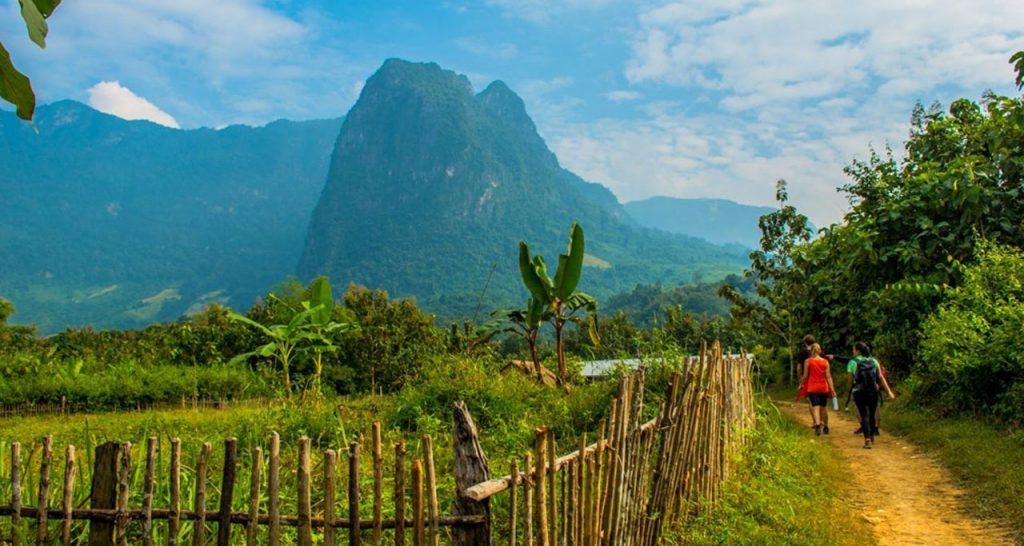
Cost: from 70 USD per person
If you want to do something different in Luang Prabang, it’s possible to become a rice farmer at the Living Land Farm. This unique activity introduces you on an in depth and hands-on learning experience where you will be able to try your hand at every single step of making rice manually.
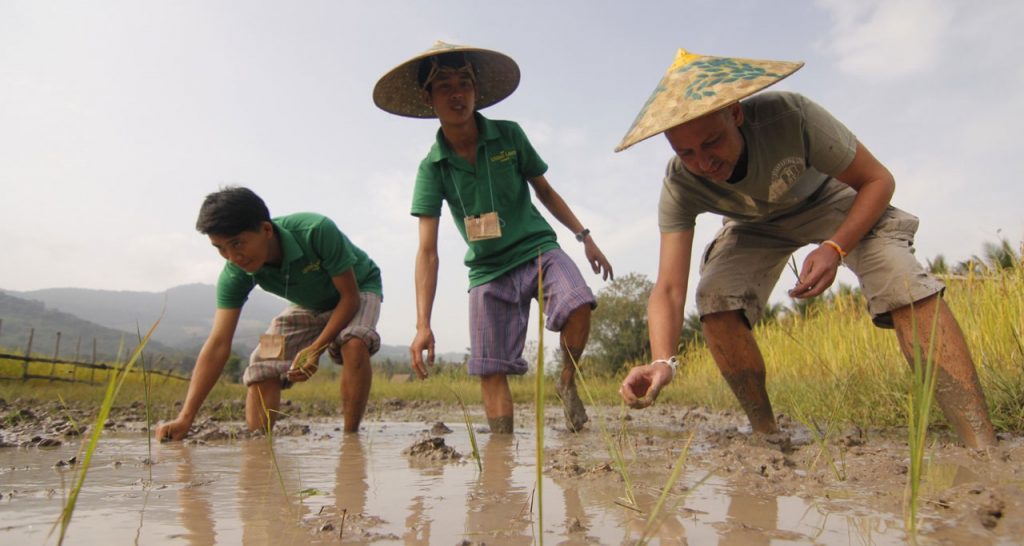
No modern machinery is used on the farm. You’ll be taught how to cultivate and grow rice in the traditional way: how to select the seeds, plant, plough with the help of the farms water buffalo and every other step until the last one… eating!
Rice is the ultimate foundation of everyday life in Asia including Laos and it is still a mystery for many visitors.
Location: Ban Phong Van, Luang Prabang Town, Luang Prabang Province. It’s about 5 km outside Luang Prabang on the road to the Kuangsi Waterfall.
Cost: 45 USD per person. If you book lunch, extra cost is 8 USD.
Cycling is a great way to experience the beautiful Luang Prabang town and surroundings. There are many day tours to choose from. You can do leisure cycling around the town to visit the city’s major attractions. Adventurous riders might enjoy a more challenging tour on a special off-road route to remote villages, exploring the rural side of Luang Prabang. Most cycling tours in Luang Prabang take at least 4 hours and include an English speaking guide, lunch and cycling equipment.
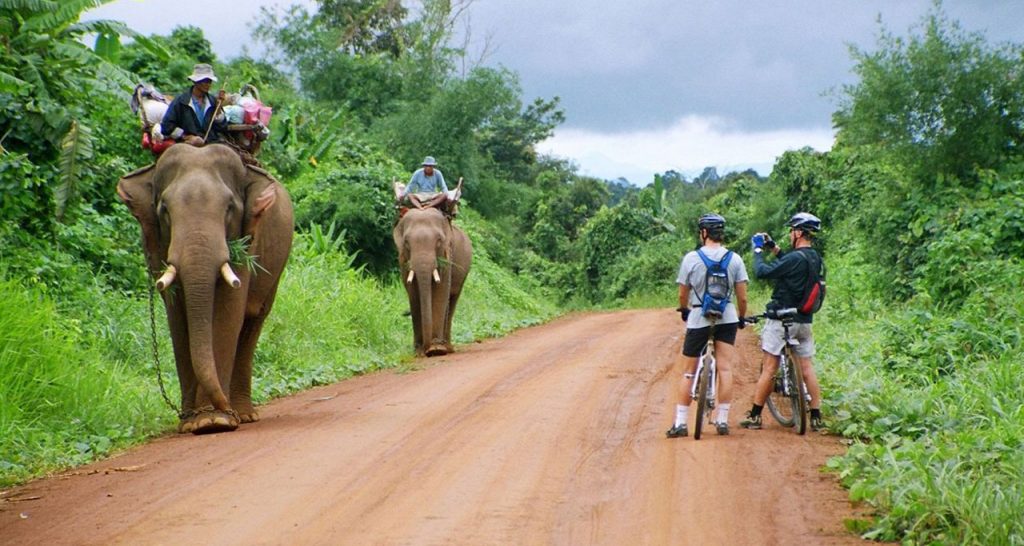
There are also options for multi-day trips, which include an overnight homestay and the opportunity to experience rural life in Laos.
Cost: from 50 USD per person for one day trip.
The bamboo bridges are one of the most iconic sites in Luang Prabang. They are built by a local family every year to make the journey from the old quarter of Luang Prabang to the main markets much easier. They are only existed for few months of the year, during the dry season from November to around March. When the rainy season comes (May to October), the bridges are removed and stored in a local forest because the high water levels will cover the bridges.
There are 2 brides: one is at the mouth of Nam Khan river and the other one is about 600m upstream, at the bottom of Mount Phosi.
Costs: 10,000 Kip (1.5 USD) to use the bridge. This money goes to the family that diligently build the bridges to maintain them
Ock Pop Tok is a social enterprise working primarily in the field of textiles, handicrafts and design. The Living Crafts Centre overlooking the Mekong is the heart of Ock Pop Tok. Set in a tropical Mekong garden, it serves as a resource centre for learning about textiles , crafts and culture. If taking a weaving class with Ock Pop Tok, you will can dye on your own and make a stylish souvenir to bring home.
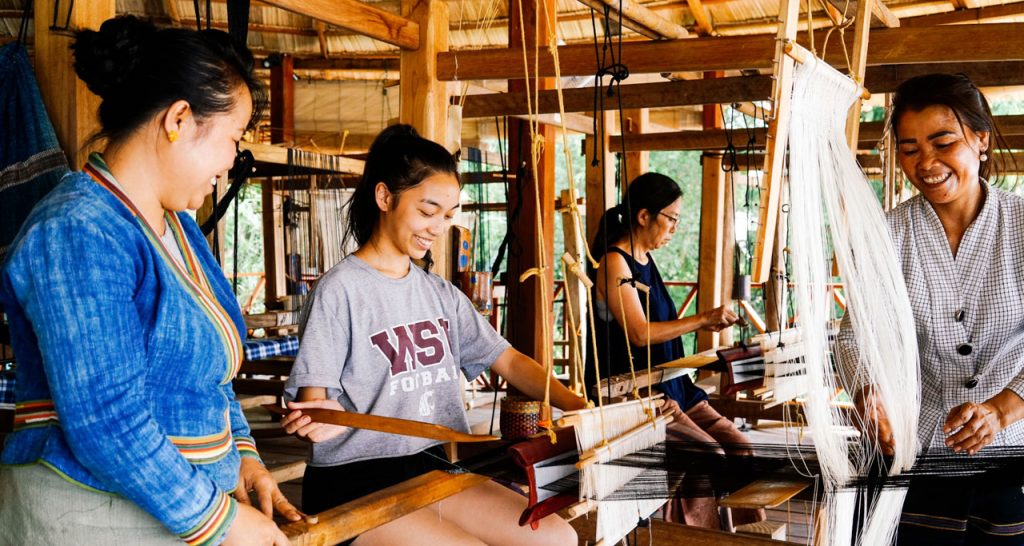
Started in 2000 as a small social enterprise selling fair trade textiles, the sustainable business practices of Ock Pop Tok are part of its success, which has helped it grow to include two cafés, a shop on the main street, and a bevvy of workshops to keep visitors busy.
Cost: from 50 USD
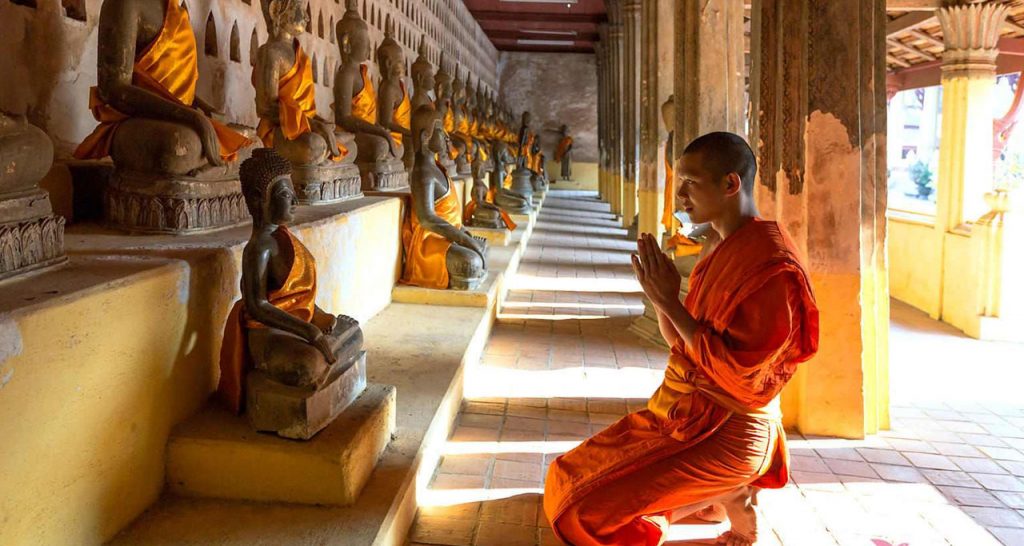
If you love Buddhism, it is nice experience you should try. You will be guided by former monks and novices who have recently left the temple. They will teach you the valuable knowledge of Buddist culture and meditation experience. Temple tours and meditation each last one hour and provide visitors with an insight into daily life in the temple.
Cost: from 20 USD per person
Related Posts
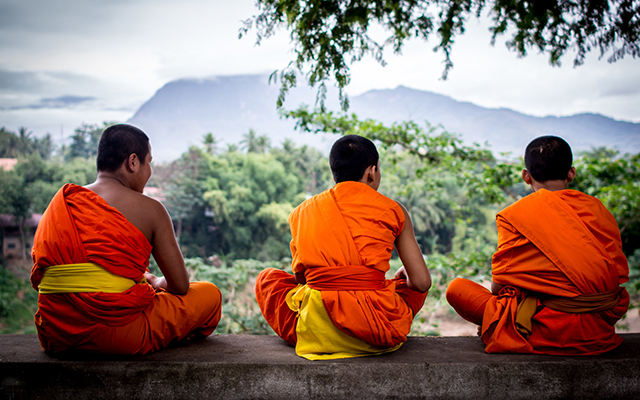
Laos Travel Guide: All things you need to know
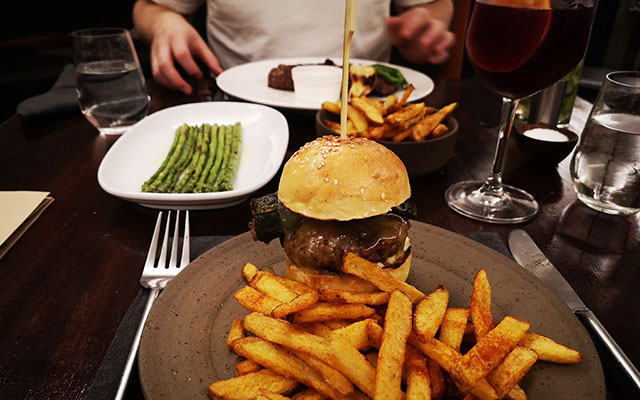
15 Top Restaurants In Vientiane, Laos
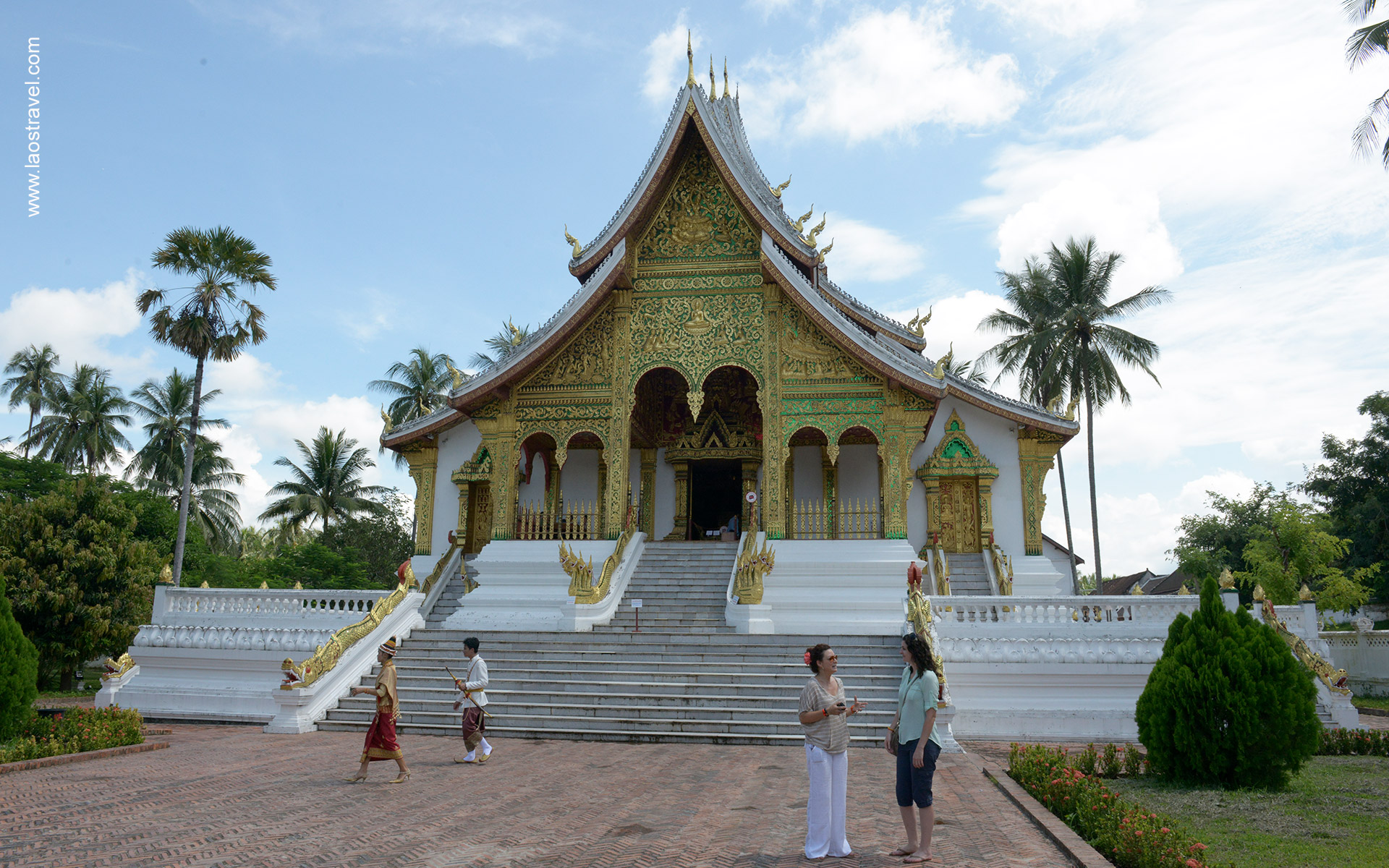
Places to visit in Luang Prabang
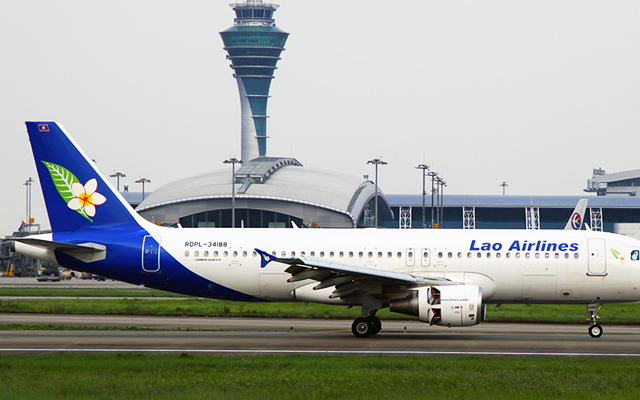
Airports in Laos
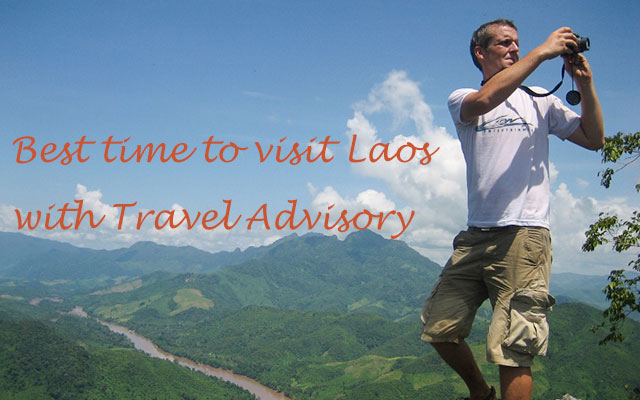
Best Time to Visit Laos
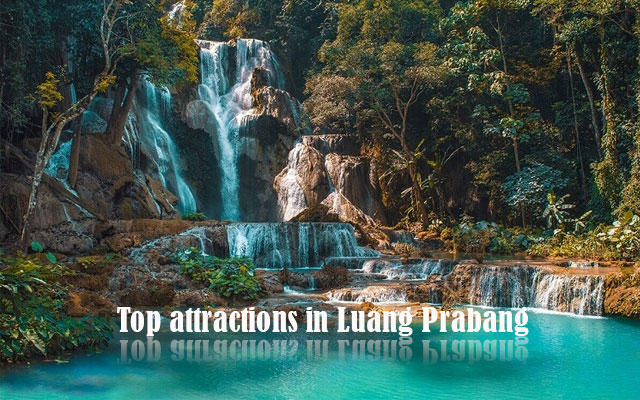
15 Top-Rated Tourist Attractions in Luang Prabang, Laos
Leave a Comment Cancel comment
Request a free quote, thank you we have received your travel request. you will receive an email shortly. please check your email and verify the information. your request will be processed after your confirmation..
You have chosen a tour duration longer than 20 days. Please specify the exact number of days you want to travel in the message box below, so that we can have enough information and make a program for you. Thank you for your cooperation.
You have selected a number of travellers greater than 20. Please let us know the exact number of people in your group in the message box below so that we can quote you accurately. Thank you for your cooperation.
You have selected a number of travellers and duration greater than 20. Please let us know the exact number of people in your group and the exact number of days in the message box below so that we can quote you accurately. Thank you for your cooperation.
Our Recommendations
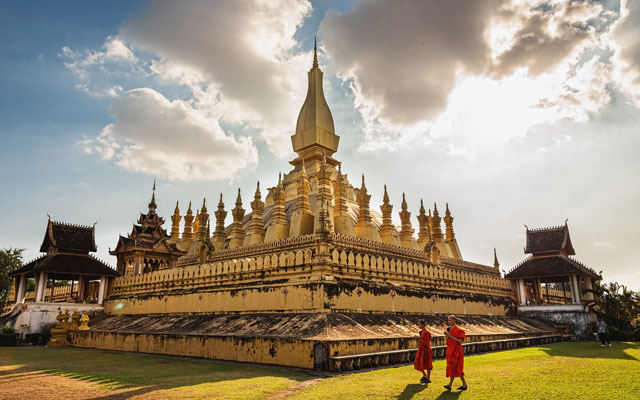
The Best Things To Do & See in Laos in 2024

5 best Laos private tours you should know
You may also like
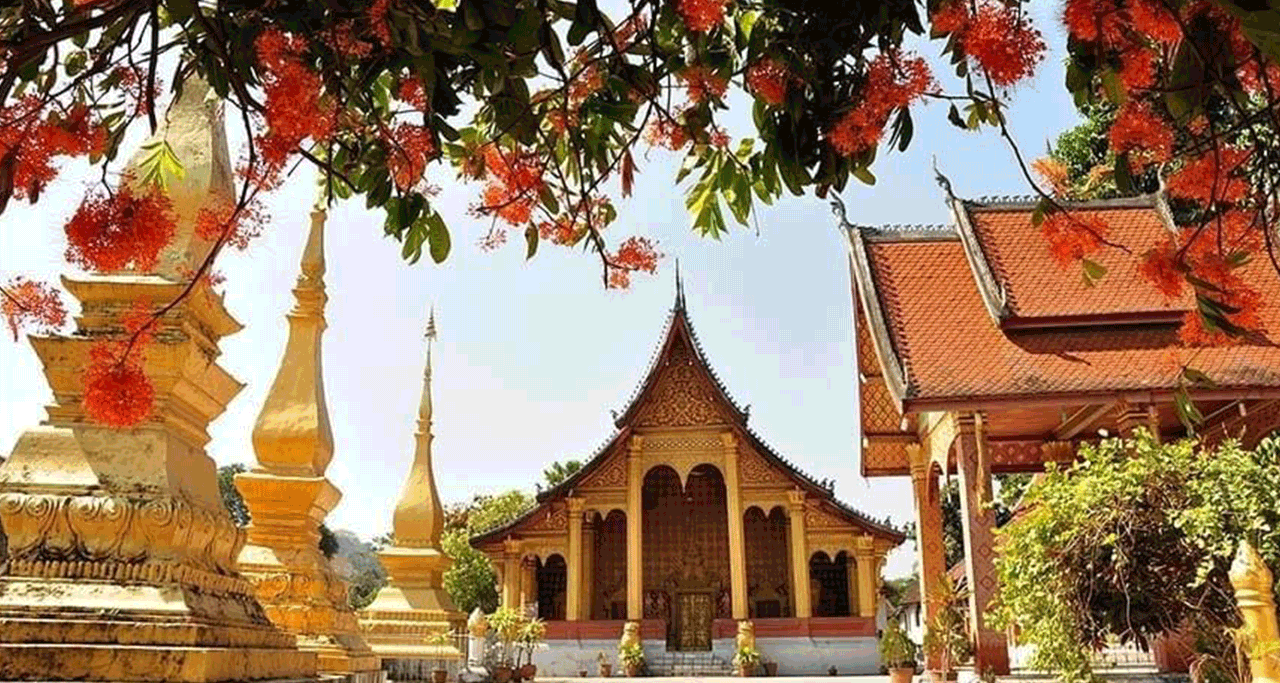
Laos Travel Guide Post-Covid
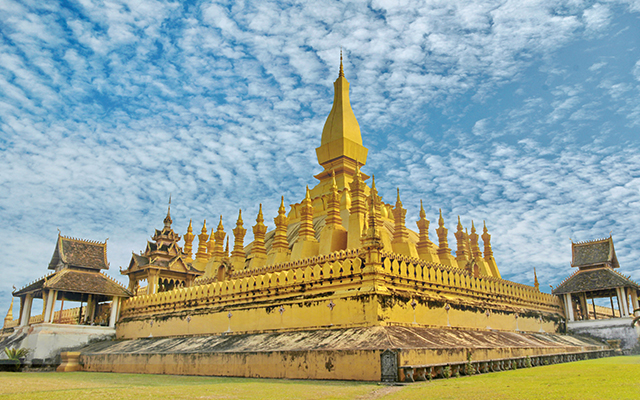
How to get from Vientiane to Luang Prabang
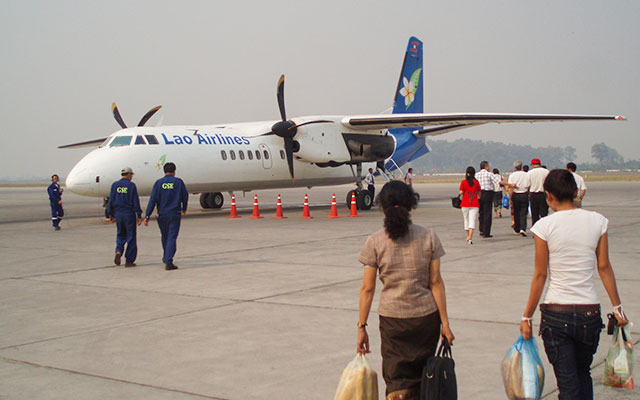
Lao Airlines
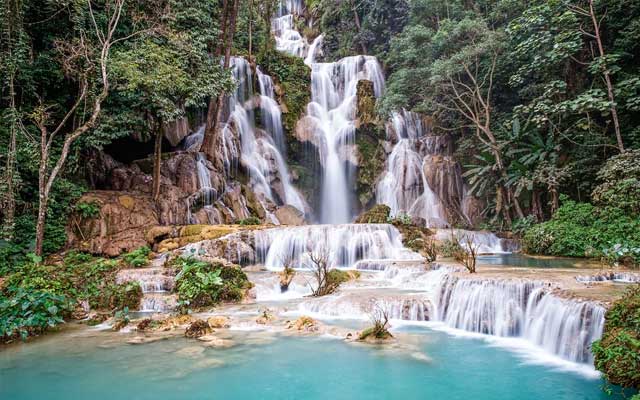
Kuang Si Waterfalls, Luang Prabang – All Of The Things You Need to Know
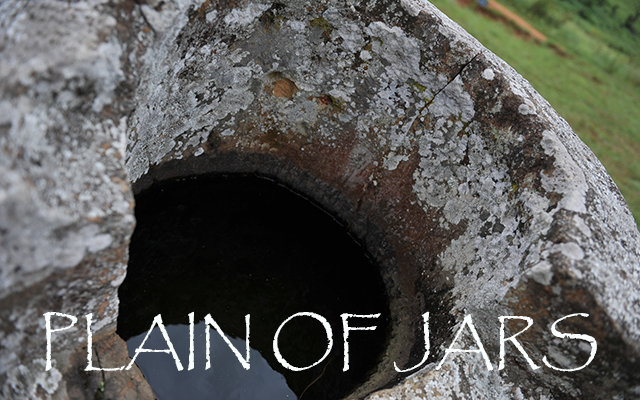
Plain of Jars, Laos – A Complete First-Hand Guide
Sign up today and receive a customized itinerary based on your own travel style, budget… by our Laos Travel consultants
* To be sure you'll receive our itinerary (email failure case...)
(We'll get back to you within 8 business hours)
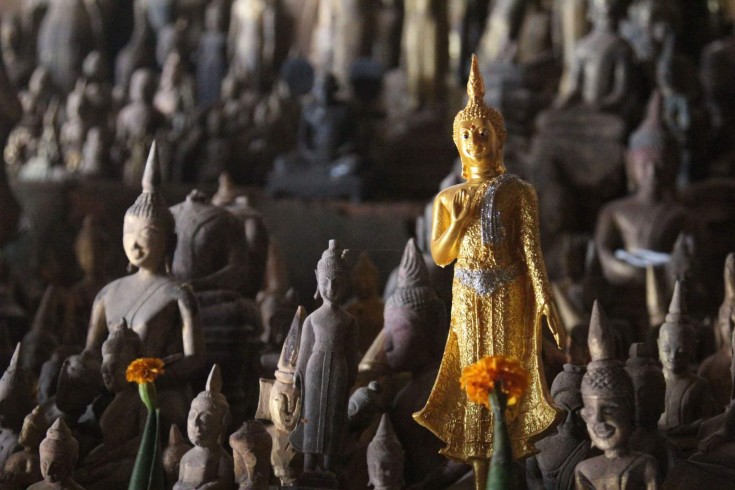
Northern Laos
- Luang Prabang
- Introduction
- Accommodation
An independent travel guide to Luang Prabang
A highlight of Laos
Published/Last edited on 24th December, 2018.
While other Southeast Asian cities have shed the cloak of the past and screamed into the future, Luang Prabang puttered into the 21st century like a leaky slow boat going against the current.
Browse hotels in Luang Prabang on Agoda
Provided by Travelfish partner Agoda .
Located in the middle of northern Laos, for years the town held cult status—those who had been knew they were privy to something very special. Now Luang Prabang has gone from “where is that?” to achieving bucket list status, and its star continues to rise.

Situated on a peninsula and surrounded by a fortress of mountains, Luang Prabang’s striking location is formed by the confluence of two rivers, the Mekong and the Nam Khan. Sacred Mount Phou Si rises in the middle and climbing to the top reveals an idyllic town of palm-lined riverbanks, terracotta rooftops, golden stupas and laneways frequented by saffron-robed monks strolling back to temple. It all comes together to form a picture increasingly difficult to find in Southeast Asia and even in Laos. Unlike Vientiane and Pakse, which have turned their backs on the old, the former royal capital is devoted to its heritage.
People add Luang Prabang to their itinerary because of its World Heritage status, the Mekong River or perhaps it’s the waterfalls and jungle clad mountains within easy reach. Days here can be packed with activities and exploration. Once on the ground however, the somnambulant, languid rhythm has a way of seeping in and even the most enthusiastic of travellers find themselves slowing down. Luang Prabang has a reputation for wrecking tightly planned itineraries, be sure to allow at least a few days to really ... Travelfish members only please log in below to continue reading. The full text is around 4,200 words.)
Learn more about Luang Prabang
Log in to Travelfish Please sign in to read the rest of this page. The full text is around 4,200 words.
Become a Travelfish member Choose from $10 week-long through to a lifetime membership.

What’s the weather like in Luang Prabang?
Luang Prabang has three seasons: hot-dry (approximately March to May), rainy season (June to September) and cool-dry (October to February).
More destinations
Hat Sa Huay Xai Luang Nam Tha Muang Khua Muang La Muang Long Muang Ngoi Muang Sing Nam Nern Night Safari Nong Kiaow Pak Tha Pakbeng Phongsali Phonsavan Sam Neua Udomxai Vieng Xai Xieng Kok
Holiday checklist
If you prefer to have all your ducks in a row before you hit the road, here are some travel services you may wish to consider.
- SafetyWing offers affordable travel insurance , along with coverage for travellers up to the age of 70.
- Buying a SIM card through Klook to pickup at the airport when you arrive can save you time and money. Choose from airports across Southeast Asia.
- GetYourGuide offers a quite comprehensive range of popular organised activities across the region.
- 12Go is a reliable travel agent for selecting and booking your transport in advance.
Winter is here! Check out the winter wonderlands at these 5 amazing winter destinations in Montana
- Travel Destinations
15 Hidden Gems In Luang Prabang You Can’t Miss
Published: August 24, 2024
by Cathi Gonzales
Luang Prabang, a charming town in Laos, offers more than just famous temples and bustling markets. Hidden gems await those who venture off the beaten path. Imagine wandering through quiet alleys, stumbling upon secret gardens, or finding a cozy café with the best coffee in town. These lesser-known spots provide a unique glimpse into local life and culture. Whether you're an adventurer or a history buff, there's something for everyone. From serene waterfalls to ancient caves, each location tells its own story. Ready to uncover the hidden gems in Luang Prabang ? Let's dive into the magic that makes this town truly special.
Exploring Luang Prabang's Hidden Gems
Luang Prabang, a UNESCO World Heritage site in Laos, offers more than just its famous temples and night markets. This charming town is brimming with lesser-known spots that promise unique experiences. Let's uncover some of these hidden gems.
Off-the-Beaten-Path Temples
While Wat Xieng Thong and Wat Mai are well-known, Luang Prabang has several other temples worth visiting.
Wat Pa Phon Phao : Perched on a hill, this temple offers panoramic views of the town and surrounding mountains. Its golden stupa shines brightly, especially during sunset.
Wat Chom Phet : Located across the Mekong River, this temple requires a short boat ride and a hike up a hill. The journey is rewarded with stunning views and fewer tourists.
Serene Natural Spots
Nature lovers will find Luang Prabang's hidden natural spots enchanting. These places offer tranquility away from the bustling town center.
Tad Thong Waterfall : A lesser-known waterfall surrounded by lush jungle. Perfect for a quiet picnic and a refreshing swim.
Pha Tad Ke Botanical Garden : Accessible by boat, this garden showcases the region's diverse flora. It's a peaceful retreat for plant enthusiasts.
Unique Cultural Experiences
Immerse yourself in the local culture by visiting places that offer a glimpse into the traditional way of life in Luang Prabang.
Traditional Arts and Ethnology Centre : This museum highlights the ethnic diversity of Laos through exhibits of traditional clothing, tools, and crafts.
Ock Pop Tok Living Crafts Centre : Learn about Lao textiles and even try your hand at weaving. The center also has a lovely café overlooking the Mekong.
Hidden Cafés and Eateries
Luang Prabang's culinary scene extends beyond its famous night market. Discover these hidden spots for a delightful meal or a cup of coffee.
Saffron Coffee : Nestled along the Mekong, this café serves ethically sourced Lao coffee. Enjoy a cup while watching the river flow by.
Bouang Asian Eatery : A cozy spot offering a fusion of Lao and Western dishes. The vibrant décor and friendly staff make it a must-visit.
Offbeat Activities
For those seeking unique experiences, Luang Prabang offers several offbeat activities that are both fun and educational.
Kuang Si Butterfly Park : Near the famous Kuang Si Waterfall, this park is home to numerous butterfly species. It's a great place to learn about these beautiful insects.
Laos Buffalo Dairy : Visit this social enterprise to learn about dairy farming in Laos. You can even try their delicious buffalo cheese and ice cream.
Scenic Viewpoints
Capture the beauty of Luang Prabang from various vantage points that offer breathtaking views of the town and its surroundings.
Phou Si Hill : While not exactly hidden, many visitors miss the quieter trails leading up to the summit. These paths offer serene spots to enjoy the view.
Mount Phousi's Secret Garden : A lesser-known area on the way up Phou Si Hill, this garden provides a peaceful escape with beautiful flowers and benches to relax.
Local Markets and Shops
Beyond the main night market, Luang Prabang has several other markets and shops where you can find unique souvenirs and local products.
Phosy Market : A bustling local market where you can find fresh produce, traditional Lao snacks, and handmade crafts.
Naga Creations : A boutique shop offering exquisite jewelry and accessories made by local artisans. Perfect for finding a special keepsake.
Hidden Historical Sites
Discover the rich history of Luang Prabang by visiting these lesser-known historical sites.
- Royal Palace Museum's Secret Garden : Behind the main museum, this garden is often overlooked. It's a serene spot with beautiful landscaping and historical significance.
Discovering Luang Prabang's Hidden Gems
Luang Prabang offers more than just its famous temples and night markets. Hidden gems like the Kuang Si Falls , Pak Ou Caves , and Mount Phousi provide unique experiences. Don't miss the Royal Palace Museum for a glimpse into the region's history. For a quieter escape, visit Tad Sae Waterfalls or Ban Xang Hai Village . The Ock Pop Tok Living Crafts Centre showcases traditional Lao textiles. Phosi Market is perfect for local flavors. Wat Xieng Thong and Wat Mai Suwannaphumaham are must-see temples. Alms Giving Ceremony offers a spiritual experience. MandaLao Elephant Conservation promotes ethical tourism. UXO Laos Visitor Centre educates about the country's past. Luang Prabang Library supports local education. Chomphet District provides stunning views. Each spot adds to the charm of this UNESCO World Heritage site. Make sure to explore these hidden treasures.

- Privacy Overview
- Strictly Necessary Cookies
This website uses cookies so that we can provide you with the best user experience possible. Cookie information is stored in your browser and performs functions such as recognising you when you return to our website and helping our team to understand which sections of the website you find most interesting and useful.
Strictly Necessary Cookie should be enabled at all times so that we can save your preferences for cookie settings.
If you disable this cookie, we will not be able to save your preferences. This means that every time you visit this website you will need to enable or disable cookies again.
Kuang Si Falls: A Day Tour from Luang Prabang
- share
- Share on Facebook
- Share on Twitter
Kuang Si Falls: The Ultimate Guide to Laos’ Natural Wonder
Table of Contents
Kuang Si Falls, also known as Kuang Xi Falls or Tat Kuang Si Waterfalls, is one of Laos’s most stunning natural attractions. Located 29 kilometers south of Luang Prabang , these three-tiered waterfalls boast turquoise waters and lush jungle surroundings. Visitors are drawn to the falls for their breathtaking beauty and the opportunity to swim, hike, and capture unforgettable photos .

The falls are easily accessible from Luang Prabang, making them popular for day trips. Kuang Si Falls offers a perfect escape into nature with its serene pools and cascading waters. The site is not just about the visuals; it’s a sensory experience with the sound of water and the feel of the cool, refreshing pools.
Whether you want to relax by the water, take a refreshing swim, or explore the trails around the area, Tat Kuang Si Waterfalls provide an ideal setting for a memorable adventure.
Overview of Kuang Si Falls
Kuang Si Falls is situated approximately 29 kilometers (18 miles) south of Luang Prabang in Laos. The area is known for its lush, green jungle canopy and dramatic limestone formations. The waterfall is composed of three tiers, creating several pools of varying depths where visitors can swim and relax.
The falls begin in shallow pools atop steep slopes, eventually leading to a 60-meter (200-feet) drop. This drop forms the main waterfall, which is surrounded by dense jungle and various walking trails. The area around Kuang Si is rich in biodiversity, including unique flora and fauna that thrive in the tropical climate.
Historical Significance
While the natural beauty of Tat Kuang Si is its main draw, the falls also hold historical importance. They have long been a cherished spot for local communities, who view the site as both a source of life-giving water and a place of natural splendor. Over time, Kuang Si Falls has gained recognition internationally, drawing visitors from around the world.
In recent years, the site has been developed to include various amenities for tourists, such as walkways, picnic areas, and designated swimming spots. Despite these modern additions, efforts have been made to preserve the natural environment and cultural heritage, ensuring that Kuang Si Falls remains a pristine and valuable destination.

Visiting the Falls
Best time to visit.
The best time to visit Kuang Si Falls is during the dry season, from November to April. The water is clear and blue, and the weather is comfortable for outdoor activities. During the rainy season, from May to October, the water levels are higher, and the falls are more powerful, but the trails can be muddy and slippery.
Early mornings are ideal for avoiding crowds. Aim to arrive around 8 AM to have a more peaceful experience. Weekdays are generally less crowded compared to weekends.
Opening Hours and Entrance Fee
Kuang Si Falls is open daily from 8 AM to 5:30 PM. It’s advisable to arrive early to make the most of your day and to avoid the midday rush.
The entrance fee is modest. As of the latest information, it is approximately 20,000 Lao Kip per person, which is around $2 USD. Always check for updated fees before visiting as they can change.
Tickets can be purchased at the entrance, and secure parking facilities are available if you are driving.
What to Bring
When visiting Kuang Si Falls, packing the right items will enhance your experience. Bring a towel and an extra set of clothes if you plan to swim in the turquoise pools. The falls are surrounded by lush forests, so sunscreen and bug spray are essential to stay protected from the sun and insects.
A waterproof camera will be useful to capture the stunning scenery, and comfortable, non-slip shoes are recommended for hiking the trails. Bringing your own snacks and water is a good idea, although there are small vendors around the area.
Don’t forget a small first aid kit in case of minor injuries, as the trails can be a bit rugged. Being prepared ensures a safe and enjoyable visit.

The Experience
Swimming and relaxation.
One of the highlights of Kuang Si Falls is the opportunity to swim in its turquoise pools. The water is clear, cool, and perfect for a refreshing dip, especially on a hot day. The main pool features rope swings and an overhanging tree limb for jumping into the water.
Crowds can gather during peak times, so early morning visits are recommended for a more peaceful experience. Hammocks are available for those who prefer to relax by the water’s edge.
Several smaller pools are scattered throughout the area, offering quieter spots for swimming and relaxation. It’s an ideal location for visitors of all ages to enjoy the serene natural surroundings.
Hiking Opportunities
Kuang Si Falls offers excellent hiking opportunities with trails winding through lush jungle scenery. The main trail leads to the top of the falls, providing stunning views of the cascading water and surrounding landscape.
More adventurous hikers can explore secondary trails that offer a glimpse into the dense jungle. These trails can be challenging and may require sturdy footwear. Hikers should be prepared for steep climbs and uneven terrain.
Along the way, informative signs provide details about the local flora and fauna, making it a great experience for those interested in botany and ecology. The hikes can take from a couple of hours to a full day, depending on the chosen path and pace.
Wildlife and Ecotourism
Kuang Si Falls is not just about the water; it’s also a hub for wildlife and ecotourism. The Bear Rescue Centre, located near the entrance, is home to bears rescued from poaching and illegal trade. Visitors can learn about the bears and the conservation efforts in place to protect them.
Butterflies are another common sight, with many species flitting around the falls and jungle. The vibrant wildlife adds to the magical atmosphere of the area.
Ecotourism initiatives are in place to preserve the natural beauty and biodiversity of Kuang Si Falls. Guided tours are available, offering insights into the ecological significance of the region. These tours aim to educate visitors while promoting sustainable tourism practices.

Facilities and Services
Food and refreshments.
There are numerous food stalls and a restaurant near the entrance of Kuang Si Falls. They offer a variety of snacks and meals, so visitors can easily find something to suit their taste. Popular items include grilled meats, fresh fruit, and traditional Lao dishes.
Many stalls also serve coffee and other beverages, perfect for a quick break. Prices are generally reasonable, making it convenient for families and solo travelers to enjoy a meal without leaving the site.
Rest Areas and Picnic Spots
Visitors will find plenty of rest areas and picnic spots scattered around Kuang Si Falls. Shaded benches are available near the main pools, providing a place to relax and take in the view.
Designated picnic areas feature tables where people can eat their packed lunches or food purchased from nearby stalls. These spots are ideal for groups who want to spend time together in a natural setting.
Many visitors enjoy sitting by the waterfalls, which makes for a memorable and serene experience.
Travel Tips
Local transportation.
There are various ways to get to Kuang Si Falls. Many travelers choose to rent a scooter or motorbike for flexibility and convenience. Renting a motorbike costs around $10 per day.
Tuk-tuks are another popular option, especially for those who prefer not to drive. A round trip by tuk-tuk usually costs between $20 to $30, depending on your negotiating skills.
For those in groups, hiring a minivan can be cost-effective. Minivan rentals often come with a driver and typically cost around $30 to $50.
Book Kuang Si Waterfall Shared Minibus Ticket (Round Trip) via KLOOK
More adventurous visitors might prefer to cycle. Renting a bicycle is cheap, often available for about $5 per day.
Arriving early in the morning can help you avoid crowds and enjoy a more peaceful experience at the falls.
Accommodations and Stays
In Luang Prabang, the town closest to Kuang Si Falls, you have several accommodation options.
For budget travelers, guesthouses offer rooms starting at around $15 per night. These places provide basic amenities but are often centrally located.
Those looking for more comfort might opt for a mid-range hotel . Prices for mid-range hotels start at about $50 per night and often include breakfast.
For luxury stays, there are several resorts and boutique hotels . These high-end accommodations offer more amenities and services, with prices starting around $150 per night.
If you prefer staying closer to Kuang Si Falls, a few eco-lodges in the surrounding area offer nature-focused experiences. These lodges usually charge around $70 per night and provide an immersive experience in the lush landscapes of Laos.
Plan Your Visit
A trip to Kuang Si Falls offers stunning landscapes, turquoise waters, and beautiful hiking trails. Preparing for your visit will ensure you make the most of this natural wonder and enjoy a smooth, enjoyable experience.
Itinerary Suggestions
To make the most of your day at Kuang Si Falls, start early. Arriving around 8 AM helps you beat the crowds and enjoy the peaceful surroundings. Depending on your interest, you can follow a general itinerary:
- 8:00 AM: Arrive and pay the admission fee, typically around $3-$5 USD.
- 8:30 AM: Start with the Bear Rescue Center near the entrance.
- 9:00 AM: Hike to the main falls and explore the various tiers.
- 10:00 AM: Swim in the designated pools; the water is usually cold but refreshing.
- 12:00 PM: Enjoy a packed lunch in the picnic area.
- 1:00 PM: Take photos at the various scenic spots or follow the trail to the top of the falls.
If you want a more guided experience, consider booking a tour. Several are available from Luang Prabang, which is less than an hour’s drive away.
Packing Essentials
For a comfortable visit, bring essentials to ensure a safe and enjoyable time. Here’s a handy list for packing:
- Comfortable Shoes: Good for hiking and walking.
- Swimwear: Ideal for those wanting to take a dip in the pools.
- Towel: For drying off after swimming.
- Waterproof Bag: Useful for keeping valuables dry.
- Snacks and Water: There are limited food options, so bringing your own is a good idea.
- Bug Spray and Sunscreen: Essential for protection from insects and sunburn.
- Camera: To capture the beautiful scenery.
Packing these items will help you make the most out of your visit without any inconvenience.

Frequently Asked Questions
How much is the entrance fee to visit kuang si falls.
The entrance fee to visit Kuang Si Falls is approximately 20,000 Lao Kip, equivalent to around $2 USD. This fee helps maintain the park and its facilities.
What are the options for traveling from Luang Prabang to Kuang Si Falls?
There are several options for traveling from Luang Prabang to Kuang Si Falls:
Tuk-Tuk or Songthaew : These are popular and convenient options. You can find many tuk-tuks and songthaews around Luang Prabang, especially near the local post office or Joma Bakery.
Shared Minivan : This is a cost-effective and comfortable option. A round trip can cost around $5 per seat.
Taxi : For a more private and direct option, you can hire a taxi. The journey takes about 38 minutes and can cost as low as $2.
Cycling : For the more adventurous, cycling is an option. You can cycle one way and then catch a tuk-tuk back.
Choose the option that best suits your budget and travel preferences.
Are there hiking trails available at Kuang Si Falls, and if so, what is their difficulty?
Yes, there are hiking trails available at Kuang Si Falls. The main trail to the waterfall is generally considered moderately challenging and takes about 50 minutes to complete. The path can be steep and uneven in parts, especially if you choose to hike to the top of the falls, which can be quite challenging and is not recommended for those who are not well-prepared.
Additionally, the trail passes through a bear sanctuary, making it a unique and enjoyable experience.
What makes Kuang Si Falls a famous tourist attraction?
Kuang Si Falls is renowned for its stunning natural beauty, featuring a series of cascading turquoise pools set against a backdrop of lush, green jungle. The main waterfall drops an impressive 60 meters, creating a picturesque scene that attracts photographers and nature lovers alike. Visitors are also drawn to the refreshing swimming opportunities in the crystal-clear pools, the scenic hiking trails, and the chance to visit the nearby bear sanctuary, which adds an educational and conservation-focused element to the trip. Its accessibility from Luang Prabang and the tranquil, idyllic setting make Kuang Si Falls a must-visit destination for tourists in Laos.
How much time should one allocate to visit Kuang Si Falls?
To fully enjoy Kuang Si Falls, it is recommended to allocate at least half a day. This allows ample time to explore the multiple tiers of the falls, swim in the turquoise pools, hike the trails, and visit the bear sanctuary. Most visitors find that spending around 3-4 hours is sufficient to take in the main attractions without feeling rushed. Additionally, travel time from Luang Prabang to the falls is approximately 30-40 minutes each way, so factoring in transportation, a half-day trip is ideal.
Luang Prabang Travel and Tour Packages
Like, Follow, and Subscribe to OutofTownBlog.com on Facebook , Twitter , Instagram , and Team out Of Town on YouTube for more Luang Prabang Tourist Spots .
- Ultimate List of the Best Hotels in Luang Prabang, Laos
- Tierra Astur: A Cider Barrel of Deliciousness
Written by Melo Villareal
Melo Villareal is the Online Publisher of Outoftownblog.com. He is an Accountant by profession who left the corporate world at the age of 23 to explore his beautiful country and the rest of the world. Today, Melo works as a part-time Social Media Manager for local and international clients. His full-time work focuses on discovering interesting culture, explore different cuisines and take memorable photos from local and international destinations he's visiting.
What do you think?

20 of The Best Places to Visit in Cambodia
© 2024 by Team Out of Town
With social network:
Or with username:.
Username or Email Address
Remember Me
Forgot password?
Enter your account data and we will send you a link to reset your password.
Your password reset link appears to be invalid or expired.
Privacy policy.
To use social login you have to agree with the storage and handling of your data by this website. Privacy Policy
Add to Collection
Public collection title
Private collection title
No Collections
Here you'll find all collections you've created before.
- Search Please fill out this field.
- Manage Your Subscription
- Give a Gift Subscription
- Newsletters
- Sweepstakes
You Can Travel in These 7 Countries for Less Than $30 a Day — Here’s How
And that includes food, hotels, and fun.
Evie Carrick is a writer and editor who’s lived in five countries and visited well over 50. She now splits her time between Colorado and Paris, ensuring she doesn't have to live without skiing or L'As du Fallafel.
:max_bytes(150000):strip_icc():format(webp)/evie-carrick-df91be43396540c492c4141c56a71a9e.jpg)
Michael Herm/Getty Images
In case you haven’t noticed, everything from groceries to rent is getting more expensive. Since 2021, the inflation rate has remained at or more than three percent, with the high being a seven percent increase in 2021. It’s no wonder people are choosing to move abroad .
When life feels expensive, it’s good to remember there are places where you can get a room for the cost of a movie ticket and a full meal for the price of a cup of coffee. In fact, once you get past the airfare, you can actually save money by traveling to certain countries for extended periods of time.
Here’s a rundown of how to get by in some of the world’s most affordable countries for less than $30 a day, including lodging, food, and activities.
Wilfried Strang/Getty Images
While Vietnam and Thailand get plenty of attention, Laos is often overlooked. Perhaps it’s because the nation is landlocked in an area known for its beautiful coastlines, but those who visit will be rewarded with mountains, Buddhist monasteries, beautiful rivers, and a low cost of living.
When I visited Luang Prabang , I was able to stay in a place like Phai Guesthouse for $13 a night. The city is full of French colonial architecture and bakeries with delicious treats for less than $4. If you really want to save, buy your meals from roadside vendors who sell foods like noodle soup and sticky rice for around $1.
FEBRUARY/Getty Images
I visited Nepal when I was traveling through northern India. Kathmandu, its capital, tends to have some of the most affordable lodging (like Thamel Eco Resort , with rooms for $20 a night, for two people), but if you want to see the Himalayas, you’ll want to hop on a bus to Pokhara, a city west of the capital. The journey costs $11 per person via an air-conditioned bus.
One of the most memorable things I ate in Nepal were momos (dumplings), which cost less than $1 for a plate of around seven.
When I visited Indonesia, I stayed on Bali , which is still relatively affordable, but more expensive than many of the country's other islands. Sumatra and Java have some wonderfully low prices, while on Lombok, an island to the east of Bali, you can stay in a three-star hotel like the Hotel Puri Saron Senggigi for around $22 a night.
If you don’t mind simple meals of rice, meat, and eggs, you can grab local dishes like nasi goreng for around $2.
phutthiseth thongtae/Getty Images
Thailand is no longer the affordable darling it once was, but you can still find budget-friendly accommodations and affordable, delicious eats all over the country. For some of the best rates, head north to the cool mountains, rather than south to the islands. For example, in the northern city of Chiang Mai, you can book a private room in a guesthouse for under $20 a night . A nice meal in a restaurant typically costs around $8, while street food is around $2 a meal.
Vithun Khamsong/Getty Images
Vietnam continually ranks high among travelers looking for a deal. But beyond being affordable, the country is beautiful, with more than 2,000 miles of coastline. In the city of Hạ Long, which sits on Hạ Long Bay, visitors have easy access to snorkeling and climbing on the jutting limestone islands.
There are hundreds of hotels, hostels, and homestays in Hạ Long for around $15 a night. After a day of exploring in and along the bay, you can find a banh mi sandwich for around $1 or a bowl of pho for $3.
Philippines
Jacob Marsh/Getty Images
It’s a haul to get to the Philippines, but once you’re there, you’ll enjoy a relatively low cost of living. Even islands like Siargao, known for its surf culture, have rooms for $30 or less .
After a day of riding the waves, you can find a plate loaded with local fare (like chicken adobo) for a few bucks. If you’re craving a Western comfort dish, expect to pay around $10 (a bowl of homemade pasta from La Carinderia , for example).
Anton Aleksenko/Getty Images
I spent more than a month in India and enjoyed the perks of affordable lodging and tasty, cheap eats. A private room in a central hotel in New Delhi will cost you around $15 a night (like in the case of one of my all-time favorite properties, Hotel Hari Piorko ). A meal on the street is around $3, as is a train trip on a lower-tier car.
Related Articles
Flight search
- Adults Remove adult 1 Add adult
- Children Aged 2-11 Aged 2 to 11 Remove child 0 Add child
- Infants In seat Remove infant in seat 0 Add infant in seat
- Infants On lap Remove infant on lap 0 Add infant on lap
- Premium economy
Cheap flights from Luang Prabang to Paris
Good to know, popular airports near luang prabang.
- Luang Prabang International Airport (LPQ) Luang Prabang 5 min 2 km
- Sayaboury Airport (ZBY) Sainyabuli 2 hr 32 min 84 km
- Wattay International Airport (VTE) Vientiane 6 hr 2 min 215 km
Popular airports near Paris
- Paris Charles de Gaulle Airport (CDG) Paris 35 min 22 km
- Paris-Orly Airport (ORY) Paris 31 min 15 km
- Paris Beauvais Airport (BVA) Paris 1 hr 23 min 68 km
- Brussels South Charleroi Airport (CRL) Brussels 3 hr 6 min 234 km
Frequently asked questions about flying from Luang Prabang to Paris
Search more flights, more places to fly.

IMAGES
COMMENTS
Last Updated: September 2, 2023. Luang Prabang is a small but vibrant town in the heart of mountainous Northern Laos. Luang Prabang is located at the confluence of the Mekong and Nam Khan rivers and is one of the most popular destinations in Laos as most travelers use it as the first or last stop in the country before traveling to/from Thailand.
Luang Prabang is one of only two cities in Laos (the other being the capital, Vientiane) to have its own international airport which means that it is one of the easiest cities to travel to from overseas. Luang Prabang International Airport (LPQ) is located 4 km (2.5 miles) northeast of the city.
Travel guide Menu Toggle. Access; Basic Information; Visa; Tourist Info Center; Do's and Don'ts; Downloads; About LuangPrabang Menu Toggle. UNESCO World Heritage; ... Luang Prabang district & province Tel: +856-71-212-487. Useful Links - Tourism Laos - Southern Laos - Basic Information
The Markets of Luang Prabang . Some 500,000 people, across more than 60 different ethnic groups, call Luang Prabang home, the Khmu, Lao Loum, and Hmong being the largest Indigenous nations. People ...
Laos, Asia. Luang Prabang (ຫລວງພະບາງ) slows your pulse and awakens your imagination with its combination of world-class comfort and spiritual nourishment. Sitting at the sacred confluence of the Mekong River and the Nam Khan (Khan River), nowhere else can lay claim to this Unesco-protected gem's romance of 33 gilded wats ...
A Luang Prabang Travel Guide is incomplete without visiting the Temples How to reach Luang Prabang. It is easy to reach Luang Prabang from every region of Southeast Asia. Traveling to Luang Prabang is a good idea to start exploring Laos. To reach Luang Prabang by flight: ...
Yoga is one of the best things to do in Luang Prabang as there is a cooperative of many independent yoga teachers with whom you can practice in the city's most beautiful spots. Price: 15,000 - 40,000 kip for bikes, 40,000 kip for yoga. Explore the city on a bike.
WAT XIENGTHONG. There are 33 temples in Luang Prabang, but Wat Xiengthong has to be one of the best. Wat Xiengthong is a Buddhist temple built on the tip of the peninsula by King Setthathirath from 1559-1560. Wat Xiengthong is special for its glass mosaics throughout the temple; it's truly a sight to see!
How Many Days In Luang Prabang. Day One: Temples & Markets On The Luang Prabang Itinerary. Day 2: Kuang Si Falls & Mount Phousi On The Luang Prabang Itinerary. Day 3: Discover Local Culture On The Luang Prabang Itinerary. Luang Prabang Travel Tips.
By the 13th century, Luang Prabang became a thriving center of artists and merchants. The city has survived French colonization, Japanese invasion, and U.S. bombings. Finally, in 1995, Luang Prabang became a UNESCO World Heritage Site "for its remarkable preservation of architectural, cultural, and religious heritage."
Luang Prabang Travel Guide & Things to do in Luang Prabang from Temples & Treehouses . Pin now, read later: About the Author. Mad Monkey is Southeast Asia's leading hostel operator — born in Cambodia with more properties in Thailand, Indonesia, Australia, Laos, and the Philippines. We pride ourselves in creating meaningful and sustainable ...
7. Luang Prabang Night Market. After a day of exploring, the Luang Prabang Night Market is a great place to slow down. At sunset, Sisavangvong Road transforms into a charmingly lit, colorful street, filled with tents, selling different items. For example, clothing, wood carvings, jewelry, textiles, and various other knick-knacks.
As Luang Prabang is located on the river, one of the best things to do here is take a trip on a boat a check out the town from the point of view of the water. As you speed along this famous waterway you can enjoy local villages and see fisherman as they haul in the day's catch. 21. Visit Wat Ho Pha Bang.
Luang Prabang Travel Guide: Practical Information. Luang Prabang is located in the moutainous north of Laos on a peninsula, where both the Mekong River and Nam Khan River meet. The city feels like nowhere else I've been to in South East Asia. And despite its mesmerising charm, it is still not yet overcrowded by tourists.
I. Overview of Luang Prabang. Geographical location: Situated in the center of northern Laos, Luang Prabang borders the provinces of Oudomxay, Phongsaly, and Houaphanh to the north, Vientiane - the capital and Xayabouly to the south and southwest, and Xieng Khouang to the east. Area: 820 ha Buffet zone: 12, 560 ha The population of the city: roughly 56,000 people and the UNESCO-protected ...
Here are the best things to do around Luang Prabang, including day trips and short excursions. 13. Cool off in the magnificent Kuang Si Falls. The picture-perfect Kuang Si Falls are an easy day trip from Luang Prabang. A great way to spend half a day in Luang Prabang is to take a trip to Kuang Si Falls.
A fixed travel budget consists of flight, hotel and day-trip costs. Mid-range costs are around US$200-C250 per day. There are direct flights from Siem Reap, Hanoi, Bangkok and Chiang Mai into Luang Prabang at around $150-C200 per person. A 3-/4-star boutique hotel costs over $100 per room per night.
Start and end your trip in Ho Chi Minh City and visit highlights such as the Mekong Delta, Phnom Penh with the Killing Fields, Angkor Wat, the historic city of Luang Prabang in Laos before heading back to Vietnam - Hanoi, Halong Bay and Hoi An await. view trip ⤍. 4 days. Laos Elephants & Jungle.
The Luang Prabang Activities Travel Guide. Luang Prabang, the small and vibrant ancient capital of Laos, is a delight to travel to. Home to golden temples, enchanting waterfalls and an overall tranquil and welcoming atmosphere, you could easily spend more than 3 days in this beautiful city. Situated in the northern part of Laos, Luang Prabang ...
Luang Prabang is hands down, one of my favorite cities in Laos. It is a charming little city nestled between the rolling hills of Northern Laos. As Laos' old capital, you will be able to travel back in time, walk among the stunning architecture, and experience the rich culture and history, all the while enjoying some of the best Laotian food ...
Its unique monastic life, the shimmering golden temples, and the attractive nearby countryside all vie for your attention in this 3-day itinerary. My 3 days in Luang Prabang guide is meant for culture lovers, active travelers, and adventure seekers. At the end of this guide, I also recommend a few centrally-located hotels at the end of this post.
Temple tours and meditation each last one hour and provide visitors with an insight into daily life in the temple. Cost: from 20 USD per person. 15 interesting things to do in Luang Prabang. Explore ancient town, Sunset at Phou Si Mountain, Witness The Alms Giving, Trekking, Kayaking….
Luang Prabang is a highlight of Laos. Photo: Cindy Fan. Situated on a peninsula and surrounded by a fortress of mountains, Luang Prabang's striking location is formed by the confluence of two rivers, the Mekong and the Nam Khan. Sacred Mount Phou Si rises in the middle and climbing to the top reveals an idyllic town of palm-lined riverbanks ...
Luang Prabang, a UNESCO World Heritage site in Laos, offers more than just its famous temples and night markets. This charming town is brimming with lesser-known spots that promise unique experiences. Let's uncover some of these hidden gems. Off-the-Beaten-Path Temples. While Wat Xieng Thong and Wat Mai are well-known, Luang Prabang has several ...
We're aiming to be in Luang Prabang for 4-5 days in Summer 2025 and have plans to spend time in LP itself, Kuang Si waterfalls and Nahm Dong park. I'm intrigued by a trip on the bullet train. Thus would a return day trip to another location (and if so where) be a great or unwise idea bearing in mind travel time etc. Really open to ideas.
Luang Prabang remained the royal capital until 1975, when the Pathet Lao communist forces seized power with North Vietnamese support and dissolved the monarchy. Luang Prabang was enlisted as a UNESCO World Heritage Site in 1995 for the recognition of its well-preserved architectural, religious and cultural heritage.
Most visitors find that spending around 3-4 hours is sufficient to take in the main attractions without feeling rushed. Additionally, travel time from Luang Prabang to the falls is approximately 30-40 minutes each way, so factoring in transportation, a half-day trip is ideal. Luang Prabang Travel and Tour Packages
The Nam Khan River, which flows into the Mekong River, is located in Luang Prabang, Laos. Wilfried Strang/Getty Images. While Vietnam and Thailand get plenty of attention, Laos is often overlooked.
Flights from Luang Prabang to Paris. Use Google Flights to plan your next trip and find cheap one way or round trip flights from Luang Prabang to Paris. Find the best flights fast, track prices ...